Author: Eduardo Freire Canosa
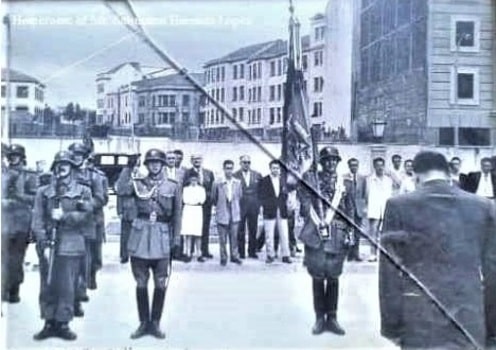
Cando chove e fai sol, anda o demo por Ferrol
When it rains and the sun shines, the devil wanders over Ferrol
The modern history of Ferrol begins in the year 1726 when the Spanish monarch named the fishing village of Ferrol plus Cartagena plus Cadiz respective seat of three newly created administrative and operational jurisdictions for the Spanish Navy. The designation eventually transformed the obscure fishing village into a shipyard and a major naval base that attracted and employed many local people whose mother tongue was Galician and many Spaniards whose mother tongue was Castilian.
The working language of the Spanish Navy is of course Castilian, and so to get ahead in Ferrol you had to speak Castilian fluently. Here originated a division of classes along mother-language lines that remains fairly true to this day: the establishment of Ferrol spoke Castilian exclusively, the working class spoke Castilian and Galician indistinctly.
Historical dates of particular significance to the Ferrolian working class are commemorated in Galician. One such date of paramount importance every year is the tenth of March, called the "Day of the Galician Working Class." This sombre remembrance day calls up March 10, 1972, when paramilitary police opened fire on a demonstration of shipyard workers in Ferrol killing two and wounding sixteen others.
At the start of 1972 the Ferrolian proletariat rejected new labour regulations announced by the state-sponsored union of shipyard workers and demanded negotiations. The shipyard's management responded with sanctions and with the layoff of many workers, and this in turn provoked the workers to undertake industrial action on February 11 by refusing to work overtime. The overtime boycott became indefinite on the 22nd.
From March 1, 1972, onward, the workers assembled daily, deliberately lowering productivity. Meanwhile many small businesses of Ferrol started partial shutdowns in solidarity with the shipyard workers.
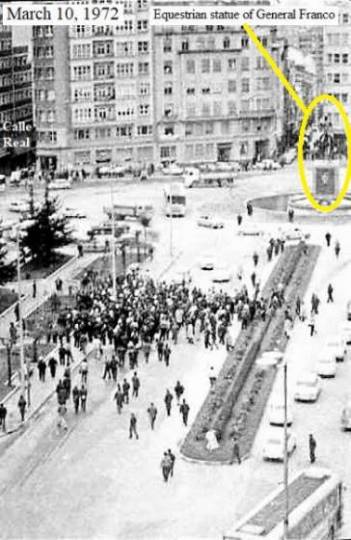
On March 6 the state-sponsored union made their collective agreement official.
On March 9 paramilitary police in Ferrol expelled the assembled workers from the shipyard with "extreme violence" after they had voted to start a general strike to protest management's new sanctions and the arrest of six trade union representatives. Scuffles broke out in several parts of the city, and at this point the shipyard initiated a lock-out.
On March 10 a throng of some 4,000 workers demonstrated through the streets of Ferrol before heading to the suburbs for the purpose of drawing more workers into the struggle. The photograph to the left, taken from an upper floor of the Medical Centre, shows a cluster of workers assembled in Plaza de España debating what to do next.
Note: This equestrian statue of General Franco can be seen in the photograph's background standing where the luminous fountain used to be; the statue had been installed on July 5, 1967.
Eventually the workers decided to head out to the Astano shipyard. The march took them past the photographer. A minute or so later a detachment of sixty paramilitary police arrived and a violent confrontation ensued. The workers defended themselves with sticks and stones; Franco's police returned a volley of live fire, killing two workers and wounding sixteen others.
The Spanish government declared a state of siege and harsh repression followed, torture and beatings the norm, but the unrest in Ferrol lasted ten more days. The political unrest gradually spread to other industrial and student centers of Galicia and peaked for the second time in the autumn.
No democratic Spanish government has dared to conduct an inquiry into the events of March 10, 1972, exhibiting a reluctance that validates the belief that Ferrol and Spain remain politically polarized territory, apprehensive of another military coup d'etat like the one that started the Spanish Civil War in 1936 if said enquiry were ever carried out.
To its credit Ferrol's City Hall erected a memorial monument on the spot where the two workers, Daniel Niebla and Amador Rey, both born in 1933, fell dead. They belonged to the Communist workers' organization, Comisiones Obreras.
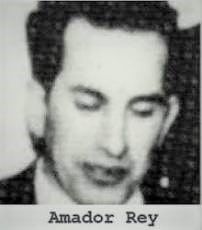
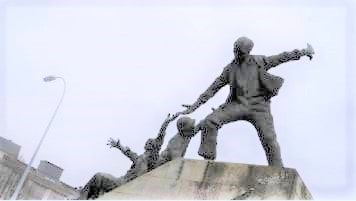
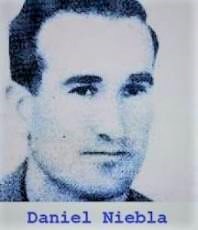
|
Abridged Voice-Over Translation: On such a day as today, one tenth of March, Amador and Daniel were assassinated right here by Franco's fascist police. And they were so for demanding rights for the working class. For demanding freedom and justice. And forty-nine years afterward we are demanding that same thing (Manel Grandal, Secretary-General of the Ferrolterra branch of the Confederación Intersindical Galega).
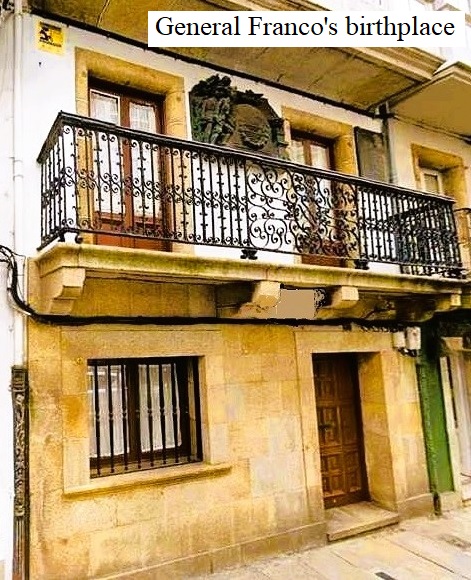
At the opposite end of the political spectrum, Ferrol was the birthplace of Generalissimo Francisco Franco. The photograph to the left shows the house where he was born.
When I was a child the city's official name was "El Ferrol del Caudillo" (Ferrol of the Strongman) in reference to the general. Some detractors revised it to "El Ferrol del Bocadillo" (Ferrol of the Sandwich).
Franco was a bit of an enigmatic figure. Although the last thing to associate with his dictatorship is respect for the Galician language or national aspirations, at the conclusion of a gala dinner held in A Coruña on September 6, 1958, maestro Adolfo Anta Seoane asked the general permission to play the proscribed Galician anthem, and to everyone's amazement, the dictator granted it and stood up, a gesture immediately seconded by everyone present. A similar event took place on August 25, 1975, the final year of his life. In another mystifying episode, Mário Soares the former Prime Minister of Portugal affirmed that declassified American documents reveal that Franco refused in 1974 to co-operate with the Americans in their planned invasion of Portugal after the Revolution of the Carnations by alluding to his Galician roots, "I am Galician," he said, "and I do not accept that Portugal should not become what it wants to become."
I remember as a child not seeing the Generalissimo even though he, surrounded by Navy brass in their immaculate white uniforms, stood on a raised platform. The occasion was a military parade along the service road that rings the shipyard. The parade over, my mother pointed him out to me repeatedly as we passed by, but hard as I looked I could not make him out. I guess it was because he was shorter than what I supposed a Generalissimo to be.
Since the royal decree of 1726 the economic future of Ferrol has in last instance been linked to the willingness of the central government in Madrid to continue funding the shipyard and to the procurement needs of the Spanish Navy to guarantee a medium-term workload. This dependence triggered a sequence of economic busts and booms for the city. Thus the nineteenth century began in Ferrol with a profound bust. Under twelve vessels were built between 1800-1850. Beginning in the year 1847 government policy fostered the resurgence of the shipyard. The next crisis came toward the end of the nineteenth century due to a slow start in the construction of ironclads. Between 1909-1937 the Spanish government ceded management of the shipyard to a private company owned mostly by British interests. A boom in employment and production ensued, the tonnage launched increased fivefold. The Spanish Civil War (1936-1939) reduced activity until the constitution of Empresa Nacional Bazán in the year 1947.
Ferrol's municipal library archives did not have newspapers from the year 1953 as I undertook this project, but the first 1954 newspaper had some information about the preceding year. Thus the number of births registered in Ferrol during 1953 had been 709 boys and 721 girls. I was one of the boys. The city library had welcomed 25,532 readers, 28,721 books were read and 6,536 delivered to private households. Spain had signed a religious agreement with the Holy See and a defence pact with the United States, and General Franco asserted in his New Year's address that 1953 had been "one of the most outstanding and fecund of our History" in spite of the "great drought" prevailing.
IndexClicking on a number will take you to the corresponding chapter right away |
|
1. The Shipyard
2. The Military 3. Religion In the Streets 4. The Codders 5. Glimpses of the Ferrol That Was 6. The Local News for the Year 1954 7. The Local News for the Year 1955 8. Bazan Magazine for the Year 1956 9. Bazan Magazine for the Year 1957 10. Bazan Magazine for the Year 1958 11. The Local News for the Year 1959 12. Bazan Magazine for the Year 1960 13. The Local News for the Year 1961 14. Bazan Magazine for the Year 1962 15. The Local News for the Year 1963 16. Bazan Magazine for the Year 1964 17. Departure and Hindsight 18. Puppets In the Park 19. The Comics 20. The Movies 21. The Radio 22. Gorses And Flowers 23. The High School 24. The Beach 25. Radio Sounds Library 26. Further Reading: New Subjects, Several Categories, Three Languages |
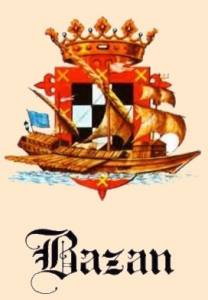
When I was a child my father worked as a draftsman in Empresa Nacional Bazán.
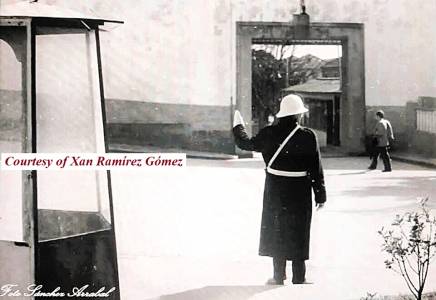
The shipyard was in those days concealed from view along its entire perimeter by a whitewashed wall four meters high. Years later some stretches were toppled and replaced with a picket fence to let the public peep through.
Various entrances segregated the Bazan-Ferrol employees. Blue-collar employees entered through this door. Downslope from it, white-collar employees like Dad entered through the door photographed on the left. This opening in the wall no longer exists; it faced the downtown gardens. Navy personnel had and have two reserved doors secured by marines. The one named "Dry Dock Gate" faces the right flank of the Monument to the Fallen in Africa, a memorial raised in 1949 to all the Ferrolian soldiers who died in the Spanish colonial wars of that continent. The Dry Dock Gate boasts a clock tower built in 1857. The second Navy door is situated nearest the harbour on a small triangular offset where stands an obelisk named Fountain of Fame dating from 1787.
A narrow sidewalk made of tiny-square paving slabs borders the long white wall running from the Dry Dock Gate to the Fountain of Fame Obelisk. The sidewalk is offset from the ring road by plots of grass with trees, lamp posts and rounded cement edging. I remember strolling back from the harbour some summer night with family and friends. I could not resist the temptation of tripping and balancing on the round edging. Our pace was relaxed, the conversation of the adults animated, the air mild: a brief interlude of bliss.
Empresa Nacional Bazán took off in the month of October, 1947, and began construction at a furious pace.
Nine destroyers were launched between 1951-61,
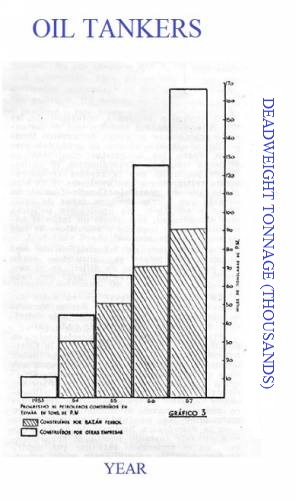
At the same time Bazan was graduating to the construction of bulk carriers and oil tankers.
The graph on the right shows the cumulative deadweight tonnage of the oil tankers delivered at the Ferrolian shipyard between the years 1953-1957. The diagram is taken from the article entitled, "Bazán y la Construcción Naval en España," written by Ernesto J. Maceira the Chief Projects Engineer and which is found on pg. 14 of Bazan, 4. I have added the blue-coloured labels in English (top, right and bottom).
The leftmost labelled abscissa corresponds to the year 1953. Increments along this x-axis are of course in units of 1. The rightmost labelled abscissa corresponds to the year 1957.
The lowermost labelled ordinate is 10, corresponding to 10,000 tonnes. Increments along this y-axis are in units of 10. The uppermost labelled ordinate is 170, corresponding to 170,000 tonnes.
Histogram height increases from left to right as one would expect. The white portion of every histogram represents the oil-tanker tonnage built at Spanish shipyards other than Bazan-Ferrol. The striped portion represents the tonnage built at Bazan-Ferrol. A cursory glance reveals that Bazan-Ferrol failed to deliver a single oil tanker during the year 1953. Deliveries started in earnest during 1954 and the output immediately eclipsed that of all the other shipyards combined.
On page 15 of Bazan, 31, February 1967, as part of an article entitled, "The Construction of Oil Tankers," F. Vila Segura the writer lists "the oil tankers built or being built by the factory of E. N. Bazán of El Ferrol del Caudillo." His table is reproduced below, abridged to the year-of-launch interval 1953-1965. The two columns below entitled "Year of Launch" and "Year of Delivery" constitute my own contribution. Moreover I have corrected Segura's year-of-contract data for the four "T" class oil tankers, "Valmaseda," "Durango," "Compostilla" and "Ribagorzana," based on the information found on this webpage.
| Name |
Deadweight Tonnage |
Year of Contract |
Year of Launch |
Year of Delivery |
Feb. 1967 Status |
|---|---|---|---|---|---|
| Almirante F. Moreno | 14,000 | 1951 | 1953 | 1954 | In service |
| Almirante M. Vierna | 14,000 | 1951 | 1953 | 1954 | In service |
| Puertollano | 18,410 | 1952 | 1955 | 1955 | In service |
| Puentes de G. Rodríguez | 18,410 | 1952 | 1956 | 1956 | In service |
| Valmaseda | 19,250 | 1955 | 1957 | 1957 | In service |
| Durango | 19,250 | 1955 | 1958 | 1958 | In service |
| Compostilla | 19,250 | 1955 | 1958 | 1959 | In service |
| Ribagorzana | 19,250 | 1955 | 1960 | 1960 | In service |
| Bilbao | 32,000 | 1959 | 1961 | 1962 | In service |
| Guernica | 32,000 | 1959 | 1962 | 1962 | In service |
| Ingeniero Hermitte | 19,660 | 1960 | 1964 | 1967 | Under construction |
| Sardinero | 53,000 | 1963 | 1965 | 1966 | In service |
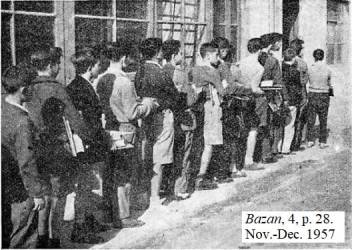
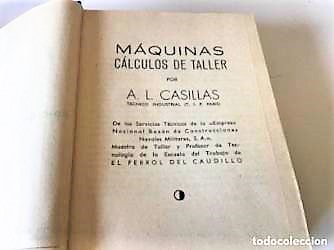
The above photograph comes from the article entitled, "And Tomorrow They Shall Be Men," found on page 28 of Bazan, 4, November-December 1957. The original caption reads: "Apprenticeship class of 1957-58 picking up school supplies." The article states that 154 applicants had passed the entrance examinations and qualified to join Bazan-Ferrol as apprentices. Luis Eugenio Lopez Rey the author wishes every single one of them "the most commendable success, that is, a permanent job in the Company, foundation of your future," and ends the article with this encouragement, "Welcome, children. Work and study. And tomorrow you will be men."
Almost all Bazan workers were trained by the company. Their apprenticeship started at the age of ten to fifteen. According to the feature article in La Voz de Galicia of Sunday August 29, 1954, apprentices could specialize in one of Machining, Drafting or Accounting. They signed up for an intensive 3-year training period subdivided into six semester courses. The teaching staff numbered thirty-seven for the theoretical courses. Daily classes ran from 7:45 AM to 8:30 PM. The trainees enjoyed a 3-month summer holiday during which they attended cultural seminars, went on paid trips, visited other factories and did recreational camping.
Beside the technical curriculum the shipyard enrolled all apprentices in sports and athletics. Gym classes were organized and run by three professional teachers assisted by nine instructors (Dad was one for a while). The factory organized year-round tournaments of track and field, basketball, soccer, swimming and longboat regattas. The factory grounds had a soccer field and a running track plus an excellent gymnasium with shower facilities and a basketball court. There was a second soccer field outside the shipyard a short sprint away.
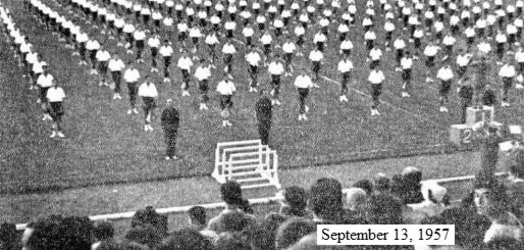
The curriculum included singing classes, whose better pupils were selected for the musical groups of the state organization, Educación y Descanso (Education and Leisure). This state union promoted culture, sports and built more than twenty-five holiday residences and chalet towns for workers across Spain.
All apprentices took the same subjects in first year: Arithmetic, Geometry, Algebra, Trigonometry and Mechanical Drawing I.
Specialization began in the second. Those specializing in Machining or in Drafting took some of these courses: Physics, Mechanics, Marine Boilers I, Tooling, Descriptive Geometry and Projection, Metallurgy, Plumbing, Mechanical Drawing II and Electricity I.
Third-year courses included: Engines, Alternative Engines, Motors, Turbines, Lathes, Technical Sketching, Blueprint Reading, Foundry and Molding, Modeling, Marine Boilers II, Shipbuilding, Mechanical Drawing III and Electricity II.
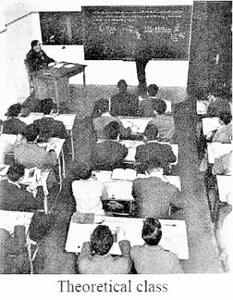
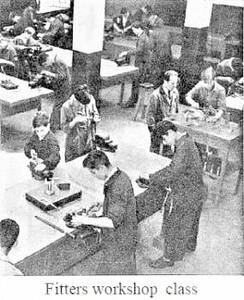
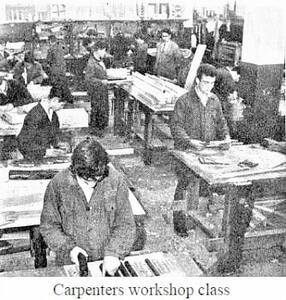
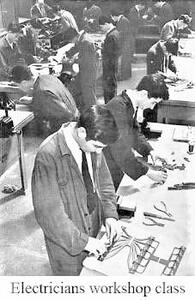
The first three photographs above (from left to right) come from the article entitled, "The Apprenticeship Schools," found on pages 8-11 of Bazan, 10, January-February-March 1959. The fourth comes from that number's back cover. The article first boasts of the long-running reputation of the Ferrolian shipyards, "many were the boats that descended the slipways of Ferrol, so many that they composed mighty navies by themselves." Next it informs the reader that the Factory had built "new, modern, comfortable, luminous" classrooms for training the apprentices. Gym classes and participation in sport competitions were compulsory. The apprenticeship now took "more than three years of rational, efficient instruction." Manuel Cristobal Romero the author urged the apprentices, School and teachers to live up to their responsability so that Bazan-Ferrol would continue to rank among the best shipyards and so that "many will be the ships whose maiden voyage will ride the waters of this broad and beautiful bay of Ferrol."
The apprentices were not only graded on their courses, note was also taken of "their moral condition and work attitude." Successful graduates became regular employees of the company. Unsuccessful ones were hired as general-purpose laborers or helpers.
When I was a child the apprentices boasted their own bugle-and-drum band. Its members dressed in faded blue workwear. Whenever they appeared at the close of a military parade or in a religious procession the public applauded them the most.
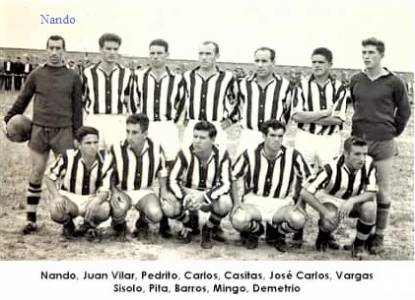
Bazan sponsored its own soccer club between 1947 and 1981. Its original name, "Galicia," was changed to Arsenal when Bazan took it over in July 1947. The team played in the Third Division of the Spanish soccer league until the year 1965. Dad would take us to watch Arsenal play on Sunday afternoons at the old Manuel Rivera Stadium after a brief stop over at a candy shop near the venue. There was no artificial lighting so the games started as early as 3:30 PM when the days were short or as late as 6:00 PM when they were long. In the cloudy days of late fall and early winter it would be getting dark by the time the game finished. The scoreboard was a steel panel with boards numbered 0-9. The scorekeeper inserted and replaced the boards manually. The public was made up mostly of men and children. Tobacco smoke filled the air and there were the inevitable swear words from a few fans in the stands. Some would bring transistor radios along to keep track of First Division matches. The pitch displayed a groomed green during the dry season (clip) but would become a quagmire during the late autumn and winter (clip). Nando the goalkeeper is the player I remember best. He would walk onto the pitch clasping a cap which he would finally wear if the sun was shining or would throw into his own net, baseball style, if the afternoon was overcast.
On September 19, 1954, Arsenal played a regular season match before visiting officers and sailors of the Dominican Navy. Spanish military and civil authorities were also in attendance. The match started at 5:00 PM and the final score was 4-0.
The 1954-55 season was Arsenal's best. On Sunday Jan. 9, 1955, the team defeated Lugo 7-2 at home and qualified for a round-robin, eight-team tourney of promotion to Second Division in which first place alone promoted. Arsenal got off to a great start, but on Sunday Feb. 13 the team travelled to Burgos without Nando; he stayed home mourning the death of a son. The substitute goalie received four goals and the team scored only two. The following Sunday the team with Nando back in the lineup faced Torrelavega at home. The local referee disallowed a legitimate Arsenal goal in the ninth minute. The visitor played defensively for the remainder of the match and were lucky to score on a counterattack in the last minute of play. These two consecutive losses took the wind out of the team's sails. On April 17 Arsenal trailing by seven points played a home game against first place Indauchu. The game started at 5:00 PM and despite windy conditions Arsenal won 2-0. Next Sunday, with only two games left, they played their final home game and beat second-place Langreano 4-2. The crowd in the stadium gave the players a "deafening ovation" as they saluted from midfield at the end of the match. They next travelled to Valladolid where they lost the last game of the tourney, a mere formality. Arsenal finished third in the standings with a 6-3-5 record.
Between the years 1960 and 1965 the city's professional team Ferrol and the shipyard's Arsenal were direct Third Division rivals. The last time I recall watching them play was on Sunday February 24, 1963, when after a brilliant performance and leading 1-0, Arsenal threw the game away with two deliberate own goals in the final few minutes of play. Rumour had it that the match had been fixed to give Ferrol a chance to promote to Second Division at the end of the regular season. If memory serves me right, we never went back to watch another soccer game.
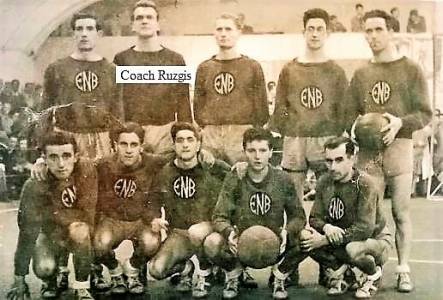
The source for the photograph was the Twitter account "Fer Agras" with associated date, May 20, 2022.
Bazan also sponsored its own men's (1951) and women's (1953) basketball teams. The men's A Team was good enough to play in the Second Division, and some say that the shipyard refused a berth in the First for financial reasons. On Monday June 1, 1953, Bazan won the Regions Federation Cup in Valladolid by defeating Español de Valencia 43-30. The newspaper Mundo Deportivo praised the speed of the Bazan players and singled out Rusghise [sic] as their best player, who was also the coach and whose real name was Michael Paul Ruzgis.
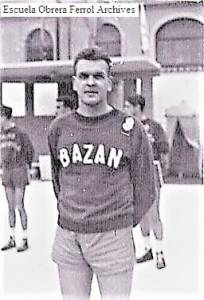
The 1954 season was arguably Team A's best. In February Bazan played a home friendly against the Spanish national team, the game started at 7:30 PM and Bazan won by the score of 69-57. Between May 11-13 Bazan played in the round-robin inter-regional championship held in Valladolid against Águilas de Valladolid, Real Valladolid and Covadonga de Gijón. On Tuesday May 11 Bazan beat Covadonga de Gijón 44-28 with "manifest superiority." On Wednesday Bazan defeated Águilas de Valladolid 59-43. The decisive game was played at noon on Thursday "under a blazing sun" against Real Valladolid. In a "colossal feat" Bazan won 54-39. The outstanding Bazan players of the series were Pardo, Lobón and Polo. The championship advanced the team to the Generalissimo's Cup in Madrid where they would face San Adrián de Barcelona, Estudiantes de Madrid and Real Madrid.
On Thursday May 20, 1954, Bazan left Ferrol for Madrid on the TAF. On Sunday at 7:00 PM Bazan beat San Adrián de Barcelona 64-46. On Monday at 11:00 PM Bazan defeated Estudiantes de Madrid 74-63. On Tuesday at 11:00 PM Bazan succumbed to Real Madrid 37-67. "The superiority of Real Madrid was evident, they were always ahead on the scoreboard." On Wednesday May 26 the team returned from Madrid. "Players of juvenile and junior basketball teams [and] many fans gave the Ferrol sportsmen an affectionate and cordial welcome home" at a transfer railway station forty-one kilometers away from the city. A short note in the newspaper La Voz de Galicia of June 9, 1954, summed up the extraordinary season thus, "Our unreserved applause for Ruzgis and those sportsmen he so skilfully trains."
This photograph taken at Manuel Rivera Stadium is almost certainly from a public presentation/celebration of the basketball team shortly after returning from its triumphant debut in Madrid. The photograph comes from the archives of Escuela Obrera Ferrol.The format of the Generalissimo's Cup for the year 1955, held in Barcelona, was altered—rigged, one could argue—to favour a final between Madrid and Barcelona teams. On Friday May 20 the quarter finals of the Madrid Group started with six teams, Real Madrid, Bazan, S.D. Astur, Estudiantes de Madrid, Español de Barcelona and Águilas de Valladolid, split in two groups so the two teams from Madrid did not have to face each other. Every team played two games. On Saturday Bazan defeated S.D. Astur 79-48. On Sunday Real Madrid defeated Bazan 66-43, knocking it out of the competition.
The following year Bazan ended third behind Real Madrid and Aismalíbar de Montcada and ahead of Grupo Covadonga.
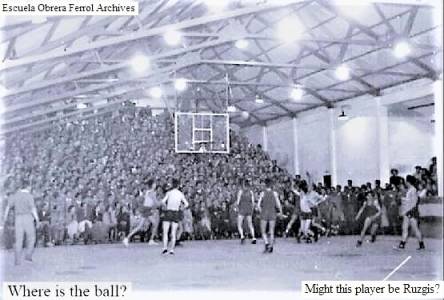
The Lithuanian National Radio and Television Broadcasting Service published an excellent webpage on November 29, 2020, written by Rytis Kazlauskas, which casts light on what transpired during the year 1956. Ruztgis and his family had been living a carefree life in Ferrol. But one day in 1956 as Ruztgis and his eight-year-old son Michel were returning from the shipyard they were met by three officers.
"One of them took me home, while Dad got in the car with the other two. The one who was escorting me introduced himself as a representative of Franco's political police and said that there was nothing to worry about," Michel said. "Dad came back home after a few hours and said that everything was fine. But he warned me not to walk close to roads from then on and to scream to attract people's attention if a car stopped next to me."
Soon after the encounter with the officers, Ruztgis' family went to visit friends who lived some 30 kilometres away from Ferrol. Michel recalled that while he was playing out in the garden, a man started reading words from a notebook and asked him whether he had ever heard these words at home: Leningrad, anarchists, secret police, Budriunas, N.A.T.O., F.B.I., Kaunas, Republicans, Vilnius. The list went on. Michel said yes.
Michel said that the home environment turned hard after the episodes. Ruztgis and his French wife Andrée started arguing over their next place of residence; she wished to return to France, he preferred going back to the U.S.A. and beginning a new life there.
"I don't remember when exactly, but officers came to our house and took Ruzgis with them. He kissed us and promised to bring us to the U.S.," Michel said. The following day, Ruzgis' wife and children were relocated to Santiago de Compostela, a town some 100 kilometres south of Ferrol. Andrée started teaching French and literature in the local university. "People at my school advised my mother to introduce herself by her maiden name so as not to cause any problems because of the American one," Michel wrote.
Archived American documents reveal that Ruzgis left Spain on December 1, 1956, bound for Miami where he landed two weeks later. He then went to Cook County (Chicago) by way of New York. Ruzgis was born in Cook County on January 15, 1919, and there he passed away on December 15, 1986.
Bazan would soon be demoted to the second group of the Second Division of the National Basketball League, a division euphemistically tagged First Division B. The basketball teams of this group were Galician plus one Castilian Maristas Champagnat de Salamanca. Bazan was the champion of the group for the 1957-58 season. The following year Bazan defeated U.D. Lucense 106-65 in the final and were champions again.
The golden years passed away with the nineteen fifties. La Voz de Galicia of February 24, 1961, remarked in passing, "The potential of the Bazan team has dropped sharply in the last two seasons," and four days later, "Bazan is not even the shadow of the powerful team of yesteryear."
I remember going at dusk with Dad and my two brothers to watch a basketball game in the gymnasium, the year may have been 1959. We entered the shipyard via the Workers Gate. The stands were few, the fans loud. I do not remember who played or what the final score was, but the mood was subdued, even downcast at the end of the match.
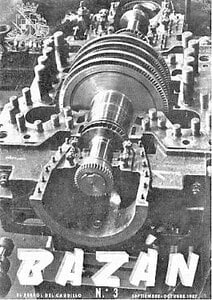
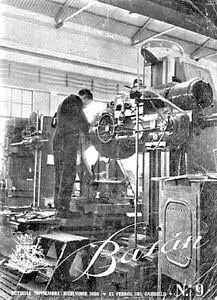
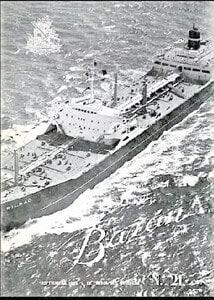
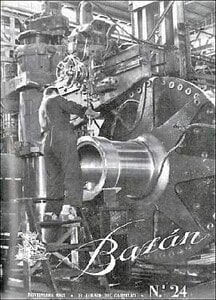
Bazan Magazine first came out in May-June 1957 with the express goal of becoming the "literary vehicle" of Bazan and of promoting camaraderie between workers, personnel and company staff inside and outside the shipyard. In Bazan's first number the editors declared their intention of creating a popular magazine, easy to read and understand, straightforward, cheerful and restrained, "without coarse leanings or vain prophecies." It was everyone's duty, they asserted, to make the bimonthly publication good and long-lasting. The pages of the magazine were open to contributions by managers, employees and workers. Bazan promised to keep its readers abreast of the burning questions of the day, to divulge the technical and social activity of the company, to make entertaining observations on memorable dates, and to orient readers with briefings on the Arts and Letters without neglecting a humorous nook intended to bring cheer and optimism after a hard day's work.
The first seven numbers of the magazine came out bimonthly as promised, the following thirteen were released trimonthly. Starting with number 21 (September 1962) release dates became erratic and the magazine eventually ceased publication in 1967.
The contents of Bazan Magazine are examined for the years 1956-58, 1960, 1962 and 1964.
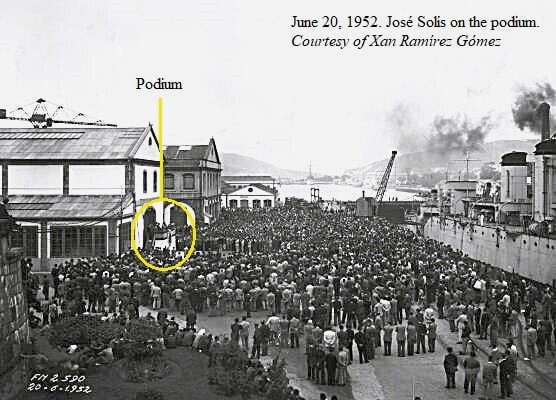
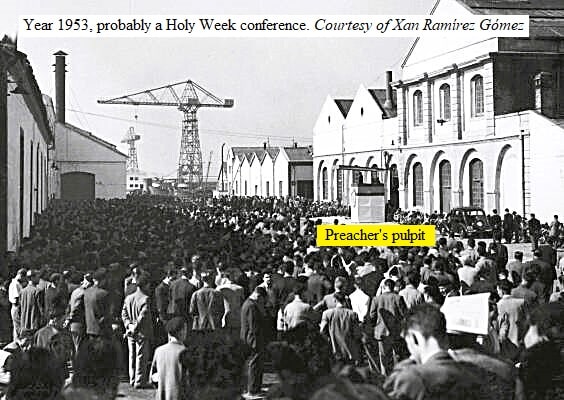
The above photographs received by e-mail on February 18, 2025, are courtesy of Xan Ramírez Gómez.
The photograph on the left shows a political meeting on June 20, 1952, where the speaker was José Solís Ruiz the National Delegate of Trade Unions. All unions answered to the state.
In 1953 Ruiz was enrolled in the "Council of the Kingdom." The induction ceremony recorded by this newsreel bares the religious odour that filled Franco's regime. Ruiz in white uniform is the last selectee to kneel down before an off-color crucifix and recite the pledge of allegiance.
In 1957 Ruiz became Minister Secretary-General of the "National Movement," a catchphrase embracing all the political groups affiliated to the Nationalist side of the Spanish Civil War.
The principles of this National Movement were defined by law in 1958. Article I enjoined every Spanish citizen to preserve and further the unity, greatness and liberty of Spain. Article II bade,
the establishment of the nation's obedience to God's law according to the doctrine of the Holy Apostolic Roman Catholic Church, the one true faith, the undetachable component of the national consciousness and the inspirer of its legislation.(Article II. Ley de Principios del Movimiento Nacional. May 17, 1958)
The photograph on the right shows an outdoor "religious conference" of 1953. The actual date is unknown, but judging by the fine weather, it was probably held during Holy Week, which in 1953 stretched from Sunday March 29 to Sunday April 5. The Religion Section of Chapter 12, "Bazan Magazine for the Year 1960," and of Chapter 16, "Bazan Magazine for the Year 1964," abound in this theme.
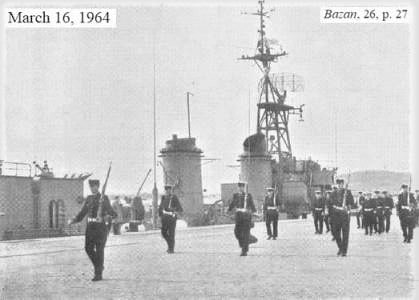
When I was a child Ferrol was full of soldiers and sailors doing their compulsory military service (year 1952 newsreel in Ferrol). The military installations of Ferrol occupied around 20% of the real estate available. There were a fair number of parades held every year on the road that girded the protective wall of the shipyard. I enjoyed watching them until I grew old enough to realize that the unverified stories of how tough military service was on most conscripts might apply to me soon. One such story held that army sergeants who had killed a recruit could be identified easily because they were forced to wear a black armband. Incongruously many a serviceman attended yearly reunion banquets to celebrate with other comrades-in-arms the "good old times" in the barracks.
At the start of every year Town Hall would publish the names of 20-year-old males slated for compulsory military service. Local newspapers published the list and the citizenry was asked to snitch on the whereabouts of no-shows. Those listed had until January 11 to report to the local draft office or be suspected of draft evasion. La Voz de Galicia of Saturday January 23, 1954, published a roster of 49 young men in Ferrol who had not complied with the draft notice. Some might have emigrated without the military having been notified.
A measure of the size of the Armed Forces stationed in Ferrol was the yearly victory parade celebrating the Nationalist victory over the Republican side of the Spanish Civil War. The parade of the year 1954 comprised four companies of sailors from the fleet, two companies from the maritime department corps, two companies of naval infantry, two companies of regular infantry and one battery of the coast artillery corps. Note: The term "battery of artillery" may refer to a group of guns or to a formation of men equivalent to one company (End of Note). A company on parade had 14 rows of nine men plus four leading officers, i.e. 130 men. Therefore ten companies would equal 1,300 men. The troops in the parade of 1955 were three companies of sailors, a battalion of naval infantry, a company of regular infantry and a battery of the coast artillery corps. If the overall number of men was the same both years it would imply that a battalion equaled six companies, i.e. 6 × 130 men = 780 men. Both years the apprentices' marching band closed the parade, the crowds watching were "very numerous" and applauded the participants heartily. The parade of the year 1959 had two battalions from the maritime department corps, a battalion of sailors from the fleet, a battalion of regular infantry, a battery of the coast artillery corps and a set of 88/56 anti-aircraft guns.
Another measure of the size of the Armed Forces stationed in Ferrol was the number of troops lining the route of the yearly Corpus Christi procession (year 1957 newsreel in Toledo). Children of every parish took part in this procession along with the "children of Empresa Nacional Bazán," Town Hall in full, army commanders, artillery cadets, navy commanders, fleet commanders and the engineers of the shipyard. Armed soldiers and sailors lined the route and took their cap or helmet off, set their right knee down on the pavement and tilted their firearm as the monstrance carrying the Sacred Host passed them by. At the conclusion of the procession the troops staged a parade along the ring road. The itinerary of the procession of the year 1954 was covered by four battalions, one Army and three Navy, i.e. 4 × 780 men = 3,120 men.
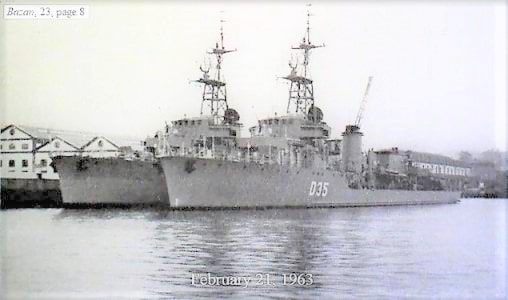
A measure of the size of the fleet berthed at Ferrol is given by two news items that appeared in La Voz de Galicia during the month of September, 1954. On the 6th four destroyers departed and on the 15th a battle group of two cruisers escorted by four destroyers, a minelayer, a minesweeper and a torpedo ship sailed away.
From 1952 to 1961 the naval base was home to the First and Fourth Divisions of the Fleet with a total of two cruisers, six destroyers and many escort vessels.
From 1961 to 1965 Ferrol was home to the Naval Group of the North, a bureaucratic renaming which left the operational importance of the naval base unchanged.
The number of foreign military visits to the city increased with time. In the year 1954 the city welcomed U.S. Navy commissions on March 3, April 21 and September 2, an Italian mission on April 22, the Portuguese Defence Minister on July 26, a Dominican Navy division on September 21 and the French frigate L'Aventure on November 13. In the year 1955 it welcomed two separate American commissions, the first one between March 1-4 with at least 10 engineers on the roster, the second one on August 10. In addition an Egyptian military mission arrived on October 15. The French "corvette" Le Boulonnais arrived at 9:00 A.M. on June 22 and lingered for a 5-day visit. On July 7 USS Lewis Hancock and USS McGowan entered port at 1:00 PM to a very cordial welcome. "Two Spanish ships saluted the new arrivals with salvoes." The pair came and went as they pleased for several weeks. They were followed by USS Daly and USS Smalley on September 26.
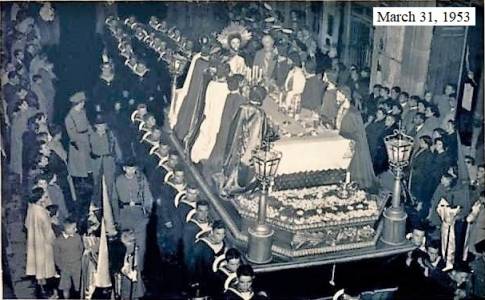
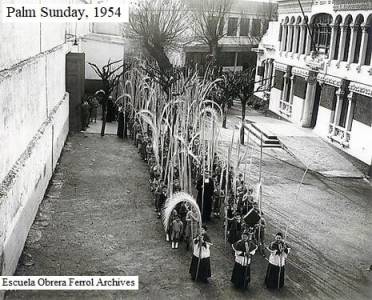
Religion played a central role in the Ferrol of my childhood. Street-level displays of religiosity ranged from simple affairs like the blessing of a new store, or the taking of the Blessed Sacrament under canopy to sick parishioners, to the pageantry of Holy Week and the Corpus Christi procession of late spring.
Every pillar of Ferrol society had its patron saint, a date observed with a Mass and a fraternity meal. Bazan had two patron saints: St. Joseph (March 19) and Our Lady of Carmel (July 16) who was also the Navy's. On July 16, 1954, all shops in Ferrol closed except for bars and cafeterias. The Mass held at San Julián Church was attended among others by the captain general of the maritime department, the military governor of the base and the mayor. The chorale of the shipyard sang during the service and a company of naval infantry waited outdoors. The public was "very numerous." On the eve of St. Joseph, 1955, the shipyard rewarded the oldest and most reliable worker with an important sum of money: the beneficiary was a shop sheet-metal worker.
Every branch of the military stationed in Ferrol had its patron saint. The patron saint of the regular infantry was the Immaculate Conception (December 8). On this day of 1954 a solemn Mass was held in San Julián Church at 11:00 AM. The Mass was presided by the captain general of the maritime department, the military governor of the base, the mayor, the admiral of the fleet and the rear admiral of the arsenal. The Association of Ladies of the Immaculate Conception also had their place of honour. Many other local officials were present, army and navy officers and commanders and "a very numerous public." A company of regular infantry made up the guard of honour. A military parade followed the Mass. Garrisons served their troops a special meal. The following day a Requiem Mass was celebrated at 11:00 AM for the eternal rest of all dead infantrymen. The patron saint of the artillery corps was St. Barbara (December 4). On this day of 1955 the pattern was repeated: solemn Mass in San Julián Church at 11:00 AM, a battery of coast artillery as honour guard, and the next day a Requiem Mass at 11:00 AM for the eternal rest of all dead artillerymen.
Every major organization and trade had its patron saint. The patron saint of the School of Commercial Agents was Our Lady of Hope (December 18). On Saturday December 19, 1954, the School attended a solemn Mass in San Julián Church at 11:00 AM. At noon a new center was inaugurated and blessed, the invited guests toasted with a glass of Spanish wine. A midday meal followed in a downtown restaurant. On Monday December 21 a Requiem Mass was held at 11:00 AM for the eternal rest of all dead commercial agents. The following year the celebration which fell on a Sunday acquired "extraordinary splendour." The solemn Mass at San Julián Church was presided by the president of the School, the captain general of the maritime department, the deputy mayor, a corvette captain, the local leadership of the fascist Falange Española and the president of the port authority for public works. Again the public was "very numerous." The Requiem Mass was held at 11:00 AM on Monday. Note: Requiem Masses for all dead members of a profession were fairly common, e.g. on the Day of the Book, 1954, a Mass was held at San Julián Church for "all dead Spanish writers" (End of Note). The patron saint of watchmakers and jewellers was St. Eloy (December 1). On this day of 1955 they had Mass in San Julián Church at 12:00 noon for all dead watchmakers and jewellers. Town Hall feted the living professionals with a "fraternity meal" in one of its chambers at 2:00 PM. There was also an evening party with dinner and dancing. The patron saint of Radio Ferrol was the archangel St. Gabriel (March 24 until the year 1969). And on it went.
Doing a pilgrimage to Santiago de Compostela was also an obligation for many workers. On Sunday August 29, 1954, a delegation of a thousand shipyard workers and employees made Bazan's official pilgrimage by train. Between 350 and 400 apprentices had set out on foot three days earlier, "equipped with all the required provisions including camping gear." The official delegation was headed by the chairman of the shipyard; he made the "offering to the apostle."
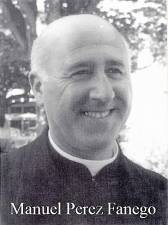
That same day Bazan's Polyphonic Chorale, composed of 70 men, 40 women and 30 children, gave an outdoor concert at Quintana Square in Santiago de Compostela before a large audience (photograph). The chorale, founded by Reverend Manuel Perez Fanego the chaplain of the dockyard, had had its official debut on June 15, 1941, at the "Jofre" theater. It performed outside Ferrol for the first time on April 23, 1953. It received great reviews everywhere it sang. It even turned down an invitation by the Spanish Embassy to go to London, England. On September 20, 1956, the chorale sang in the cathedral of Santiago de Compostela under the baton of American composer, choir director, professor and musicologist William Levi Dawson (b. 1899, d. 1990) during the final stop of the American's Spanish tour. That day left a "very gratifying souvenir in everybody's spirit and constituted a source of legitimate pride for the chorale and for the shipyard."
On September 26, 1954, Town Hall made its official pilgrimage: "around 1,500 Ferrolians gained the Jubilee of Holy Year last Sunday," reported the newspaper on the Tuesday. The citizens travelled on chartered buses, the police rode motorcycles.
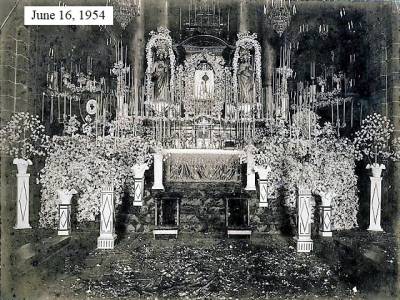
The year 1954 was particularly fervorous. On Easter Sunday a "solemn act of Easter communion" took place at the Hospital of Charity escorted by a platoon of naval infantry with regimental flag, squad of fusiliers and marching band. The patients were served an extraordinary meal. On Sunday May 9 a throng brought the Virgen de Chamorro icon in procession from its hermitage on a high place three kilometers away. Thousands of citizens accompanied the statuette "on her triumphal entry to Ferrol." There was Mass at the Home of the Apprentices with full attendance. The icon stayed in the city for one week, conveyed from parish to parish. On the afternoon of the 12th it was carried to San Julián Church amid "crowds, emotion, devotion and fervour" and there it remained until the journey back to the high place on the 15th. At 7:30 PM that same day another icon was brought from a church six kilometers away. Previously Town Hall had urged everyone to festoon their balconies. The arrival of the second icon was an "apotheosis"; the statuette was greeted by crowds, the military and Town Hall. On June 16, 1,000 carrier pigeons were released at Plaza de Armas as the Corpus Christi procession reached the square. On Sunday August 15 a Catholic association of nighttime worshipers celebrated "its golden wedding anniversary." Many members of the association came by train from other parts of Spain to take part. There was Mass at San Julián Church, a procession, an official reception at Town Hall and a complimentary cruise around the bay. Even a spokesman for the "Generalissimo" sent a telegram of congratulations. Another grand occasion was the "Day of the Hispanic Race" (October 12). A solemn Mass was held at San Julián Church "to consecrate the city of Ferrol to the Immaculate Heart of Mary," and the newspaper reported that "the naves overflowed with people."
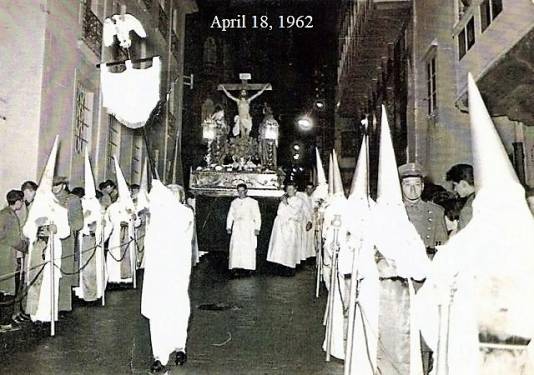
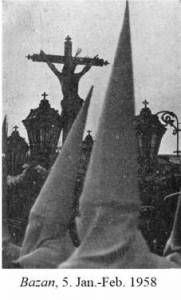
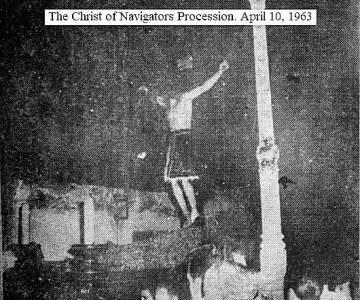
The pageantry of Holy Week was the highlight of every year; the first record of a Ferrolian procession dates from the year 1616. Palm Sunday had the cheeriest processions, palm-carrying children and no pointed hoods. The Christ of Navigators procession on Holy Wednesday is the oldest. There were no pointed hoods and its circuit hardly left the circumscription of what used to be the fishermen's quarter. This was not an "official" procession, yet one of the more deeply felt. On April 6, 1955, its marching sequence was a band of bugles and drums followed by a pole cross and two pole candlesticks, rows of male and female devotees, among them "many navy oficers and commanders," fishermen and sailors, a float with the image of the Christ borne on the shoulders of navymen, an escort of navymen, parish clergy and last a naval infantry band of bugles and drums. A "large number" of the faithful was present. Behind the float walked the mayor, a navy commander and a retired vice admiral. Through traffic was diverted to the ring road from noon on Holy Thursday until Saturday. Holy Friday had the greatest number of processions, Holy Burial was the gloomiest. The last one set out at 11:00 PM and went by the Galician nickname, Os Caladiños (The Dear Quiet Ones). I remember watching it with my parents and brothers once. On April 8, 1955, its marching sequence was headed by the brotherhoods of Jesus the Nazarene and of St. John the Evangelist (red hoods and capes, white robes) then a first float with the image of St. John the Evangelist, followed by the brotherhoods of Our Lady of Mercy (green hoods and capes, white robes) and Holy Burial (black hoods and capes, black robes with golden embroidery) then a second float with the throne image of Our Lady of Sorrows, parish council and secular authorities, brotherhoods of Our Lady of Sorrows, Sacred Supper, Christ of Mercy and Our Lady of Piety. The presidents of the various brotherhoods walked together at the close. This was the only procession without a military band (hence its nickname).
The Corpus Christi procession was the second highlight of the religious year. Traditionally children did their first communion in a late morning Mass that day. The procession set off at 6:00 PM from San Julián Church. On June 9, 1955, it made temporary stops at makeshift altars put up on behalf of the civil government, Town Hall, Falange Española, Navy and the shipyard. The newspaper of May 28, 1959, gave the location of the altars: the Army's at the military government building, the altar of Town Hall at Plaza de Armas, the altar of Falange Española at Plaza de Amboage, the Navy's at Navy Command Headquarters and Bazan's at the esplanade in front of San Julián Church. Bazan's choir performed in San Julián Church and at Town Hall square. A "traditional blessing of the sea" was performed at the Paseo de Herrera lookout. The newspaper recorded that "the gonfalon of the Most Blessed was carried by the state prosecutor accompanied by the principal of the high school and by the chairman of Bazan."
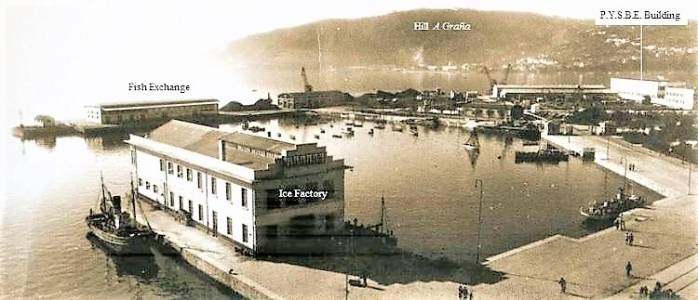
|
Acknowledgement: Mr. Anxo Grandal d'Anglade pointed out the correct locations of the P.Y.S.B.E. building (where his father worked as a draftsman) and of the Fish Exchange via e-mail sent to me on Friday June 14, 2019. He also kindly invited me to download photographs from his Google Album on Ferrol, which I have done (e.g. the Bazan women's basketball team, a new hyperlink of Chapter 1, "The Shipyard"). |
It was probably the year 1957. Dad and I were down at the harbour and in our stroll we chanced across a pair of codders side by side, the dockside vessel moored to a bollard. "These ones go to Newfoundland." Newfoundland. The placename conjured up images of thick fog, driving rain, snow and ice, endless gales and heroic walnut-sized boats braving monstruous waves. I could but look on the vessels admiringly.
P.Y.S.B.E. Company financed the cod fishing enterprise. The acronym stood for Pesquerías Y Secaderos de Bacalao de España, a Basque business with headquarters in Pasajes that had a second base and factory in Ferrol. The company owned a couple of buildings in the harbour, the "ice factory" (foreground of the above photograph) and a two-storey building. The names of some P.Y.S.B.E. ships that used the port were Euskalherria, Galerna, Hispania, Mistral, Tifón and Tramontana. Most dated from the nineteen twenties. In January of 1955 Bazan took on the maintenance and repair of four.
The following clip records the inauguration and blessing of the PYSBE installations and of the codder "Mareiro". The clip co-opts the newsreel's intro for show. The actual newsreel, thirteen minutes long, was first shown on Monday March 5, 1945.
Voice-Over Translated: On the "Concepción Arenal" piers of El Ferrol del Caudillo the codfish processing plant of P.Y.S.B.E., which bears the name of Saint Julian the patron saint of the city, has been officially inaugurated. The installations and the work done here are one more demonstration of the high level and growing industrial vigor attained by this branch of our economy in Spain. In the act of inauguration Dr. de Arriba y Castro the prelate of Oviedo blessed the factory. Accompanied by the authorities and invited guests the bishop blesses the ship "Mareiro" also, one of the boats slated for service at this important center.
There was a second codder company named P.E.B.S.A. with headquarters in A Coruña. Their ships bore the name of female saints, and so together with the Portuguese codders that followed the same tradition, they were known to Newfoundlanders as "Santa's Ships": Santa Amalia, Santa Elvira, Santa Inés and Santa Rita among others. For their part Ferrolian fishermen dubbed St. John's Signal Hill, Chamorro. The twelve P.E.B.S.A. boats dated from the nineteen forties and fifties, most were built by the rival shipyard Astano, five kilometers away from Ferrol by road. The last one slid down the slipway at 4:30 PM on March 25, 1959. Its name was Santa Regina and the newspaper dubbed it "a magnificent codder."
All sources agree that a codder's life was very tough.
Whoever has sailed in the area of the Grand Banks will know that the temperature is usually below freezing during the winter and that the area is well known for the fierceness of its storms, which coming one after the other, afford no respite to the crews and make seafaring in these waters difficult. I had the experience of working on deck deep in the month of November at Port-Cartier and I can guarantee you that I finished the job virtually frozen. And this happened on a modern boat with excellent heating and with the deck fifteen meters above sea level. Now let my readers imagine the small steamboats of nearly a hundred years ago plying the heavy seas—smooth seas, they called them—with scant heating and with the crew labouring on deck having little protection against the temperature, stationed hardly a meter above sea level, skinning and cleaning the cod fish (a chore that caused eczema and skin irritation) and being periodically exposed to deck-clearing waves for which only a small contraption was provided...to hang on to. Working without rest until prostration set in...without a water closet, with permanent humidity and temperatures below freezing. Add to this the absence of doctors or medicines, the lack of privacy or hygiene, exhaustion and the neurosis caused by the working conditions and one will grasp the way of life of these courageous and hardy mariners.

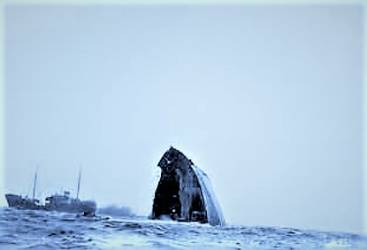
On June 1, 1955, the newspaper reported tersely that the codder "Tifón" had sunk off Newfoundland and that the entire crew had survived.
P. U. Ochoa (see footnote) explains that the Portuguese ship Invicta rammed the Tifón accidentally and sank it within eleven minutes. Most of the crew was picked up by the Portuguese trawler Álvaro Martins Homem.
Ochoa states that the "Tifón" had its hold full and that providentially the accident occurred in relatively tranquil seas, for about an hour later another storm blew in and the rescue would not have been possible then.
Portuguese references to the accident give the date of the mishap as May 26.

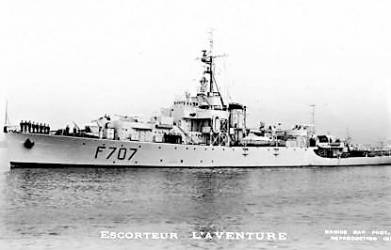
P.Y.S.B.E. paid homage to the French crew of L'Aventure in the year 1961.
The French frigate provided mailing services and meteorological data, warned about the location of ice floes, transported sick or injured fishermen and maintained constant radio communication with the trawlers.
Captain Blanchard remarked in his memoir, "L'Aventure Et Ses Terres-Neuvas," that "French and Portuguese mariners get along quite well and render each other mutual services."
However the frigate's captain writes that the French mistrust the Spaniards and that "relations between Canadian and foreign fishermen are not cordial."
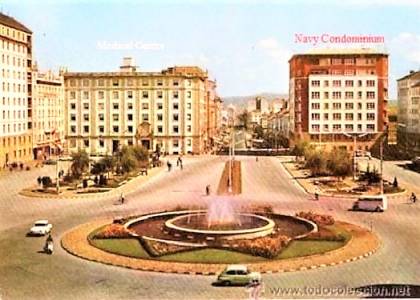
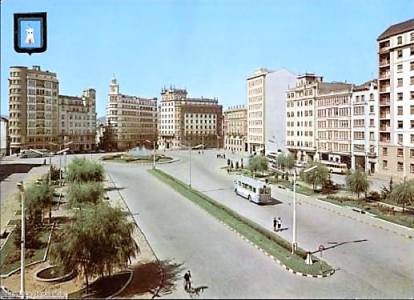
The streets of Ferrol compose a perpendicular grid with its main axis (Calle Real) aligned northeast-southwest and partitioned by three squares, outermost Plaza de España, central Plaza de Armas where the city hall is located, and harbour-nearest Plaza de Amboage. The first one is now a pedestrian zone. The trees of the Town Hall square were cut down and the pavement is cracked in spots. Plaza de Amboage is the least altered.
This short train ride from Ferrol to the hamlet of Neda was also filmed before my departure.
In the mid-fifties Town Hall created a small artificial beach on the seafront beside the harbour. A snack bar accessible by a raised boardwalk was installed and the beach was ironically named Copacabana.
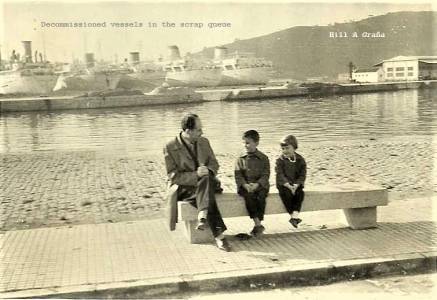
Courtesy of this webpage
The source for the information contained in this chapter is the partial archive of the newspaper La Voz de Galicia found in the local library. Some of the information garnered has proven useful elsewhere (e.g. the training of the shipyard's apprentices). Only the years 1954, 1955, 1959 and 1961 were archived between 1953-65. Although every page of the newspapers was interesting I focused mainly on the half-page section titled Ferrol Al Dia (Ferrol Update).
The following table contains newsdata for the year 1954 based on a sample of 236 newspapers. In addition to the absence of a Monday newspaper some seventy pages of the "Ferrol Al Dia" column were torn off deliberately by a previous user. This mischief impacted the months of October and November most.
The first field of every line below specifies the item. The second field is the number of cases reported. The third is the estimated number of cases for the year, obtained by multiplying the second field by 1.55 (i.e. 365 ÷ 236) and rounding off.
The census of June 5, 1954, gave 70,280 duly registered and 9,145 unregistered inhabitants of Ferrol for a total population of 79,425.
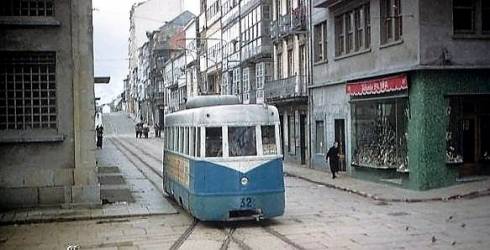
| 9. | E.S.L. Teacher position offered by Navy Command Headquarters. |
| 16. | Fox hunt in the countryside. |
| 21. | Town Hall will penalize the affixing of commercial posters to building facades. |
| 28. | 28-year-old man throws himself in front of a moving tram (above) and pulls himself out of harm's way at the last moment. |
| 30. | All itinerant photographers in possession of Leica cameras must report to the police station. |
| 31. | Compulsory diphtheria vaccination for all children between nine months and fourteen years old. Note: I got the jab (End of Note). |
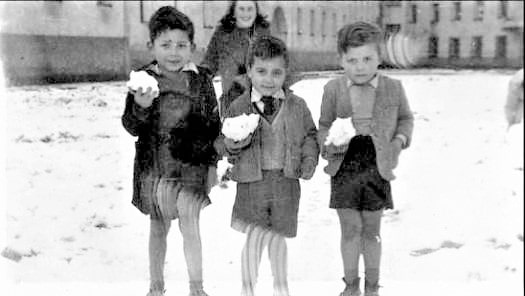
| 2. | Snowfall, probably under an inch. | |
| 9. |
Woman fined for selling loaves of bread below the government-fixed price (rationing in effect). Municipal ambulance starts to operate. |
|
| 10. | Angry editorial flogs the public telephone conference center. "The conferences meant for booth 5 were heard in booth 27, booth 27's in booth 28, booth 28's in booth 3 and every conference was audible in booth 6." | |
| 13. | U.S.A. Food Aid packages were distributed among the needy at the municipal welfare office. | |
| 14. | Power shutdown scheduled from 9:30 to 10:30 AM to carry out repairs in the grid. | |
| 18. | Editorial warns about "organized begging" on the main street. | |
| 19. |
Pool of eight shipyard workers scores 14/14 on the soccer lottery ticket of Sunday February 14 (stub) and earns 267,586 Pesetas. The First and Second Division matches selected for the ticket are shown below along with their outcome.
Draw 21
|
|
| 28. |
Town Hall sends a telegram congratulating the dictator for receiving the Grand Collar of the Supreme Order of Christ. Stranger hugs a man to pick his pocket and pilfer 300 Pesetas. Another man finds a wallet on the street and turns it over to the police. |
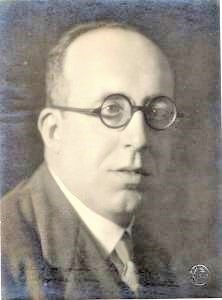
Ramón Otero Pedrayo |
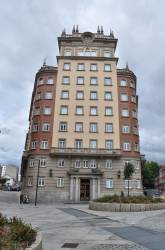
Army condominium |
| 13. |
Prof. Otero Pedrayo gave a public lecture at a guild headquarters. The talk started at 8:00 PM and carried the title, "Sentiment and Conscience of the Immortal in Galician Poetry." The organizers installed a "potent set of loudspeakers to ensure perfect audibility." The lounges were "filled to capacity with a select audience." Large delegations from Santiago de Compostela and Lugo attended. The speaker displayed "great brilliance." At the conclusion Pedrayo was "greatly applauded and complimented."
The following is a summary of his talk, Among peoples of the West with Celtic roots—or at least with a Celtic determinant—the concept of life is never positivist in the sense of temporal limitation. Owing to the force of imagination enhanced by the teachings of the Gospel they believe in immortality. Their philosophy is "saudade" (homesickness). And other abstractions. Let us not forget the idealism of Bishop Berkeley. |
| 14. |
Power shutdown scheduled from 9:30 to 11:30 AM. Trees shading a road were chopped down by unknown felons. |
| 16. | Four men fined for singing in the street after midnight. |
| 17. | Improvement work on the Batallones soccer field has started. |
| 18. |
Editorial denounces that the ducks in the pond of the municipal park are not being fed and that the water is dirty. Oil tanker "Almirante F. Moreno" leaves port on its maiden voyage. |
| 26. | Inauguration of a condominium (above right) for officers and commanders of the army at Plaza de España. The building has fifty-six flats. Each flat consists of five bedrooms, an office room, dining room, living room, kitchen and bathrooms. Present at the inauguration was Mohammed ben Mizzian ben Kassen the captain general of the eighth military region. |
| 30. | 30-year-old mechanic arrested for stealing copper and tin from the shipyard by impersonating a crew member of oil tanker "Almirante F. Moreno." |
| 31. | 12-year-old girl drowned when a plank of this railway bridge gave way. |
| 1. | 10-year-old child was run over by a truck. Died on April 3. A "very numerous" crowd accompanied the casket to the graveyard. His school teacher asked the newspaper to publicize the dire need for a traffic signal near the school. This was the second traffic accident there in a year. |
| 2. | Editorial decries the vandalism of street lamps. Adults and children are guilty of smashing light bulbs with stones. As a result between 300 and 400 lamp bulbs need replacing every month. |
| 4. | Ten-day exhibition of paintings by local artist González Collado (self-portrait above) in the casino. On April 7 the newspaper reported that a "very numerous public" keeps visiting the exhibit and that many paintings have been sold. |
| 6. |
Enthusiastic welcome for two members of the fascist División Azul returned from a Soviet concentration camp on April 2 along with two hundred and eighty-four fellow inmates. The two were greeted at the train station by the mayor, aldermen, town and county figures of Falange Española, its Women's Branch and its Youth Front, and by a "very numerous public." There was a street parade, a Mass and an official reception in Town Hall.
Note from 1941: On November 11, 1941, the head of Falange Española for Ferrol and county circulated this letter asking local businessmen to show their "patriotic spirit" by donating money toward a Christmas gratuity destined for the "heroic" División Azul fighting on the Bolshevik front. The letter pointedly remarks that the official closing date of the collection had been extended to November 12 due to the "manifest indifference shown by the town of Ferrol." The recipient owned a rendering factory and coughed up 10 Pesetas—approximately 20 USD year 2025—on the final whistle. The "Blue Division" had arrived to the outskirts of Leningrad the previous month to aid the German Army in the siege of the city. (End of Note from 1941). |
| 8. |
Editorial denounces the deplorable state of public washrooms. There is no maintenance, obscene graffiti abounds and the facilities are filthy. Naval infantry brass band gives a public concert in the gardens of Navy Command Headquarters at 6:00 PM. |
| 19. | Around 11:45 AM this morning a "very luminous object bigger than a 5 Peseta coin" (3.2 cm diameter) crossed the sky in a southeast-northwest direction leaving a contrail plus a very intense smell to gunpowder. |
| 20. | Two butchers fined for selling meat on a holiday. |
| 21. | Israeli vessel Atlit in port for repairs. |
| 24. | New trams have gone into service. |
| 25. |
Legal prices for loaves of bread are: 1 kg loaf, 5 Pesetas ♣ ½ kg loaf, 2.60 Pesetas ♣ 100 gram loaf, 0.60 Pesetas. Two basketball games in the gymnasium involving four local teams at 11:00 AM and 12:00 noon. |
| 29. | High school student finds wallet, father turns it over to the police. |
| 30. | Various Professional Activities Union (state-run) convenes a meeting in the Old Town Hall tomorrow at 12:15 PM for all draftsmen and geometricians. Note: Dad went, I guess (End of Note). |
| 2. | Charity performance in Teatro Jofre scheduled for May 7. Proceedings will go toward the purchase of textbooks for deprived students. |
| 3. | Water main shutoff scheduled from 9:00 to 11:30 AM. |
| 9. |
Fiestas de Ferrol committees will visit every house asking for funds, the name of donors and the amount given will be made public. Women's basketball in the gymnasium at 11:00 AM and 12:00 noon. |
| 14. | 2-year-old baby bitten by "a reptile." |
| 15. | Bread delivery boy ran away with the cash, 650 Pesetas. Arrested. |
| 16. | More women's basketball at the gymnasium, 11:00 AM and 12:00 noon. |
| 18. | Town Hall serves notice that over the next three days a military commission will inspect all horses, mules and asses taken to the fair near the Central Market Esplanade. |
| 19. | Piano concerto given by José Iturbi in Teatro Jofre. Starting time 8:00 PM. |
| 23. | Friendly soccer match Ferrol vs Tura Hennef at 5:00 PM. Final score: Ferrol 4, Tura-Hennef 1. "Clear superiority of the home team" although it is also noted that "the German players were tired after their long trip." |
| 25. | Items in police custody at the Lost/Found office: a wallet, a Brazilian passport, keys, a pair of children's shoes, some cash. |
| 28. | Artillery Corps Language Diploma recipients: 5 for the English language, 1 for French, 1 for French and English. |
| 30. | Editorial pours scorn on housewives' "frequent" complaint about household pests ("mice, cockroaches, ants, etc."). |
| 31. |
Launch of oil tanker "Almirante Manuel Vierna" at 2:30 PM. Numerous officials were present, among them the Minister for the Navy, the widow of Admiral Vierna, the naval base admiral, the bishop and the captain general of the eighth military region. 18-year-old girl injured by an exploding firecracker flung at her deliberately. |
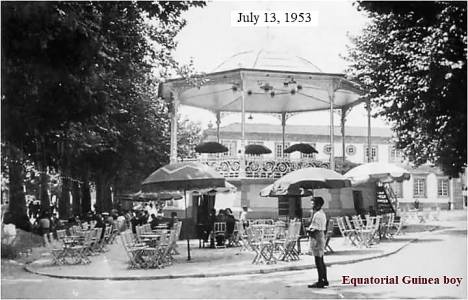
| 6. | Town Hall will check the weights and balances used by shopkeepers from tomorrow until the 12th. |
| 7. | Cruiser "Canarias" returned at 8:15 AM from a voyage to Equatorial Guinea. |
| 11. | Fox donated to the municipal park. Note: Years later I saw the animal horribly mistreated. Park employees (presumably) caged the fox in a cement wall niche, the poor animal had just enough room to stand on its hind legs and attempt to leap over a metal fence indefinitely (End of Note). |
| 13. | Galician chess champion José Alonso Leira returns from a "brilliant" performance in Switzerland and Italy. Of four games he played, he won two and drew two. |
| 14. | Compulsory smallpox vaccination for all children between six months and seven years old. Note: I got the needle again (End of Note). |
| 21. | Around 6:00 PM a 28-year-old woman (Josefina Regueira Romero) stabbed a 57-year-old man to death at Plaza de España. He was an artillery corporal (Arturo López Rodríguez). See also May 12, 1955. |
| 23. | An 8-year-old boy failed to clear one of the many bonfires lit on St. John's Eve. Lightly charred. |
| 29. | Two peacocks destined for the municipal park. |
| 1. | Tribute to José Alonso Leira, chess champion of Galicia for ten consecutive years. |
| 6. | 16-year-old boy seriously injured trying to board a moving tram. |
| 7. | Local police releases the statistical briefing for the first semester: 690 traffic offences, 75 fines for letting a dog outdoors without a muzzle, 465 reports of milk adulteration by milkmaids or of unclean milk containers, 97 reports of garbage dumping on the street at night, 198 fines for singing or for raucous behaviour at night. |
| 11. | Regatta trial from La Cabana to Ferrol, a distance of 1,600 meters. |
| 16. | A man punches a female renter and throws her furniture onto the street. Arrested. |
| 20. | Fortuitous find of "a pearl of excellent quality" in a clam. The pearl measured 5 millimeters diameter. |
| 23. |
Two physical assaults: on a 36-year-old bricklayer and on a 30-year-old widow. Official summer recess in Empresa Nacional Bazán start tomorrow Saturday and run until Sunday August 8. |
| 26. | Official visit by the Portuguese Defence Minister. He came accompanied by the Spanish Minister for the Army. "Plaza de España crowded." A regular infantry company formed the guard of honour. He toured the city's military base, was toasted at Town Hall, had lunch at Navy Command Headquarters with music provided by the naval infantry brass band, toured the naval base of A Graña across the bay and went to the municipal park where the chorale Toxos E Froles gave a recital in his honour. He left "deeply touched" by the reception. |
| 27. |
Official visit by twenty-five members of Mocidade Portuguesa. Town Hall urges everyone to use water sparingly. |
| 30. | More regattas in the bay. |
| 31. |
Blessing of a drugstore and of a ballroom next door. Snipe class regatta qualification round for the upcoming international competition in Lisbon. |
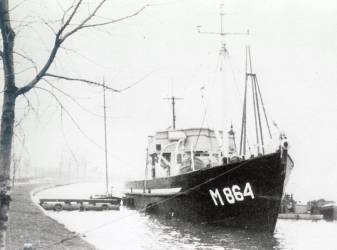
| 2. | "A very numerous public" watched an afternoon aeromodelling show in the Town Hall square organized by the Youth Front. "Hierarchies and authorities" were also present. |
| 10. |
13-year-old girl was run over by a car. 61-year-old man bitten by a dog. |
| 13. | Local policeman bitten by a dog. |
| 15. | Three men were involved in a street brawl. Their ages: 42, 28 and 45. |
| 22. | Power shutdown scheduled from 9:00 to 11:00 AM to carry out repairs in the grid. |
| 24. | Summertime charity raffle stand in the downtown gardens was inaugurated and blessed this evening by the bishop of Palencia. |
| 28. |
Fiestas de Ferrol commence. One-year-old baby girl bitten by a dog. Motorcycle collided with a truck. |
| 31. |
Royal Netherlands Navy minesweeper Putten (above) put into Ferrol to disembark a sick sailor, his name was Joan Jemssen, he was suffering from appendicitis and got operated on at the Navy Hospital. Newspaper congratulates María Rosa Frade Martínez for having obtained a university scholarship, she is the daughter of a shipyard employee. 318 homes will be built by the state workers union. Prize winning numbers at the summertime charity raffle stand: #15094 wins a complete bedroom set, #5993 wins a motoscooter, #1109 wins a gold watch, #5798 wins a washing machine, #22013 wins a sewing machine and #12960 wins a radio. |
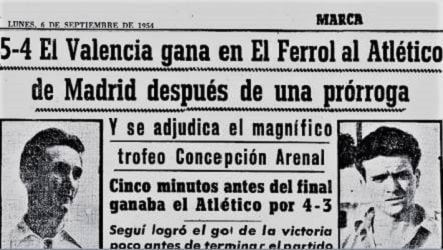
| 1. |
Skeet competition. First prize: 25,000 Pesetas. Consolation prize: 5,000 Pesetas. Bus and tram collision. No one hurt. |
| 3. |
6-year-old girl falls from a fig tree. Twenty sailboats took part in the second qualification round of snipe class regattas. |
| 4. |
Basketball game at 7:00 PM. Two bicycles stolen. Four boxing matches at the municipal stadium. |
| 5. | Second Golden Trophy Concepción Arenal disputed between soccer clubs Atlético de Madrid and Valencia in the municipal stadium at 4:30 PM. Rainy afternoon. Stadium half full. Final score (above): Valencia 5, Atlético de Madrid 4. |
| 6. | Four destroyers left port. |
| 7. |
Another local policeman bitten by a dog (see August 13). Raincoat stolen. |
| 12. | Steamboat "Archancha" arrived with a cargo of timber from Equatorial Guinea. |
| 15. | The following warships departed: two cruisers, four destroyers, a minelayer, a minesweeper and a torpedo boat. |
| 19. |
Division of the Dominican Navy arrives to Ferrol. The visiting military brass band gave a concert in the downtown gardens at 7:30 PM. The following clip of the visit copts the newsreel's intro for show. The actual newsreel, ten minutes long, was first shown on Monday October 4, 1954.
Voice-Over Translated: A naval division of the Dominican Republic composed of the destroyer Trujillo, the frigate Presidente Troncoso and the corvette Colón arrives to El Ferrol del Caudillo. The visiting marines transfer to the monument to Churruca. Rear Admiral Romero Lajara heads this division. These servicemen refresh the fond remembrance that Spain always harbors for the Dominican Republic, and they deposit a memorial wreath at the foot of the cited monument. Afterward they head amid displays of affection from the Ferrolian population to the Monument To The Fallen [a huge granite cross at Plaza de Amboage dedicated to the fallen soldiers of the fascist side of the Spanish Civil War] where they place another memorial wreath. Admiral Regalado the Captain-General of the Maritime Department and other authorities accompany the Dominican rear admiral and the rest of his officers. Santo Domingo [the capital city of the Dominican Republic] raised its voice in defense of our homeland in days when we were sentenced to an unjust isolation. The word of Generalissimo Trujillo has never discontinued the task of explaining to the world the important role that Spain plays in the defense of the West's Christian civilization. The marines march in showy parade through the streets of the city, occasioning the renewal of clear displays of favor and kinship before them. |
| 21. | The chorale Toxos E Froles gave a farewell performance for the Dominican Navy on the departure wharf at 7:00 PM. |
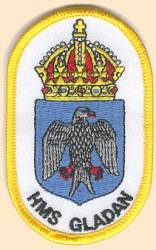
| 5. | 23-year-old carpenter was run over by a horse-drawn cart. |
| 12. | Motorcycle meet in Plaza de España at 1:00 PM. "Several thousand spectators." |
| 13. | Editorial denounces rampant "militant hooliganism." Many public lighting bulbs are smashed with slingshots. "There is no regard shown for anything that is a token of civic values or civilization...they muddy up a statue or the facade of a new building...they brag about being drunk singing bawdy songs." |
| 15. | Bazan team travels to Cádiz to take part in the national swimming competition. |
| 16. | Rotating blackouts scheduled from 8:00 AM to 6:00 PM in all neighbourhoods. Store showcase windows may use only one light bulb with a maximum power of 100 W. |
| 26. |
Editorial insists that secondary roads must be improved. Rough seas delay the arrival of HMS Gladan and HMS Falken. |
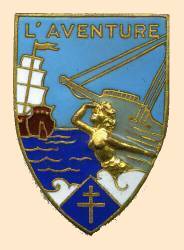
| 4. | Rough seas delay the arrival of French frigate L'Aventure until the 13th. |
| 16. | The frigate is being visited by "many" Ferrolians. French consul M. Chaulet has invited the crew and local officials to a joint luncheon. |
| 17. |
L'Aventure departed at 8:30 AM. Three helicopters flew over Ferrol yesterday causing a bit of a stir. |
| 18. |
Public campaign underway to purchase a washing machine for the Destitute Seniors Retirement Home. Gender-rated pay scale prescribed by the Ministry of Labour for the cleaning staff of the tram company. Men: 9.90 Pesetas/hour. Women: 1.65 Pesetas/hour. |
| 20. | Funeral Mass in San Julián Church for the founder of Falange Española. Declared day of national mourning. |
| 27. | Catfight in Plaza de España between milkmaids. |
| 29. | Two Bazan workers died and one was seriously injured around 6:30 PM when two cranes collided, derailed and fell on top of a group of workers sheltering from a heavy thundershower. "The news caused deep consternation throughout the city." Ferry boats out on the bay during the storm had great difficulty staying afloat. "The sea displayed a horrific aspect and the number of lightning bolts that struck the surrounding areas was enormous." As a result of the storm two fishermen drowned in the bay, their corpses washed ashore on December 9. |
| 30. | The two workers killed yesterday were buried at 12:00 noon. "A crowd of workmates and friends" made up the cortege. |
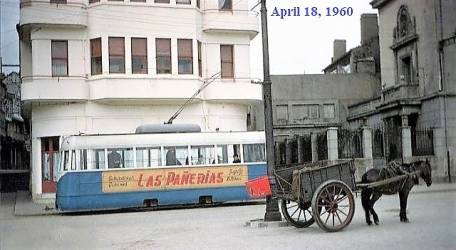
| 1. |
Bus skidded on wet pavement and overturned, three passengers hurt. 78-year-old woman hurt trying to board the tram. 15-year-old construction worker (general helper) hurts himself in fall from scaffolding. |
| 2. | Town Hall hires Empresa Nacional Bazán to improve the water supply network. |
| 4. | Town Hall decrees mandatory veterinary inspections before the private slaughter of domestic pigs. |
| 8. |
Street procession of the Immaculate Conception at 4:00 PM. The image will be carried by pupils and former pupils of Daughters of Christ the King School. Firefighters draft a large pool of stagnant rainwater near the municipal stadium. |
| 17. |
All sellers of charcoal and firewood are required to carry a state union membership card. Butcher arrested for selling meat in poor condition. 7-year-old boy was run over by a taxi. |
| 19. | Charity soccer match at 4:00 PM pits "Lawyers and Newspapermen" versus Navy Sailors. Ticket prices as follows. Covered seating stand: 10 Pesetas. Others: 5 Pesetas. Children and military personnel: 2 Pesetas. |
| 22. |
Daily affluence of "a very numerous public" to the nativity scenes in two churches. The artistry on display is commended highly. Four 1,000-Peseta scholarships are on offer to study at the high school. Reward is offered to hunters who kill the following "pests": fox, European wildcat, marten, ferret, common genet and red kite. |
| 28. |
Archbishop of Coimbra in Northern Portugal arrived for a visit. Basketball, table tennis and chess tournaments are on during the holiday break. |
| 29. | Paving work has started in Plaza de España. |
| 30. | Ferrol's firefighters went to help put out a big blaze fifty-five kilometers away in the city of A Coruña. |
| 31. | 18-year-old teenager was assaulted with a pocket knife. |
The source for the information contained in this chapter is the partial archive of the newspaper La Voz de Galicia found in the local library. Some of the information garnered has been included elsewhere. I have focused mostly on a half-page section entitled, Ferrol Al Dia (Ferrol Update). The archive does not have Monday newspapers, presumably the presses did not run that day.
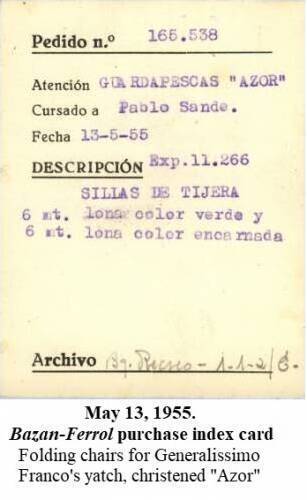
The newspapers contained a little information about the previous year 1954.
The electrical energy consumption for the whole of Spain rose by a meager 500 Kwh "due to drought." The severe housing shortage persisted with "few dwellings available and very expensive rents." The solutions most often employed were "subletting and the living together of a newly married couple with one set of parents."
Bazan-Ferrol was not above running some errands for the bigwigs.
The photograph on the right shows an index card from May 13, 1955, which recorded the purchase of (presumably twelve) folding chairs plus six meters of green-coloured canvas and six meters of red-coloured canvas.
These items were destined for the deck of the coast guard vessel named "Azor" which doubled as a yatch for General Franco during his summer vacations. This video from the year 1963 shows him and the crew aboard Azor hunting sperm whales off the Basque coast. Warning: Animal lovers may find the images disturbing (End of Warning).
When I was a child there was a satirical magazine called "La Codorniz" (The Hen). One day the report/scandal spread about Ferrol that the magazine had dared to publish an official photograph of General Franco standing proud beside a large fish he had caught, and beneath it the deliberately ambiguous caption, "El Cachalote de Franco Pesa 600 Kilos," which could be interpreted as "Franco's Whale Weighs Six Hundred Kilograms" or, on a malicious bent, "Franco The Whale Weighs Six Hundred Kilograms." The choice was left up to the reader.
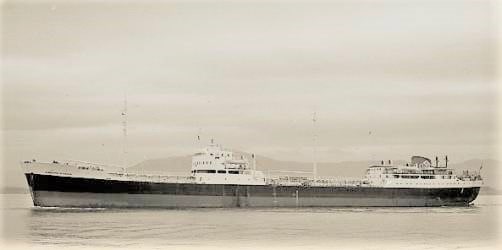
| 5. | All 20-year-old Spaniards must solicit inscription in the recruitment lists of the Navy. Failure to comply will bring fines of up to 1,000 Pesetas. The age for full military discharge is forty-five years. |
| 6. |
An anonymous individual wins half a million Pesetas with a 14/14 sports lottery. Traditional harbour swimming contest at 1:00 PM. Distance: 300 meters. Prizes donated by P.Y.S.B.E. and by the Port Public Works Authority among others. |
| 8. | Oil tanker "Almirante Manuel Vierna" (above) left port on its maiden voyage (it had been launched on May 31, 1954). |
| 12. | Town Hall will verify compliance with a 1954 law requiring school attendance for all children six to twelve years old. |
| 20. | Two Italian and two Dutch vessels seek refuge in the harbour from the stormy weather. |
| 23. |
A share of the Spanish lottery jackpot lands in Ferrol, worth 600,000 Pesetas. Everyone is asked to donate money to the premier soccer club of the city, Ferrol. Generous public response, more than 20,000 Pesetas was collected by the first of February. |
| 28. | The families of the two fishermen drowned in the bay on November 29 are handed a subsidy of 3,000 Pesetas each. |
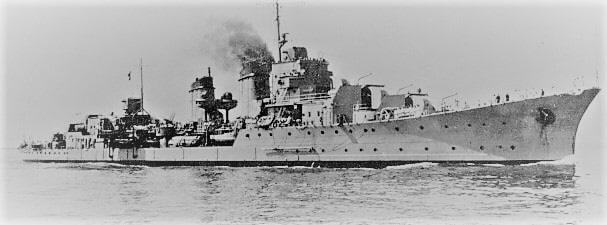
| 3. | Two cruisers, two destroyers and a torpedo boat left port at 10:20 AM. Two to three miles offshore a steam pipe ruptured in the cruiser "Méndez Núñez" and the subsequent explosion killed three sailors and injured two boiler officers, one of whom died ashore. The incident was not given coverage on the state newsreel. |
| 4. | A cortege of thousands accompanied the burial of the four navymen killed yesterday. |
| 6. |
The condition of the surviving boiler officer improves. The same flotilla of the 3rd less the damaged cruiser sailed away in the afternoon. |
| 8. | Costa Rican oil tanker "Darnel" entered port after suffering the explosion of a boiler, 4 crew dead. |
| 18. |
Donations are still needed to purchase a washing machine for the Destitute Seniors Home (drive started November 18, 1954). The collection for Ferrol soccer club surpasses 30,000 Pesetas (drive started January 23). Oil tanker "Darnel" left port in the morning. |
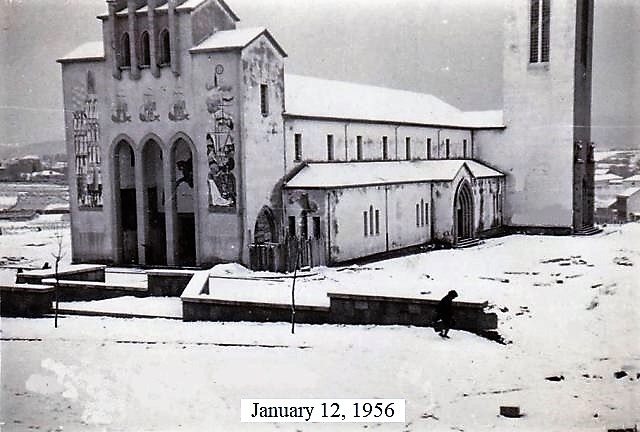
| 8. | Snow falls in the city. Minimum temperature recorded: -2°C. |
| 9. | Town Hall decrees that chimneys must be swept clean or the landlord will be fined. |
| 10. | "Coldest day of the winter thus far." Snowflurries. Temperatures hovered around the freezing point all day long and the surrounding hills are covered with snow. "This is the coldest winter in recent memory." |
| 13. | Solemn Te Deum at 12:30 PM in San Julián Church to commemorate the Day of the Pope and the sixteenth year of his tenure. |
| 20. | Civil Government bans public dancing from March 27 to April 8. |
| 23. | Paving work on Plaza de España has finished (begun on December 29, 1954). |
| 24. |
Launch of oil tanker "Puertollano" at 3:45 PM. The following record of the event co-opts the newsreel's intro for show. The actual newsreel, ten minutes long, was first shown on Monday April 4, 1955.
Voice-Over Translated: In the Ferrolian shipyards of Empresa Nacional Bazán the oil tanker with the largest displacement ever built in Spain is ready to be launched. It is owned by the national enterprise Elcano, and of these a series of eight is planned which will be completed in the year 1957. The boat displaces 26,500 tonnes, but others displacing 32,000 tonnes will be built shortly. Mr. Planell the Minister of Industry comes to preside over the launching ceremony. Comes the turn of the solemn blessing of the vessel. Mr. Planell's wife is the ship's godmother. Puertollano's mayor is also in attendance, placename borne by the oil tanker. The vessel slides backwards to the water. These boats will permit a substantial savings in foreign currency, for presently it is necessary to pay many freights to foreign boats. The national enterprise Elcano fulfills thus one of the fundamental missions of its constitution, to equip Spain with efficient boats like the "Puertollano," the biggest one built in our nation. |
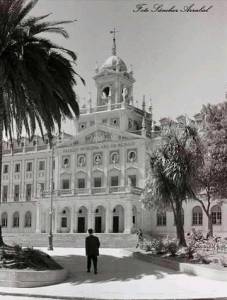
| 3. | Palm Sunday. Via Crucis with the Stations of the Cross distributed around Plaza de Armas. |
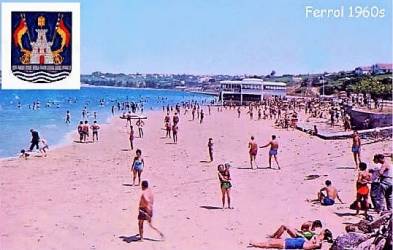
| 1. | In women's basketball Bazan defeated Herculinas 41 to 4. Bazan was "much superior...brilliant undefeated champion." |
| 3. |
The new municipal library opens to a full house. Located on the second floor of Town Hall, right wing, it has 100 seating spaces. Reading hours are 5:00-9:00 PM. Rotating blackouts are scheduled from 8:00 AM to 12:00 noon. |
| 6. |
Work on the artificial beach (above) has begun. Editorial urges continuation. Final phase of the refurbishing work on the Batallones soccer field (begun on March 17, 1954). Editorial recommends letting the grass grow undisturbed one year. |
| 12. | Closing arguments stage in the trial of Josefina Regueira Romero at the Palace of Justice in A Coruña over the stabbing incident of June 21, 1954. It was proven that the 28-year-old (married) woman had been sexually harassed by Arturo López Rodríguez. She complained to the man's superiors but they did nothing. The corporal then proceeded to slander her publicly, even in front of her husband. At this point the woman pulled out a kitchen knife and stabbed the corporal six times. An army captain witnessed the incident and intervened, whereupon she lost consciousness. The prosecutor asks for a 21-year jail term. The defence asks for a discharge or a minimum sentence. "A very numerous public" followed the proceedings. "Many in the public gallery had come from Ferrol." |
| 14. | Josefina Regueira Romero is sentenced to nine years in prison and the payment of 75,000 Pesetas to the heirs of Arturo López Rodríguez. |
| 22. |
About a hundred children put on a musical show at the municipal park under the direction of Manuel Pérez de Arévalo (see month of November) and two others.
|
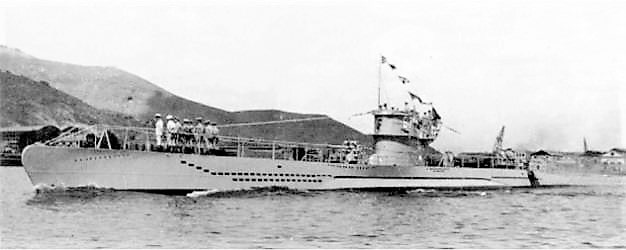
| 27. | "Brilliant athletic exhibition" by Bazan apprentices at the stadium to mark the end of courses. A track and field competition was followed by a gymnastics show performed by "hundreds of apprentices perfectly arrayed." Afterward the athletes paraded downtown preceded by a bugle-and-drum band. |
| 28. | Five submarines arrived at the base: D-2, D-3, G-7 (above) General Mola and General Sanjurjo. |
| 30. | Navy Soccer Tournament final at 6:30 PM. Thousands were expected to watch. The match finished scoreless. |
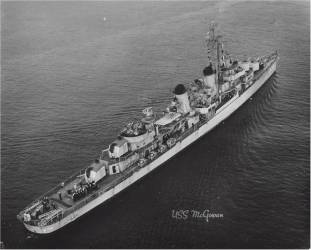
| 7. |
Whale meat is back on sale, at 12 Pesetas/kilogram. Arrival of USS Lewis Hancock and USS McGowan (above). The U.S. Marines strolled through the city. The warships offered guided tours to Ferrolians between 1:00 and 5:00 PM on the 10th. |
| 9. | The local group of Sección Femenina will represent Spain alongside another group in a folklore meet held in Nice and Pescara (Italy). Many countries will participate: Yugoslavia, Germany, Italy, France, Great Britain, from Africa, etc. |
| 13. |
U.S. Marines beat Bazan 43-39 in a friendly basketball game. The official summer holidays of Empresa Nacional Bazán will extend from 12:45 PM on Friday July 15 to Sunday July 31 (cf. July 23, 1954). |
| 19. | There will be more hours of nighttime lighting in the downtown gardens. |
| 22. |
Arrival of French corvette "Le Boulonnais" in the early morning. There was an official reception and the French sailors toured the shipyard. Crippled Liberian vessel "Rolla" was towed into harbour around 11:00 AM. |
| 23. |
Debut of travelling circus "Las Américas." Heavy thunderstorm in the afternoon with hailstones the size of "matchboxes" or "sugar cubes." |
| 24. |
Public tours of Le Boulonnais are on between 2:00 and 5:00 PM. Heavy afternoon thunderstorm with hail. |
| 26. | Le Boulonnais sailed away at 8:00 AM approximately. |
| 27. | Heavy thunderstorms continue. Today the hailstones were the size of "walnuts, billiard balls and tennis balls." An eyewitness reported seeing "several birds brought down by the hail." |
| 31. | The Group of Choirs and Dances of Sección Femenina returned tonight from the international meet having earned second prize. The Ferrolian group received a standing ovation in Nice and was offered several work contracts. The troupe also did tourism in Montpellier, Monte Carlo, Monaco and Cannes. A member of the party gambled in Montecarlo and won 5,000 French francs. The girls readily admitted that Yugoslavia had won first prize deservedly. |
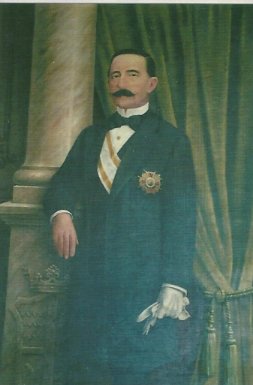
| 3. | Summertime charity raffle stand in the downtown gardens was inaugurated by the admiral with other officials present and was blessed by the parish priest (cf. August 24, 1954). |
| 12. |
Snipe class regattas in the bay. Distribution of U.S.A. Food Aid packages of milk and butter to needy families. |
| 13. | The Group of Choirs and Dances of Sección Femenina heads to Portugal. |
| 17. | Editorial remonstrates that the railway station is antiquated and that a new one is needed urgently. |
| 20. |
Resounding success of the Group of Choirs and Dances in Portugal. Men's and women's friendly basketball matches at the municipal park between Bazan and University of Heidelberg. |
| 23. | Debut of the puppet show of Maese Villarejo at 6:00 and 11:00 PM in the municipal park. |
| 26. | Forest fires in the vicinity of Ferrol burn an estimated 50,000 trees. |
| 30. |
Article praises Bazan pivot Manuel Pardo Abad. Pardo "stands out for his long stride and scoring ability." He was twice selected to play for the national team. His passion for the sport coincided with the arrival of Rutgis [sic] to Ferrol. "Last January he was picked to play in the Spanish five against a U.S. Air Force team based in England. The Spanish side won two of the three games played." In Pardo's opinion Bazan ranks fourth or fifth in Spain. Artificial lighting test for Manuel Rivera Stadium has failed. There is not enough power available and the project has been dropped. |
| 31. |
Requiem Mass for the Marquis of Amboage (above) in San Julián Church at 11:00 AM. This Mass marks the end of Fiestas de Ferrol. Field hockey match at 8:00 PM pitted two teams of Bazan apprentices. Final score: Blue Shirts 6, Red Shirts 5. Friendly basketball game between Bazan and the Portuguese champion Vasco de Gama at 9:00 PM. Persistent rain. Final score: Bazan 41, Vasco de Gama 27. Pardo turned down offers from basketball teams in Madrid and in Barcelona, opting to stick with Bazan. |
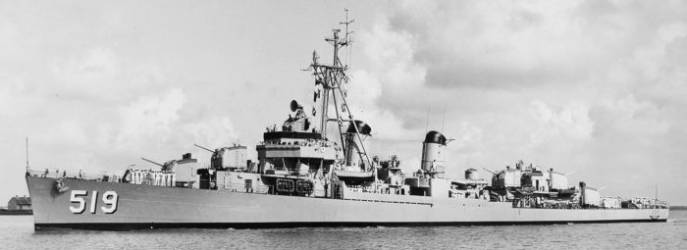
| 7. | Yesterday American documentaries were shown in Capitol movie house at 4:00 PM courtesy of the "Propaganda Service of the U.S. Embassy in Madrid." Full house. The public left "pleased." There will be a repeat showing today at 4:00 PM. |
| 10. |
17-year-old son burns down parents' house. Electricity comes to the last hamlets of the municipality. Collection tables for the yearly levy in benefit of the fascist Youth Front will be set up outside the stadium. By a law signed in 1940 everyone needs to show the emblem purchased with the levy to attend any public spectacle including soccer games. |
| 17. | Two Bazan workers were killed about 11:00 AM when they were struck by "the braking lever of an overhead cable." |
| 21. | About 7:00 PM the Bazan bus careened off the road. "The vehicle ended in the brambles, leaning on two wheels." Ropes and chains were used to lift the vehicle upright. No one was hurt in the accident. |
| 23. | Ten scholarships were awarded to low-income students by the high school. |
| 26. | American destroyers USS Daly (above) and USS Smalley arrived at 10:00 AM. |
| 29. | A 30-year-old electrician died from injuries sustained in a workplace accident on the morning of the 28th. |
| 5. | Tomorrow Thursday all high school students must attend the ceremonies marking the start of the 1955-56 school year. There will be a "Mass of the Holy Spirit" in Santa Lucía Church at 10:30 AM. Note: I never heard of this church (End of Note). At 12:00 noon a solemn academic function will be held with the presentation of awards to last year's outstanding students. Classes start on Friday the 7th. |
| 8. |
Doctor of Philosophy and Literature Miguel González Garcés (above) will give a public lecture at 8:00 PM. The title of the colloquium is "Musings about the poetry of our time." Bazan wins a third basketball trophy in Lugo. Large crowd. |
| 9. | Police arrest a 37-year-old man charged with murdering his 41-year-old wife in Montevideo (Uruguay). He had returned to Spain aboard the Highland Chieftain. |
| 15. |
Arrival of an Egyptian military mission this morning. Encomium of the movie Carosello Napoletano |
| 6. | Lightning struck a house about 4:30 AM, entered through a broken window, fried the electrical wiring and destroyed the washroom. The family of five living inside was unhurt. |
| 11. | Artillery captain, ballistics expert, chemist, composer and poet Manuel Pérez de Arévalo (above left) will give a recital at 8:00 PM in Teatro Jofre. The proceedings will go to the processional brotherhoods of Holy Week. Note: De Arévalo also taught Mathematics. I did not get to study under him but he enrolled me in the choir of the high school a few months before my departure; he was an enthusiastic, self-confident man, knowledgeable and with a benevolent streak uncommon in the military (End of Note). |
| 15. |
"Extraordinary event": Polish violinist Ida Haendel (above right) will perform tonight at Teatro Jofre. She had turned down all previous offers to come to Ferrol. She will be accompanied at the piano by Carmen Díez Martín. Town Hall renames its square "Plaza del Almirante Francisco Moreno marqués de Alborán." Note: The new name did not stick (End of Note). |
| 20. | Nineteenth anniversary of the death of José Antonio Primo de Rivera the founder of fascist Falange Española. A funeral Mass was held in San Julián Church yesterday Saturday with the following dignitaries in attendance: the captain general of the maritime department, the military governor-general of the city, the mayor, the rear admiral of the fleet, the rear admiral of the naval base, commanders and officers of the army and navy, members of Falange and "a very numerous public." There followed the Mass a wreath-laying ceremony at the foot of the Cross of the Fallen affixed to an exterior wall of the church. Top officials laid laurel wreaths on behalf of Navy Command Headquarters, the military government of the city, Town Hall, Falange and affiliate organizations, the First Division of the Fleet, the munitions workshop and depot and on behalf of Empresa Nacional Bazán. A regular infantry band played the traditional German Army lament, Ich Hatt' Einen Kameraden. This was followed by a recital of the Oración Por los Caídos (Prayer For the Fallen) and the singing of the Falangist anthem, Cara Al Sol (With the Sun On My Face). In the evening San Julián Church hosted a Rosary prayer service on behalf of Primo de Rivera. |
| 21. |
Street procession of the "Little Princess" religious icon from the chapel of Daughters of Mary School. Note: Mom studied at this school (End of Note). The video shows the "Little Princess" on min. 12:28-32 and what a procession looked like on min. 12:28-13:20. "The procession went along the main streets, hundreds of women took part." The highly praised art exhibit of Carlos Villaamil Pérez continues on the second floor of Town Hall from 7:30 to 10:00 PM. |
| 28. |
Literary chat entitled "The Imaginary Countries" by Álvaro Cunqueiro in the casino at 8:00 PM. The act was presided by the military governor and by the chief of staff of the maritime department. "A numerous and select audience filled the lounge." At the conclusion of his delivery the speaker received "enthusiastic" applause. An editorial five days later described the event thus,
Álvaro Cunqueiro, poet, writer, newspaperman, wanderer fond of all the byways of History, Galician even in the manner of looking, rich in imagination and in humanity, has known how to inject into the mind of all his listeners the inimitable magic of a hundred ravishing lies, skipping from the golden lands of the France of the Popes of Avignon to the misty ones of Ireland and Normandy; from the fabled shores of America in the sixteenth and seventeenth centuries to the serene age of ancient heroes who live out in the Odyssey and in the tales of the Orient an endless, existential dream. |
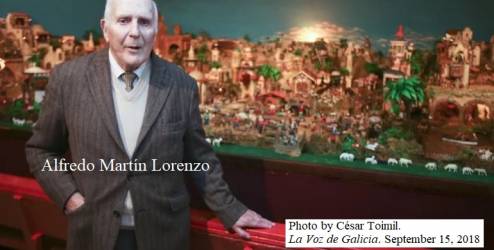
| 3. | Eight local basketball teams square off in the gymnasium today at 6:00 and 7:00 PM and tomorrow Sunday at 11:00 AM and 12:00 noon. |
| 8. |
Artist Carlos Villaamil Pérez sold 20 paintings during his recent exhibit (November 21). Official prices for bread set by the Comisaría de Abastecimientos y Transportes (Commissariat of Provisions and Transportation) are: 1 kg loaf, 5.20 Pesetas ♣ ½ kg loaf, 2.75 Pesetas (cf. April 25, 1954). Note: The 100 gram loaf was not listed (End of Note). |
| 11. | 49-year-old female beggar suffered a heart attack at the Central Market. |
| 17. |
Oil tanker "Puertollano" has successfully completed its sea trials. Charity soccer match pits "Lawyers and Newspapermen" versus Navy Sailors. Proceedings went to soup kitchens. Gross: 7,608 Pesetas (cf. December 19, 1954). |
| 18. | Following tradition the chorale Toxos E Froles gave performances in the Destitute Seniors Home, the Hospital of Charity, the municipal school for orphans and the Anti-Tuberculosis Sanatorium. |
| 20. | The nativity scene of the Venerable Orden Tercera de San Francisco opens to the public. Rills of real water, light display, "many figurines of extraordinary perfection." Free admission. Visiting hours are 5:00-7:00 and 8:00-9:00 PM (cf. December 22, 1954). Note: Alfredo Martín Lorenzo (1929-2018) created the first nativity scene of the Venerable Orden Tercera de San Francisco in the year 1945 (End of Note). |
| 23. |
Special Christmas Eve dinners will be served in the Soup Kitchen Restaurant and at the orphans school. Local officials will host them. Charity Music Festival organized by the shipyard enjoyed "extraordinary success." All the participants received a lengthy ovation. Proceeds will go to needy workers. |
| 28. |
Special three-course meals were served to patients in the Hospital of Charity and to patrons of the Night Shelter over the weekend.
|
| 29. | Rival shipyard Astano launched the coaster "Lalasia" of 2,200 tons this afternoon. Launch seventy-eight will take place tomorrow. |
| 31. | Visiting hours to the nativity scene of the Venerable Orden Tercera de San Francisco are extended by popular demand "so that no Ferrolian child will be left without taking his letter to the Three Wise Men." |
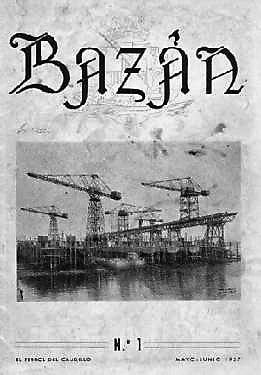
The source for the news in this chapter is the Ferrolian Atheneum's digital collection of Bazan the shipyard's magazine. This collection may be viewed in the gargantuan "Internet Archive," a public-access digital library of webpages, books, texts, audio recordings, videos, images and software programs.
The user should type "https://archive.org/details/revista-bazan/195705-06_num.01/" to access the Atheneum's collection. S/he will then find on the left-hand side of the opened webpage a list of all Bazan magazine numbers plus a column of six icons, download icon included. The first download moves the particular Bazan magazine file from the Archive's storage disks to the Archive's webpage viewer. A second optional download transfers the same file from the Archive's webpage viewer to the user's own computer. S/he can choose between a PDF version (recommended) or an ePub version.

The first number of Bazan mainly reports on the highlights of the previous year 1956.
| 5. |
According to p. 11 of the first number of Bazan, September 5, 1956, was the most indelible date of that year,
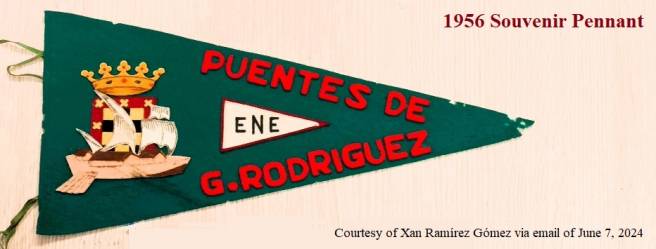
Sacrificing chronological order we shall begin by referring to the memorable day lived in the Factory on September 5 with the ceremonies surrounding the launch of the fast frigate "Oquendo," the delivery to the "Elcano" transport company of the recently built oil tanker "Puentes de García Rodríguez" (19,000 deadweight tonnage), and the laying the keel of a new tanker (construction project #108) similar to the aforementioned and destined for the "Naviera Vizcaína" shipping company.The following film of those events co-opts the newsreel's intro for show. The full newsreel, ten minutes long, was first shown on Monday September 17, 1956. Voice-Over Translated: El Ferrol del Caudillo entertains the visit of His Excellency the Head of State to his native city with keen displays of sympathy. The Generalissimo visits the modern shipyard and workshops of the Northwest installed in Perlío. Note: This was rival shipyard Astano located five kilometers away by road (End of Note). Franco receives during his walk the workers' show of allegiance. Franco tours the factory accompanied by ministers, other authorities, the president of the Board of Administration and the director of the factory and surveys the technological advancements plus the codders scheduled for launch soon. Next the Generalissimo goes aboard the oil tanker "Puentes de García Rodriguez," which then sails around the Ferrolian bay. This vessel has also been built at the shipyard. Note: This however was Bazan shipyard! the script writer got into a muddle (End of Note). The oil tanker displaces more than 26,000 tonnes, has a carrying capacity of 19,000 tonnes, a length overall of 171 meters, a beam of 22 meters and an upper works of 12 meters. After a tour of the bay the ceremony of the tanker's official commissioning took place. Franco disembarks and heads to the (Bazan) shipyard to attend the launch of the frigate "Oquendo". The ship is blessed by Cardinal Archbishop of Compostela Dr. Quiroga Palacios. Mrs. Carmen Polo de Franco acts as the godmother. The ship glides down the slipway. It has a displacement of 2,135 tonnes, a loaded displacement of 2,893 tonnes and a speed of 38 knots. The Ferrolian people gather in Marqués de Alborán Square. Note: See the news entry for November 15, 1955 (End of Note). Meanwhile the municipal government tributes an official reception to the Generalissimo inside Town Hall who, pressed by the public acclamations outdoors, must go out to the building's balcony and acknowledge the demonstrations of affection and sympathy which the crowd salutes the presence of His Excellency in the city with. |
Work performed at the Factory during 1956 included normal maintenance and repair work on several cruisers, destroyers, codders, the French freighter "Panvenan" (sic) and the Portuguese transatlantic "Santa María," This last one was in for a propeller refit.
There were "numerous" visits of national and foreign names. John Davis Lodge the American Ambassador and Sir Hilary Worthington Biggs the British Vice Admiral stand out in the foreigners' tally. The American diplomat came accompanied by his wife, daughter and embassy staff. The British commander arrived with several senior officers of the H.M.S. Theseus light aircraft carrier.
There were also "numerous" visits of engineers and technicians from national and foreign enterprises, among them the French "Société Rateau," "Ateliers and chantiers de Bretagne," the Italian "Gio. Ansaldo & C." and the U.S. Navy Shipbuilding Liaison Office.
On December 31, 1956, the traditional year-end reception for a large delegation of workers and employees was held in the Library Room of the Board of Directors. Julio Murúa Quiroga the director of the Factory addressed the gathering. He summed up the work done in 1956, forecast an auspicious 1957, had a kind word for the personnel on sick leave and a special remembrance for those who had died. He enjoined everyone to keep working in 1957 with the same enthusiasm and he entreated foremen to update their skills to raise productivity and to be a source of inspiration to their subordinates. His speech closed to hearty applause and everyone was served a glass of Spanish wine.
Statistics for the year 1956. 174 weddings of workers or employees. 473 births. 49 workers and 5 employees retired. 24 deaths.
The magazine's Sports Section dwells on the huge following that the sport of basketball generated in the city of Ferrol thanks to the impressive success of Bazan's basketball team in national competitions. The magazine gives full credit for Bazan's recent accomplishments to the training and technical skill of former coach Michael Ruzgis.
Few sports have generated such an atmosphere of expectancy in a city as the one generated by the Bazan basketball team in the space of a few months.
From its formation in 1950-51 the Bazan basketball team drew to the seats of its court crowds that always followed the team's victorious campaigns with enthusiasm. So much so that it became necessary to condition the shipyard's gym, where the court is now, because the primitive court was too small.
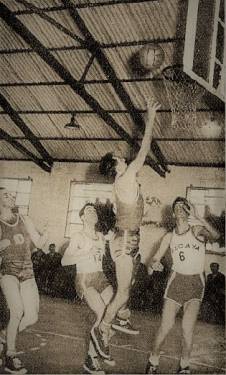
And this expectancy and this enthusiasm spawned many teams in our city and caused basketball to become Ferrol's most popular sport. And all the basketball matches, provincial-league or bantam or junior or women's, etc., are played in front of a full house that follows the various incidents of the match with keen interest.
"Bazan" has the category of a first national division team and it is the "perpetual" provincial and Galician champion. It continues without a doubt to be at the forefront of Ferrolian basketball. But the shipyard is not satisfied with sponsoring this team alone. It promotes the sport of basketball throughout the workforce, and so today it boasts women's and men's teams that play in the Educación y Descanso League, both were provincial champions this year, plus bantam and junior teams whose roster is made up of apprentices. Thus we would fall short of the mark if we said that only a hundred workers played in its basketball teams.
[...]
The work of a man who transformed this sport with his technique deserves a mention apart. That man was the coach. Mike Ruzgist (sic). He gave to Ferrolian basketball, represented by "Bazan," a new technique, a new style of play that subsequently influenced the other teams and which raised "Bazan" to the level of rubbing elbows with the best teams in the country.
We believe that the stint of Ruzgist in Ferrol was highly beneficial for the game of basketball and that his training will serve as a stimulus—now he has departed—to overtop the results achieved under his orders.
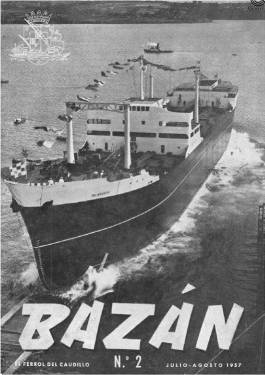
The source for the news in this chapter has already been discussed in the chapter entitled, "Bazan Magazine for the Year 1956."

The highlight of the year 1957 in the Factory was the launch on July 12 of the oil tanker, "Valmaseda".
The launch was more or less on schedule despite the shipyard's persistent difficulties in the procurement of sheet steel.
All the workshops dedicated to the manufacture of assembly components and of subassemblies worked without a break.
A very intensive use was made of welding in the prefabrication of great blocks and vast panels which the cranes charily maneuvered onto the vessel's bare hull successively.
Most welding was performed manually, but where conditions allowed, "union-melt welding" (photograph below) was done in the modern and very fast installations of the dockyard, and these expedited the labour considerably.
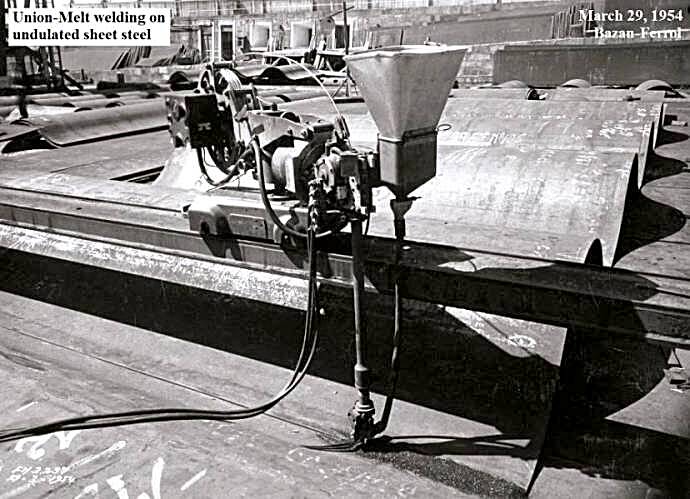
The "Valmaseda" made number 108 in the list of ships built at Bazan-Ferrol. This tanker was the third of a certain Series "T" whose first and second members, "Puertollano" and "Puentes de García Rodríguez" respectively, were built here as well. The three adhered to the standards of Lloyd's Register of Shipping.

The oil tanker was delivered to the "Naviera Vizcaína" shipping company on December 17, 1957.
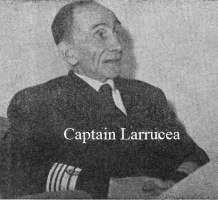
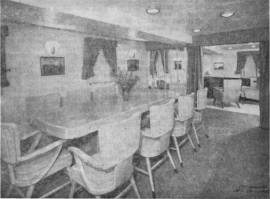
Bazan, 4, interviewed the crew before departure. Captain Juan Larrucea, 56 years old and holding the rank of captain since age twenty-nine, said that the vessel's accommodations were "magnificent" and that it had been equipped with "the epoch's most advanced aids to navigation." Asked about Bazan-Ferrol's standing in relation to other Spanish shipyards he replied, "In first place, especially as regards a fine finish to jobs." His verdict of Bazan workers and technicians was "very good."
The chief deck officer described the "Valmaseda" as the best boat he had ever travelled on, "and I have sailed on many, mind you," he contended. At the Bazan dockyard he had witnessed "the most beautiful stocks" of his life. The second officer waxed enthusiastic about the "Valmaseda," volunteering that he had voyaged on more than twenty vessels since age fifteen. The third officer commented that the junior-officers' accommodations on the tanker were better than the chief-officers' on many ships. He added that "the bridge was a marvel and so too were the installations of the air conditioning, the washrooms, the kitchen, etc., etc."
After a short break in the recreational room, the Bazan reporter headed astern to talk with the two officers natives of Ferrol and found them in their repective cabins.
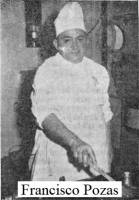
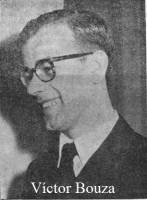
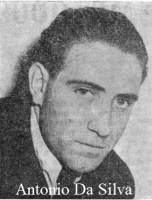
Antonio Da Silva started as an apprentice in the Factory and taught himself the machinist trade. "Da Silva, friend, what might be the cause of your apparent sadness?" asked the reporter. "The fact that I will have to spend the Christmas holidays away from home. But deep down I am happy because I have what I wanted: a job on the Valmaseda which is a marvelous craft." Da Silva then summoned the other Ferrolian, Víctor Bouza Evia, benjamin of the entire crew. He was also a little doleful at the prospect of spending the holidays away from home, "but his youth, optimism and good humour copes with the low spirits."
Francisco Pozas the chief cook was the last interviewee. "Do you esteem yourself a good cook?" "I think I'm average." "How would you rate the galley of this ship?" "Very good. The best I've seen in my seventeen years of sailing. I too do my part to ensure that the food satisfies all the crew members."
Bazan's report ends on a sentimental note,
Now they advise us that the "Valmaseda" will be putting out to sea in a very few minutes. Loudspeakers scream and forewarn us of the same immediacy. The unberthing maneuver is set to start. We are almost the last ones to go down the gangway to the pier. A sweet drizzle moistens the flaming heart of the "Valmaseda". And as the vessel starts to move and recede from us, the evening drizzle turns even sweeter, finer, like a sobbing sorrow that is not heard but seen, magical and unreal.
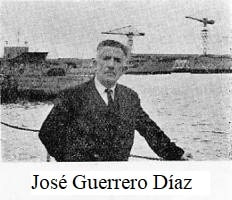
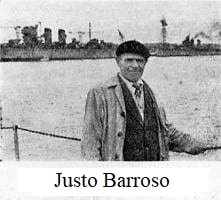
1. José Guerrero Díaz started in 1911 as a first-rate apprentice of the Assembly Workshop. He emigrated to America in 1916 but returned two years later, retaining rank and workplace. To the question, "What do you feel when you hear the shipyard whistle blow, now you are retired?" he replied, "It keeps waking me up every morning and my whole being thrills to its sound. Then I think almost always about my faraway workmates but without any feeling of sadness." "If you could start in the Factory anew, what job or profession would you like to have?" "The same one. I always liked doing my job."
2. Justo Barroso joined the Factory in 1917 as a general laborer at the Foundry. "They told us that you did not wish to retire. Is that true?" "How could it be true? Don't you understand that I can manage my day now as I please?" "Did you perform many different tasks over these almost 40 years at the behest of the Factory?" "Goodness me! I've done general labor everywhere in the workshop. I spent eighteen years at the furnaces, five months at the mill, two years in the washrooms, another two carting fuel for the ovens, seven years two months and three days as an errand boy and the remainder I spent cleaning the workshop."
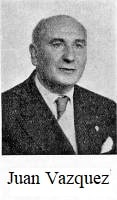
3. Juan Vazquez joined the Factory in 1918 as an Assembly Workshop apprentice. He became foreman at age 39, a lower grade master at 41 and he graduated at age 46 to master blacksmith and design drafter. "When did people work more and better, in the old days or now?" "One worked harder in the old days but, paradoxically, produced less. The worker of today is superior thanks to the technical training he receives." "Your greatest joy working for the company? Your greatest sorrow?" "My greatest joy is to have built four large oil tankers already without having to lament a major workplace accident, something that seems almost impossible because having two to four victims per vessel is a frequent occurrence in other shipyards, especially when dealing with boats as big as ours. I experience my greatest sorrow when one of my men gets hurt."
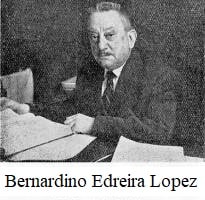
4. Bernardino Edreira Lopez started to work in 1909 as the assistant and interpreter of Mr. Munro then head of the Mechanics Workshop. A short time later he was secretary to Mr. Muir the Chief Engineer at the same workshop. Note: The Ferrolian shipyard was under majority private British management between the years 1908-1928 (End of Note). Subsequently he taught English at the Factory and in the High School. In 1957 he headed Bazan's Technical Information Office and the shipyard's library. "You have been around British people a good number of years. Did you miss them a lot when they left?" "Truly, yes; among other reasons because when the British colony settled in Ferrol I acted as the personal and trusted interpreter of them all, which forced me to speak English almost twenty-four hours everyday."
5. Manuel Candales Perille began to work in 1917 as a fifteen-year-old Pre-Assembly Workshop apprentice. He mounted naval mines first, then learned the rest of the specialties. In 1944 he was transferred with the rank of foreman to the Machine Workshop. As the technical assistant there he was sent abroad more than once.
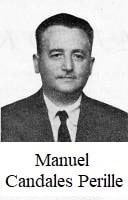 "What impressions did you gather in your visits abroad?" "I visited the shipbuilding yards of Nantes and the Rateau Paris plant in 1950. Note: The Société Rateau of Paris manufactured steam turbines (End of Note). For me it was a source of satisfaction to compare our industry and our organization with the ones we visited and to see that we are up to par with them and that our workforce has no reason to envy theirs.
"What impressions did you gather in your visits abroad?" "I visited the shipbuilding yards of Nantes and the Rateau Paris plant in 1950. Note: The Société Rateau of Paris manufactured steam turbines (End of Note). For me it was a source of satisfaction to compare our industry and our organization with the ones we visited and to see that we are up to par with them and that our workforce has no reason to envy theirs.
"In the year 1956 I was in North America at the Charleston dockyards. Aside from technical matters, what drew my attention particularly was an office labelled 'Suggestions Office' where they accept tips and proposals for improving work safety and performance and reward the beneficial contributors; the installations had posters distributed around various locations that simply said, 'It is time to make a suggestion.' This made me remember that here years ago the entire workforce had been invited to make any recommendation that would improve working conditions by way of the workshop masters, and regretting that this concept has been neglected somewhat, especially after witnessing with what pride some American workers showed their suggestions to us, suggestions which any one of our workers would deem prosaic."
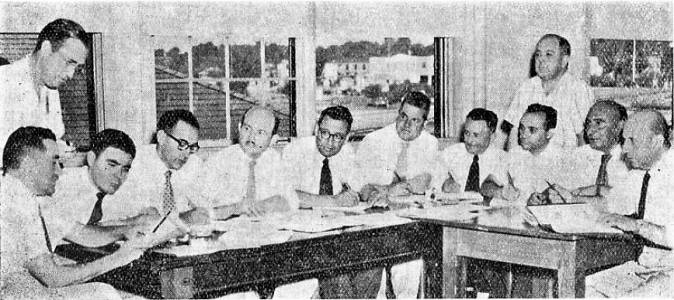
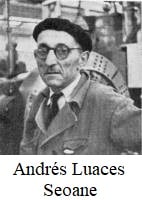 6. Andrés Luaces Seoane joined the Factory as a Machine Workshop apprentice on January 10, 1912, "a day that rained cats and dogs," he recalled. "Do you like your profession or would you have preferred another one?" "I love being a lathe operator, which is what I am and have been until today. My sole ambition in life was to work. So much so that I turned down the promotion to foreman many times because I like to work with my hands more than I like ordering my workmates about. I could have gone to university also, the financial standing of my family allowed this, but I chose to become a lathe operator, as I said, a trade that I am very proud of, despite the many people who, lacking the minimum skills required for this profession, disparage it." "What are the differences between the modern and the old ways of working, if any?" "It is not easy to enumerate them because they are many and of great importance, but the excellent training of apprentices and operators stands out. Today we have a sizeable number of lathe operators, structural steel/plate fitters and milling machine operators who can compete without fear with their counterparts from any other country in the world." "Do you believe the currency of 'fellowship' or solidarity among today's workers?" "Never man was so selfish as he is today, leaving out the exceptions, of course." "If you had command of the workshop for a week at least, what would you order to be done most urgently?" "Whatever was possible to allocate more modern tools each time."
6. Andrés Luaces Seoane joined the Factory as a Machine Workshop apprentice on January 10, 1912, "a day that rained cats and dogs," he recalled. "Do you like your profession or would you have preferred another one?" "I love being a lathe operator, which is what I am and have been until today. My sole ambition in life was to work. So much so that I turned down the promotion to foreman many times because I like to work with my hands more than I like ordering my workmates about. I could have gone to university also, the financial standing of my family allowed this, but I chose to become a lathe operator, as I said, a trade that I am very proud of, despite the many people who, lacking the minimum skills required for this profession, disparage it." "What are the differences between the modern and the old ways of working, if any?" "It is not easy to enumerate them because they are many and of great importance, but the excellent training of apprentices and operators stands out. Today we have a sizeable number of lathe operators, structural steel/plate fitters and milling machine operators who can compete without fear with their counterparts from any other country in the world." "Do you believe the currency of 'fellowship' or solidarity among today's workers?" "Never man was so selfish as he is today, leaving out the exceptions, of course." "If you had command of the workshop for a week at least, what would you order to be done most urgently?" "Whatever was possible to allocate more modern tools each time."
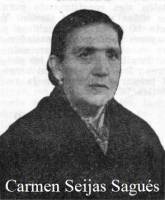 7. Carmen Seijas Sagués joined the Factory as a varnisher in 1927 and switched to upholstery after eleven years, a job where she stood out for her unquestionable ability. She was retired at the time of this interview. "Being a married and intelligent lady, what do you think is preferable for a wife, work outside the house or an exclusive dedication to domestic chores?" "Undoubtedly the second option is preferable. My working outside the house was due to pressing economic needs. But I esteem that among the high hopes of every woman must be this one of an exclusive dedication to the home." "I fully agree with you. Another question: whom do you consider the better upholsterers, men or women?" "Women and men seem equally good to me." Note: The Bazan interviewer makes the following comment in brackets, "And upon giving me this answer she could not avoid the trace of a smile at what she had just told me. Will she have truly told us what she thinks?... Truly, truly?... Since Mrs. Carmen is intelligent and all intelligent women think, though they later say otherwise, that man is superior!..." (End of Note). "Do you wish to answer one last question? What has been your highest hope all life long?" "To have always the love of my husband and the economic means to raise my children decently. This wish has already been realized in great measure, but I had to do a lot of equilibrium in the domestic sphere." "Thank you very much, Mrs. Carmen, in the name of the numerous readers of this Magazine. Now you can dedicate yourself full time to taking care of 'home, sweet home'."
7. Carmen Seijas Sagués joined the Factory as a varnisher in 1927 and switched to upholstery after eleven years, a job where she stood out for her unquestionable ability. She was retired at the time of this interview. "Being a married and intelligent lady, what do you think is preferable for a wife, work outside the house or an exclusive dedication to domestic chores?" "Undoubtedly the second option is preferable. My working outside the house was due to pressing economic needs. But I esteem that among the high hopes of every woman must be this one of an exclusive dedication to the home." "I fully agree with you. Another question: whom do you consider the better upholsterers, men or women?" "Women and men seem equally good to me." Note: The Bazan interviewer makes the following comment in brackets, "And upon giving me this answer she could not avoid the trace of a smile at what she had just told me. Will she have truly told us what she thinks?... Truly, truly?... Since Mrs. Carmen is intelligent and all intelligent women think, though they later say otherwise, that man is superior!..." (End of Note). "Do you wish to answer one last question? What has been your highest hope all life long?" "To have always the love of my husband and the economic means to raise my children decently. This wish has already been realized in great measure, but I had to do a lot of equilibrium in the domestic sphere." "Thank you very much, Mrs. Carmen, in the name of the numerous readers of this Magazine. Now you can dedicate yourself full time to taking care of 'home, sweet home'."
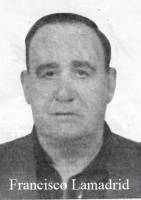
8. Francisco Lamadrid Gurruchuaga was born in Comillas, Santander. The military draft destined him to Ferrol, where he fell in love and got married. The newlyweds emigrated to America, but returned to Spain shortly after the outbreak of the Civil War. Lamadrid joined the Department of Public Works. Two months later he moved to the riveters' guild, and lately he worked in the On-Board Outfitting Workshop as a specialist. He had retired at the time of this interview. "Mr. Lamadrid, why did you come back from America?" "My wife fell sick and had to return, and I followed behind because I wanted to be by her side." "What work did you do in the New World?" "I worked on a boat as a stoker." "Would you not have relished settling in Santander?" "Pish; in fact no. My woman is from here, and since I like Galicia—it enthuses me—I decided to stay permanently."
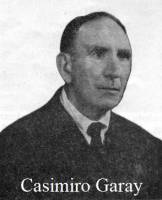
9. Casimiro Garay Villanueva was born in Agüera, Santander. He joined the Factory in 1919 as an iron boiler operator. He was transferred to the Assembly Workshop after thirty years' service and lately to the New Machinery Workshop where he attained the rank of first-class operator. He had retired when this interview took place. "If the question is not indiscreet, what motivated you to take up residence in Ferrol? Did you always live in our City?" "I came to Ferrol to do the military service, but I found a Galician girlfriend and I got married. Do you not think that this is sufficient motivation for all that followed?" "More than sufficient. Besides it is always lucky, a true lottery prize, to be able to marry a Galician girl. Something else, would you have liked being the head of some workshop?" "Well no, because I had the chance to be at least a foreman and I refused it; I think my character is not suited for that." "Final question. Tell us one of your main hobbies." "Reading, for two reasons: first, because it is true, and second, because saying it publicly always sounds good."
A short article written by Manuel F. Cabezón in Bazan, 2, disputes the prevalent opinion that the first Spanish fleet to go to war was under the command of Bonifaz of Castile, the date was Nov. 23, 1248, and the event the reconquest of Seville. He argues that the birth of the Spanish navy had in fact taken place more than a century before, in the year 1131, when Gelmírez the Bishop of Santiago de Compostela ordered the construction of a fleet to oppose the Norman raiders who periodically invaded Galicia to loot the wealth obtained by the church from the multifold pilgrimage to the purported tomb of St. James the Apostle. Gelmírez brought prestigious master carpenters of Genoa and Pisa under contract to construct a dockyard and the required boats, biremes. The Galician fleet soon gained the respect of its adversaries. Later it took part in the reconquest of Almería (1147) and eventually Seville.
The same writer draws in Bazan, 3, a biographical sketch of Álvaro de Bazán the marquis whose surname the Factory took. The second one-page essay claims that many historians concurred that the disastrous end of the Spanish Armada would not have occurred had De Bazán led the expedition, but his death "shortly before the Armada sailed out of Lisbon" put a duke in charge who lacked the energy and the ability required for the enterprise. Apparently a certain Jesuit affirmed that De Bazán died fruit of a severe row with the Spanish monarch over the slow assembling of the Armada. Previously the king had dismissed the marquis' pleas to delay the sea campaign until the unrest in the Low Countries ceased.
We ignore why these sound counsels were brushed off by the most prudent Philip the Second; we know the consequences of it: weather and the ineptitude of the duke wrecked the naval supremacy of Spain and laid the way open for the blonde Albion lording it over the seas.
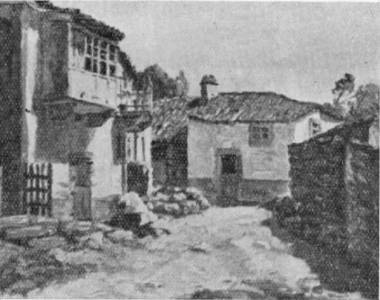
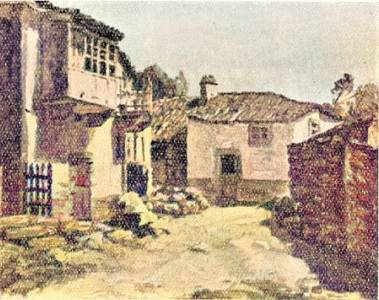 Francisco Iglesias (b. 1918, d. 1995) was a well-known artist in Ferrol who collaborated with the dockyard by way of painting watercolors of the ships (three AI colorized watercolors: gunboat, anti-submarine frigate, and a landing craft) and who arranged the décor of the company's nobler premises as well as the officers' cabins and the meeting rooms on the boats under construction. He also designed the floats used in the Three Wise Kings parade every January 6 and he prepared Bazan's official almanac.
Francisco Iglesias (b. 1918, d. 1995) was a well-known artist in Ferrol who collaborated with the dockyard by way of painting watercolors of the ships (three AI colorized watercolors: gunboat, anti-submarine frigate, and a landing craft) and who arranged the décor of the company's nobler premises as well as the officers' cabins and the meeting rooms on the boats under construction. He also designed the floats used in the Three Wise Kings parade every January 6 and he prepared Bazan's official almanac.
The two paintings directly above are another showing of his work. The black-and-white image on the left comes straight from page 21 of Bazan, 2. The colour version was generated by Hotpot's Artificial Intelligence Picture Colorizer, using a colorization factor of 25 (URL=https://hotpot.ai/colorize-picture). "Hotpot" is the name of a private company founded in the year 2019.
There were budding poets in the Factory as well. What is surprising about the fragment below, extracted from Bazan, 3, page 23, is that it is written in the Galician language! In the Ferrolian schools I went to, pupils were severely punished if they spoke Galician in class, so nobody dared to, even if it happened to be their mother tongue.
The overwhelming majority of Galicians had voted for regional autonomy in the referendum of June 28, 1936. Participation had been extremely high (75%) and practically everyone voted in favour of autonomy (the percentage was 99%). The Spanish Civil War broke out less than a month later, on July 18. The victorious fascist side set out to eradicate the latent desire for autonomy in Galicia by introducing a reign of terror in both urban and rural settings.
The piece of poetry below therefore is a testimony of courage on the part of the writer and of tolerance on the side of the shipyard's upper management. The unexpected circumstance can perhaps be explained by reflecting on the admiration that Rosalía de Castro (b. 1837, d. 1885) the unquestioned poet laureate of Galicia evoked in notable figures of Spanish literature. Even José Antonio Primo de Rivera the founder of Falange Española admired her; the fascist leader too dabbled in the occasional verse. In a speech he delivered on September 4, 1930, at a movie house of Ribadavia (Ourense Province) he said these words,
Whoever calls [Galicia] feeble forgets that from here depart her men for America where, after struggling through work, come back with great wealth; and they return to their original place of birth, where they find women, strong like themselves, who commingle with the strength of their soul the delicate sentiment that is reflected in the verses of your incomparable Rosalía.
|
Din as ondas coa escuma, mansedume,
A dorna, no mar azur, faise gume |
Say the whitecaps, humility,
The wherry on the blue sea becomes a boundary |
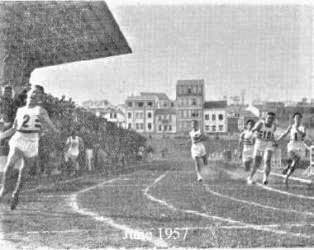
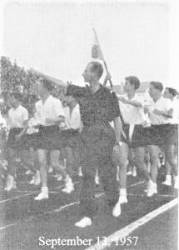
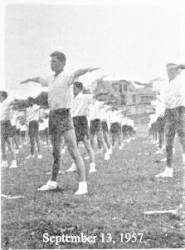
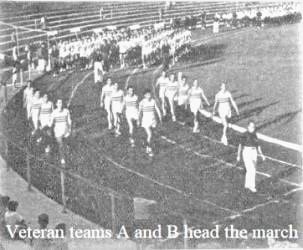
Manuel Rivera Stadium was the venue for two athletic exhibitions in 1957. The first, held in June, was the customary yearly display. The second was a special event which drew a bigger crowd.
This second gymnastic exhibition was held on September 13 in honour of the Sixth National Congress of the Physical Education and Sports section of the state-run organization, Educación y Descanso (Education and Leisure). The congress met in Ferrol. Around six hundred apprentices participated in the display along with Bazan's two veteran teams: team A which won the national Educación y Descanso competition in 1955 and team B which won it in 1956. Also taking part were pupils of the schools financed by Bazan; these performed a separate athletics demonstration similar to the ones they put on at school festivals and in the celebration marking the end of the school year. The two veteran teams led the inaugural march around the stadium. The fourteen men wore a distinctive three-horizontal-stripes shirt. The regulations of Educación y Descanso stipulated that a veteran team had to be composed of six regular members and one substitute; three out of the six regulars had to be over 35 years old.
An Educación y Descanso congressman, the head of sports for the province of Segovia, near Madrid, was asked what he thought of the show and he replied, "Very good, very good all of it, and you can say that this is the opinion of all the congressmen since we have gotten an excellent impression." "As someone who is knowledgeable about athletics, have you observed some flaw in the progression or in the planning of this festival?" "No, absolutely none." "What impressed you the most?" "Everything. But what I liked most was the exercise sequence with the flags, it was quite colourful."
The Bazan reporter asked a phys ed instructor how long it took to train the apprentices for the September exhibition. "About eighteen hours. That is to say, six days with a 3-hour rehearsal each day." "Does this demonstration reveal a particular note of improvement over previous demonstrations?" "Naturally we always try to improve. I think the most notable aspect of this event is the higher degree of synchronicity that we have achieved in all the exercises."
The exhibition of September 13 got underway at 6:15 PM sharp, "a punctuality not made use of in other activities of Spanish life," remarked M. Cristóbal Romero the author of the sports article (Bazan, 3, pages 26-28).
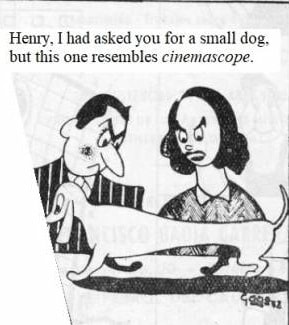 |
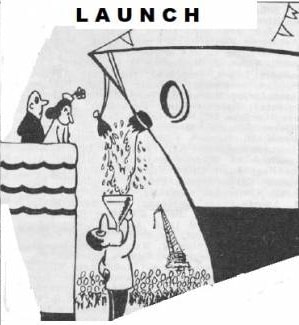 |
 |
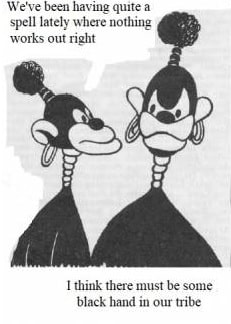 |
 |
|
 |
||
|
Acknowledgement: Mr. Xan Ramírez Gómez commented on punching the clock at Bazan-Ferrol via e-mail sent to me on Wednesday November 30, 2022. An employee could punch the clock up to 20 minutes late for up to 3 days per month without being penalized. This gave rise to the dockyard idiom, "to punch in the twentieth," (fig. in the nick of time) argot that breached the walls of the shipyard. |
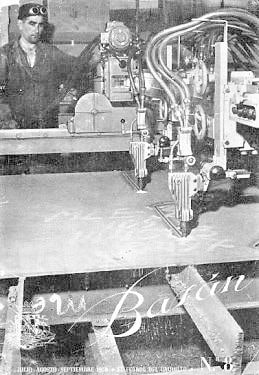
The source for the news in this chapter has already been discussed in the chapter entitled, "Bazan Magazine for the Year 1956."
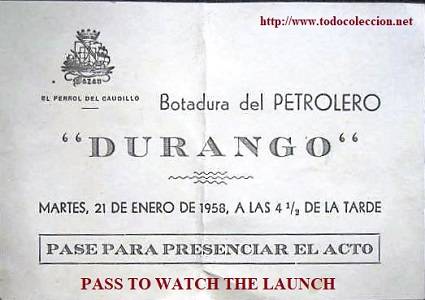
The notable event of 1958 came early in the year. On January 21, 1958, Durango the fifth boat of Series "T" was launched "between heavy showers." Bonifaz the fourth oil tanker of the series had been built by Astilleros de Cadiz and had been launched on September 27, 1957; it was delivered on February 12, 1959, and it sank nine miles off Cape Fisterra on July 3, 1964, due to a collision in heavy fog.
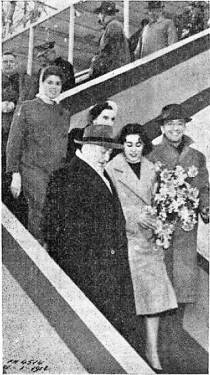
Dr. Jacinto Argaya Goicoechea the bishop of the diocese Ferrol-Mondoñedo blessed the "Durango". Present at the ceremony were the Captain-General of the Maritime Department, the military governor of the city, the commander-general of the arsenal, the mayors of Ferrol and Durango, the magistrate-judge of Ferrol, the top Navy commander and other high-ranking military officials, the head of the High School, a professor from the University of Santiago de Compostela, the vice president of "Naviera Vizcaína" shipping company, whose daughter (photograph to the left) acted as the ship's godmother, more prominent staff of "Naviera Vizcaína," the president of "Empresa Nacional Elcano" plus its top management, and the president of "Empresa Nacional Bazán" accompanied by its chief executive officers and numerous high-ranking staff.
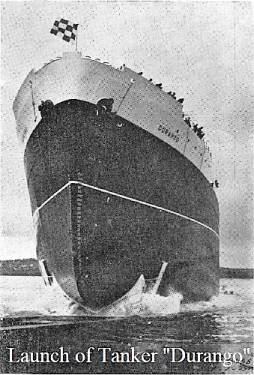
"Despite the truly wintry weather," the magazine goes on to say, "there was a big crowd in attendance, and here we make special mention of company employees and workers together with their relatives, of the apprentices and of the pupils of the Schools For the Sons of Workers."
The main technical specifications of oil tanker "Durango" were: 171 meters length overall; 32 meters beam; 12 meters air draft; 9.2 meters extreme draft; 26,100 tonnes loadline displacement; 19,670 tonnes deadweight; 7,250 BHP normal maximum power; 14 knots service speed. The vessel featured a Gyro compass, automatic pilot, radar, sonar, telephone and telegraph services, loudspeakers, running and signal lights "for crossing the Suez Canal," individual cabins, spacious living, dining and recreation rooms, plus air conditioning that was set to 27°C for the summer and to 20°C for the winter with a relative humidity level of 55%.
"Durango" was the Factory's one hundred-and-ninth construction. It was delivered to "Naviera Vizcaína" on June 12, 1958. Eventually "Naviera Vizcaína" sold it to a Panamanian concern in 1978, and on June 25, 1982, the ship sank off Mozambique due to flooding.
On October 29, 1958, Bazan-Ferrol launched its seventh oil tanker, the "Compostilla," whose characteristics were similar to the "Durango" and whose godmother was the wife of the Captain-General of the Maritime Department.
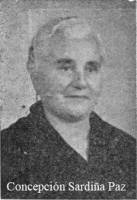
1. Concepción Sardiña Paz joined the Factory in 1929 as a member of the cleaning staff. Shortly afterward she was transferred to the dockyard infirmary full time. She had recently retired when this interview took place. "What prompted you to start working in the shipyard?" "The death of my husband who worked in the Foundry and my being left alone with five small children to take care of. Someone had to feed them." "Do you remember your starting daily wage? And the last one before retirement?" "The first one was 3.40 Pesetas. It was not enough to live on. I had to supplement it with income from other jobs. Now when I retired I was making close to 50 Pesetas a day.
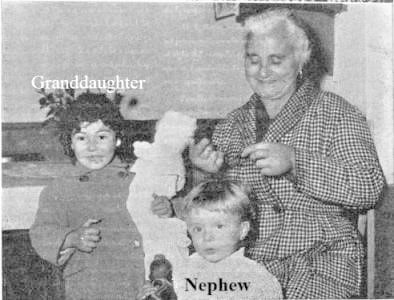 It still would not have been sufficient except for the circumstance that all my children are married and I dwell alone. Well, in fact, a dear seven-year-old granddaughter (photograph to the right; together with a visiting nephew) lives with me since a few months back." Note: According to the news entry for December 8, 1955, a loaf of bread weighing 1 kilogram then cost 5.20 Pesetas. Taking the persistent high rate of inflation into account that price would have risen to approximately 5.70 Pesetas by the year 1958 (End of Note). "Would you like to say something about your main hobbies? For example, do you like going to the movies, listening to the radio, reading..." "I like listening to the radio. I hardly go to the movies, it fatigues me. I love listening to those game shows on the radio that are so in vogue today." "Since you seem to us a very sensible and a very feminine lady, we would like to know your opinion about the women of 'today'. Are they very different from those of 'yesterday'?" "Truly they are not like those of 'yore'; they seem to me, generally speaking, to be less feminine and more brash. For me, what happens is that these women of 'today' 'know too much', without my wishing to imply that I do not consider them upright too." "Do you have many friends? Few? Are you someone who likes to chat?" "I have many friends and I love to 'gab'; unfortunately I do not have the time for it. You are men, and men prefer in some sense to ignore that there is always a 'pile' of things which need to be done around the house."
It still would not have been sufficient except for the circumstance that all my children are married and I dwell alone. Well, in fact, a dear seven-year-old granddaughter (photograph to the right; together with a visiting nephew) lives with me since a few months back." Note: According to the news entry for December 8, 1955, a loaf of bread weighing 1 kilogram then cost 5.20 Pesetas. Taking the persistent high rate of inflation into account that price would have risen to approximately 5.70 Pesetas by the year 1958 (End of Note). "Would you like to say something about your main hobbies? For example, do you like going to the movies, listening to the radio, reading..." "I like listening to the radio. I hardly go to the movies, it fatigues me. I love listening to those game shows on the radio that are so in vogue today." "Since you seem to us a very sensible and a very feminine lady, we would like to know your opinion about the women of 'today'. Are they very different from those of 'yesterday'?" "Truly they are not like those of 'yore'; they seem to me, generally speaking, to be less feminine and more brash. For me, what happens is that these women of 'today' 'know too much', without my wishing to imply that I do not consider them upright too." "Do you have many friends? Few? Are you someone who likes to chat?" "I have many friends and I love to 'gab'; unfortunately I do not have the time for it. You are men, and men prefer in some sense to ignore that there is always a 'pile' of things which need to be done around the house."
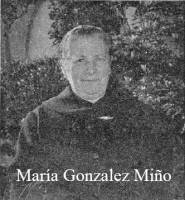
2. María Gonzalez Miño was the overseer of an important section of the cleaning staff until she retired. She was born in "the traditional borough of Esteiro the most beautiful and merriest of the city" (her words). Note: "Esteiro" was a popular neighbourhood of Ferrol associated with Bazan workers and military barracks. There were three other boroughs of Ferrol recognized by everybody when I was a child, namely: "Ferrol Viejo" (fishermen's quarter) "La Magdalena" (well-to-do district) and "Canido" (an outlying district the site of the municipal graveyard). I too was born in Esteiro bordering on La Magdalena (End of Note).
She joined the Factory after her husband passed away in July 1939 and was soon assigned employee status. The interviewer takes note of the fragrant perfume she was wearing and of her elegant bearing before asking, "You seem to be a person of good taste. Are you a fashion enthusiast?" "Yes! Very much so! Of everything that is fashionable! I sincerely think that we have made considerable progress in this regard, as in many others. Even in the way of life. Believe me because you are young and you can not recall it: the way of life back in my day was not 'living'." "Then you would not have liked El Ferrol of other epochs, right?" "That's not it at all! How could I not like my old Ferroliño (Galician affectionate diminutive), my beloved Esteiriño! (Galician affectionate diminutive). What I meant to say is something different. I had in mind a list of stupid prejudices fortunately vanquished today and which I do not wish to enumerate now. But I also want to underline that what I like best about El Ferrol is its modern look. This gorgeous, snappy Ferrol we can count on since a little while back." "Surely you are a moviegoing buff, isn't it so?" "Exactly. And I like comedy movies that make you laugh as much as the dramatic films. Every one, every one. I also enjoy promenading, although this has nothing to do with the cinema." "How do you view a woman's work in the factories?" "In the only manner, in my judgement, that it can be viewed halfway through the twentieth century: very well. And I believe that it should become much more prevalent in Spain." "And to bring these kind answers of yours to a close, would you like to reveal to us your best memory, the most cherished souvenir of your life?" The Bazan reporter notes that although she keeps smiling, her eyes wet slightly and her voice softens: "The memory of when my husband was yet alive and our children were still small."
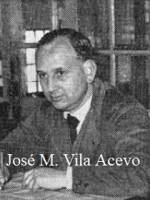
3. José Manuel Vila Acevo was born in 1915, joined the Factory in 1930 as an apprentice and obtained the rank of master in 1956. At the time of the interview he was in charge of the New Machine Workshop.
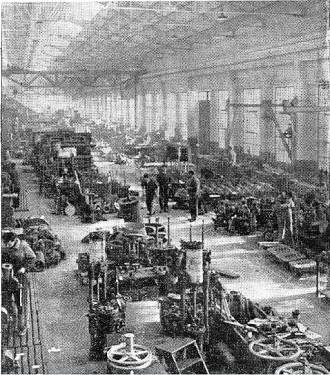
Bazan, 9, dedicated one section to this New Machine Workshop, so called because it began functioning in June 1951 on land reclaimed from the sea. The workshop had two floors and a surface area of 2,365 square meters. It faced south. A payroll of about 120 professionals made all kinds of valves "extremely varied in type and size, some valves strapped with complex high-precision mechanisms," electro-hydraulic steering gear, engine RPM and order telegraphs, repair work, etc. The plant had "a great number of modern and excellent machines" conveniently laid out to achieve the greatest efficiency in their individual utilization as well as in the overall process of production. The plant's second floor housed twenty-seven lathes, drafting tables and "a big drilling machine." Note: Perhaps a radial drilling machine (End of Note). The main floor housed boring machines, more lathes—some vertical, others turning-revolver—milling machines, chisels, files, brushes, hand drills, etc., and a herringbone gear hobbing machine, "perhaps the only one of its kind in Spain." The product quality-control area was located on the main floor also. Two overhead conveyors "screeching in their monotonous come-and-go" moved loads back and forth to the place of need.
"Was the creation of this New Workshop really necessary?" "Yes, the old one was not sufficient." "Does the New Workshop specialize in something?" "Yes, mainly on the making of order telegraphs, steering gear components and a compendium of valves." "Do you miss the old workshop?" "Indeed. There lapsed my apprenticeship and my youth." "What virtue would you point to as the most outstanding of today's operator?" "His tremendous self-assurance in the elaboration of workpieces and the exactness of their dimensions. Of course the precision of today's machines grants him an advantage over yesterday's operator." "And the most outstanding defect, also?" "Perhaps that he works too quickly, but the blame can be pinned only on the piece rate system." "Have you dwelled in Ferrol always?" "Always." "And never had the temptation of moving to another geography?" "No. Ferrol always tugged at my heartstrings a lot."
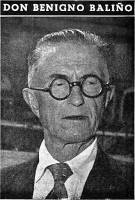
4. Benigno Baliño was born in 1893 and joined the Factory in 1920 as helmsman of the tugboat Consort. Toward the end of his career he attained the rank of foreman. He had recently retired when this interview took place.
"Do you feel a genuine vocation for seafaring?" "Yes, I felt it my whole life long." "When did you embark for the first time?" "For the first time, and in earnest, at age sixteen when I enrolled as sailor apprentice on board the Villa de Bilbao." Note: The Villa de Bilbao was a corvette built in Great Britain in 1845, delivered to the Spanish Navy the following year and decommissioned in 1930. It was permanently stationed at Ferrol after 1917 (End of Note). "And would you not have preferred to belong to the Merchant Marine and travel all over the world?" "I belonged to it during the years 1918 and 1919, but I missed El Ferrol a lot and preferred not having to depart or sail far away from our bay." "Would you like to relate to us one of those 'old sea dog' anecdotes?" "During the past global contest [sic] one time when we were transporting cargo with the Consort some American reconnaissance planes appeared over us and did not abandon us for over more than fifteen minutes. So, out of fear, everyone on board, without exception, lost their appetite for the entire day."
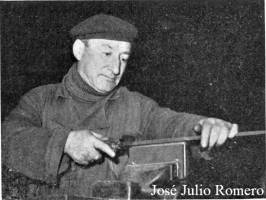
5. José Julio Romero was a popular worker in the Electricity Workshop who made the Bazan reporter laugh with his wisecracks prior to the formal interview. "What is your professional status?" "Worker first class." "Your fellow workers say that you are the most popular operator of the trade. Do you share their opinion?" "The truth is I don't know what to say...but if they say so...Perhaps my playing the bagpipes livens the spirit of the workshop. Fact is, and I don't say this because I am standing in front of you, I do play the bagpipes and play them very well, eh..." Romero said he had founded the choir "Ecos Da Terra" (Echoes of the Land) and also been a member of the legendary Ferrolian chorale, still in existence, "Toxos E Froles" (Gorses And Flowers).
The interview finished with Romero relating a hazing he underwent. "When I was an apprentice working in the 'Reina Victoria Eugenia,' a worker ordered me to go 'see' if there was 'current' in a lamp holder. Note: Reina Victoria Eugenia was the name of a battle cruiser built in Ferrol; it was launched on March 21, 1920 (End of Note). Since I did not know what a 'current' meant or how one 'saw' it, I asked him how to go about it, and he answered telling me to stick the finger in the lamp holder. Neither mousey nor lazybones I did just so and...I almost kicked the bucket. With the tremendous shock I received I learned what 'current' meant, and what's more, I can assure you that for the rest of my life I took on a lot of respect for it."
Rafael Suarez Pedreira followed the lead of Juan Manuel Castro in 1957 and composed this Galician poem for Bazan, 6. The illustration was drawn by Francisco Iglesias (see ARTS AND LETTERS for the year 1957). I have coloured his black-and-white illustration on page 30 of Bazan, 6, using Hotpot's Artificial Intelligence Picture Colorizer with a colorization factor of 12 (URL=https://hotpot.ai/colorize-picture). "Hotpot" is the name of a private company founded in the year 2019.
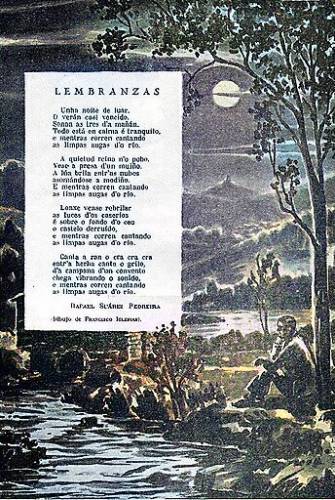
|
A night of bright moonlight.
Quiet reigns in town. |
The bourgs' house lights
Sings the frog, croak, croak, croak, |
Luis Eugenio Lopez Rey penned a Spanish poem on page 30 of Bazan, 5, which attempts to link a woman's character to the colour of her hair. Perhaps the poem discloses instead the author's biases and piques, particularly when he brands the redhead "ugly" (?) on the first line of the final stanza.
|
Blonde
She is shy, sweet, good-natured,
Melancholy and serene,
To herself and to her hearers
Openhanded and generous, Chestnut
She is lively, peppy, amusing,
Qualified, capable, bustling,
If she has blue eyes,
If black, the intellectual arts |
Brunette
She is competent, cautious and patient
Being an eminent diplomat
She gravitates toward her home;
She is orderly Red
She is headstrong, irritable,
She is also easily crossed,
Most generous and sincere
Ugly, she will spend her life |
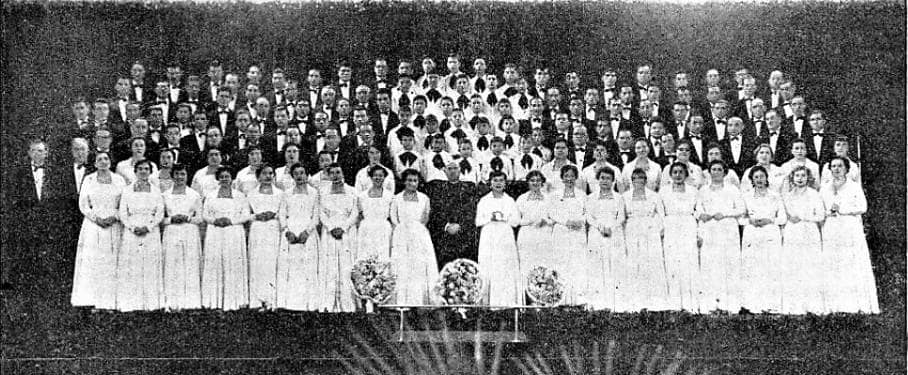
The above photograph comes from page 24 of Bazan, 8.
On July 16, 1958, Bazan's chorale and orchestra accompanied the Mass that the Spanish Armada dedicates every year to its Patron Lady of Carmel in Ferrol and at all naval bases.
The chorale sang Missa Secunda Pontificalis, a piece composed in 1906 by renowned Italian composer Lorenzo Perosi.
On September 15, 1958, the chorale travelled to Mondoñedo, a small town yet the see of the Ferrol-Mondoñedo diocese. This region of Lugo Province, called Bretoña, was settled by Romano-Britons fleeing the Anglo-Saxon conquest (Wikipedia). The see's original name was Ecclesia Brittaniensis and Maeloc its first bishop.
The chorale repeated the program of July 16 for the Mass celebrated by Cardinal Benjamín de Arriba y Castro in Mondoñedo.
In the evening the chorale of Bazan plus the band of the Northern Third Corps based in Ferrol offered a free concert at Mondoñedo's promenade before thousands of people, about two thousand were Ferrolians. The vocal portion of the program included Verdi's Triumphal March, Wagner's Tanhäusser Grand March and Morera's Sardana de los Monjes. The marines separately honoured the Cardinal with Gaudot's two-step instrumental, Lugo-Ferrol, appropriately enough.
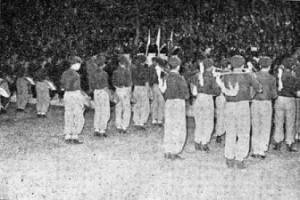
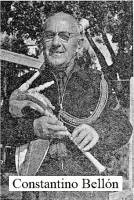
The photograph of the apprentices' music band (above, left) was taken on May 1, 1958, during the closing ceremony of "The Workers' Olympiad" at Santiago Bernabeu Stadium in Madrid (see the SPORTS Section).
Originally Bazan's band of apprentices consisted of buglers and drummers exclusively, but in February 1958, band director Constantino Bellón Lago (above, right) added nine novice bagpipers.
Bellón was born in February 1896 in Valdoviño. He joined the Factory as a ticket checker/collector at age twenty-eight; he asked to be transferred to the Cabinet Making Workshop in 1927 where he started as general-helper and eventually rose to the status of worker first class.
Mr. Bellón is an excellent musician. He plays the alto and tenor saxophones, the oboe and the Galician bagpipe. This instrument typical of our folklore garnered for him diverse and long trips abroad. And as well the assignment from Company Management in the year 58 to found and organize a band of Galician bagpipers made up exclusively of apprentices ... Mr. Bellón is without doubt the most popular operator of the entire workshop.(Bazan, 15, p. 17)
Bellón was very pleased with the results obtained in so short a time, for the nine apprentices initially "lacked the most rudimentary musical knowledge." On May 1, 1958, they and their fellow band members headed the nighttime parade in Madrid and then took turns at providing musical entertainment with a group of "some seventy teachers" from other parts of Spain.
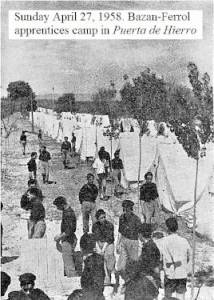
The buses transporting Bazan-Ferrol apprentices to the annual national championships of Educación y Descanso arrived to Parque Sindical Deportivo in Puerta de Hierro near Madrid around 10:20 PM on Friday April 25, 1958. They arrived late, the tournament's official inauguration had already taken place on Thursday afternoon.
The team that "Empresa Nacional Bazán" brought to the Games combined workers from two shipyards, Ferrol and Cadiz. The Ferrolian contingent outnumbered the Cadiz component by far. The few Andalusians lodged at a downtown hotel in Madrid while the many Galicians camped outdoors (photograph on the right). Overall Bazan was the biggest team of the tournament, consequently it is not too surprising that it should have racked up the highest number of points and ended up champion for the fourth year running.
The meet of 1958 was nicknamed, "The Workers' Olympiad." It also went by the name, "Syndical Sports Games." Around ten thousand workers from over four hundred industrial, commercial and agricultural enterprises across Spain participated. The final day of competition was Wednesday April 30.
Whole Reel (year 1958)
NO-DO Revista Cinematográfica Imágenes Nº 696 covers in ten long minutes the salient features of the Workers Olympiad. The film recorded on min. 2:05-2:18 the 100-meter sprint won by José Luis Bejar of Bazan-Ferrol (see below).
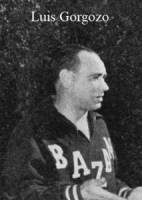
Luis Gorgozo, 41-year-old firefighter of Bazan-Ferrol, was the shot put champion in the veterans category and the "multiple trials" champion in the same category.
The "multiple trials" event for the veteran athletes comprised long and high jumps, hammer throw, pommel horse and vaulting box jumps, a 500-meter track race and a 50-meter free-style swim. The marks obtained by Gorgozo were long jump: 4.82 meters, high jump: 1.35 meters, hammer throw: 18.18 meters, 500-meter run time: 1 minute 23 seconds, 50-meter swim time: 43 seconds.
Gorgozo was asked, "Did you encounter many difficulties getting your double title of national champion?" "Quite enough. Although we were all fairly senior there were several very good athletes. I was successful only thanks to the enthusiasm which I never lost for a moment." "How did the Madrid press treat you?" "Very well. It talked a lot about us, complimenting us, something they do every year. So much so that they picked us favourites to win the teams category in these Workers Games. That is, I think, the best accolade they could have made."
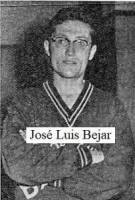
José Luis Bejar, 19-year-old machinist of Bazan-Ferrol, finished first in the 100-meter sprint with a time of 11.6 seconds. The reader can actually watch this race between minutes 2:05 to 2:18 of the video, NO-DO Revista Cinematográfica Imágenes Nº 696, found above.
Bejar also finished first in the 200-meter sprint with a time of 23.6 seconds.
He was asked, "What was your greatest joy participating in the Games?" "To have been champion in both trials as well as our final triumph in the teams category." "What trophies did they give you as champion?" "Two award box cases with two commemorative plaques of the events, the same as what all the national champions received."
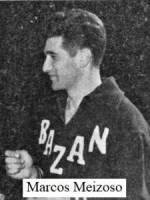
Marcos Meizoso, 22-year-old carpenter of Bazan-Ferrol, was the shot put champion in the youth category and the "multiple trials" champion in the same category.
The "multiple trials" event for the young athletes comprised long and high jumps, hammer throw, pommel horse and vaulting box jumps, 1,000-meter track race and a 100-meter free-style swim. The marks obtained by Meizoso were long jump: 5.67 meters, high jump: 1.50 meters, hammer throw: 20.45 meters, 500-meter run time: 3 minutes 2 seconds, 50-meter swim time: 2 minutes 9 seconds.
According to this dispatch sent by telephone from Madrid by Santiago García on the final day of competition, April 30, and which appeared in the May 1 edition of the Catalan newspaper, La Vanguardia, the Games had left an "indelible" impression because of the expressly constructed sporting facilities, particularly the olympic grade swimming pool, because of their successful organization and for having brought together in "bonds of friendship and awareness" during seven days of "unforgettable" sporting activity ten thousand "authentic workingmen" from the various territories and peoples of Spain.
The reporter took special note of the "feminine representation" at the Games, particularly of the "graceful" Galician synchronized swimmers, and he gave the names of all eleven. "They are all sales clerks or office workers, share a lot of enthusiasm for artistic swimming and know by heart all the feats of Esther Williams."
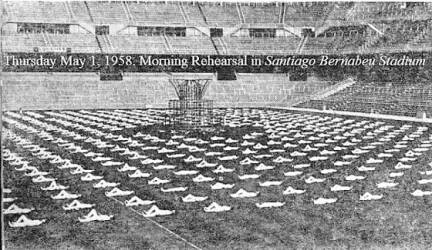
Around 10:00 AM on Thursday May 1, eight hundred Bazan-Ferrol apprentices were taken by bus from Puerta de Hierro to Santiago Bernabeu Stadium to rehearse that night's mass gymnastics show before 120,000 spectators. The rehearsal (photograph on the right) started around 11 o'clock. Bazan, 6, does not specify when it ended, but around 1 o'clock in the afternoon is a good guess.
The nighttime show opened with a parade of the ten thousand athletes and referees followed by selected athletics routines, various styles of wrestling, an exhibition of vaults with apparatuses carried out by the Renfe apprentices of Madrid and the grand finish: a mass gymnastics routine carried off by the eight hundred Bazan-Ferrol apprentices, culminating in the erection of a human tower on the middle of the pitch (the safety props are visible in the photograph to the right).
The following clip focuses on the nighttime exhibition at Santiago Bernabeu Stadium. The full newsreel, ten minutes long, was first shown on Monday May 12, 1958.
Voice-Over Translated: His Excellency the Head of the Spanish State acknowledges the acclamations of the 120,000 persons who fill Santiago Bernabeu Stadium in the brilliant closure of the Syndical Sports Games. Ten thousand producer-athletes parade before the Generalissimo in the Christian Feast of Labour as unanimous and representative homage rendered by working Spain. The diplomatic corps occupies one of the tribunes. The Minister Secretary-General of the Movement accompanies Franco. The troop of referees leads the parade of soccer players. Sport's anonymous heroes participate in the parade, those who have been able to wrest marks off the track and garner the triumph in any one of the twenty set disciplines. Two hundred workers from the workshops of Renfe-Madrid execute their vaults in a public lesson of how the enterprises have in mind the physical culture of the producers. Eight hundred men from Empresa Nacional Bazán carry out an extraordinary gymnastic demonstration. Their displacements and their exact and disciplined executions conform in every instant to the most perfect rhythm. Precision and harmony define the exhibition of the gymnastic routine. These exercises conclude with the composition of a human tower which rises like a symbol of The Workers Olympiad over the Spanish land where the Syndical Sports Games have conveyed an eloquent expression of the peace and discipline of the fatherland.
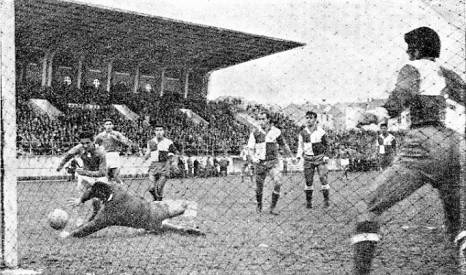
A. Permuy Martínez analyzed on pages 32-33 of Bazan, 8, the Second Division Group North standings and statistics and made the following forecast of the final classification table (below, left-hand double column). The actual outcome of the 1958-59 season is given on the right-hand side. It is evident that home bias spoiled a fairly decent forecast.
| Forecast | Reality | |||
|---|---|---|---|---|
| Team | Points | Team | Points | |
|
1. Real Valladolid 2. C. D. Sabadell 3. Ferrol 4. Indauchu 5. Condal 6. Santander 7. Sestao 8. Basconia 9. Deportivo 10. Tarrasa 11. Irún 12. Baracaldo 13. Alavés 14. Rayo Vallecano 15. Gerona 16. Avilés |
40 38 34 33 33 32 32 29 29 28 27 27 27 26 22 21 |
1. Real Valladolid 2. C. D. Sabadell 3. Indauchu 4. Condal 5. Basconia 6. Baracaldo 7. Deportivo 8. Sestao 9. Santander 10. Ferrol 11. Avilés 12. Tarrasa 13. Alavés 14. Rayo Vallecano 15. Gerona 16. Irún |
40 39 35 32 32 31 30 30 30 27 27 27 27 26 25 22 |
|
Deportivo the professional soccer team of A Coruña was Ferrol's archrival.
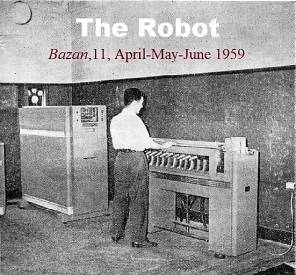
Mathematical "proof" is advanced on page 34 of Bazan, 7, that four equals five!
The tongue-in-cheek fib is introduced with a little story.
An important retail store asked its marketeers to come up with a catchphrase that would attract more customers. The marketing department returned a tagline insinuating that four dollars had the purchasing power of five in the store.
Management voted to approve the tagline if it could be shown that four is really equal to five, a requisite to avoid being sued for false advertising.
Consequently the store hired the services of a computing robot to investigate the claim.
After complicated and laborious combinations of numbers the hired robot showed mathematically that four is equivalent to five. After trying out many combinations of numbers the robot first settled opportunely on these two,
16 — 36 = -20 (1)
25 — 45 = -20 (2)
Evidently the left-hand side of (1) and (2) also constitutes an equality,
16 — 36 = 25 — 45 (3)
The robot then decided to add the same number to both sides of (3). After repetitive trials with many numbers it finally picked the singular fraction 81/4,
16 — 36 + 81/4 = 25 — 45 + 81/4 (4)
The astute robot then noticed that the left-hand side of (4) could be factored,
16 — 36 + 81/4 = (4 — 9/2)2 (5)
The right-hand side of (4) can also be factored,
25 — 45 + 81/4 = (5 — 9/2)2 (6)
(5) and (6) retain the equality of (3). That is to say,
(4 — 9/2)2 = (5 — 9/2)2 (7)
The robot then had the "felicitous idea" of taking the square root of both sides,
(4 — 9/2) = (5 — 9/2) (8)
Adding 9/2 to both sides yielded the desired result,
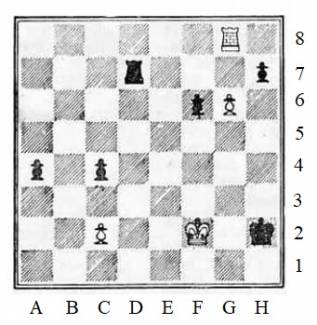
The illustration comes from page 32 of Bazan, 5. The endgame is credited to A. Selesnieff, 1919.
The white piece on G8 is a rook. The white king is on F2. The black piece on D7 is a rook. The black piece on F6 is a bishop. The black king is on H2. All the remaining pieces are pawns.
Origin of International Workers Day May 1st. The Federation of Organized Trades and Labor Unions of the U.S. and Canada (F.O.T.L.U.) held its fourth congress in October 1884. It called for the start of an 8-hour-workday labour movement and urged all labour organizations to vote on a general strike set for no later than May 1, 1886, to press their demands. The Fifth Annual Congress of 1885 reiterated the call. On May 1, 1886, over 190,000 workers struck. On May 3 Chicago police killed two workers in a confrontation between strikers and scabs at the McCormick Harvesting Machine Company. A small crowd gathered at Haymarket Square on May 4 to protest the police action. A bomb exploded killing seven policemen. Public opinion reproved the trade unions and the eight-hour-workday movement fell apart.
On July 14, 1889, the International Workingmen's Congress (i.e. the Second Communist International) gathered in Paris. American delegates acquainted the rest with their plight. The congress then instituted May 1, 1890, as the day for workers all over the world to demand the legal reduction of the workday to eight hours.
On Sunday May 1, 1955, Pope Pius XII instituted the feast of St. Joseph the Worker to counterpose Communist influence in the working class of Catholic countries. Spain follows suit the following year 1956.
The Bishop's Letter To Bazan Workers. The source is Bazan, 5, January-February 1958. The bishop's letter anticipated the festivity of 1958, it was signed beforehand with the premature date of April 11, 1958.
My dear friends:The date of May 1 is the feast day of St. Joseph the Worker.
It was just and proper that workers had their Day. Note: They had it already. Reverend Fanego the chaplain of Bazan states in the same number that the festivity of "Glorious Saint Joseph the patron saint of the workers" had been celebrated "as always" on March 19, 1957, at San Julián Church (End of Note).
The Pope has desired it so, acknowledging and blessing what already existed and giving it a global dimension. I still keep in my retina the unerasable impression of the 500,000 workers, believers in Jesus Christ, gathered two years ago in the immense square of Milan. It was a truly international demonstration. Workers from all countries and races in genuine brotherhood acclaimed the Holy Craftsman. Pius XII undersigned the birth certificate of this Feast with a lovely address, broadcast by radio and television. Notes: "The immense square of Milan" is the Piazza del Duomo, but the Vatican archive has Pius XII giving the speech at St. Peter's Square; both can't be right. The "Holy Craftsman" here is St. Joseph. (End of Notes).
Significance of The Feast
The object of the Day of St. Joseph the Worker is to make everyone understand the nobility of manual labour, a source of sustenance for a great number of men, magnificent opportunity for sanctification and a necessary instrument for the life of society.
Jesus Christ wanted to be an artisan, he chose this most noble profession; St. Joseph was one too; and the Virgin Mary devoted herself to the domestic chores of her simple home. St. Joseph's family was the classic workingman's family: with its joys, its prostrations and its privations. He even had to eat the hard bread of emigration. Note: Venezuela alone received 45,000 legal Galician immigrants between 1950 and 1956 inclusive. Source: Xosé Ramón Campos Álvarez, 2020: "Brief quantitative analysis of the Galician emigration to Venezuela." University of Vigo (End of Note).
The Day of St. Joseph The Worker In The Diocese
Here too we are going to celebrate the Day of St. Joseph the Worker with all solemnity. We will begin in El Ferrol del Caudillo and Puentes de García Rodríguez. Note: Today's As Pontes, 42 kilometers from Ferrol. The coal mine closed and was replaced with an artificial lake (End of Note).
On May 1 at 11:00 AM I will celebrate Mass at San Julián Church for those who perished in workplace accidents. We can call them, "martyrs of labour."
They practised sturdy virtues: honesty, industry, camaraderie, fulfilment of duty; they worked conscientiously to maintain their wife and children with dignity; and death at the breach crowned their noble life. We hope that God will have accepted their holocaust.
The bishop will make use of the Holy Sacrifice for the eternal rest of their souls. Preferential station in the temple will be assigned to their widows and orphans.
Ferrolian workers, for the sake of camaraderie and solidarity, you can not miss this heartfelt tribute. Your bishop invites every one of you without exception and he expects to see you there.
A similar ceremony will be held at 9.00 AM in Puentes de García Rodríguez with my obligated presence. I also hope to see all the workers of that Important Industrial Complex there.
Performance At Teatro Jofre
Acción Católica Obrera (Workers' Catholic Action) will organize a Christian act of exaltation of labour and glorification of St. Joseph the Worker at 12:00 noon at Teatro Jofre. The Polyphonic Chorale of Bazan, showcase of your sensibility and culture, will lend its unsurpassable cooperation.
We hope that this Day's celebration will leave the most gratifying impression on your souls.
My First Contacts With The Workers
Recently I had the pleasure of speaking to the workers of Bazan, to the ones of Empresa Nacional Calvo Sotelo in Puentes de García Rodríguez and to the nucleus of workingmen in Jubia. Note: Today's Xuvia, a borough of Neda County, 7 kilometers from Ferrol (End of Note). I wish to establish bonds of true friendship with them and with everybody else.
Naturally my talks have been commented on. Some saw in their bishop a cordial, modest man who wants to do as much good as he can. I don't know if that's who I am. But I want to be that way.
Apparently others did not fully believe my offers of cordiality. Let time say.
I do not promise you anything. I am almost as weak as you are. But I assure you that you will discover a sincere friend in me, full of the best goodwill, and always at your disposal.
Count on the affection, blessing and best prayers of
YOUR BISHOP
Mondoñedo. April 11, 1958.
Dad once told me that at a regular meeting of Acción Católica in Ferrol a motion carried asking for volunteers to distribute a Catholic magazine aimed at the workers. When the roll call got around to my father, he answered, "When the bishop comes with us to distribute and he is the first one in line, I'll go also."
I never asked Dad for details, so I do not know what year it was or who the bishop, but I suspect that this happened in the late 1940's and that the magazine in question was the weekly, "¡Tú!" (You!) published by Hermandad Obrera de Acción Católica (Workingman Brotherhood of Catholic Action). This brotherhood, in existence today, is commonly known by the acronym, HOAC.
The General Archive of Universidad de Navarra keeps the papers of HOAC militant Teófilo Pérez Rey (1923-1999); his records (PDF) show that "¡Tú!" was suppressed during the first week of December 1949, accused of "an insidious campaign against Falange Española and against Franco's rule and government." Simultaneously a Falange official of Toledo charged that "many" HOAC members hid their socialist and even marxist ideals behind the sign of the Cross. Note: The allegation was true (End of Note). The publication went underground. Ferrol must have been a notable center of distribution because from January 4, 1950, the local radio station broadcast a virulent campaign orchestrated by the far-right paramilitary organization, Guardia de Franco, against HOAC and "¡Tú!" The paramilitaries published a weekly sheet called, "Sí" (Yes). It had carried a conspicuous article on September 25, 1948, entitled, "A Modest Essay of Communist Agitation In El Ferrol" (here). Thus distributing "¡Tú!" in an environment of open Falangist opposition was fraught with danger.
HOAC protested the Falangist persecution and appealed to Enrique Pla y Deniel the cardinal primate of Spain. The records imply that the cleric demurred. HOAC then ceased printing the magazine.
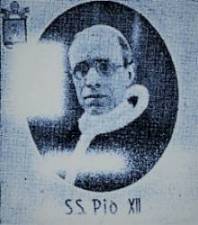
Pope Pius XII passed away on Thursday October 9, 1958.
NO-DO produced a special newsreel dedicated to the glum tidings. It lasts six minutes and was first shown on Monday October 13, 1958.
Voice-Over Translated: Castel Gandolfo registers the most grievous news that could stir the Catholic world. His Holiness Pope Pius XII has died. The physicians who attend His Holiness sign the medical bulletin. Professor Lisi reads this briefing to the reporters who will immediately disseminate it throughout the world. Representatives of the diplomatic corps and top personalities arrive at Castel Gandolfo to give account of the first testimonies of the grief that everywhere has caused the decease of the Vicar of Christ on earth. The prayers of everyone multiply for the soul of the Pope who gave himself to the service of God without dodging efforts or sacrifices and whose departure from this world sows mourning in the souls and stirs the children whom he so loved in perfect imitation of Our Lord Jesus Christ. The information circulates in the press. The flags are lowered to fly at half mast. His Holiness passed away at 3:52 AM of October 9, 1958. The door of the pontifical Chamber is already sealed. The Catholic world apprehends the heartache of the unrecoverable. The egregious figure of Pius XII, Pastor of the world, expired virtuously on the modest iron cot where he bedded after falling ill. Cardinal Tisserant the dean of the Sacred College of Cardinals recites the prayers for the dead and imparts the priestly blessing with holy water. The pontificate of Pius XII coincided with one of the grimmest periods in the history of the world. Hardly ascended to the throne, the Pope had to face up to one of the greatest belligerent conflicts recorded by history and in addition brave the Communist persecution of the Church. The multitude gathers before the papal residence after knowing the news of the death and renders its final and heartfelt tribute. The mortal remains of the Supreme Pontiff are carried to the chamber where he used to grant his audiences. The head of the Italian State comes to express his condolences to Cardinal Tisserant. The faithful of Castel Gandolfo give their last good-bye to the Supreme Pontiff.
Voice-Over Translated: In Catholic Spain the newspapers echo the heartache of the people when the unfortunate news becomes known. The top echelon of the state dictates, expressing the testimony of the profound sorrow of our fatherland, the decree that lays down ten days of official mourning. During this time the flag will be hoisted at half mast upon the public buildings. As well black bows are pinned on the national flag placed in windows and on balconies. The testimonies of grief are unanimous at the hall of the apostolic nunciature, and the pages fill quickly with signatures. The mayor of Madrid and also all the ministers of the government arrive to express the sorrow which the head of the state interpreted accurately in his message to the Vatican. Thus a witness of condelence for the death of Pius XII is preserved, surrounded by the filial love and fervorous devotion of the faithful who were proud of so glorious a pontiff. The diplomatic corps certified in Madrid arrives also at the diplomatic site of the Vicar of Christ in our capital to express its condolence for the decease of the common father. A solemn funeral arranged by the Spanish government is going to be officiated at the national temple of San Francisco El Grande, attended by representatives of the diplomatic corp. Monsignor Antoniutti the nuncio of His Holiness and Dr. Eijo y Garay the patriarch of the West Indies and bishop of Madrid arrive. Also in attendance are the president of the Cortes and the ministers of the government. After reviewing the troops that render him honours, His Excellency the Head of State, accompanied by his wife, is complimented by the ministers. Franco makes his entrance under processional canopy. The tumulus with pontifical tiara rises in the center of the temple. The patriarch-bishop officiates the Mass assisted by religious brothers of the Franciscan community. The death of the most beatus father shrouds the world in mourning. He will be unforgettable for his immense labour that enriched the Church in her universality and in her prestige. He sacrificed himself for peace, fought for the social headways of Christian spirit and for justice and charity. The example of his life and of his ministry will always illuminate us. The Generalissimo reiterates the testimony of sorrow to the nuncio in the name of the whole of Spain.
Reverend Fanego the Factory's chaplain dedicated pages 30-31 of Bazan, 9, to the news. According to his article, Pius XII had been an "extraordinary figure," "one of the most eminent men in world history," "a wise man in the broadest sense of the word, wise in all the branches of human knowledge," "an eminent polyglot," "a Saint," "a man of immense inner spirituality," "a man of enthralling supernatural charm," "eminent Diplomat, great Statesman, most loving Father of all humanity without distinction of races or creeds, the Pope of Peace, of Social Justice," "the man most esteemed, most admired and most revered of the contemporary world." And he continued, "Today Pontiff Eugenio Pacelli fills one of the most glorious chapters not only in the history of the Pontiffs of the Church but in the Gilded Book that inscribes the most illustrious men of the History of Humanity."
The article then proceeds to report on and translate into Spanish the various notes of condolence forwarded to the Vatican Secretariat of State by the most relevant personalities of the day. Some instances follow,
The world is today poorer than yesterday because Pius XII has died. He was the highest example of a life dedicated to divine devotion and to the service of humanity.Eisenhower, President of the United States.
The greatest statesman of the last two hundred years has died.Truman, ex-President of the United States.
A grave loss for the whole world and for the German people in particular.Adenauer, Chancellor of West Germany.
This generation has lost one of its noblest sons and the greatest of its leaders.Dag Harmmarkjold, Secretary-General of the United Nations.
In a generation afflicted by wars and unrest, Pius XII preserved the highest ideals of peace and compassion.Golda Meir, Foreign Affairs Minister of Israel.
Future generations will bless his name for his many kindnesses, for the vigilance and love with which he grazed his sheep and indoctrinated the world. And Spain, participating with such deeply felt emotion in the mourning of the Church, bows faithful and devout to honour the name and the work of he who was staunch defender of peace and angelic Pastor of Christendom.FRANCO [sic], Head of the Spanish State.
The article also points to the "respectful minute of silence at the United Nations for the Leader of Peace," the uncustomarily bold headlines in the British press, "the prayers in synagogues," and the telegrams from President Nasser and from the Patriarch of the Greek Orthodox Church, "the funerals everywhere, presided by Eisenhower in the U.S., Hirohito in Japan, etc."
On October 15, 1958, Ferrol celebrated a "most solemn funeral" at 7:30 PM in San Francisco Church, the military temple where Franco had been baptized in 1892. Bazan's Polyphonic Chorale and Orchestra performed Perosi's Messa da Requiem.
Reverend Fanego the Factory's chaplain dedicated the remainder of his article to a biographical sketch of the elect Pope John XXIII, making special mention of the elect Pope's pilgrimage to Santiago de Compostela in the "Holy Year" of 1954.
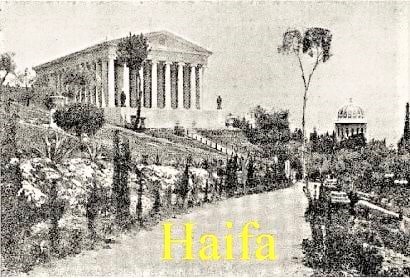
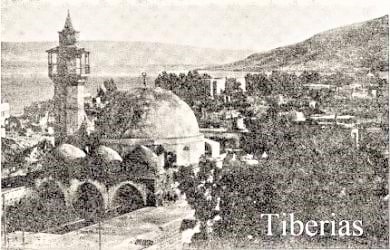
The Reporter Was A Magician. On pages 26-27 of Bazan, 8, and continuing on pages 25-26 of Bazan, 9, José Lorente de Castro (1927-2006) "employee of our Factory and illusionist of international renown" sent to the editors "this brief and interesting" report from the "faraway country of Israel."
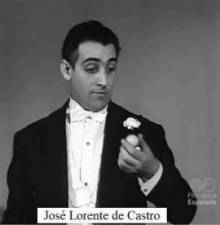
José Lorente de Castro was featured and interviewed on pages 29-30 of Bazan, 4. The article states that Lorente joined the Factory as an apprentice accountant who later graduated to administrative first officer. He took his first steps in show business at Teatro Jofre as part of the earliest festivals arranged by Bazan's branch of "Educación y Descanso."
The year 1949 marked his breakthrough to national recognition when he won "the first prize" with the unanimous vote of the jury at the "International Congress of Magic and Illusionism" held in Barcelona. Note: A stretching of the truth. Lorente earned the first prize in the Manual Dexterity category and won second prize in the Creativity category. According to this webpage, Li-Chang (a Catalan magician) earned the Extraordinary Prize and Niberco (a Dutch magician) the Grand Prize of the congress. The official name of the convention was "First National Congress of Illusionism," held in Barcelona between May 26-29, 1949 (End of Note).
"Due to excessive self-criticism," Lorente opted to retire temporarily to work at improving his skills. He returned to the show business circuit seven years later in 1956. The Bazán interview follows.
"Age, Lorente friend?" "Thirty years old. I am married to Julit, and from this happy marriage I have a son already."
"What is the reason behind the artistic name, Lor'C y Julit?" "Professionalism forced me to substitute my real surname for something that would better attune with certain commercial imperatives."
"Do you think that illusionism still has a future?" "Look, not indeed as it has been practiced until now. I'd say that it stands at a crucial moment of transition and adaptation to the sensibility of the era."
"Do you esteem that you have made some worthy contribution to illusionism?" "Quite. In regard to technique I have created and perfected the sleight of hand with coins, and in regard to the performance on stage I have bolstered the modern technique of not speaking by combining magic tricks with dancing moves; this embellishes the execution of a magic trick. I am now daring to introduce juggling with magic in view of the favourable reception obtained by the previous innovation."
"A final question. What was always your maximum goal as an artist aside from the success you have already achieved?" "To be constantly upgrading."
Vidal the Bazan interviewer adds that the magician sent a "very fond greeting" mingled with deep gratitude to the Factory. "And a moment before my departure," continues Vidal, "this good friend returns to me the wrist watch he had swiped during the interview without my being aware."
Clip from NO-DO Revista Cinematográfica Imágenes Nº 697 (year 1958)
Spain had no diplomatic relations with Israel until the year 1986. Consequently it may be assumed that José Lorente de Castro had become famous enough to be granted a special Israeli visa to do a show there in the year 1958.
The following first half of the report comes from pages 26-27 of Bazan, 8. It is translated in full.
Haifa: Israel's biggest port (160,000 inhabitants). Situated on the slopes of Mount Carmel in the country's north, some 25 kilometers from Nazareth, 75 from Tel-Aviv and 100 from Jerusalem.
Dear reader, you can not imagine the sensation one experiences upon disembarking in the Holy Land where each hill has its history, each olive tree its legend and each pilgrimage destination its parable. It is an immense bliss to be able to see, in this gallery of the past, the cortège of heroes, prophets and saints who have woven with gilded thread the netting fabric of Faith, History and Legend.
On debarking one will nevertheless be amazed at coming face-to-face with a big port suited to a modern industrial city where oil refineries, big smelting works, car factories, clothing manufacturers, etc., are not absent.
But without going too far beyond the city limits and just gazing at Mount Carmel you will be able to appreciate the stunning architecture of the Bahai Temple—the Persian palace with its golden dome that sends out like a moon in broad daylight blinding reflections of sunlight—and the cavern of Elijah the Prophet.
Heading to Tel-Aviv between sea and plowland.
You will be able to choose between fast trains or a wide highway for your trip to Tel-Aviv. A delightsome scenery will file past your eyes during the trip of several hours' duration. The landscape will change progressively from rugged Castilian plateau to the vibrant and gladsome greenery of Galicia, and you will admire the wonderful agriculture of this surprising country, but your amazement will increase when they inform you that what is a blossoming orchard today was an arid desert a decade ago.
Multiple soil horizons: a modern system of agronomy.
How did they accomplish it? Very easily! By overlaying the scorched sands of the desert with layers of loam and moistening them with underground water pumped from very deep artesian wells and distributed with a type of watering cans which, rotating like windmill blades, generate a drizzle very similar to the "calabobos." Two productive harvests are in this manner wrested from the stones and burning sands that once constituted a barren wasteland. Notes: The "watering cans" were lawn sprinklers. "Calabobos" is Galician slang for a fine drizzle that drenches ("cala") the fools ("bobos") who loiter long enough in it (End of Notes).
The greatest accomplishment of Israeli agricultural engineering is the transformation of Hula Lake on the country's north into a beautiful and productive valley.
Tel-Aviv: The biggest urban center with 365,000 inhabitants. Situated on the seashore some 65 kilometers from Nazareth, 50 from Jerusalem and 110 from Sodom.
Upon arrival to Tel-Aviv you will find a modern city, most of whose buildings are surrounded by small gardens and whose broad avenues are lined with plentiful trees which provide a pleasant cool in the summer heat. As regards its character, Tel-Aviv is a cosmopolitan city that induces the traveller to suppose that he is in the heart of Europe and not at this end of the Mediterranean.
Galilee: Center of pilgrimage and tradition. Governed by king Herod in the years of the Gospel. It is crossed by the river Jordan and bathed by the waters of Lake Tiberias. At its heart lies the small town of Nazareth.
But not everything is modernity and evolution in Israel. There are places like the Galilee which have hardly changed in the course of recent times. There, at Lake Tiberias, fishermen keep casting their nets as they did in Gospel days. With a brief flight of the imagination, simply closing one's eyes, you will fancy seeing, emerging from the waters, the majestic figure of Jesus walking on the subdued waves toward the boat his frightened disciples sail.
The second half of the report comes from pages 25-26 of Bazan, 9. It is also translated in full.
Tel-Aviv and the "Sherut".Generally speaking, a tourist lodges in Tel-Aviv and travels from there to the various and manifold places of interest that this surprising country has.
The long-distance bus is the chief means of public transport followed by the railway, the Sherut (shared taxi that covers bus routes) and the city buses.
The "Sherut" accomplishes two things: affordable travel and the use of one taxi for several passengers, compensating the dearth of cars. I must confess that this has been the first of all the countries I have visited where I found this arrangement of shared taxis. Of course the individual taxi is also available.
The hotels and the ambience.
Israeli hotels range from the highest luxury rating down to the modest comfortable boarding house.
The majority of these hotels and boarding houses provides lodgings only, making it necessary to eat in a restaurant. Hotel prices vary from 12 Israeli pounds for luxury accommodations down to 2 pounds for modest ones.
As regards restaurants, the most diverse kinds are available with the most eclectic gamut of meals found nowhere else in the world. Depending on the owner's national origin, you are offered Russian dishes, French, Spanish, Polish, Bulgarian, British, German, Arab, etc. The cost of a menu starts at 2.50 Israeli pounds.
In the evening you can choose between going a theater, a movie house or a Ballroom modelled on the typical French "boîte," i.e., tiny, welcoming, offering a select "music-hall" program.
Nazareth, the cradle of Christianity.
Locared in the mountainous region of Galilee it displays a lovely landscape with white houses detached from each other by small orchards.
Wrecked several times by persistent invasions and different empires it endured and was rebuilt just as often with its buildings preserving a patriarchal charm that calls up the biblical era, as if Time had dozed off over the wheat fields and over the scorched rocks.
Today, as in the days of Jesus, there is only one fountain, the same one that the Virgin Mary visited twenty centuries ago to fill her clay water jug. The fountain is named Ain sitti Mariam (Fountain of Lady Mary) in her honour.
Contrary to general belief, Christianity did not put down roots in Nazareth during the first three centuries. Even Jesus seldom returned there during his public ministry, and when he did, was always unwelcome to the point where, on a certain occasion, his fellow townspeople tried to shove him off a cliff. It was not until the fourth century that Nazareth became the center of the Christian world.
Incidentally the name "Nazareth" comes from the Hebrew word, "Nezer" (male child, cute kid).
Currently Nazareth is a town of some 23,000 inhabitants, the majority Arab Christians, comprising the largest Christian-Arab nucleus in the nation of Israel.
In the Holy Sites.
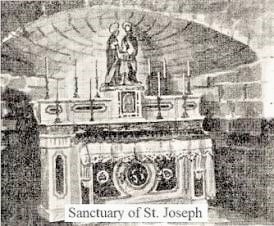
The tourist finds reasons for infinite satisfaction in this village, revelling in the contemplation and admiration of the Sanctuary of the Annunciation which houses the Grotto where St. Gabriel the Archangel appeared to the Most Blessed Virgin.
The Nourishment Church is not far away. Under the tutelage of Greek-Orthodox priests it is located over St. Joseph's house where the Sacred Family dwelt.
You can also perceive traces of the primitive Synagogue where Jesus began to preach. It is very close to the hilltop where the Galileans attempted to thrust Christ downward.
The most diverse Christian denominations converge in these Holy Sites of Nazareth: Catholics, Armenians, Orthodox, Evangelicals, etc.
The Doves and the Orphan Girl.
We picked a small bunch of flowers during the excursion and tour of the various sites of interest. Upon our return to the hotel this posy motivated the old waiter serving us some well-earned refreshments to tell us the story of Nazareth's flowers.
He started by saying, "Many years ago there lived a poor orphan girl here for whom life reserved few pleasures. Still she was very glad to dwell where Mary the Mother of Jesus had also lived.
"On her way to the fountain one day the Virgin appeared wearing a blue mantle and a pink veil over her face. From that day on the young girl saved all the money she could to purchase a blue mantle and a pink veil like those the Mother of Jesus wore. Once purchased, the girl thus bedecked headed proudly to the fountain. The pious townswomen, dressed in typical black garb, were deeply offended and resolved to stone her to death.
"Suddenly two doves appeared which grabbed both mantle and veil with their beaks and carried them off though the air, but in their flight both items tangled and tore in the thorny bushes."
The old waiter concluded, "This is the reason why the roses and the thistles have a more vivid and beautiful colour here than anywhere else in the world." Note: The roses of Nazareth are pink; the thistles blue (End of Note).
José LORENTE
These cartoons evince the influence of Marylin Monroe and Sputnik in the collective psyche of the year 1958.
According to Wikipedia the Soviet Union launched its second Sputnik on November 3, 1957. It carried a dog named Laika which died of overheating on the fourth orbit due to an air-conditioning failure.
 |
 |
 |
 |
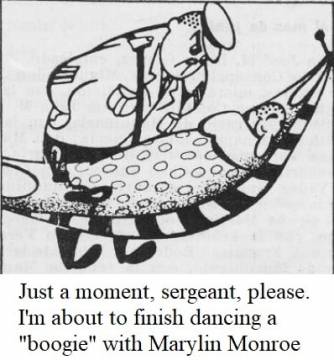 |
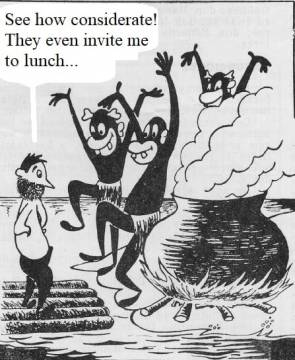 |
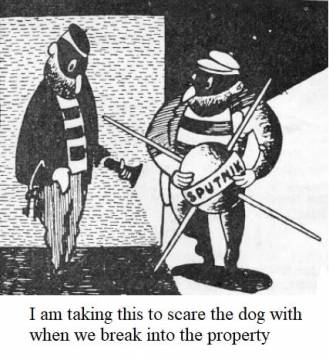 |
The source for the news in this chapter is the partial archive of the newspaper La Voz de Galicia found in the local library. Some information has been employed elsewhere (e.g. the trajectory of the shipyard's basketball team). Although other pages occasionally provide useful information I focused mainly on what by now had become the one-page section Ferrol Al Dia (Ferrol Update).
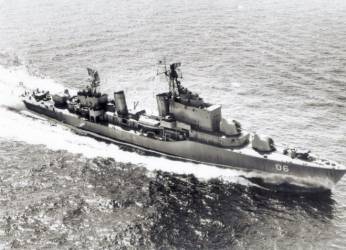
| 1. | Colombian Navy destroyer ARC 7 de Agosto entered port in mid-morning to refuel. The Colombian sailors strolled through the city. The warship departed the next day. |
| 3. |
Four men were attacked with knives in two separate incidents. Four local teams play basketball in the gymnasium of the shipyard at 5:00 and 6:00 PM. |
| 6. | Afternoon swimming contest in the cold waters of the harbour (cf. January 6, 1955). Sixteen swimmers took part, the top four finishers belonged to Bazan. The fastest time was 5 min. 2 sec. |
| 15. | Around 4:30 AM fire broke out in a 3-storey house and completely burned it down. All thirty-six tenants got out safely, but they lost their belongings. The municipal fire truck malfunctioned on site. Thanks to the fire trucks of Bazan and Navy the blaze was quenched before the flames could spread to adjacent buildings. Damage was estimated at 500,000 Pesetas. Town Hall provided alternate living quarters for the families affected. A public drive to raise funds for the dispossessed yielded 85,382 Pesetas by February 20. Note: The newspaper did not clarify whether the sum included the 30,000 Pesetas donated by Town Hall and the 16,000 Pesetas donated by the civil government (End of Note). |
| 16. | 65-year-old woman falls out of a moving tram on a curve, bumps her head hard on the pavement and died an hour later. |
| 21. | Editorial deplores the "hardly edifying spectacle offered by bunches of kids riding the top of trams." |
| 22. | Parking brakes fail, car races down the street and runs over two women, killing one. |
| 25. | Editorial renews call for the construction of a modern railway station (August 17, 1955). |
| 31. | Two basketball games on the high school grounds at 6:00 PM. |
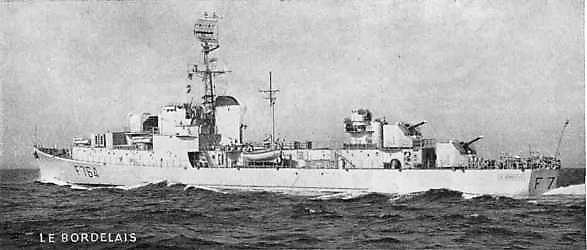
| 1. |
At 10:00 AM Basque pelota game between Instituto and Academia Rapariz at the high school. Cross-country race starting from the stadium at 10:30 AM. Juniors Distance: 3,000 meters. Juveniles: 1,000 meters. Basketball score unimaginable in the days of coach Ruzgis: Estudiantes de Vigo 49, Bazan 36. Pardo was the outstanding player. |
| 3. | Editorial informs that the natural work of the tides shrinks the artificial beach known as Copacabana (cf. May 6, 1955) and notes that children are the main beachgoers. |
| 26. |
At 5:30 PM inauguration and blessing of a new neighbourhood built by Bazan for its workers. Ongoing high school basketball championship. |
| 28. | Arrival of four French corvettes at 9:00 AM: Commandant Amyot d'Inville, Commandant de Pimodan, Le Boulonnais and Le Bordelais (above) with a total of 538 sailors and 22 officers. |

| 1. |
The French warships offered guided tours to the public between 4:30 and 6:30 PM. Friendly soccer match between a selection of local players and a team of French Marines. Final score: Locals 7, French Marines 0. "The score could have been more lopsided." |
| 2. | Series of official functions welcoming the French warships. Reception at 12:00 noon in Town Hall, a glass of Spanish wine was served. The following Spanish dignitaries were present: the captain general of the maritime department, the fleet commander, the military governor of the city, the mayor, the local leader of the fascist Movimiento Nacional and the state prosecutor. The following French dignitaries were present: the commander of the French flotilla, the consul general in Bilbao, the naval attaché of the embassy in Madrid and the consul in Ferrol. The Spanish commander of the fleet hosted a full lunch aboard the flagship Canarias in honour of the French. In reciprocity the commander of the French flotilla hosted a tea party in local navy premises. |
| 3. | The French flotilla departed at 10:00 AM. |
| 9. | Pope John XXIII publishes a papal bull which raises the rank of San Julián Church to the status of co-cathedral. |
| 10. | Some hooligans threw a park bench into the ornamental fountain of the downtown gardens yesterday evening. |
| 12. | Creation of a children's processional brotherhood for Holy Week linked to Carmen Church. Members will be six to fourteen years old. Debut is set for Palm Sunday (March 22). |
| 15. |
Power shutdown will affect the entire city this morning. It is necessary to carry out repairs in the grid. British oil tanker "Cantex-Singapore" is in dry dock for a hull cleaning. Transatlantic passenger ship Montserrat (above) docks at rival shipyard Astano for maintenance and repairs. |
| 17. | At 11:30 AM the children of primary schools and the first and second grades of secondary will present a "spiritual and material" gift to the bishop in the co-cathedral for the construction of a seminary. |
| 18. | Thousands of Ferrolians filled Town Hall square this evening to watch the singing contest known as Rondallas a las Pepitas (Serenading the Josephines). "Añoranzas de Esteiro" confronted "Trova del Alba." The jury declared a draw and the prize of 5,000 Pesetas was split. There was a parade the following day. "Añoranzas de Esteiro" visited the Destitute Seniors Home, the Anti-Tuberculosis Sanatorium, the Navy and Charity hospitals and the municipal school for orphans. |
| 21. |
The high school's Natural Sciences teacher Manuel Pérez de Arévalo (see November 1955) gave a talk entitled "The Cosmos, Stage of Life" in a guild of the city of A Coruña. The occasion was presided by the captain general.
This is an extract of his talk, The speaker began by comparing the act of creation to a work of art, like a painting or a musical composition. He stressed the importance of the viewer's frame of reference, whether from inside the atom, where there is no light, whether from the molecule, where light arrives in bursts, or from a macroscopic frame of reference. To appreciate a musical composition a "fourth dimension" is necessary: memory or time. The speaker then reviewed the geocentric cosmologies of Hipparchus and Ptolemy, superseded by the heliocentric cosmology of Copernicus, complemented by today's perception that outer space is an assembly of super galaxies. "But regardless," he said, "man as man will never be able to compass the cosmos because he will never be able to break free from three-dimensional space and own the fourth dimension of Minkowski. He will achieve it only when he dies." Arévalo then described the instruments that allow man to alter his viewing frame of reference, from the sights of a graphometer to the radio telescope, and he spotlighted the 21 centimeter [spectral line] predicted by van de Hulst. He next considered the appearance of man on Earth and evaluated the probability that there may be humans on other planets. The speaker demonstrated that said possibility is nil "based on the units of biocronio." Note: Did the reporter transcribe erroneously and the speaker in fact said, "based on the atomic structure of chromium?" (End of Note). The dissertation was followed by a Q & A session. Arévalo answered every question "with elegance and with extraordinary documentation" and garnered prolonged applause at the conclusion of the talk. |
| 24. | Sacred music concert by Bazan's choir in Teatro Jofre at 8:00 PM. |
| 25. | Town Hall bans downtown traffic from 1:00 PM until midnight on Holy Friday. Official cars and cars driven by officials are exempt. |
| 27. | "Very rainy weather" forced the cancellation of two processions, Holy Burial and Os Caladiños. |
| 28. | There are two processions today (Holy Saturday). The "Procession of Charity and Silence" sets out at 8:00 PM and keeps the tradition of carrying a treasure chest containing donations to the Hospital of Charity (the amount was 7,129 Pesetas). Note: The tradition was started in the year 1956 and in the year 2018 the amount donated was 4,421 Euros (End of Note). |
| 29. | Two-storey house collapses, the occupants were evacuated before the cave-in. |
| 31. | The number of households leasing a telephone line is eight hundred. |
| 1. |
The following letter addressed to the "Elder Brother of the Holy Hospital of Charity" together with a donation of 24 Pesetas was found inside the treasure chest carried in the Procession of Charity and Silence on March 28 (Holy Saturday).
Dear Sir, Note: Might the letter's author have been the female beggar mentioned on December 11, 1955? (End of Note). |
| 2. |
The art exhibit of Abelardo Miguel López Leira (above left) opens in Town Hall at 7:30 PM. Hooligans damage several wooden park benches in the downtown gardens. |
| 10. | The strong wind downed a tree in Angustias Gardens. |
| 11. | There will be a showing of three documentaries supplied by the U.S. Embassy in the lounges of A.F.F.A. (Aficionados Ferrolanos a la Fotografía Artística) at 8:00 PM (cf. September 7, 1955). |
| 16. | In an ongoing series of seminars hosted by the high school Enrique Lafuente Ferrari will give a conference at 8:00 PM entitled, "On the Crisis of Modern Painting." In the event Lafuente's airplane could not land at Santiago Airport due to a "rainstorm and extraordinary windstorm." The conference was given on Friday 17. The act was presided over by the captain general of the maritime department, the military governor, the deputy mayor, the local leader of the fascist Movimiento Nacional and the principal. |
| 18. | Gonzalo Torrente Ballester (above right) will deliver a talk in the high school at 7:45 PM entitled, "The Novel and Its Objectivity." This will be followed by Lafuente's second presentation, "Direction and Problems of Contemporary Art." |
| 24. | The name of my oldest brother appears in the newspaper as one of nineteen students rewarded for their grades in preparatory school. |
| 30. |
Official approval has been granted for a landfill project that will expand the shipyard grounds by 39,000 square meters. Chorale Toxos E Froles organizes a Portuguese-Galician Festival. Rendilheiras da Praça de Vila do Conde were the invited guest performers. The night was "a great success." |
| 1. | In an ongoing series of seminars held in the high school Dámaso Alonso (above) will give a seminar at 8:00 PM entitled, "Spain and Poetry." |
| 10. | International friendly basketball game: Bazan 56, Unión Española Deportiva de Valparaíso 63. The Chilean team led throughout. The game had to be played in the gymnasium because of rain, the park had been the intended venue. |
| 14. | Editorial cautions that vandalism is increasing and proposes launching an "anti-hoodlum" campaign. |
| 19. | Editorial informs that the road to Valdoviño is "an endless succession of potholes" and blames the bad quality of the asphalt. |
| 20. |
Shutoff of the city's water main is scheduled from 10:00 AM onward. Stoker non-commissioned officer dies in an accident aboard a destroyer. |
| 23. |
Inauguration of the furniture shop "Muebles El Hogar" with the blessing of a prelate. A full-page advertisement the next day boasted that the store had twenty windows and its showroom area covered 400 square meters. Traditional meal for the poor served to more than 1,000 Ferrolians on the grounds of a local garrison,
|
| 26. |
3-year-old baby seriously injured after falling off a balcony. 48-year-old man seriously injured after falling out of a tram. |
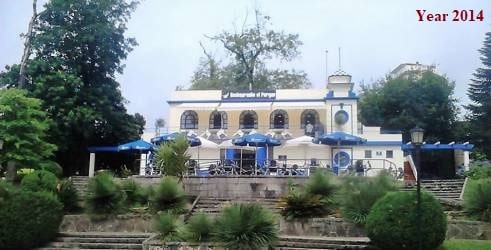
| 12. | Turkish freighter Kjrfehjr in port. |
| 20. | Inauguration of a restaurant in the municipal park (above). A ½ page advertisement a week later stated that the restaurant was open continuously from 10:00 AM to 1:00 AM and that it could be reserved for banquets, weddings and baptisms. It described the park as a "marvel." |
| 23. | Premiere of circus "Atlas" at 11:00 PM in Plaza de Sevilla. A ½ page advertisement promised "seals from the Pole, Arizona Indians, chimpanzees, motorists, Chinese troupes, wise dogs." One of its star attractions was a pair of clowns known as Hermanos Tonetti. |
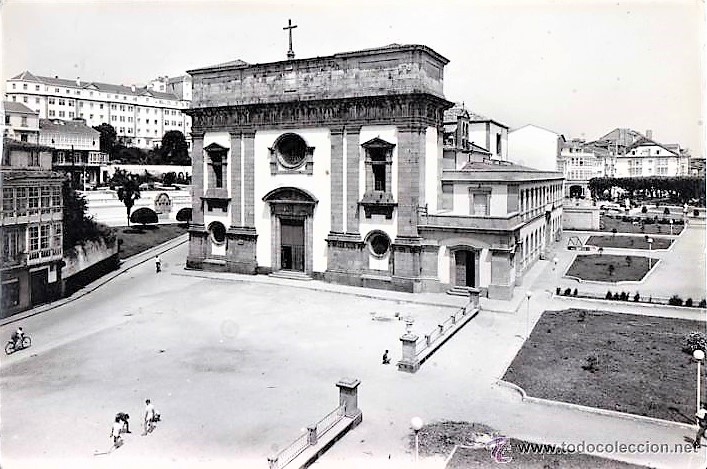
| 1. |
De Los Vieneses Circus sets up in Plaza de Sevilla. Shows at 7:30 and 11:00 PM. Passengers complain about overcrowding in the train that arrives to Ferrol at 9:30 PM. |
| 8. | Hottest day thus far. Maximum temperature: 36°C. |
| 14. | 3-year-old baby girl was run over by a motorcycle. |
| 15. |
A poem entitled "Alborada Ferrolana" (Ferrolian Morning Song) by Jesús González Lorenzo tabs Ferrol a working city that awakes to the sound of a madly blaring siren (the shipyard's). The city's "guardian angels are the dockside cranes." The winding lines of workers come on the trails riding their bicycles and "smoking their own yawns." The other characters of the dawn are "the female fishmongers, the stuttering newspaper vendor, the solitary sailor with his bayonet, the dear old lady heading to early Mass, the night watchman who returns home, the sound of a bugle." Editorial cautions that the city "still faces numerous problems" and bemoans the absence of trade colleges or of a bus station and the dismal state of the roads. Moreover the beach of Copacabana needs broadening and trees need to be planted close to beaches. Summertime charity raffle stand has been inaugurated by local dignitaries and blessed by the bishop (cf. August 3, 1955). |
| 16. | Our Lady of Carmel, patron saint of the Navy. Troops will be served extraordinary meals and there will be sporting events at the various garrisons. At 11:00 AM solemn pontifical Mass in the "military temple" of San Francisco Church (above) presided by the Minister for the Navy and officiated by the bishop. A procession followed the end of the Mass. The Minister for the Navy, the captain general of the maritime department, the military governor of the city, the mayor, the admiral, rear admirals and other top commanders took part. Other officials that joined the procession were the local leader of the fascist Movimiento Nacional, the president of the Chamber of Commerce, the chairman of the shipyard, the police commissary and various representatives of the Revenue Ministry, Civil Guard, Customs, Post and Telegraph Office and other institutions. The route of the procession was secured by two companies of naval infantry and two companies of armed sailors. These troops paraded after the procession. Night parties were held at 10:30 PM in the gardens of Navy Command Headquarters for commanders and officers, at the municipal park for non-commissioned officers and in the downtown gardens for everybody else. |
| 17. | Requiem Mass for all dead navymen in San Francisco Church at 11:00 AM. |
| 18. | A dance will be held at 9:00 PM in the premises of the Tennis Club to honour the Navy. Army personnel are encouraged to attend. |
| 19. |
Snipe class regattas start today at 6:00 PM. Open-air staging of the operetta Doña Francisquita at 11:00 PM in the park. |
| 20. |
Puppet show at 5:00 PM in the park. Operetta Bohemios at 11:00 PM. |
| 21. | Last day of operettas. Gigantes y Cabezudos and La Boda de Luís Alonso. |
| 22. | Night party at 11:00 PM in the harbour followed by "nautical fireworks" which were "a resounding success." |
| 28. | The effects of drought are becoming evident. |
| 1. | Extraordinary Portuguese-Galician Festival at 7:30 PM in the park (cf. April 30). Two Galician folk groups plus the Portuguese folk group Pescadores das Caxinas e Poça da Barca de Vila do Conde took part. The Portuguese performers were "genuinely colossal" and the thousands of Ferrolians who watched the spectacle tributed "very hearty applause." The Portuguese "also performed repeatedly in cafeterias, bars, streets and squares." |
| 5. | Ferrol will host the 17th National Basketball Tournament, premier division. |
| 6. | Fire in the hills surrounding Ferrol consumes "thousands of trees." |
| 7. |
Town Hall serves notice that until further notice the supply of water to households will be curtailed severely and will operate during these times: 7:00 to 9:30 AM, 11:00 AM to 3:00 PM and 8:00 to 11:00 PM. Fire on hill A Graña west of the city. |
| 8. | The fire to the west flares up again in mid-morning. |
| 11. |
Fire northwest of Ferrol on hill Chamorro. Stage play "Irma La Dulce" starring Nuria Torray (above) in Teatro Jofre. Two shows: 8:00 and 11:15 PM. One day only. |
| 14. |
Although San Julián Church was raised to co-cathedral status by Pope John XXIII on March 9, 1959, today is the official inauguration of the church under its new status. At 8:00 AM the bugle-and-drum bands of the artillery corps, regular infantry and Bazan paraded about the city. Every church bell rang out at 12:00 noon. Town Hall sponsored a mid-day meal for "about one hundred poor people,"
|
| 23. | Basketball final in the park: Bazan 60, Agromán de Madrid 46 (August 5). Pardo was the top scorer for Bazan. |
| 25. | Town Hall notifies the citizenry about further restrictions in the water supply. Five-hour service per day: 12:00 noon to 3:00 PM and 9:00 to 11:00 PM. |
| 26. | Further reduction of hours is necessary to ensure that water reaches the upper floors. Accordingly half the city will have running water from noon to 1:30 PM and the other half from 1:30 to 3:00 PM. |
| 27. | 11-year-old boy hanging from the backside of a tram falls off. Slightly injured. |
| 31. | Fireworks at Plaza de Amboage. The eight structures torched were: The two enchanted stars ♠ The great celestial sphere ♠ The great Egyptian windmill ♠ Pharaoh and the snakes ♠ The great Maltese Cross ♠ The two automatons ♠ The great pond of Venus ♠ The Alhambra of Granada. This last contrivance consisted of "more than six thousand flares" and two "rotating suns." "The grand finale lasted several minutes." |
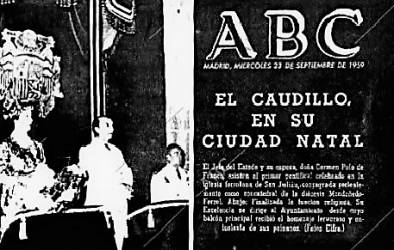
| 6. | At 4:00 PM swimming race across the bay. Distance: 2,400 meters. Nearly fifty swimmers took part, among them five Corunnese women. Multiple starts, the female swimmers went first. Women's best finish: 29 min. 45 sec. Men's best finish: 20 min. 25 sec. |
| 10. | Heavy shower at 4:45 PM. |
| 11. | Rain. "We believe the onset of the rain was never as desired as on this occasion." |
| 20. |
General Franco visits Ferrol and attends a pontifical Mass at the co-cathedral of San Julián.
Voice-Over Translated: Head of state Generalissimo Franco goes in El Ferrol del Caudillo to the first pontifical mass celebrated in San Julián Church which was months ago consecrated co-cathedral of the diocese Mondoñedo-Ferrol. Together with his wife, Doña Carmen Polo de Franco, he enters the temple under canopy. Dr. Argaya Goicoechea the prelate who officiates the solemn mass assisted by canons delivers a brilliant homily. Pontifical mass over, Franco leaves the temple amid demonstrative displays of affection and cordiality. From the balcony of Town Hall and before the crowd that fills Plaza de Armas he addresses the Ferrolians and affirms in his speech that our industrial and agricultural production has grown by 1,500 million dollars, which permits tackling the problem of the balance of international payments and of the stability of the currency satisfactorily. |
| 27. | Town Hall serves notice that the effects of the drought persist. Water will be shut off between 4:00 and 8:00 PM and from 11:30 PM to 8:00 AM overnight. |
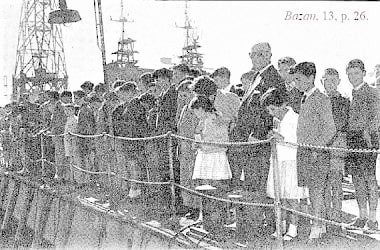
| 7. | Town Hall advises that the acute water shortage continues. Water will run only four hours a day, between 11:00 AM and 3:00 PM. |
| 11. | More than 4,000 Ferrolians went to Lugo to take part in the celebration of San Froilán the patron saint of that city. Town Hall, Chamber of Commerce, School of Commercial Agents, local press and Radio Ferrol led a caravan of 43 buses, 122 cars and 507 motorcycles. "The line of vehicles was more than six kilometers long." Lugo's Town Hall welcomed Ferrol's in gala uniforms and "a glass of Spanish wine was served." The cavalcade was welcomed with gunpowder shells, cheers and applause. Ferrol's mayor stated that the official visit "defined the intimate union between the cities." |
| 14. |
Forty students from a rural school arrived in Ferrol at 11:00 AM accompanied by their teacher and some relatives. The trip was sponsored by "Ferrolian schoolchildren who prefer to remain anonymous and who heard the visitors express the desire to visit Ferrol over a Madrid radio broadcast." Official reception in Town Hall. Programmed visits to Radio Ferrol and to the shipyard. Lunch in the park where they received gifts from local businesses. Afternoon cruise around the bay. They returned home in the early evening.
The photograph to the left shows the schoolchildren crowding indoors around a huge table on which a model layout of the entire arsenal lies spread out. Incidentally this drawing on p. 27 of Bazan, 13, illustrates a cruel school punishment in vogue those days. |
| 18. | Soccer match between eternal rivals Ferrol and A Coruña. Final score: Ferrol 2, Deportivo 5. |
| 25. | Yearly levy in benefit of the fascist Youth Front (cf. September 10, 1955). Compulsory for the general public, owners of cafeterias, bars, restaurants, pubs, movie houses, theaters, dance halls and any premises where a public spectacle is offered. |
| 27. | Editorial headline: "The rains have arrived." |
| 29. | Editorial again takes up the subject of children hanging from the backside of trams (January 21). |
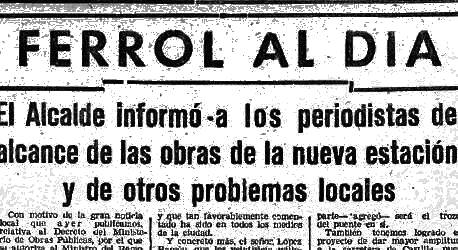
| 9. | Official state approval granted for the construction of a new railway station (above). The initial budget is 28,000,000 Pesetas. |
| 11. | Heavy rain. |
| 13. | Movie and seminar on the Islamic woman at Discípulas de Jesús School at 9:00 PM. "All young women are invited." |
| 24. | Official state approval granted for the holding of an annual industrial exhibition fair. Projected premiere: July 10-30, 1962. |
| 28. | Local basketball tournament involves sixteen juvenile teams. All games are to be played in the gymnasium. Games start at 3:30 PM this afternoon and continue tomorrow from 9:30 AM. |
| 30. | Powerful gale causes "a lot of damage." "Hundreds of roof tiles and window panes fell to the streets...there was considerable damage in parks and gardens...a cedar was uprooted in Plaza de Amboage...power outages were very frequent throughout the day...tram, electrical power and telephone service was curtailed...there were delays in road and railway traffic." |
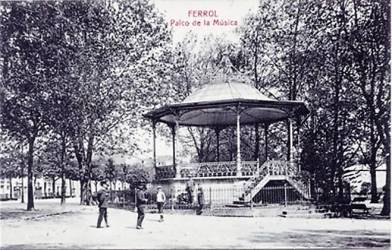
| 3. | Public lighting is still out in some places. |
| 4. | Note criticizes the long-term closure of the public washrooms beneath the gazebo of the downtown gardens (above). |
| 7. | Turkish cargo ship Kihirsehir in harbour for repairs. |
| 10. | British freighter "Liverpool" in harbour for repairs. |
| 12. | Local police find an abandoned batch of cod in the street. |
| 17. | The musical associations of Bazan put on a Christmas charity show at Teatro Jofre. Full house. "The concert was an apotheosis of success." Three pieces sung were: Asturian lullaby No Llores, Né ♥ Galician farewell Un Adiós a Mariquiña ♥ Sephardic love song Durme, Durme. |
| 23. |
76-year-old woman tried to commit suicide in the harbour but was thwarted by dockside workers. Heavy rain causes flooding and landslides in outlying areas. "Veritable torrents of rain fell around 3:08 AM." |
| 27. | The heavy rains continue. |
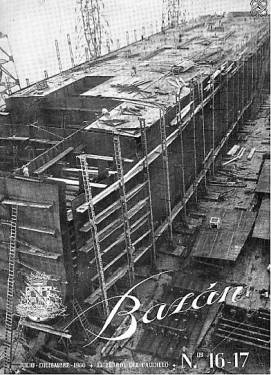
The source for the news in this chapter has already been discussed in the chapter entitled, "Bazan Magazine for the Year 1956."
The notable event of 1960 came early in the year. At 12:45 PM on January 14, 1960, the shipyard delivered the "modernized" frigate "Legazpi" to the Spanish Navy. The bare hull of the frigate had been launched in 1945 with the rank of gunboat. It was not delivered to the Navy until the year 1951.
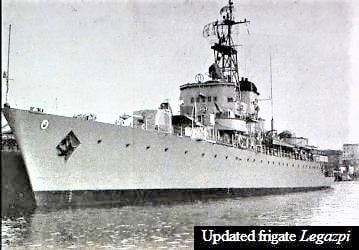
On September 26, 1953, Spain and the U.S.A. signed a series of agreements known as the Pact of Madrid which bound the American side to help with the modernization of the Spanish Armed Forces. Mª del Rocío Piñeiro Álvarez explains in her article, "Los Convenios Hispano-Norteamericanos de 1953," published in Historia Actual Online, 11, pages 175-181, year 2006 (PDF) that the pact had a duration of ten years split in two installments. The economic aid received during the first five-year period boosted the supply of food and raw materials to an impoverished Spanish populace, but overall American aid was sparse until the start of the second installment in 1958. The main thrust of the Pact of Madrid was the establishment of American military bases in Spain.
According to this webpage it was not until the start of the second installment that Bazan-Ferrol began refitting two gunboats, "Legazpi" and "Vicente Yañez Pinzón." Their hull remained intact but the bridge was reconstructed and new hardware added, most notably sonar, aerial radar, marine radar, gunfire-control radar, wireless telegraphy and identification transponder. Still the military effectiveness of these modernized vessels was limited by their slow speed relative to the speed of potential enemy submarines. On the plus side the updated frigates turned out to be an "excellent platform" for training and the "Legazpi" took part in several joint Spanish-French naval exercises. The frigate was decommissioned in the year 1978.
On March 25, 1960, sister frigate "Vicente Yañez Pinzón" was delivered and on September 7 the third modernized warship, the destroyer "Furor".
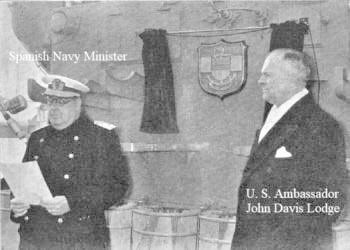
U.S. Ambassador John Davis Lodge (b. 1903, d. 1985) presided the delivery of "Legazpi" on January 14. He was accompanied by the Spanish Minister for the Navy, by the captain general of the Maritime Department, by U.S. Major-General Stanley Joseph Donovan (b. 1910, d. 2001) chief of the Joint U.S. Military Affairs Group, by the captain general of the Eighth Military Region, three rear admirals, the military governor, a brigadier-general, the civil governor, the bishop of the Mondoñedo-Ferrol diocese, Ferrol's mayor, the director and two chief executive officers of Bazan-Ferrol and "numerous" commissions from the Spanish Navy and from Bazan-Ferrol.
Ambassador Lodge delivered a brief speech and unveiled a commemorative plaque. This was followed by an "important speech" from the Spanish Minister for the Navy. Both "illustrious" speakers were roundly applauded and their words evinced once more the "sincere and loyal friendship" existing between the countries.
Following the act the Spanish Minister for the Navy offered an official meal at Navy Command Headquarters to the American ambassador and other top officials.
The following clip records the launching ceremony. The full newsreel, ten minutes long, was first shown on Monday January 25, 1960.
Voice-Over Translated: Delivery of the frigate "Legazpi" to the Spanish Navy takes place in El Ferrol del Caudillo, and Admiral Abárzuza the Minister of the Navy reviews the company of the Northern Third Corps that renders him honours. U.S. Ambassador Mr. Lodge attends the act and the ceremony unfolds at the loading dock of the arsenal. The frigate is modernized according to the plan agreed between North America and Spain. Officials and sailors go aboard to take up their posts. The national flag is hoisted first and afterward the ensign of the Minister of the Navy. Mr. Lodge expresses his satisfaction at participating in this ceremony and afterward unveils a commemorative plaque. The Navy Minister says that this delivery represents the end of the inaugural cycle of modernization and the beginning of a new era for our Navy.
On January 15, the day after "Legazpi" was delivered, the oil tanker "Ribagorzana" was launched. It belonged to the same Series "T" as the "Valmaseda" and it was delivered to "Empresa Nacional Elcano" on August 11.
On May 13 the freighter "Tintoré" was launched. It was destined for the cargo line, "Catalana Marítima, S.A."
The vessel was "almost entirely" welded together (i.e., nearly ousting the use of rivets altogether).
The two photographs are courtesy of Xan Ramírez Gómez.
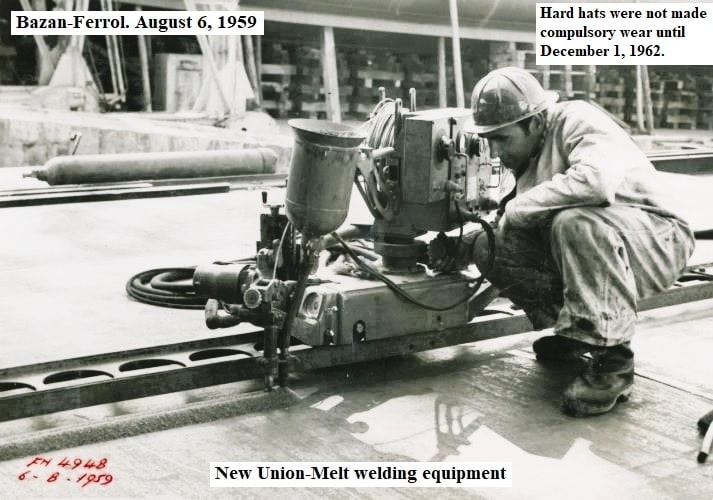
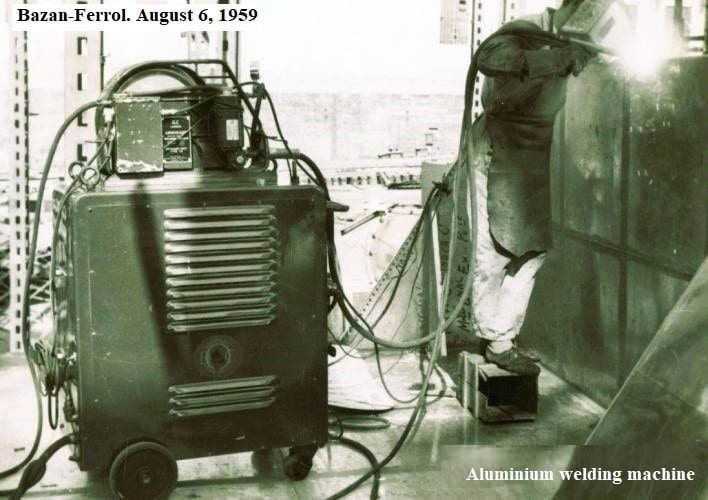
The greatest attention of the shipyard during the year 1960 was focused on the construction of the oil tanker "Bilbao" (see the photograph heading this chapter).
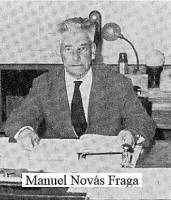
1. Manuel Novás Fraga started in 1916 as an outstanding apprentice of Stocks when he was nineteen years old. He had a "fast and brilliant career" in slightly more than fifteen years: foreman, master second class, master first class and technical assistant in the Works department. He was sixty-three years old when this interview took place.
"You are a Ferrolian, right?" "Yes." "Which one of the many projects that you intervened in left you with the fondest memory?" "The launch in 1944 of the first four "Pizarro" class gunboats which was brought about in record time and which came out perfect. This in spite of the fact that, as a consequence of the world war, we were forced to make use of tallows and greases of very bad quality." "What are the main requirements for good stocks?" "That its bed be solid, to count on good crane service and that it have, if possible, adequate facilities for efficient, quick and smooth prefabrication. Our current stocks, which is magnificent, meet those and even other requirements. Perhaps I would annex a storehouse for the blocks, outriggers and transverse cradle beams in disuse." "Let us now, with your licence, pass to talk about man: who is the ideal worker, in your view?" "The one with the highest sense of responsibility on the job." "And what is the best way to order about?" "One based on the producer's psychology, constantly seeing first the man and second the partner in the task at hand." "What quality do you miss most in today's worker which the older ones had? And which least in the worker of back then relative to today's?" "I miss in today's worker the desire of the older worker to beat nobly the product quality of the best mates in the workshop. I do not fail to appreciate notwithstanding that the modern worker has a much more fine-tuned professional instruction."
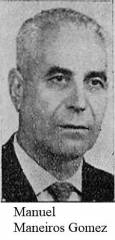
2. Manuel Maneiros Gomez was born in Ferrol in 1894 and he joined the Factory in 1917 as a member of the Stocks Carpentry shop.
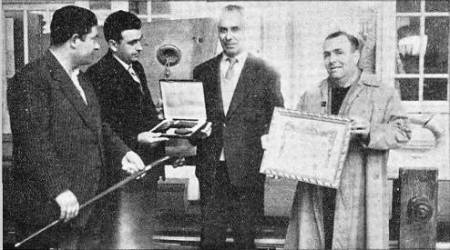
Thirteen years later he was sent to the Hall of Scrive Boards temporarily to design the hawseholes of the cruisers Canarias (decommissioned in 1975) and "Baleares" (sunk in 1938) but the transfer became permanent.
The following interview took place on March 31, 1960, the day of his retirement, right after co-workers had presented him with a gift and a framed diploma.
"You were a good carpenter of scrive boards. Would you have liked to make a living with some other profession?" "No. I am very glad to have been what I was." "Point to us one of your favorite hobbies." "Music." "Another one." "To travel, but it's so expensive!" "Do you retire gladly?" "Well, in fact, yes. However it grieves me, and I must declare it so, that retirees get paid so little, notwithstanding which I do not forget that they were paid even less aforetime." "Would you like to tell us your opinion of the Hall?" "Scrive Boards is a very tidy workshop, very well lit, very welcoming, although extremely cold in winter. Its personnel is first-rate, a good example of their kindness is this farewell homage. Will I be grateful enough to my workmates for this most honourable distinction?" "Do you know what your workmates told us? That they are very sorry to not be able to give you the farewell you deserve, that today's act is but a small token of affection and a minimum proof of how much you are cherished." "It's a great workshop. This Scrive Boards is a good shop," repeats Mr. Maneiros very moved.
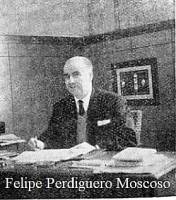
3. Felipe Perdiguero Moscoso joined the Factory in 1941 as the official in charge of the Company Store. Note: In 1941 the name of the Ferrolian shipyard was "Constructora Naval," a name that stuck long after Bazan-Ferrol was constituted in the year 1947 (End of Note). The following interview is found in Bazan, 14, pages 20-21.
"How many people benefit from the Company Store?" "Approximately 32,500. But not everyone makes a constant or identical use of their rights as a beneficiary. The following percentages speak volumes: cooking oil, sugar and soap are picked up by 98% of the beneficiaries; rice by 60%; potatoes and chickpeas by 45% and the beans and lentils by only 40%." "As Company Store manager and an expert in how it works, would you like to pass on some important advice to the beneficiaries?" "Yes, with great pleasure. It is extremely important that upon collecting their purchases from the counter they should double-check the number of parcels or bundles that corresponds to each one. It is the only way to avert that they leave behind, forgotten, some articles of their own or that, on the contrary, they carry off others that belong to the beneficiary standing beside them on the counter. Here I wish to make a norm of the Company Store public, which is to reward the honest gesture of whoever returns one or more parcels carried off by mistake with the total of the returned merchandise." "Tell me, Mr. Perdiguero, how many persons, in some sort of record-beating trial, do you reckon could be tended to in one hour?" "So that you may have a very approximate notion, I will tell you that in more than one occasion, due to circumstances which are not germane, we managed to serve close to four hundred and fifty persons in just one hour." "A final question. What has been the biggest delivery of goods in the Company Store and the most useful to the beneficiaries?" "In the year 1949, amid a great shortage of potatoes in this locality, a supply of this product was effected from Holland, of the best grade and which amounted to 400,000 kilograms that were distributed among the beneficiaries in a short period of time under a system of rationing."
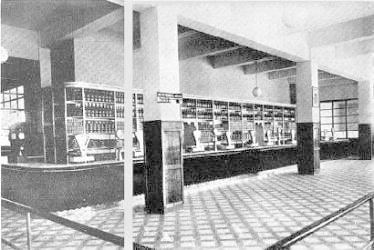
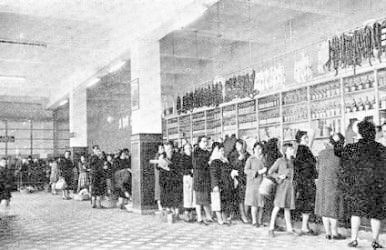
Franco's government decreed the compulsory creation of company stores in January 1941 to ensure that the workers of industrial centers had a minimum supply of food and staples. Note: The decree was published officially on January 30, 1941. It ordered the following enterprises to establish and fund company stores: all coal mines, the mining companies of seven provinces, all railways, contractors of public works, ironworks with a payroll of fifty or more employees, the cement industry, textile industries operating in provincial capitals or in population centers bigger than 20,000 inhabitants. Its second article made the director of an enterprise personally responsible for the correct functioning of the company store. Rationing and prices were set by the government. The decree's opening paragraph acknowledged "the difficulties of the moment in procuring a normal supply of consumer goods" (End of Note). Since the Ferrolian shipyard was under martial law at the time so too was the Company Store. This was a propitious circumstance for it expedited the store's access to sources of food through the administrative channels of the Navy.
The first bureaucratic necessity was to conduct a census of the entire personnel of the Factory, families included. The census yielded a total of more than 25,000 beneficiaries spread across 6,000 families.
In April 1941 the Company Store started off in cramped premises. Long lines of beneficiaries waiting to enter formed outside. Just two staples were offered: ½ litre of cooking oil per person per month; ½ kilogram of rice per person per month. Gradually the offer expanded to the official rationing quotas, namely, 1 litre of cooking oil per person per month; ½ kilogram of rice per person per month; ½ kilogram of sugar per person per month; ½ kilogram of dried legumes per person per month; 5 kilograms of potatoes per person per month; 400 grams of soap per person per month.
Cooking oil was stored in four big tanks installed in separate premises some distance away. More than 25,000 litres were dispensed monthly. The four tanks could hold 150 metric tonnes overall. Note: This is probably an error, it implies a holding capacity of 150,000 litres of cooking oil, half a year's supply! There is good reason to suppose that the true figure hovered around 400 litres per tank (End of Note).
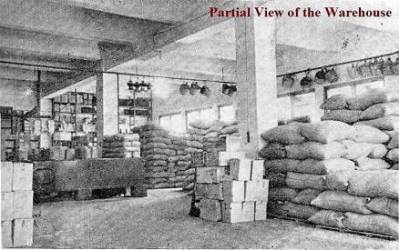
In August 1948 the Company Store moved to a new building ample enough to host all previous transactions in one place. The patron saint assigned to the new facility was St. Joseph (the Worker).
The beneficiaries of Bazan-Ferrol walked up a short ramp (the street has quite a steep gradient) and entered a spacious chamber of 24 meters long × 6.8 meters wide. The warehouse (photograph to the right) lay behind the public chamber and was big enough to accommodate trucks.
The Spanish government freed up the sale of dried legumes in 1950 and of sugar in early 1952. Finally on April 1, 1952, the rationing system was officially ended. Nevertheless the establishment kept offering goods at discount prices. The limitations on the sale of "basic staples" pertaining to the period of rationing were preserved, and the sale of all other items was monitored closely to forestall hoarding.
In 1958 the Ministry of Labour ordered company stores to broaden their sales to include shoes, clothes and fabrics. Note: The decree was published officially on May 17, 1958. Its twentieth article ordered company stores to supply at minimum these "basic" items: cooking oil, soap, sugar, rice, bacon, flour, beans, lentils, chickpeas, potatoes, ham and sausages, canned food of all kinds, eggs, coffee and substitutes, condensed milk, cheese, butter, chocolates, common table wines, dried fish, canned fish, pasta for soups, biscuits, macaroni and suchlike, coal for domestic use (i.e. for cooking and heating), clothes and work shoes, casual footwear and fabrics. The first and twenty-third articles of the decree stressed that consumer goods were to be sold at cost value, without a profit margin. This decree abrogated the statutes of January 30, 1941, and April 6, 1946 (End of Note).
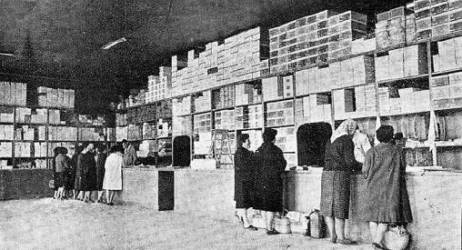
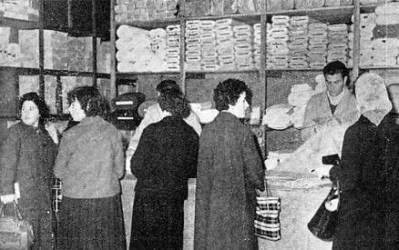
Accordingly Bazan-Ferrol rented the upper floor of the building and set up counters for Shoes and Textiles. These new sections opened in September 1958.
Bazan, 14, states that 30,956 pairs of shoes, 82,245 items of clothing, 75,043 meters of fabric and 1,093 umbrellas were sold upstairs during the year 1959.
The magazine adds that more than 1,500 persons frequented the establishment daily.
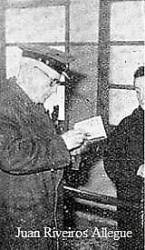
1. A beneficiary presented her passbook to the security guard at the door (photograph to the left). Note: "Her passbook": Salesclerks and other figures of authority were always men in those days and the customers women (End of Note).
The guard checked it and returned it.
According to page 24 of Bazan, 14, the security guard at this time was an elderly man named Juan Riveiros Allegue. He had been born in the hamlet of Doroña (min. 2:16-2:34 of this video) and had joined the Factory in 1947.
The magazine states that he was "a pleasant man" who loved to read and whose conversation entertained. He had spent eleven years in the Republic of Cuba and knew an "infinite number of things" about the country. He had also lived for "some time" in the United States where "he was able to practice the English language a little bit, which today he speaks with considerable ease."

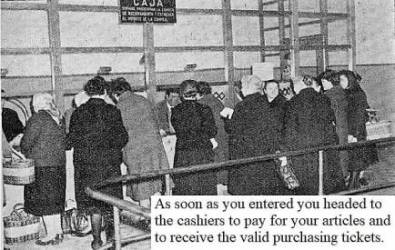
2. Once allowed inside, the beneficiary went first to one of the five window tellers (photographs on the right).
There she paid the full amount of her purchase(s) and the teller gave her the appropriate coupon(s).
3. Coupon(s) in hand, the beneficiary now went to the counter to pick up the articles she had paid for.
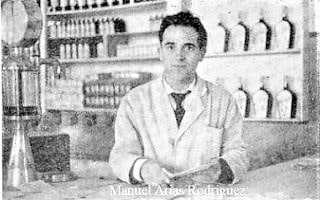
According to page 24 of Bazan, 14, Manuel Arias Rodriguez, a clerk at the food and drink counter downstairs, became "famous" first for having been an outstanding soccer player between the years 1945-1948 with teams "Canido" (a neighbourhood of Ferrol) and "Arsenal" (sponsored by Bazan-Ferrol) and second for being a very fast sorter of coupons, capable of collating 1,500 randomly packed ones into six homogeneous heaps in a record time of 42 minutes, an ability that earned him the nickname of "human machine." He was at this time in the Bookkeeping Office assigned with the task of checking whether the net worth of the merchandise transacted over the course of a business day matched the amount of cash collected by the tellers.
It is interesting to note that the seven bottles with distinctive shape visible on the shelves directly behind the clerk are sold today as memorabilia.
4. If one or more articles had run out, the beneficiary notified the Claims Desk. Careful note was taken and assurance given that the out-of-stock article(s) would be held in reserve for her after the next truck delivery.
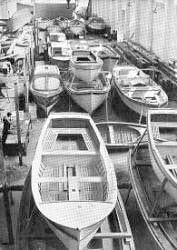
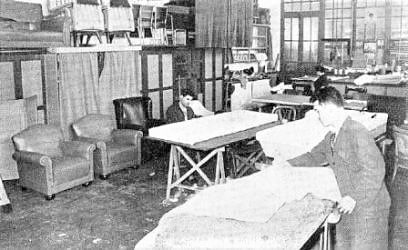
Bazan-Ferrol had a workshop for the construction of watercrafts: robust workboats, gondolas, whaleboats, dinghies, sculls and recreational boats. This workshop, 80 meters long, was equipped with bandsaws, circular saws, drum sanders, a lathe, multi-use universal woodworking machines, etc. A 10-ton mobile crane moved matériel about.
A few meters away stood the Repair/Maintenance shop. It was smaller, had two 4.5-ton mobile cranes and a loading ramp with a flatcar roped to an electric drum winch. The flatcar was the means to beach or launch the boats.
The two workshops shared a staff of thirty men.
The Cabinet Making Workshop made all the furnishings of ships or company offices. It was divided into three sections: Fine Woodworking, Upholstery and Varnishing. The first section was equipped with many individual workbenches, bandsaws, scroll saws, mortisers, drills, tenoners, wood moulders, sanders, lathes, gluing presses, etc. The second section had sewing machines, ironing tables, fabric cutting tables, etc. The three sections were staffed by fifty officials, some of them women, everyone perfectly trained for the job.
There is additionally in these workshops that indescribable, arresting scent of the most diverse timberland. A little, one might say, like the presence of faraway forests within the white walls.And visiting these workshops is so pleasant!
(F. Vila. "Two Aspects of Working with Wood: Watercrafts And Furnishings." Bazan, 15, pages 11-13)
And now we know the ultimate destination of the timber from Equatorial Guinea! (September 12, 1954).
Juan Manuel Castro, featured in ARTS AND LETTERS of the year 1957, also composed poems in the Spanish language. This one comes from page 34 of Bazan, 14.
|
Into the half-light of my room
The brain objects to this intrusion,
Let it rain, let it rain,And Round and round the wheel
The echoes resound leaping over the balcony
Damned deafness! It does not let me hear!
Not even a housefly do I hear in my room. |
Note: The four italicized lines (2.8-9, 2.11-12) are the opening lines of two popular nursery rhymes (first one, second).
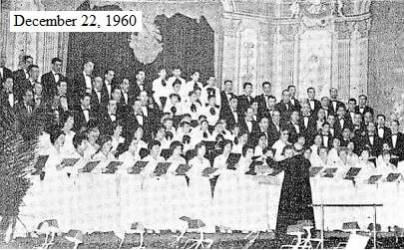
On Thursday December 22, 1960, Teatro Jofre hosted the traditional fundraising concert for the mutual fund that assisted 120 needy and sick Bazan workers financially. Reverend Fanego the chaplain of Bazan managed the fund. All the musical groups of Bazan took part in the concert. The event was sold out and the proceeds ran to 15,685 Pesetas.
This festival had first been held in the year 1951 and repeated every Christmas season thenceforth. Isaac Fraga Penedo (1888-1982) the owner of Teatro Jofre ceded the hall at no charge year after year.
The mutual fund at this time succored a total of a hundred and twenty workers divided into three groups: (i) eight classified as "chronically disabled" who received from the government a monthly pension of from 192 to 300 Pesetas, (ii) twenty-six on sick leave lasting longer than five years whose monthly pension varied from 167 to 500 Pesetas, and (iii) eighty-six on sick leave lasting less than five years whose monthly pension ranged from 192 to 1,250 Pesetas. Note: According to this webpage a television set cost around 6,000 Pesetas in 1960 (End of Note).
The concert was a resounding success, the public's response enthusiastic. The Bazan performers had to concede three encores: Bolzoni's Minuetto, the Portuguese carol, Natal, and Rossini's Tarantella.
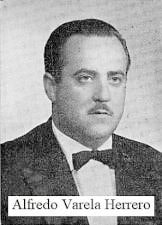
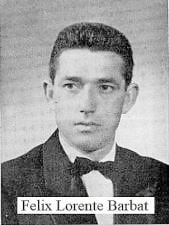
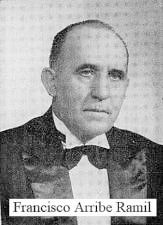
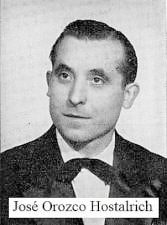
The above photographs come from pages 26-27 of Bazan, 15.
Alfredo Varela Herrero. Baritone. Born in Ferrol. He joined the Factory as an apprentice accountant and was at this time an official first class in the Accounts Receivable Department. He joined the musical groups of Bazan-Ferrol in 1941, year of their foundation, and was an outstanding figure from the start. Together with Lorente (second from the left) and Orozco (fourth from the left) he created an independent musical group called, "Amigos de la Zarzuela," (Friends of the Spanish Operetta) which broadcast "select fragments" of the genre over Radio Ferrol for "many weeks." Note: I first heard the notes of Glenn Miller's Moonlight Serenade as a small child listening to the opening music of Radio Ferrol's late-night program (End of Note).
Felix Lorente Barbat. Bass. Born in Portugalete (Basque country). The magazine does not disclose his profession. He joined the Polyphonic Chorale in 1950, one year after he arrived to Ferrol. In the year 1954 baritone Antón Navarro (1926-1999) brought his travelling lyric theater to Ferrol. He was so impressed with Lorente that he invited the Ferrolian to perform in the operetta, Marina.
Francisco Arribe Ramil. Lyrical Tenor. Born in Ferrol. He was at this time a painter in the Electricity Workshop. In his youth he sang in the "Toxos E Froles" (Gorses And Flowers) folk choir. He joined the Polyphonic Chorale in 1941. He was a great fan of zarzuela and opera.
José Orozco Hostalrich. Dramatic Tenor. Born in Denia (Alicante). He joined the Polyphonic Chorale in 1950. The magazine does not disclose his profession. He was the father of two "beautiful girls" and a "very intelligent" boy whom he expected—tongue in cheek—to become one day as famous a tenor as Mario del Mónaco (1915-1982).
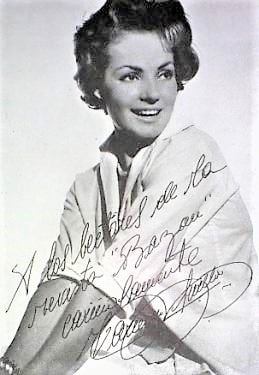
The above photograph comes from page 32 of Bazan, 14. The dedication on the photograph reads: "To the readers of 'Bazan' magazine with fondness. Carmen Sevilla."
The magazine's caption states,
BAZAN Magazine in the name of its numerous readers thanks Carmen Sevilla a lot for her spontaneous mailing and for her kind dedication on this her impressive and so "eloquent" portrait.We avail ourselves of this pleasant opportunity to reaffirm ourselves as the most loyal fans of her art and matchless beauty.
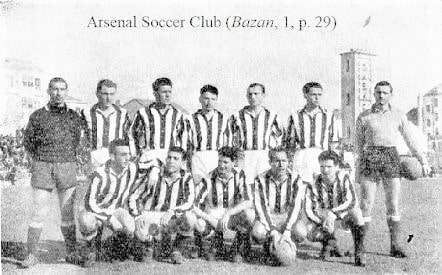
Alberto Permuy Martinez entitles his article, "A Great Campaign by Club Arsenal" (Bazan, 14, p. 26). Throughout the 1957-58 Third Division league Arsenal fluctuated between the eighth and fourteenth places in the classification table and finished tenth. During the 1958-59 league Arsenal rose in the standings and finished seventh. In the current 1959-60 season Arsenal "has always been battling in the top five spots of the table except once when it was sixth." Permuy ascribes the team's steady improvement to management's strategy of recruiting local talent from grassroots clubs.
Perhaps the most inexpensive team in Spain and definitely so in their league, Arsenal, composed of amateur players who hardly earn more than a modest gratuity, defeats other teams whose professionalism, extravagant in the Third Division, did not spare them a negative result. Arsenal's performance can not have been more brilliant defending with enthusiasm, zest and total commitment the team colours and the Company where they work.
At the time Arsenal was fighting for second place and a corresponding berth in the playoffs for promotion to the Second Division.
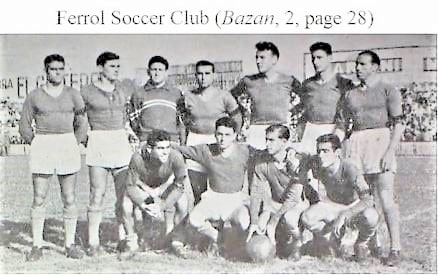
In Bazan, 15, p. 29, Permuy lamented the automatic descent of professional Ferrol Soccer Club to Third Division at the close of the same 1959-60 season (April 17, 1960). He blamed the coach and the lack of physical training and morale for the "catastrophe." The 1960-61 season saw Arsenal and Ferrol compete in the same division of the Spanish Soccer League.
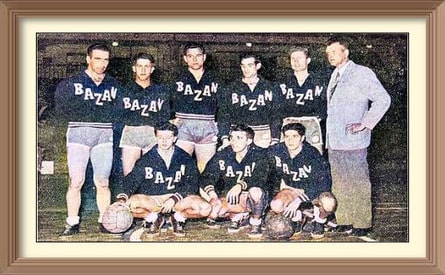
On page 29 of Bazan, 16-17, the reporter and Reverend Fanego bemoaned the "alarming plunge" in attendance to basketball games, which in turn impacted the revenue of the mutual fund set up to assist needy workers and their families. Concerts since 1951 and sports since 1955 were the main sources of income. Regarding soccer, Arsenal's charity matches returned 181,039 Pesetas between the years 1955 and 1960 inclusive.
In regard to basketball, the chaplain recalled the "magnificent attendance and revenue" garnered by "that unforgettable match, Bazan versus Selección Nacional." Note: It was played in February 1954. The match started at 7:30 PM and the final score was 69-57 (End of Note). "Everybody is aware of the alarming plunge suffered by our basketball in the last few years," said Fanego. The income from charity basketball declined steadily: 17,400 Pesetas in 1958. 8,921 Pesetas in 1960. "But now the outlook is truly bleak." Fanego pointed to the "heartwarming" 3-team Christmas tourney where not even the participation of the "Old Glories" aroused fan interest. The tourney returned 2,883 Pesetas only.
"Very lamentable," the Bazan reporter concurred. "Let's trust the good old basketball days of the Company will return for everyone's benefit."
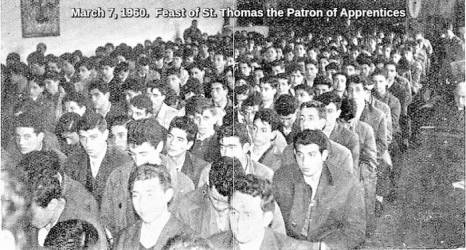
On March 7, 1960, the dockyard celebrated the religious feast of St. Thomas Aquinas (biography).
The morning Mass was officiated by Reverend Fanego in the Chapel of the Christian Schools of the Factory. It was presided over by the Sub-Inspector of Schools, the Inspector and Head of Phys Ed, two other inspectors, another sub-inspector, instructors and monitors. The pupils of "all courses" attended. In his homily the chaplain exalted St. Thomas Aquinas and proposed him as a role model for Bazan's apprentices: "assiduous dedication to study, the love of work, the greatest regard for the Christian virtues and especially for the angelical virtue of purity." The article written by "Khronik MELOS" (Bazan, 14, pages 22-23) states that Fanego proposed that "science and virtue must be the two wings with which our young men rise above the muddy fields of modern life."
The Mass was followed by "several athletic trials and hard fought basketball games" at the gym. An "artistic/musical" contest among some apprentices and watched by all was held in the afternoon also at the gym.
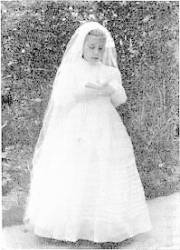
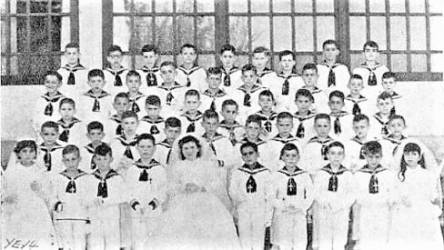
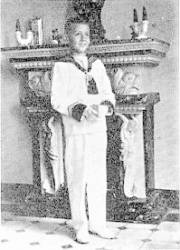
Reverend Fanego officiated the Communal Mass in the Chapel of the Christian Schools of the Factory. All four hundred pupils took part in "the religious and emotive act impregnated of angelical candor and innocence" (Bazan, 15, p, 24). Following the early morning Mass those children who had done their first communion were escorted to the gym and offered a "traditional, splendid breakfast" courtesy of Factory Management. Note: The traditional First Communion breakfast was hot chocolate with fried dough sticks (End of Note). At breakfast's close the children were presented with a "precious" souvenir diploma and a pouch of chocolates.
All the boys shown above wear a traditional sailor outfit which I too wore at my First Communion. However a few children wore commander uniforms similar to this one. Unbeknownst to me then, the differing uniforms were a childhood demonstration of Marxist class theory.
A child's reaction to the dogma of transubstantiation, a term coined by St. Thomas Aquinas, can only be revulsion. Of course the suggestion of eating the actual body of Christ lost potency in catechism class when we did "practice runs" using unconsecrated communion hosts that tasted like cones of ice cream. And of course the "blood of Christ" turned out to be specially bottled wine which priests alone were supposed to drink and which some altar boy occasionally helped himself to when the priest's back was turned.
I wager few boys and men believed the dogma of transubstantiation because a "blasphemy" often heard in Ferrol and elsewhere was, "Te voy a dar una hostia" (lit. I'm going to give you a host, fig. I'm going to punch you).
I read this story in a religious booklet called, "El Mensajero," whose subscription, I believe, was monthly. The booklet carried short stories written for children. I remember two—and vividly their illustrations—but only one is germane.
Somewhere in Africa, ran the story, missionaries had erected a makeshift church in a small village. A hostile tribe came to attack the village and the missionaries fled for their lives. A young African boy ran to the deserted church, retrieved the chalice with consecrated hosts from the tabernacle and climbed on the roof to escape the turmoil. The raiders shot darts at the boy and set fire to the church. He perished covering the chalice with his body.
The illustration showed an African boy protecting the chalice on a roof of straw. His white shirt had bloodstains and flames licked the straw.
I suppose the story was intended to instill a spirit of martyrdom in children, but the effect was mixed, for how could missionaries who said transubstantiation was true flee without the consecrated hosts?

From Thursday October 27 to Sunday November 6, 1960, the Roman Catholic Church launched a mission to re-evangelize Ferrol city and county. The religious drive lasted eleven days and touched all administrative centers: military, educational, industrial, etc. Besides them the normal outreach nuclei swelled in "extraordinary profusion" during those days. An extraordinary cross 92 meters high was lit at night on the heights of Canido (above photograph, top left-hand corner) for the duration of the Great Mission.
The Factory hosted three days of "religious conferences" chaired by a prelate from Asturias and another from the Basque Country. "The entire personnel listened with magnificent attention and interest to the ardent discourse of these missionaries." The conversion effort reached also those Bazan workers posted at A Graña and Caranza.
Bazan's involvement was not a surprise to anyone. Bazan, 5, p. 13, already served notice that the Factory had a policy of staging similar missions in-house every year (1950 photograph).
The Asturian prelate finished his assignment emplacing the "Most Blessed Sacrament" to public exposure in the gymnasium during a "Holy Hour." At the end of the sixty minutes the "Most Reverend Bishop" lifted the sacrament (i.e. a chalice filled with consecrated hosts) and blessed the audience with it. The "fervour and religiosity" of the auditorium was "truly impressive."
Similar "extraordinary piety, order and discreetness" pervaded the Communion Mass for apprentices officiated in the Study Room of the Schools conveniently converted to "a makeshift and spacious Chapel." Although attendance here was apparently voluntary, "almost the whole body of apprentices approached the Sacred Table."
The identity of José Lorente is discussed at length in the "JOSÉ LORENTE REPORTS FROM ISRAEL" section found in Chapter 10, "Bazan Magazine for the Year 1958."
Lorente's next report was from Egypt and was published in Bazan, 11, April-June 1959. This photograph shows Lorente, his wife, a guide and three helpers in Egypt with the Great Pyramid of Giza in the background.
On pages 28-29 of Bazan, 14, January-March 1960, Lorente interviewed Archbishop Makarios III who a few days prior had been elected the first President of Cyprus (December 13, 1959). The interview started at the concerted time, 12:30 PM sharp.
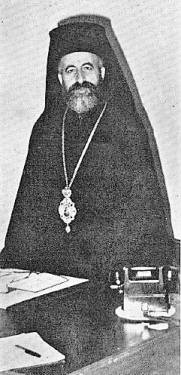
"Your Eminence, are you gratified that Cyprus is at this time already an independent country?" "Some Greeks and some Turks possibly will not be happy, but the immense majority, that one which sacrificed on both sides so much to reach this solution, is glad. I count myself among them, and I am also gratified, very gratified."
"Was Your Eminence always sure of obtaining the Island's independence or were there moments when you doubted the victory?" "I didn't know how or when, but I always knew that Cyprus would become independent."
"Does Your Eminence regard the Island's independence as the definitive solution to the problem that for four years plunged it into the Revolution?" "Yes! Cyprus' independence is the definitive solution to the Revolution, for the people of Cyprus have achieved their aim with this independence."
"What is from Your Eminence's perspective the biggest problem that the newborn Republic will have to face?"
Before answering this question, the Archbishop asked the interpreter why the Spaniard kept saying, "Your Eminence," at every turn. Lorente explained. Makarios smiled and wrote his explanation on a notepad.
"I expect there won't be any problems, but if one shows up, it will be of an economic nature during the first year of independence. We have drawn up the annual balance sheet and we find that there is no money for our public works program. But we hope to receive foreign aid."
"In regard to foreign affairs, may Your Eminence disclose whether Cyprus will lean toward the Western bloc, the Eastern or maintain a neutral stance?" "Cyprus is a country that has to ponder its domestic development before anything else. That is why we will be a neutral nation, and since we want to have friends for neighbours, Cyprus will not join any bloc."
"Does Your Eminence not believe that the current strength of the Cypriot Communist Party may alter this initial line?" "No. My government represents legitimately the people of Cyprus who elected it freely. The Communists are a minority and will have to abide by the decisions of the government."
"Does Your Eminence not worry that having cordial relations with Israel might bring Cyprus some disadvantage regarding its relations with the Arab world?" Note: Spain did not have diplomatic relations with Israel (End of Note).
"Our diplomatic relations will be decided by the President and by the Vice-President who is a Turkish Cypriot, as you know, and we have not yet decided what kind of relations we will have with Israel. Of course I repeat once more that Cyprus simply desires to have friends all around."
"Will Cyprus remain in the Commonwealth?" "We have not reached a decision to date. Moreover it will not be the government's prerogative alone because whatever agreement we reach on the matter will have to be approved by the people in a referendum."
"In regard to finances, may Your Eminence disclose whether Cyprus will stay in the area of influence of the Pound sterling or move away?" "We will remain in the domain of the Pound sterling over the next ten years. It is too early to foresee what we will do afterward."
"Another question with Your Eminence's license. Has Your Eminence ever been to Spain?" "On my voyage to America the boat called on a Spanish port. I was infinitely disappointed that the haste in departing did not allow passengers to debark. I have also transited Barajas on more than one occasion, I saw Spain from the plane. And I hope to eventually see Spain in situ." Notes: The port was probably Barcelona. Barajas is the name of Madrid's International Airport (End of Notes).
"Is the possibility then open that Your Eminence will one day deign to visit our country?" "Since Spain is such an interesting country I hope to visit it informally soon."
The interview finished, Archbishop Makarios III the "Provisional President and President Elect of the Republic and Supreme Head of the Orthodox Church of Cyprus" bid farewell to José Lorente with these words, "On this occasion I wish to express my gratitude to the Spanish people for their positive attitude to the cause of Cyprus' independence at every turn."
José LORENTE
On pages 34-37 of Bazan, 16-17, July-December 1960, Lorente interviewed Dr. Muhittin Yilmaz the director and main announcer of Radio Ankara's short-wave programs in the Spanish language broadcast at 11:30 PM nightly. Lorente states that Yilmaz's radio voice sounded "friendly, with clear and perfect Spanish diction."
Dr. Yilmaz had also directed the Turkish national delegation to the Fourteenth International Competition of Folk Dances and Songs held in London. Twenty-four countries, he said, took part. Turkey won the first and third prizes in the dance category, Yugoslavia finished second. Spain was second in the singing category.
Dr. Yilmaz was appointed attaché of the Turkish Embassy in Spain for the period 1954-56 after coursing university studies in Istanbul and in the Sorbonne (Paris). He took adavantage of his spare time in Madrid to study Spanish Literature. He received a Ph.D. degree in Philosophy and Letters from the University of Madrid for his thesis, "The Elements of Nature in the Poetry of Góngora," completed under the supervision of Prof. Dámaso Alonso.
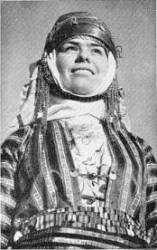
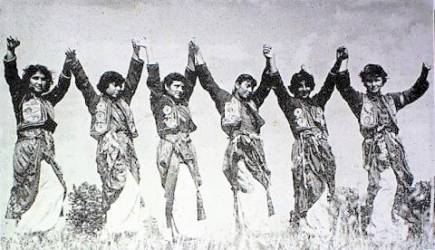
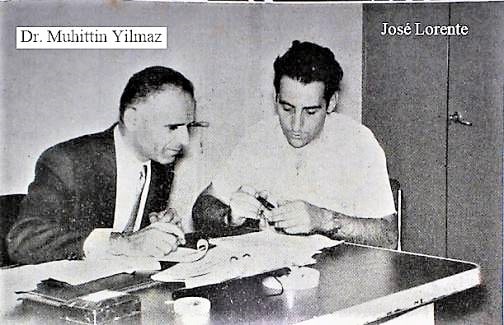
"Which dances earned you the awards?"
"We won the first prize with the Dance of the Swords and Shields. This dance has six figures that symbolize duelling before the discovery of firearms. The figures represent in succession, (1) homage to the people that send their sons to war, (2) swearing over the swords, (3) duelling, (4) the calling of a truce, (5) the trading of swords according to the terms of the truce, and (6) the recovery of a weapon snatched away with trickery and a reconciliation as the finale.
"The group from Gaziantep earned the third prize for their Halay dance (photograph above, right). A spry, dynamic dance interpreted by men and women, resembling your jota aragonesa somewhat."
"Do you mean to say that there is a certain similitude between the folklore of both countries?" "Yes, a considerable amount."
"What do you attribute this similarity to?" "The resemblance of both folklores is a clear reflection of the two countries' local colour. I understand by local colour the history and battles sustained by our nations to ward off their respective enemies. And the very interesting rhythm that defines the virile existence of both peoples. Folk dances reflect all this without, it seems to me, the sway of an epoch."
"How would you define, señor Yilmaz, the meaning of the word folklore?" "What expresses in a concise manner the inner world of a people, its happiness, its sorrow, its reaction to circumstances, which we convey by means of rhythm and music, i.e., folklore. In a broader sense it is a synthesis of dances, music, literature, traditions. In other words folklore is the résumé of a people's psychology."
Lorente affirms in his report that the Spaniard who visits Turkey will immediately take notice of a Turkish style of singing called Gazel which is very similar to Andalusia's cante jondo because both use wailing melodies, extended notes and the stretching of a syllable into a guttural flourish. In regard to lyrics they are identical, both express only love and grief.
Lorente asked Dr. Yilmaz his opinion on the matter and he replied, "Here is the most characteristic Saracen musical heritage. These songs with bitter aftertaste have their origin in our folklore, in Anatolia, a region of sadness and love. Anatolia did not know happiness for centuries. The country lay racked by endless wars. Many men fell dead in these wars; their wives and fiancées who waited for them in vain got together to vocalize their bitterness in songs that reflected the love and sorrow besetting them. In parallel emerges, as in your flamenco, the virile and joyful variant which has for cradle the song of victorious warriors who, aloof from anything in life unrelated to war and love, offer a trophy to their beloved. Thus love suffuses both variants and is expressed as joy or sadness according to the circumstances."
"Señor Yilmaz, something has intrigued me since I arrived in Turkey. It concerns a certain dance of spry rhythm where each dancer holds two spoons in each hand and bangs them together like castanets for percussion accompaniment. The castanet's shape suggests indeed that its origin may have been a spoon. Is there any connection between the Spanish castanet and this 'musical' spoon of Turkey?"
"There is nothing written on the subject as far as I know. What I can tell you is that both your castanets and our spoons have a certain link to Arabian zills."
"What is the Turkish name of the dance?" "Kaşik Oyunu which means 'dance of the spoons.' The dance is indigenous of Southern Anatolia and is a subset of Silifke. Nowhere else in the Middle East are spoons used as musical accompaniment to a dance."
It was the "Hekmek" hour (that's how they dub the ingestion of chickpeas here) when I said good-bye to señor Yilmaz.Without entrusting myself to God or to the devil I entered the first restaurant I found along the way, and there, the waiter watched me in astonishment as I, mesmerized by the originality of musical spoons, unconsciously began to play those set on my table.
José LORENTE
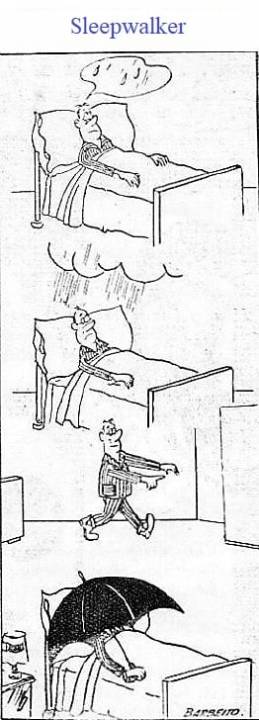 |
 |
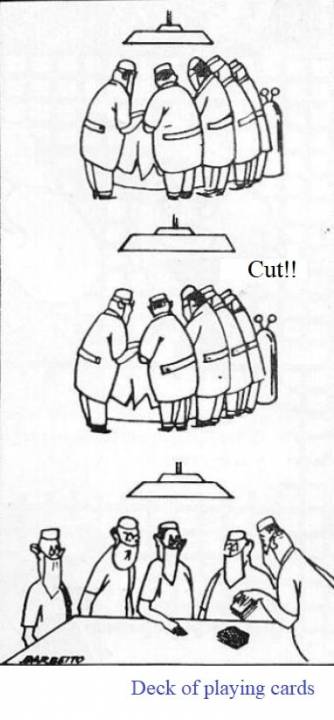 |
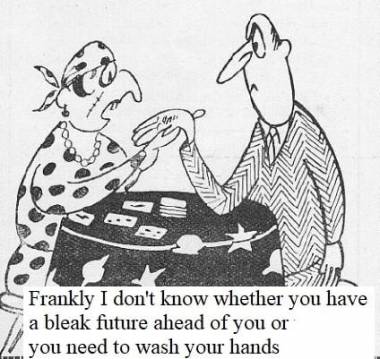 |

 |
 |
 |
The source for the information contained in this chapter was the newspaper La Voz de Galicia archived by the local library. The newspaper devoted a page and a half to Ferrolian news in 1961. This increase was due to advertising, to interviews and to greater coverage of county news.
Some annual events are omitted because they have been covered previously and the details varied little from year to year.
The extracted image of the "Point Lacre" (February) was tinted sepia to improve definition.
An outstanding item of local news for the year 1960 was the start of the construction of the working-class suburb of Caranza.
The following table shows the volume and type of inbound traffic registered at the entrance to the city on Monday August 14, 1961. Curiously the newspaper printed an erroneous total of 7,550 vehicles (a typo probably in the number of bicycles). The sample spanned seventeen hours. Bearing in mind that Ferrol had 75,000 inhabitants (December 7) the numbers put forth the underdeveloped status of Spain.
| (From 7:00 AM to 12:00 midnight on Monday August 14, 1961) | ||
|
Buses Trucks Cars Motorcycles Bicycles Animal-traction vehicles Total |
330 471 2,036 2,234 2,302 87 7,550 |
|
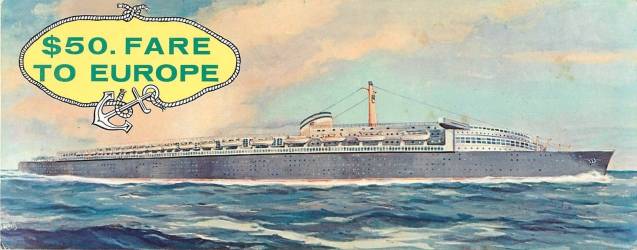
| 1. | The wall of a house collapses and narrowly misses crushing an 8-year-old girl. |
| 3. |
Public drive to collect cigarettes and packets for the tenants of the Destitute Seniors Home. Editorial frets that sewers are often clogged. |
| 5. | A sailor of the cruiser Almirante Cervera attempts suicide by jumping off a rampart to the pavement below. He sustained "very serious injuries." |
| 7. | Editorial repines over the "terrible state of the roads leading into the city." |
| 26. | Bazan Chairman goes on a tour American and Canadian shipyards, he returned February 16. |
| 31. | Hyman Benjamin Cantor the president of Sea Coach Transatlantic Lines came to Spain to explore the possibility of Bazan building two superliner passenger vessels designed by Vladimir Yourkevitch. Each vessel would displace 90,000 metric tons, measure 1,152 feet in length, 134 feet in beam and carry 6,000 passengers plus 1,350 crew. Cantor estimated a building time of two years and the creation of 22,000 jobs. Refused U.S. Government financing, Sea Coach Transatlantic Lines turned to Deutsche Werft Shipyards of Hamburg, Germany, and Bazan of Ferrol. The sticking point was the requirement of 85% mortgage financing by a national government. Although the shipyard expressed a willingness to do the job, the central government in Madrid turned down the offer. The two superliners were never built, they were to have been christened, "Peace" and "Good Will." |
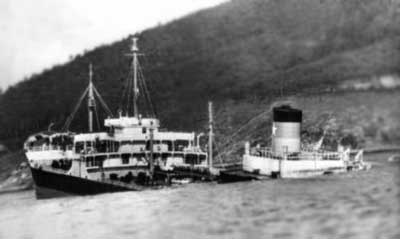
"Andros Fortune" in Corcubión |
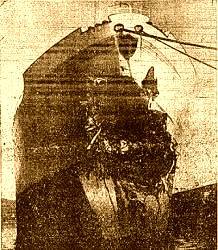
"Point Lacre" in Ferrol |
| 7. | Minor chimney fire. |
| 19. | Power shutdown scheduled between 8:30 and 9:30 [AM presumably]. |
| 23. | Inauguration and blessing of the "best cafeteria in town." A glass of Spanish wine was served. |
| 24. | Registration of goldfinches at the stadium for a birdsong contest next spring. |
| 27. | Liberian oil tanker "Point Lacre" (above right) rammed the stern section of Canadian oil tanker "Andros Fortune" (above left) off Cape Finisterre. The collision was "very violent...in a lot of fog and very rough seas." Five "Andros Fortune" crew died or went missing, twenty-two others were taken to Ferrol by the destroyer Ariete: 12 Greeks, 8 Canadians, 1 Briton and 1 unspecified nationality. The Canadian vessel was towed to the Firth of Corcubión for emergency repairs and salvage of its cargo of 25,000 tonnes of fuel oil. The Liberian tanker limped into Ferrol under its own steam. Note: I remember seeing its rusty, mangled bow (End of Note). |
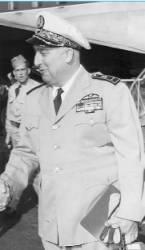
| 1. | Ornamental cypresses have been planted on the waterfront gardens. |
| 4. |
Town Hall assures the citizenry that the water supply problem will be resolved by the summer of 1963. Town Hall counts 13 kilometers of unpaved city streets. |
| 5. | Damaged Liberian oil tanker "Point Lacre" departs for Holland |
| 8. | "Andros Fortune" crew depart Ferrol by road to start their return trip to Canada. |
| 9. |
Rear Admiral André Jubelin of France (above) arrived at 12:00 noon on an official visit. The usual formalities were observed (e.g. July 26, 1954). Damaged Canadian oil tanker "Andros Fortune" is towed away to Hamburg, Germany. |
| 11. | Gleeful editorial announces that a lot of road improvement work is in the offing. |
| 15. | Brief news item deplores the lingering use of steel-rim wheels on animal-traction vehicles. |
| 17. |
Town Hall has made the installation of artificial lighting on the waterfront a top priority. Construction of a conveyor belt for iron ore will begin "soon" in the harbour. |
| 18. | Around 15,000 Ferrolians watched the traditional Rondallas a las Pepitas contest on Town Hall square (see March 18, 1959). This photograph of the event comes from Bazan, 18, page 31. |
| 19. |
"Thousands of Ferrolians" visited the Destitute Seniors Home. Today is that institution's patron saint day, St. Joseph. Local businesses donated many small gifts and Bazan apprentices donated tobacco and candy. An extraordinary mid-day meal was served,
|
| 30. |
80-year-old man dies after being gored by a bull outside the city limits. Thirty bedside tables were donated to the Destitute Seniors Home. |
| 31. | The minutes of the last Town Hall council meeting suggest that the trams will be replaced with buses shortly. |
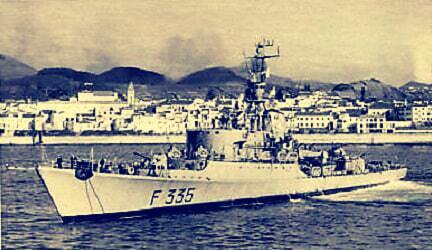
| 2. | Today Sunday is St. Francis of Paola the patron saint of draftsmen. Accordingly there was a solemn Mass at 12:00 noon in the co-cathedral. | |
| 9. | Portuguese frigate "Pero Escobar" (above) arrived for a visit at 11:00 AM. The usual formalities were observed. "The presence of the Pero Escobar crew in our streets was received with shows of affection and affinity." The frigate departed on the 11th at 11:00 PM. | |
| 15. |
Launch of the oil tanker "Bilbao" at 4:06 PM. This photograph of the event comes from Bazan, 19, page 10.
Bazan, 21, informs that the contractual sea trials were performed on January 6, 1962, and the official ones on January 30. The ship was delivered to Naviera Vizcaína at noon, January 31, and departed Ferrol during the afternoon of February 6. As an interesting tidbit of data these were Bilbao's deadweight contributions upon its departure from the port of Ras Tanura (Saudi Arabia) on a voyage to Cartagena (Spain). The units below are tonnes,
Voice-Over Translated: In the Ferrolian shipyards of Empresa Nacional Bazán the oil tanker "Bilbao," the biggest boat built by said factory, is ready to be launched, destined for the Biscayan shipping line. It has a total displacement of 43,000 tonnes, a length overall of 202 meters 70 cm and a beam of 26 meters 53 cm. The Captain-General of the Maritime Department and other authorities and echelons come to the blessing and launching ceremony. The bottle of Spanish wine slams against Bilbao's bow, and the ship glides majestically down the slipway. The tanker's maximum loading capacity is 40,000 cubic meters and it can reach a speed of more than 16 knots. The oil tanker, which will have a crew of 64 men, composes a feat in modern shipbuilding. |
|
| 21. | Ohio Oil Company technicians scout the bay for the possible emplacement of an oil refinery. | |
| 22. | Local police give their statistical briefing for the first three months of the year: 829 traffic offences, 88 breaches of municipal law, 56 confirmed cases of milk adulteration or of unclean milk containers, 39 instances of disorderly conduct including drunkenness, 25 traffic accidents, 17 cases of panhandling, 12 assaults, 6 minor fires, 6 dog-related incidents, 1 theft (cf. July 7, 1954). | |
| 28. | Newspaper reminds its readers that the first Ferrolian town hall convened on this date in the year 1788. |
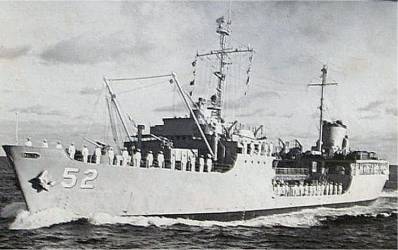
| 1. | "Big crowd" watched a comic game of soccer at the stadium between a team of "Fat Ones" and a team of "Skinny Ones." Donated gross of 2,641 Pesetas went to the Destitute Seniors Home. Final score: Fat Ones 5, Skinny Ones 4. Note: I remember that half times were shortened considerably, the goalkeeper of the Fat Ones climbed to the crossbar and sat there awhile and near the end somebody dressed in a gorilla costume ran out onto the pitch from our side of the stands (End of Note). |
| 2. | Bazan soccer club wins the national tournament of Educación y Descanso for the second consecutive year. |
| 4. | French minesweeper Aries arrived at 10:00 AM on an unofficial visit. Still "several military and civilian representatives went aboard." The vessel departed on the 6th. |
| 10. | Major improvement work continues on the municipal park. Birdhouse installed, fountain and pond refurbished, multi-purpose court expanded and covered with terraces. |
| 14. | Birdsong contest at 10:00 AM in the stadium (February 24). First prize in the goldfinch category went to five-year-old native "Harmonious." |
| 15. | Captain general of the maritime department travels to Brest with his family on the invitation of André Jubelin (March 9). |
| 17. |
Seminar entitled "Exposition and critique of Marxism" at 7:45 PM in the high school. New cranes for the harbour. |
| 23. | Port of call for gasoline tanker USS Mattabesset (above) on its return leg from Italy to the United States. |
| 1. |
Summertime charity raffle stand in the downtown gardens was inaugurated and blessed by the bishop at 12:00 noon (cf. July 15, 1959). The number of raffle tickets printed is 600,000 and they sell for 1 Peseta each. There will be a draw of super prizes every three days. There are 1,260 surprise prizes on hold which include bicycles, stoves, two hundred cans of olive oil, blankets, radios, etc. The total number of prizes on offer is forty-two thousand. "If all the raffle tickets were sold, Cáritas would collect some 185,000 Pesetas for its Christian work." The raffle stand will open each day from 12:00 noon to 2:00 PM and from 7:00 to 10:00 PM. Latest census figures: 71,259 duly registered and 4,312 unregistered inhabitants for a total Ferrolian population of 75,571. There were 17,998 dwellings and twenty-nine tourist lodgings. |
| 2. | Several high school students volunteer to repair the shack of a sick senior. |
| 7. | Official visit of U.S. Rear Admiral [Clifford Steele] Cooper to the Naval Fuel Storage Annex of A Graña. |
| 18. | Young man had his watch and clothes stolen while he went swimming in Copacabana Beach. |
| 20. | Showers are installed and working in Copacabana. |
| 21. | High school entrance examination at 8:30 AM for the pupils of "Sagrado Corazón" elementary school. Note: I passed the exam (End of Note). |
| 22. | Local hunters carry out an authorized cull of crows in the municipal park during the afternoon; the birds frequent the grove of eucalyptus there. |
| 24. | "Thousands of Ferrolians" watched the lighting of a mammoth bonfire beyond these "grassy boulevards" just after midnight. A second bonfire was lit five days later. |
| 25. |
Ghanaian freighter "Bensu-River" is in harbour for repairs. The same dog bites three people on the right leg in separate incidents. "Several thousand Ferrolians" went to Valdoviño on buses run by that town hall, the passengers were delighted with the service. |
| 27. |
Editorial censures the free run that dogs have of the city. A 39-year-old man suffers serious injuries after falling off a fig tree (cf. September 3, 1954). |
| 28. | Two municipal transport buses have arrived and two more are expected on Saturday. Buses will replace the trams on Monday July 3. |
| 29. | Gran Compañía del Teatro Eslava de Madrid will stage the play "Yerma" by Federico García Lorca (above) at Renacimiento Theatre. Two performances at 8:00 and 11:00 PM. One day only (flyer). |
| 30. | Editorial labels the dogs' free rein in the city "a canine plague" and urges Town Hall to adopt coercive measures. |
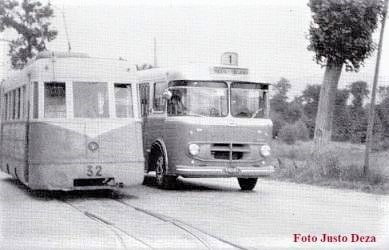
| 2. | Last day of tram service. |
| 4. | Three new garbage trucks will start operating soon. |
| 8. |
First T.V. aerial installed. Construction of the Navy condominium begins. |
| 12. | The cull in the park has killed "more than one hundred crows" (June 22). |
| 15. | Newspaper's drive and readers' donations have funded the purchase of a wheelchair for a 14-year-old crippled boy. |
| 16. |
Summertime charity raffle stand closed at 8:00 PM after all 600,000 tickets were sold (June 1). Editorial urges municipal workers to stop experimenting with the luminous fountain in Plaza de España. |
| 22. |
Three teams from Instituto Ibys of Madrid undertake a rat extermination project in the city. Households and businesses that wish to co-operate should register with the health bureau in Town Hall.
On Sunday August 6 the newspaper reported that official institutions had joined the pest control drive. These included Bazan and the coastal artillery garrison. The operation lasted until August 13. Ibys technicians estimated that "more than 50,000 rodents" were killed. |
| 23. | Transfer of American command at the Naval Fuel Storage Annex of A Graña. Capt. Harrison G. Packard defers to Capt. Robert J. Davilbies. Note: It was rumoured that the hill had been hollowed out to make room for gigantic fuel storage tanks, huge warehouses, vast arms depots and "who knows what else" (End of Note). |
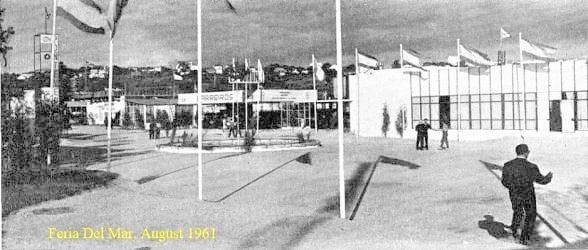
| 3. | Water main shutoff between 4:00 and 8:00 PM everyday until further notice. |
| 5. |
Solemn inauguration of the Second National Fair of the Sea at 12:00 noon. The exhibition welcomed more than 70,000 visitors in the first two opening days and ran until Saturday September 9 when it was officially closed by Franco. Note: The First National Fair of the Sea had been held in 1957 on the dockside of San Sebastián in the Basque country (End of Note).
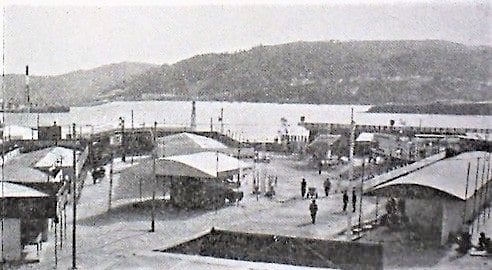
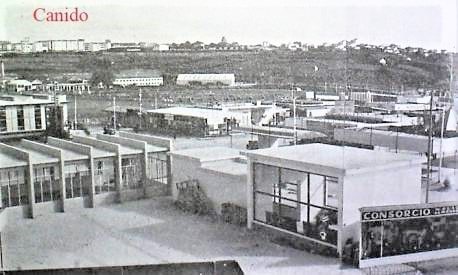
Bazan, 20, devoted thirty-two pages to the Second National Exhibition of the Sea. The fairgrounds was not a dockside but a vacant lot bordering the bay (above, left) and conveniently located downslope from the outlying Ferrolian neighbourhood of Canido (above, right). The exhibition covered 70,000 square meters and had 552 stands, an Olympic-size swimming pool, a ballroom and sporting facilities. The visitor got an impression of amplitude and focus. 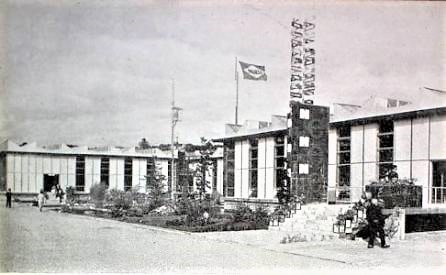
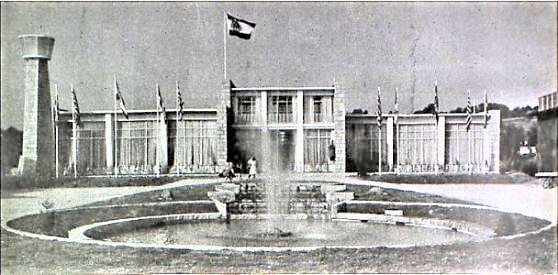
The two most important pavilions of the fair were allocated to the National Institute of Industry (above, left) and to the Navy (above, right). The stand of Empresa Nacional Bazán was housed in the National Institute of Industry pavilion. Center stage belonged to the huge gears that reduced the very fast rotation speed of the thrust shaft connected to a ship's main engine and delivered it to the propeller shaft. The gears were also featured on the cover of Bazan, 3 (Chapter 1, "The Shipyard"). The Navy pavilion had many historical documents: rare books and maps, paintings and watercolors, old flags, swords, a facsimile of the famous nautical chart of Gabriel de Vallseca (1439) and the projected layout of Ferrol hatched in the year 1751. Bazan, 20, states that Ferrol was the first city outside of Russia to be constructed in the Russian style. |
| 7. | Equestrian meet at the stadium. One show jumping event was labelled "Pepsi-Cola." Note: Placing bets was part of the fun (End of Note). |
| 8. |
22-year-old mother drowns herself and her two babies, a 2-year-old boy and an 8-month girl. The news "caused great consternation in the city." 50-year-old man is seriously injured after falling out of a bus (cf. January 16 and May 26, 1959). |
| 11. | Another 22-year-old married woman attempted suicide in the harbour, but was restrained twice. |
| 18. | Drivers complain that gasoline is hard to find. |
| 24. | Outdoor theatre in the park this evening. Gran Compañía del Teatro Eslava de Madrid presents Un tranvía llamado Deseo by Tennessee Williams. 8:30 PM. |
| 25. | More open-air theatre at 8:30 PM. |
| 27. | Tap water will run only from 8:30 AM to 3:00 PM everyday until further notice. |
| 28. | Today's maximum temperature was 35°C (cf. July 8, 1959). |
| 30. | Rival shipyard Astano will build an oil tanker for Argentina and three freighters for Norway. |
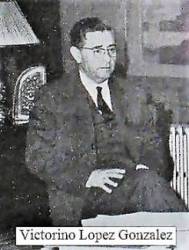
| 2. | Editorial note urges more dumping of sand on Copacabana (February 3, 1959). |
| 7. | Several cafeterias begin installing television sets. |
| 8. | Brawl lands three men in the emergency clinic, their ages 28, 33 and 56 (cf. August 15, 1954). |
| 9. |
General Franco closes officially the Second National Exhibition of the Sea. This fair welcomed more than 70,000 visitors in its first two days.
Voice-Over Translated: In his visit to the Ferrolian Exhibition of the Sea, His Excellency the Head of State salutes the flag of the infantry regiment that renders him honours, and is complimented by ministers and other authorities. Franco tours with his wife the various pavilions installed in the place called Punta de Arnela. The fair is the second of this type held in Spain and the Generalissimo evinces keen interest in everything exhibited in the installations of the Navy, the National Institute of Industry and other organizations. The meet has served to demonstrate precisely in the departamental city the potential of the Spanish naval industry and the level obtained by the secondary industries as well as the effort and achievements logged by the coastal provinces that were also represented. |
| 20. | The state will invest 400,000,000 Pesetas in the urbanization of Caranza, a working-class suburb. |
| 21. | The quorum for holding night classes in the high school has been met. A Bazan electrician said in an interview that his workday ends normally at 6:15 PM, that night classes start at 6:45 PM and run to ten o'clock. Workers pay a registration fee of 175 Pesetas per academic year, half the normal amount. He poured praise on the principal (above) and on the teaching staff for "their dedication and evident zeal to protect disadvantaged students...they have made our cause theirs." |
| 23. |
"The generosity of Ferrolians...and the protection afforded by the mayor" have brought about the reconstruction of an old house felled by a storm in the winter of 1959 (see November 30, 1959). Two destitute sisters, one of whom was bedridden, were left homeless. The new house under construction is comfortable and has two floors. "Hundreds of old magazines are being donated daily" to the Destitute Seniors Home. |
| 25. | First day of preparatory grade classes. |
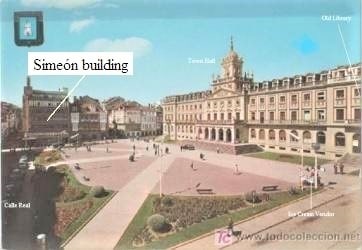
| 1. | Half-page advertisement commemorates the inauguration of the six-storey Simeón building (above). The deputy mayor, civilian and military dignitaries and representatives of banking, the press and radio attended the opening ceremony and the bishop's blessing. A glass of Spanish wine was served. A clothing retail store occupies the first two floors. |
| 7. | Solemn morning Mass in the co-cathedral of San Julián to commemorate the twentieth anniversary of the creation of the National Institute of Industry. According to Bazan, 21, page 62, the top management attended along with plentiful representations of all the Departments and the apprentices of the Factory. Bazan's chorale and orchestra performed under the baton of Reverend Manuel Perez Fanego. The Company brushed aside further celebration and chose instead to make "an important donation to the sick, the retirees, widows, orphans and other needy people of the Factory." |
| 8. | Power shutdown scheduled from 7:00 to 9:00 AM to carry out repairs in the grid. |
| 16. | High school classes start. |
| 28. | Italian corvette Aquila arrived this morning and departed on Monday. Though the visit was unofficial the usual formalities were observed and there was a "festival in the municipal park" at 11:00 PM to fete the Italians. |
| 31. |
Water losses abound in "numerous points of the city, doubtlessly caused by ruptured pipes." Credit union celebrates "Universal Savings Day" by holding a draw among its customers. The first prize, a Vespa scooter, went to ticket number #92394. Second prize: dining room set. Third prize: sewing machine. There were thirty-nine other prizes. Three simultaneous art exhibits in the city: Group of Seven, Luis Calvo and Antolín López Porta. Porta donated one of his paintings to the Destitute Seniors Home. The patrons of Toxos E Froles toasted Porta on Sunday November 19 for "his resounding success." |
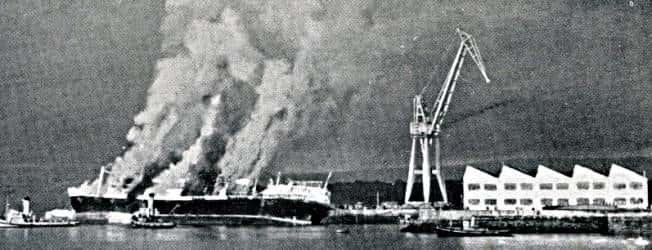
| 1. |
5-year-old boy is killed after falling off a tractor-pulled trailer and being struck by the drawbar. More than 1,400 cars made the short trip to Catabois Cemetery to deposit flowers on relatives' tombs, an All Hallows' Day tradition. The number of visitors totalled 23,000 approximately. Third Division soccer: Ferrol 10, Santiago 0. |
| 6. | Transatlantic "Marqués de Comillas" (above) burst into flames at the Astano shipyard. The fire was detected at 3:00 AM. The damage was estimated to be 100,000,000 Pesetas. |
| 7. | Fleet oiler USS Waccamaw lays anchor at the naval station of A Graña until the 11th. |
| 8. | Police arrest the author of "numerous robberies committed in the city during the months of September and October." |
| 19. | Many streets have "perfect" artificial lighting (example) but others do not, making nighttime transit almost impossible. |
| 21. | Street procession of the "Little Princess" religious icon of Daughters of Mary School. Approximately seven hundred schoolgirls with white collar and white veil walked in two rows, the smallest children in the middle. The current pupils were followed by rows of "many" former pupils. The naval infantry band brought up the rear (cf. November 21, 1955). |
| 23. | Editorial questions the need for shutting off the water main at night. |
| 25. | A band of minstrels from the University of Santiago de Compostela arrived at 5:30 PM, paraded downtown and was officially welcomed by Town Hall. The band gave a recital in Renacimiento Theatre at 12:00 noon the next day. |
| 26. |
17-year-old Bazan apprentice falls from an oil tanker in dry dock and is seriously injured.
Inauguration with the bishop's blessing of a Parish School for Girls in Caranza. According to Bazan, 21, page 63, the school will be run by nuns from the Company of Mary. |
| 28. | Hans von Benda conducts the Berlin Chamber Orchestra tonight at 8:00 PM in Teatro Jofre. |
| 29. |
The number of television sets in the city has risen to nearly two hundred (July 8). "Deficient" washrooms in the meat section of the Central Market. |
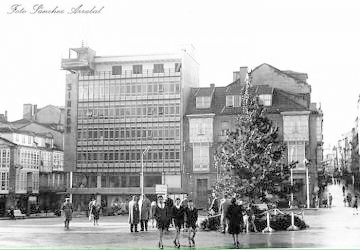
| 2. | Sold-out shows of Love Is a Many-Splendored Thing at Capitol movie house. The Spanish title accorded the film was "La Colina del Adiós" (Good-Bye Hill). |
| 3. | Thirteen high school students volunteer to sell raffle tickets during the Christmas campaign for the needy. |
| 4. | "Very strong gale." A fishing sailboat out in the bay capsized, the crew was rescued. |
| 7. | Official census puts the population of Ferrol at 74,799 (cf. June 1). The population of nearby municipalities follows in brackets: Fene (9,291) Mugardos (6,976) Valdoviño (8,154). |
| 8. | Great expectation surrounds this afternoon's soccer match between Arsenal and Ferrol. "Ferrol needs desperately to win if it wishes to keep alive its chances of promoting to Second Division." Game time is 3:45 PM. There was a big crowd on hand and Ferrol scored two minutes before time to win 2-1. |
| 12. | Two hooligans were fined 100 Pesetas for misbehaving at Madrid-París movie house. |
| 14. | Inauguration of a supermarket for the exclusive use of Navy personnel and their families. |
| 17. | The yearly levy in benefit of fascist organizations Frente de Juventudes (Youth Front) and Auxilio Social comes due today (cf. September 10, 1955; October 25, 1959). |
| 20. | Official Christmas tree (above) has been put up at Town Hall square. |
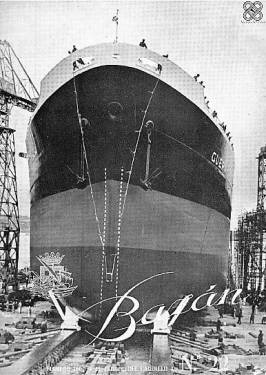
The source for the news in this chapter has already been discussed in the chapter entitled, "Bazan Magazine for the Year 1956."
The year 1962 produced just one number of Bazan magazine. Around two thirds of it was devoted to the oil tanker Bilbao, which had been launched on April 15, 1961, and which stands as a milestone in the history of the Spanish merchant navy. A highlight of Bazan, 21, September 1962, is a short bibliography consulted during the pre-planning stages, Arkenbout Schokker, F.H. Todd, van Lammeren, the North East Coast Institution of Engineers and Shipbuilders and others. Subsequent articles furnish technical details about the hull, method of construction, internal cathodic protection, prefabrication, soldering, riveting, lifeboats, gangway, insulation, paving, painting, pumps, pipelines, fans, electrical installation, propulsion, etc. Oil tanker "Bilbao" was decommissioned and recycled in 1982.
By contrast Bazan, 22, February 1963, whose cover heads this chapter, is exclusively devoted to the year 1962. Consequently this chapter is a compendium of both numbers.
The salient event of the year was the launch of the oil tanker Guernica on May 3, 1962 (cover of Bazan, 22). Guernica was a twin of the Bilbao delivered to Naviera Vizcaína on January 31. According to this webpage both Bilbao and Guernica were decommissioned in 1982.
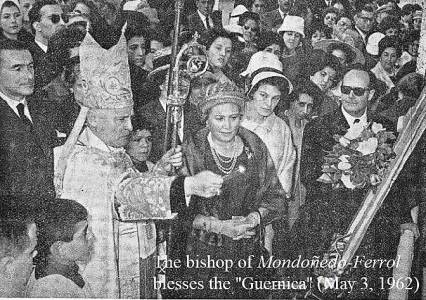
The presidential tribune for the launch of oil tanker Guernica was occupied by the interim captain general of the Department, the military governor of the city, the mayor, the admiral and managing director of Bazan, the managing subdirector, the engineer-director of Bazan and chief executive officers, the rear admiral of the Northern Navy Division, the president of the administrative council of Naviera Vizcaína, the five counsellors of Naviera Vizcaína, the chief engineer of New Constructions from Empresa Nacional Elcano, the mayor and the deputy mayor of the town of Guernica. Many other leading military and civilian authorities were present. The bishop of Mondoñedo-Ferrol blessed the vessel and the wife of one of the five counsellors of Naviera Vizcaína acted as the ship's godmother.
The ceremony was witnessed by "a very numerous public" who watched from provisional stands built apropos. The spectators cheered Guernica's smooth launch and expressed their admiration at "this new and important success of the Ferrolian Factory."
In celebration of the launch the president of Naviera Vizcaína made a "splendid donation" to the mutual fund run by Reverend Fanego. This fund gave money to subscribed needy and ill workers. Fanego underscored "the gratitude of all the beneficiaries" (Bazan, 21, September 1962, pages 64-65).
Guernica's official sea trials were carried out "with complete success" on November 6, 1962, and the vessel was delivered to Naviera Vizcaína that same day.
Bazan, 21, September 1962, discussed at length Bilbao's living quarters. It is reasonable to assume that Guernica's duplicated them. Underneath are displayed the captain's living room (left) the deck officers' (middle) and the crew's (right).
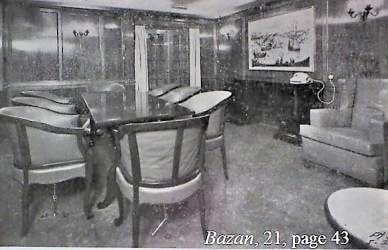
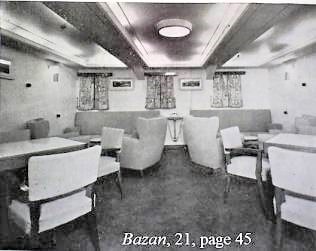
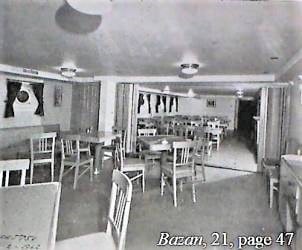
|
These next photographs show the First Officer's bedroom (left) and a crew's cabin (right). Officers enjoyed a private washroom adjoining the bedroom. The crew merely had a wash basin (lower right-hand item on the photograph below) and needed to use a public washroom.
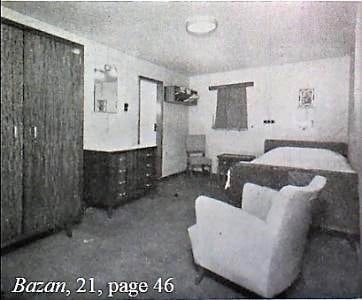
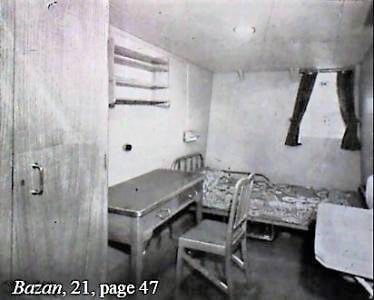
|
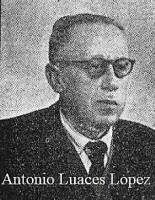
1. Antonio Luaces Lopez was born in Ferrol on June 15, 1891. He joined the Factory on June 28, 1909, as an apprentice of the Mechanics Workshop. He was laid off the same year, the consequence of the shipyard's technical backwardness and meagre productivity. The Spanish government invited British companies Vickers Ltd., Armstrong Whitworth Co. and John Brown & Co. to take charge of the shipyard. Then Luaces got hired anew, this time as an apprentice draftsman. The British employers no doubt valued his diplomas and awards obtained in the Ferrolian School of Arts and Trades.
In all Luaces spent 52 years 4 months working with Bazan-Ferrol.
"Do you remember your first job in the Factory?" "I remember it as if it were yesterday. It was taking part as an apprentice in the placement and adjustment of the slide valves of the battleship España. But I remember even more. In those distant days Mr. Monroe was the head of the shipyard and Mr. Spiere the head of the Constructora." "Isn't it true that you are a great lutenist?" "It's true that I have always felt a strong passion for music, but I ignore if I play the lute well or poorly. In my young years I joined the Airiños Da Miña Terra orchestra. I also took part in Bazan's Educación y Descanso plucked string orchestra from its foundation. Another of my great hobbies has been—and still is today—to visit towns and cities with artistic monuments." "Then it is certain that you have been a collaborator of the extinct Workingmen's Cultural Center." Note: The center was founded in 1911 and shut down in 1936 (End of Note).
"Yes, yes indeed. What days, those!"
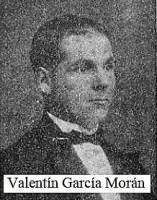
2. Valentín García Morán was born in Ferrol on December 17, 1896. He started working in the Factory as a fifteen-year-old apprentice. Battleship España had just been launched and its twins, Alfonso XIII and Jaime I, were in the stocks. "The Stocks Workshop then," recalled Morán in the interview, "consisted only of two cadmium-paneled depots approximately located where the air compressor is today."
"Don Valentín, do not take offence but you are a genuine arsenal of data." "Humbug! Do not exaggerate. Let us agree, however, that I always had a very good memory. Look, for example, I reached worker status at age twenty-one, that is in the year 1917. Well, I could draw for you this very instant the consoles I had to mark out for the Cristóbal Colón; that was my first Stocks operator job." Note: The Cristóbal Colón was a transatlantic built in Ferrol, launched in 1921, commissioned in 1923 and lost near Bermuda in 1936 (End of Note).
"Truly astonishing. And what year did you become a foreman in?" "In '45. Exactly November 11. I still remember they communicated the news to us the day before, in the afternoon." "Another item, Don Valentín, may we talk about your main hobbies?" "Music has always been my great pursuit. I enrolled as serenader with the artistic group, 'Airiños Da Miña Terra,' of which I retain unerasable memories. I will never be able to forget the trip we took to Barcelona motivated by the International Exposition of 1929 nor some of the performances we gave at the leading Galician theater houses."
"Confidentially, did you ever feel the temptation to cross the puddle, to go live in America?" "What! Can it be that you do not know I lived in America for three long years? See here, I emigrated when I was twelve years old, going to my uncle's who dwells in the selfsame Argentinian Pampa. There I learned to ride horses and to throw the lasso with skill. I returned for the same reason as everyone else, morriña (homesickness, lit. life-threatening nostalgia). Besides, I did not get accustomed to living far removed from my parents. You understand it, right?" "Totally, Don Valentín."
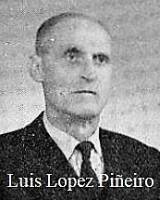
3. Luis Lopez Piñeiro was born in Ferrol in 1896. He started work in the Factory as an apprentice riveter in 1919. The end to procurements by the Navy in 1925 prompted layoffs at the Ferrolian dockyard and Piñeiro was one of those sacked. A new program of Navy procurements came along in 1927 and Piñeiro got reinstated. In 1941 he was transferred from riveter to the Electricity Workshop #1 with operator status. A year later he moved to Electricity Workshop #2 and there he stayed until his retirement.
"So a Ferrolian native, right?" "Yes, sir. And I have always dwelled in Ferrol, for I did not even do the military service because I was a supernumerary." "If you had not worked in the Constructora, where would you have liked to work?" "I would have wanted to re-enter the Company, so to speak." "You are what one dubs a loyal employee. Besides working as an electrician, have you spent your spare time doing anything else?" "Yes I have. I practised swimming assiduously and that other healthy sport which is taking long walks about the countryside. Additionally I am—always have been—a convinced, genuine and passionate advocate of Natural Medicine. A vegetarian, as we are usually called." "For the record, although I don't practise it, I too am a believer in Natural Medicine, but let's talk, if you will, about your retirement. Would you delay it if it were in your power to do so?" "Yes if I could be young again. But the reality is that the years weigh down. I asked for my retirement voluntarily. And yet what retires me, more than my will, is my sixty-five years of age."
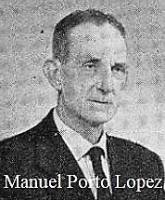
4. Manuel Porto Lopez was born in Narón on October 23, 1896. Note: The municipality of Narón adjoins the municipality of Ferrol (End of Note). He did his military service as artilleryman in Spanish Morocco. He started work in the Factory as a professional mason in 1928. Twenty years later he got transferred to the Electricity Workshop.
Lopez spent four years in the Republic of Cuba. "If it's not an indiscretion I would like to ask you why you went to America and why you returned so soon." "I emigrated in search of fortune and because a brother of mine waited for me there. And I came back because the economic fallout of the renowned and ruinous moratorium really made life very difficult." Note: The Cuban economy plunged into crisis in 1920 due to a 90% drop in the international price of sugar. There was a run on the money and the Cuban government decreed a banking moratorium on October 10, 1920 (End of Note).
"Isn't it true that you will never again contemplate a return to Cuba?" "Yes. See here, Cuba was always quite unstable. Sometimes life was nice, really nice; others very bad. Heck! That place was not meant for me, you know."
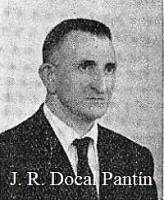
5. Juan Rosendo Docal Pantín was born in O Couto (Narón) on September 18, 1896. He began working in the Factory on February 2, 1918, as the operator of the sole mechanical saw in the Stocks Workshop. Twenty-six years later he was assigned the operation and maintenance of a sander/planer additionally.
"Mr. Docal, have you ever travelled outside Ferrol and its county?" "Very few times, and only to make short trips in the region. I went to Asturias one time."
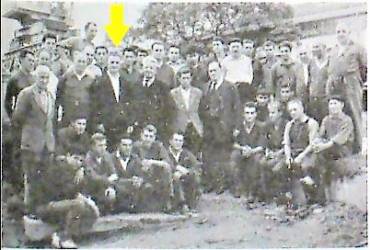
"What is your regular address?" "In Los Castros of Santa María de Neda. I dwell there since I got married. I always liked to live in a rural environment. One can supplement the domestic economy with some small-scale farming and the raising of animals."
"What are your main hobbies?" "The main one is bait fishing. Incidentally I forsook this old pastime of mine years ago due to circumstances which are not germane. But what a surprise I got on my retirement when my workmates (photograph to the right) presented me with a fabulous fishing rod armed with a complete kit of accessories plus a fisherman hat and fisherman boots! All that beside other valuable gifts."
"Naw, you have no option but to take up bait fishing once more." "Something I will do with great pleasure, believe me. Put down on your Magazine as well that I am immensely grateful to my workmates and to my superiors. They have treated me very well. I'll never be able to forget it."
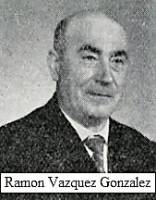
6. Ramón Vazquez Gonzalez was born in Santa Cecilia (Narón) on April 25, 1897. He never left the county of Ferrol and dwelled in the city since age eleven. He did not have to do military service in 1918 because he was classified as a supernumerary. He was self-employed until January 1941 when he entered the Factory as a plumber. Seventeen months later he was transferred to the Fine Sheet Metal Workshop and there he stayed until retirement with the status of operator second class.
"Mr. Vazquez, surely you know Ferrol quite well, correct?" "Yes, sure, I should think so." "And what do you like most about the city?" "Many things, but the Municipal Park is really marvelous."
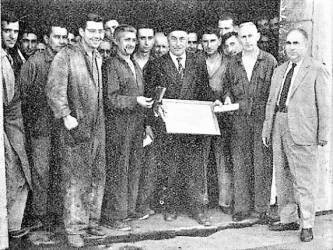
"And what do you like most about the Factory?" "Fine Sheet Metal; it's my workshop and I love it."
"What would you like to have been professionally?" "The producer I have always been."
"You are then satisfied with your lot?" "Well, yes, why not? You are already aware that a large portion of happiness is knowing how to be content with little."
"To close, please say something about the homage and the affectionate farewell you are being sent off with."
"I would like to say that I am extremely grateful to the entire Workshop; they have been very generous with me. Surely you've seen the valuable objects they have presented me with."
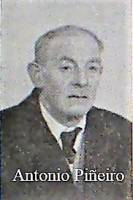
7. Antonio Piñeiro was born in Jubia (Narón) on November 12, 1897. He joined the Factory on May 26, 1923, as general help in the Outfitters Workshop. He soon attained to the rank of Specialist Helper in charge of one of the workshop's industrial guillotines, a post he held until retiring.
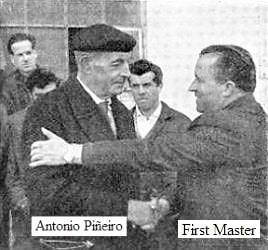
"Do you like the Outfitters Workshop?" "A lot. It's what I like most of the whole dockyard. Not to mention its personnel, which can not be surpassed."
"Have you always dwelled in Jubia?" "Yes. I like living in the outskirts where the enviroment is more rural than urban. Furthermore now, with the bus line, once the road is patched, the distance Ferrol-Jubia can be covered in relative comfort."
"Have you travelled a great deal?" "No. Only in connection with the military service; my first destination was an artillery regiment in Vitoria (Basque Country), afterward I was sent to Melilla during the disaster of Alhucemas." Note: Melilla is a Spanish enclave on the Moroccan coastline. The Alhucemas amphibious landing took place on September 8, 1925; it was a military operation designed to defeat the Moroccan insurgents based in the Rif Mountains (End of Note).
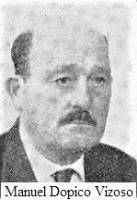
8. Manuel Dopico Vizoso was born in Narón in December 1897. He joined the Factory in 1944. He worked first in Public Works; a few months later he got transferred to the Outfitters Workshop as a Specialist the head of a group in charge of an industrial guillotine.
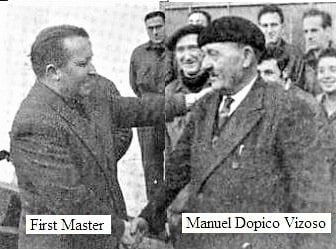
"Where did you work before entering Bazan?" "I worked wherever I could, sometimes here, sometimes there... And I did not reside always in Ferrol. I emigrated to America. I lived in Buenos Aires four long years and a few months in Montevideo. I returned to Spain. A short time later I emigrated again. This second time to Cuba. I spent more than three years in the Pearl of the Antilles. Note: "Pearl of the Antilles" is a moniker for Cuba (End of Note). However morriña (homesickness) on the one hand and awareness of my poor mother's illness on the other compelled me to return and never again depart. I also worked for some time on my own as a baker."
"Your impression of America?" "Argentina is what I liked most. Above all the good reception that we Spaniards received there."
"And what has pleased you most in this day of your retirement?" "This spontaneous and affectionate homage of farewell. I am extremely grateful to the entire Outfitters' personnel, in equal measure to the headmen and to my workmates and friends."
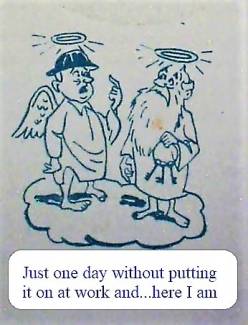

On December 1, 1962, the Management of Bazan-Ferrol ordered the compulsory use of a hard hat for all personnel without exception engaged in full- or part-time work in the zone of the stocks, the dry dock or on board a floating vessel. The compulsory use of hard hats could be extended to other zones as required. The ordinance's fourth article stated that an "adequate sanction" would apply for neglecting to wear a safety helmet, for its unjustifiable deterioration or state of disrepair. The ordinance's fifth article cautioned that any workplace accident the consequence of the factors outlined in the fourth article could be declared not eligible for compensation.
Bazan, 22, pages 16-18, informed that according to the latests statistics of the International Labour Office there were some 15,000,000 workplace accidents every year worldwide. Researchers had concluded that industrial accidents were "extremely deleterious" to the balance sheet of an enterprise and that failute to adapt quickly to technological progress accounted for only 10% of labour accidents worlwide—although the magazine noted that the figure rose to 25% in the case of Spain. The remainder was the result of human error: poor organization, defective training of the personnel, excessive working hours, etc., and in high proportion also the lack of attention by personnel, blunders, negligence and even the commission of imprudent acts that endanger one's or the workmates' safety.
The article in Bazan, 22, asserts that when a labour accident takes place it is "very frequently" assumed with blind fatalism, as something that had to happen inevitably someday. Generally speaking, it affirms, a worker's attitude to safety guidelines is "frankly negative,"
It is incumbent to relegate from his soul the blind fatalism that an accident will arrive someday. He must convince himself that no accident is haphazard, that they all have their causes and that if these are averted the accident is averted. This is an elementary axiom that must prevail over the fatalism that holds sway today. And in this fashion we will preclude having many producers fall innocently victim of accidents which, by their characteristics, seem to be genuinely preconceived.
Bazan-Ferrol distributed in this safety campaign more than 2,500 hard hats among its personnel. With everybody's cooperation, concluded the article, "we will make our Dockyards, which have already earned the reputation of building the best ships of Spain, recognized for being also the safest in Spain."
According to Bazan, 22, the hard hats used in Bazan-Ferrol had the following specs.
Construction Safety Helmet. Composition: Pressed aluminum with ridges. Weight: Less than 400 grams. Mechanical Resistance: (a) Withstood without denting the drop of a 3-kilogram steel ball from a height of 2 meters. (b) Withstood without rent the drop of a 450-gram pointed steel penetrator with 36° angle from a height of 3 meters.
Electrician's Safety Helmet. Composition: Plastic mixed with fiberglass. Specifications: All the above plus the following. Dielectric protection: Not inferior to 15,000 Volts. Heat Transfer: Nil after a 4-hour exposure to 40°C in the sunlight.
Bazan-Ferrol's Service of Security and Hygiene At Work published on page 16 of Bazan, 24, November 1963, a comparison of the number of serious accidents that occurred during the same five months, January to May, for the years 1960, 1961, 1962 and 1963.
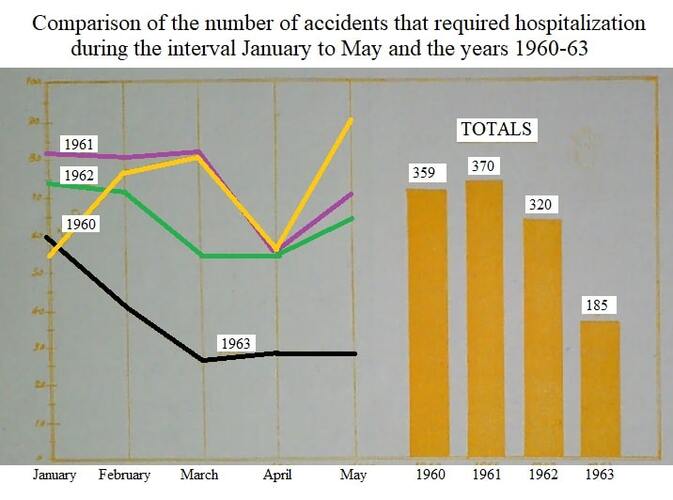
The original graph is shown on the right modified considerably for ease of reading. The original Spanish labels were replaced with English-language labels and the original penciled straight-line segments which appeared on the January-May abscissa were redrawn as four different thick colours, the orange straight-line segments correspond to the year 1960, the purple to the year 1961, the green to the year 1962 and the black to the year 1963. The histogram spanning the 1960-1963 abscissa is shown in its original orange colour, but the small white labels crowning the four bars are mine.
The graph's ordinate axis is the original one. It denotes the number of serious accidents. It is graduated from zero to one hundred in steps of ten.
The Figure purports to prove that the safety program initiated at Bazan-Ferrol on December 1, 1962, had an immediate effect on the number of major accidents. Multiplying the mean of three histogram totals by 2.3 yields an estimate of 804 grave accidents per year prior to 1963. The factor 2.3 minds Bazan-Ferrol's official summer recess of half a month (see the news of July 23, 1954, or of July 13, 1955).
A second graph on the same page 16 of Bazan, 24, November 1963, shows a steady drop year on year in the number of minor accidents during the five months from January to May. These mishaps did not require hospitalization. Their total count was 5,700 in 1960 and 3,146 in 1963.
The report by the Service of Security and Hygiene At Work details four accidents at the stocks that required hospitalization and "could have been easily prevented." On February 28, 1963, a man working on deck and wearing slick-sole shoes slipped and fell. On April 16 a worker coming down a ladder landed on a piece of lumber that had nails sticking out. On April 26 a man was struck by a falling tube. On May 6 another operator slipped and fell on a greasy, oily floor of the deck.
The next safety campaign of Bazan-Ferrol pushed safety glasses.
Reverend Manuel Perez Fanego the chaplain of the dockyard informs the reader of Bazan, 22, pages 22-23, about six desperate cases of want among families of the Bazan-Ferrol working class which spurred fellow workers to help out in detriment of the State which did nothing. The chaplain deliberately omitted the names of those concerned in order to "avoid offending or annoying anyone and to follow the Gospel's injunction to not let the left hand know what the right hand is doing." The six cases were attended to during the last quarter of the year 1962. The six footnotes seek to illustrate the value of the workers' donations.
1. October. A 35-year-old solderer, married, 20 years working at the Factory, suffers a lung disease that requires medical treatment and also afflicts a minor in the family. The financial situation is "critical." Fellow solderers aware of the predicament met and collected 2,600 Pesetas. They gave the amount to the chaplain who together with "a commission of workers" visited the family and donated the cash.
Footnote: Bazan, 21, page 78, lists the Ferrotour price of a 7-day stay in Alicante, with starting point anywhere in Spain, at 2,535 Pesetas. Ferrotour was a bid to promote domestic tourism under the auspices of "Autotransporte Turístico Español," a subsidiary company of the National Institute of Industry. The price covered travel to and from Alicante aboard night express trains, the stay at first-class hotels and arranged tours.
2. October. A 41-year-old riveter, married, wife and three children, 25 years working at the Factory, suffers an acute thrombosis which, after futile efforts and frustrating delays, requires the amputation of the right leg in 1961. After hardly a year the malady worsened and forced the amputation of the other leg. "Waves of charity and generosity swell where the news travels not just among riveters but through the entire family of Bazan." A collection drive for the distressed family raised 34,100 Pesetas.
Footnote: On Wednesday October 24, 1962, this make of car was on resale for 110,000 to 165,000 Pesetas (La Vanguardia, p. 26).
3. November. Another 41-year-old riveter, married, wife and two children, had been working at the Factory since 1937, requires "decisive" surgery for a lung disease that has bedeviled him fourteen years on. Fellow riveters raised 4,845 Pesetas for the family. Furthermore an "avalanche" volunteered to donate blood for the operation; in the end the "splendid contribution" of six workers sufficed. The chaplain adds that the surgical operation was successful and the convalescent was recovering swiftly and expecting to return to work soon, totally cured.
Footnote: On Sunday November 18, 1962, a plain colour 250×300 cm2 carpet, very high pile, was on sale for 3,075 Pesetas (La Vanguardia, p. 16).
4. November. A 40-year-old assembler, married, wife and two children, 24 years working at the Factory, has his solvency "profoundly imperiled" by illness and other family setbacks. His fellow workers raised 5,500 Pesetas for him.
Footnote: On Sunday November 25, 1962, this dining room set was on sale for 13,900 Pesetas (La Vanguardia, p. 6).
5. December. A 60-year-old stocks carpenter, married, 25 years working at the Factory, endures fifteen years with his breathing passages in poor shape. Eventually his condition required twenty sessions of cobalt therapy in Santiago de Compostela, done at personal expense. Two workmates and the chaplain made a "splendid donation" of 9,000 Pesetas to resolve the carpenter's "critical case."
Footnote: On Sunday December 23, 1962, this office storage cabinet 1.13×1.7×0.5 m3 was on sale for 8,000 Pesetas (La Vanguardia, p. 8).
6. December. A 36-year-old solderer, married, wife, four underage children, two young sisters-in-law he billets, suffers during fourteen years "a rebellious fistula that is destroying his health and the budget of this honest and extended family." His workmates collected 8,000 Pesetas and visited the solderer's home.
What a truly moving scene we have witnessed of the visiting workmates' genuine brotherly love, answered with sincere gratitude signed by the tears of a grateful heart.
Footnote: On January 19, 1963, Franco's government decreed a minimum wage of 1,800 Pesetas per month for workers more than 18 years old in the agricultural, industrial or service sectors.
In closing his article Father Fanego asserts that there are "many other" similar tragedies in Bazan-Ferrol which are "veiled by the discreet silence of anonymity."
Manuel Soto Romalde, social-and-labour legal adviser, wrote a short article entitled, "The Social Question and Social Politics," in Bazan, 21. It is questionable whether another gazette would have published it. Note: Bazan had already defied censorship printing poems written by Factory employees in the Galician language! The first one, "Noitébrego," written by Juan Manuel Castro, was published on page 21 of Bazan, 2 (End of Note).
My translation of the article follows.
It is well known that nowadays social matters draw the primary attention of all who devote their efforts to the tasks of governing people, for we must not forget that even though a country's entire resources may be brought to bear in the attempt to raise the standard of living it is paramount that the resultant benefits be allocated not arbitrarily but equitably among all who dedicate their activity in one way or another to the achievement of that goal.The more reigns harmony among the diverse social sectors the higher will the probability be of attaining this collective well-being desired by everybody which will come about only through the implementation of an adequate social policy that lends proper attention and assistance to the legitimate aspirations of the economically disadvantaged.
Let us clarify first all the concepts of the term, "social policy"; they are not interpreted correctly in most cases.
Social policy, as all policy in general, is actuated by the impulses of a specific ideology, i.e., by a fundamental concept of what the aims of the State are. In this sense one can not say that a legislator is "apolitical" just because he does not espouse a particular ideology. That fact would not divest his work of its political nature since it must always reflect the legislator's preconceived idea about the law in question.
A social policy exists because there is a social question. But what is the social question? The social question is the problem posed by disequilibrium among the social classes, an imbalance that constitutes an injustice not instigated precisely by the victimized class.
But in order to speak properly about the social question it is necessary to add to this objective aspect another purely subjective one: the consciousness that the class victim of the social disequilibrium has about its own situation constituting an injustice which can and deserves to be redressed.
Consequently it is logical to assume that where no such consciousness exists it is impossible to speak of the social question as a sociological fact. Indeed if we should imagine that the disadvantaged classes in the present situation were to endure their privation with exemplary Christian resignation doubtless the injustice would subsist, since those classes would not partake of the goods owed them in the concert of society, but that injustice would not be perceived as a problem.
Neither can one speak about a social question in those societies where the most unjust and arbitrary privileges and inequalities were accepted as normal and sanctioned by their religion as, for example, slavery and the caste system.
The social question then points to a psychological ingredient, and hence purely psychological factors will contribute to aggravate the problem.
We all know that there are certain political ideologies that have contributed to such a deterioration because they have infiltrated the masses adroitly to arouse them and to incite them to rebel against the established social order. But this true fact can not warrant the fatuous conservative viewpoint which attributes the root cause of the social question to those ideologies.
Indeed through all the epochs of history we come across mobilizations and manifestations, more or less severe, of the social question. The plebeian movement to acquire full legal and political rights in Ancient Rome must be considered at heart a social movement. In fact we see constant antagonism between patricians and plebeians, and as concessions are made to these, a new social class arises: the wealthy and influential plebeians who, besides vying with the poor in more than one occasion, keep up a regular struggle with the patricians.
There were also great agrarian reforms in Rome such as those advanced by the Gracchi brothers, affluent plebeians so esteemed they were able to intermarry with the noble Scipiones family.
Another social action in the history of Rome can be considered to have been the frequent slave rebellions, like the one headed by Spartacus the celebrated gladiator who drew out the war with Rome three years until Crassus defeated him at Silano and the majority of the vanquished opted to commit suicide.
The Middle Ages also were an era of intense social strains due to the oppression of the waning feudal regime which became more acute with its prostration, as always happens in the social history of mankind. In many occasions Gospel and biblical texts served as an ideological banner to the multitudes who styled themselves, "the people of God." Popular leaders, Bible in hand, roused them. Meantime the texts, warped and interpreted by those leaders passionately, gave rise to a harvest of heretical currents of thought among the toilers of town and country.
But the social question par excellence is the one that owes its origin to the formation of the proletariat and the capital economy, two factors linked intimately which have without a doubt contributed noticeably to awaken the conscience of governments to dictate measures intended to remedy the situation of the working classes, spanning the breadth from the simple protection that mainly for humanitarian reasons was extended to women and children the victims of the inhumanity and unbridled selfishness of their employers to the complex labour legislation currently enacted in all civilized countries.
Manuel SOTO ROMALDE
Social-and-Labour Legal Adviser(Bazan, 21, pages 66-67)
It is impossible to impute any ulterior motive to the above article, but it can be construed to be flagging the inroads that Marxism was making in the working class of Bazan-Ferrol.
The official website of Comisiones Obreras (Commissions of Workers) dates the start of opposition to state-run unions in Spanish factories to the year 1953. The first "commission of workers" was created by Asturian miners in the year 1957. The preceding section, "SIX TRAGEDIES AND WORKERS SOLIDARITY," demonstrates that Bazan-Ferrol had commissions of workers operating routinely already in the year 1962. Since the workers of the dockyard got very little from the state in return for the huge amount of wealth they created through the construction of oil tankers especially it is understandable that Marxist ideas and ideals would find a fertile breeding ground among the workforce of Bazan-Ferrol.
Ten years after the publication of "The Social Question and Social Politics" the Fascist regime in power murdered two workers of Bazan-Ferrol on Friday March 10, 1972, in what has become a signal date of remembrance for the Galician labour movement.
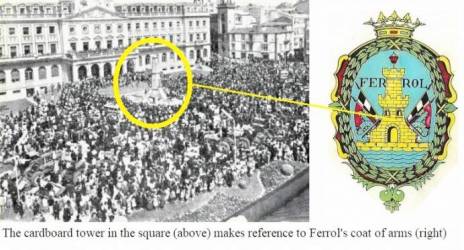
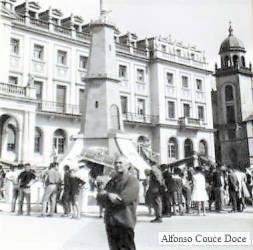
The above photograph comes from Bazan, 22, page 31. Ferrol's coat of arms comes from this webpage.
Bazan, 22, page 31, is entitled, "The Great Event of September 2." To comprehend the event's significance the reader must recall the dichotomy of Ferrol City addressed in the Introduction. Ferrol is a "Castilian" city emplaced in a Galician milieu. This "Day of Ferrol City and County," first celebrated on September 2, 1962, was a public official statement that the Castilian kernel (the city) could not ignore the Galician stalk (the county).
Bazan, 22, exalts the occasion this way,
Our Magazine could not silence such an outstanding event. Several reasons demand it, a few of an affectionate tenor, such as the fact that a high number of producers enrolled in the rank and file of the Company resides in those nuclei of population that border the estuary.No one can deny the reality of the Ferrolian county as a natural geographical unit. It is not an artifice created for political or administrative purposes, based merely on the physical proximity of the men and territories that embody it. ... Rather it constitutes one whole laced firmly with the close bonds of interdependence ... family ties ... and shared material and spiritual interests.
On February 23, 2017, Enrique Barrera Beitia wrote this article for the online newspaper, Galicia Ártabra, which sheds light on the soft political resistance that underlay this celebration of the "Day of Ferrol City and County."
According to Beitia's article the provincial governor of those days handpicked Ferrol's mayor and one third of the aldermen; another third of aldermen was picked by the state-run union and the remainder was elected by Ferrolian heads of family. This last third, nicknamed "Third of the Families," allowed a few "independent" and closely monitored aldermen to enter Town Hall. In the year 1960 an alderman so elected was the forensic pathologist Alfonso Couce Doce (1928-2015). He was notorious for treating poor people free of charge at his private clinic. Furthermore, according to La Voz de Galicia (September 3, 2015) Couce also secretly treated and cured those workers shot on March 10, 1972, who managed to evade the police and reach his dispensary. This alderman conceived the "Day of Ferrol City and County" on September 2, 1962. That day the Galician term, Ferrolterra, (lit. land of Ferrol) came into being officially.
Returning to Beitia's article, Couce headed a victorious three-man slate in the 1964 election of the "Third of the Families." His two political partners were a conservative lawyer and a philo-socialist. The secret police detected the presence of Comisiones Obreras in the slate's list of scrutineers and began to shadow Couce who resigned in 1968 after rating an official post of forensic doctor.
The victorious "Third of the Families" candidature of the year 1968 mustered a newspaperman and two other men with socialist ideas, one of whom was Bazan's head of the Steel Management Office. The civil governor, aware of their socialist leaning, tolerated the newcomers but replaced the Falangist slate with a contrived civilian one that would counterpose them.
The winning candidature of the year 1971 convened a Bazan worker member of HOAC (Workingman's Brotherhood of Catholic Action) a female member of JOC (Christian Workers Youth) and a local retailer. The three had a good relationship with the leftists of Ferrol and their candidature spurred many Bazan workers to vote for the first time.
Bazan, 21, provides on pages 63-66 a calendar of the religious activities in which Bazan-Ferrol was involved during the year 1962.
Bazan, 21, page 79, carries the following bit of news.
The Basque shepherd is a popular character of the U.S. pasturelands. A hundred and fifty Basque shepherds take care of three hundred thousand sheep in California's San Joaquin Valley. Nine hundred and fifty are contracted by the Western Range Association. Their nominal monthly salary is $180, but it generally creeps over $200 and rises to $255 in Nevada due to the harshness of the climate. They enjoy two weeks of holidays a year. Ninety-one shepherds returned to Spain last year with total savings of 30,000,000 Pesetas. Note: "Last year" of course was 1961 (End of Note).
The Reporter Was An Executive Secretary of Bazan-Ferrol. On page 32 of Bazan, 13, October-December 1959, Perez announces her inception of a Woman's Page in the magazine and boasts being the most capable to do the task "because let us be frank: it is time to reveal that a woman skulks behind these discreet initials present in the letters so well-known to Management." Note: Those initials were D. P. L. (End of Note).
She was motivated to create the Woman's Page by a "remote vocation to become a newspaperwoman which never gelled nor was ever definitely discarded." Note: Her very first contribution to the magazine was page 27 of Bazan, 12, July-September 1959, where she reports on the international tours of the Grupo De Danzas De Ferrol (End of Note).
She wished to make the page "somewhat original" and promised "not to occupy herself with Soraya or with Princess Margaret." She added tongue in cheek, "We will start from the premise that there are more women in the world than these two ladies and Brigitte Bardot, despite what the newspapers lead one to believe." Ironically Perez affirmed in the same article that most women didn't give "three cumins" about Baudouin's marriage, but retracted herself on page 49 of Bazan, 16-17, July-December 1960, when she lauded Baudouin's marriage to the Spaniard Fabiola.
Perez's Woman's Page spanned four numbers in total: Bazan, 14, 15, 16-17, 18.
Then there was silence until Bazan, 21, September 1962,
D. P. L., our dear pal and contributor, sends the next article to us from Haifa, a beautiful city on the Israeli coast.A whim of meddlesome Cupid has deprived us of the physical presence of María Dolores Pérez Linos—Loló for further identification—so as to relocate her on the eastern shore of the Mare Nostrum [lit. "Our Sea," i.e., the Mediterranean Sea] where she has just been married by the Catholic rite last December 2 in that city's Stella Maris Church.
But her spirit remains unaltered amongst us; who said that partir c'est mourir un peu? Her agile pen takes up the charge of kindling her memory through the gift of her entertaining prose tinged now with a legitimate "saudade."
At the bringing forth of this her first collaboration from the territories of Israel we congratulate Loló from the bottom of our heart and we make fervid vows for the marriage to bestow upon her all manner of happiness.
The Editors
The following report comes from pages 86-87 of Bazan, 21. It is translated in full.
Dear readers of the Woman's Page:
Hi, pretties! A long time without parleying, but this does not mean forgetfulness, and with the greatest pleasure I resume my collaboration, now "transmediterranean," a term that goes divinely in the Magazine of a Shipbuilding Company. And obviously it seems proper to start by telling you a little about Haifa, for if I don't, it doesn't even seem I'm here.
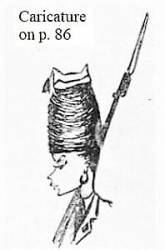
I hold to the opinion that if a song ever hit the nail on the head it has to be that one which says, "Nowhere like in Spain." Yes, I know that we are always complaining over there about how everything is so expensive, that all the effort to save money is futile, and that if it weren't for the overtime payouts we'd always be under the weather, and so on and so forth. But I would like you to see what it's like to go shopping here. You take the wallet full of these oversized banknotes that circulate in Israel and you figure that you can afford to buy minimum an automobile, but what transpires after you've done all your shopping is that you are left without car or enough money to pay the bus fare.
Setting aside the high cost of living, and setting aside the fact that it does not rain even by a stroke of luck in the summer and that it is a stroke of luck when it does not rain in the winter, Haifa is a gorgeous city replete with trees and gardens every which way (length, beam, overall height and draft, as everybody knows).
Exceptionally groomed due to the contribution of...well...due to the contribution of taxpayers as is true everywhere (and here more so), but besides these, to the efficient, invisible, ubiquitous Israeli police, always on the ball, and it is also due (be amazed!) to the excellent civic education of the population, the children especially. This term, "civic," has for us the connotation of a procession in honour of the Marqués de Amboage and smacks of cliché, but it is not a trifle. Note: Ramón Plá y Monge the Marquis de Amboage (1823-1893) was a Ferrolian emigrant to Cuba who became rich and donated a third of his fortune to the "truly poor" citizens of Ferrol and to the purchase of supernumerary exemptions for draftees originating from impoverished Galician families (End of Note).
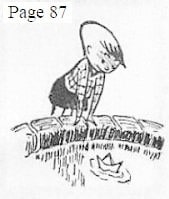
The children of this country do not ever pick a flower or trash a garden although playing on park grass is allowed and includes wading barefoot in some park ponds during the summer. You will of course quip, "And with such a disciplined citizenry, what need is there of that admirable police?" Ah, if Haifa be a hill, not every plant growing on it is oregano; 16,000 Arabs dwell in it...
Something I like seeing when I venture out early in the morning, which I do when it's strictly unavoidable because getting up early is baneful despite what the hygienists tell us—does the refrain not say, "Be in bed by ten o'clock"? Note: Perez's humorous bend; the Spanish refrain enjoins being in bed by 10:00 PM but here Perez advises being in bed by 10:00 AM (End of Note).
Well, proceeding, something I like to watch is children directing traffic in front of their school until the smaller pupils have all entered. The children are not invested with the authority to fine, but the grown-ups obey them as they do genuine traffic police, and this is an excellent apprenticeship for the kids.
Boys and girls and young ladies mark time in drills instead of marking the bed sheets of a set; there is no housekeeping service here or Social Service but there is military service. They get their bedding set at an army garrison. There are no exemptions from military service except for religious motives, and the young girls who object on the grounds of an Orthodox conscience must tread carefully so as not to be caught smoking or heading to the beach on a Saturday or eating a ham sandwich because if it is ever confirmed that they do not observe the Torah and the Talmud, i's dotted, t's crossed, off they go to the Army (or Navy or Air Force, paratrooper units included) even if they have turned thirty years old...and a day.
The cooking recipes are very simple; you lift open a can for the meal, you lift open another for the dressing. Naturally the appetite is lifted most with such a diet, but no doubt cooking is made a lot simpler.
Alright, speaking seriously, since many people here were raised in very good diapers, meaning they came from European countries where cooking is an art, as it is in Spain, there are houses and even a restaurant or two where the food is very good. So I will share a recipe with you some other day.
Summarizing, the main hassle with Haifa is that although it is closer by airplane to Ferrol than Jubia was in the days of the tram, it is still a tad far. Note: "Jubia," today's Xuvia, is 7 kilometers away from Ferrol (End of Note).
The Mediterranean Sea contains more water than is suggested by a map, and I was raised on caldo de grelos (broccoli rabe stew).
Still a Galician is someone of whom it is not yet established whether he has morriña (homesickness) because he emigrates or whether he emigrates because he must have morriña to feel whole. Either way he adapts to any place and takes along his accent, his lexicon, his songs...and Spain everywhere. And that, to a very modest degree, is what this eternal friend and workmate of yours is doing here.
D. P. L.
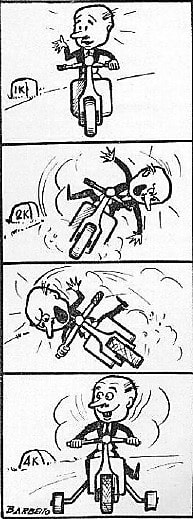 |
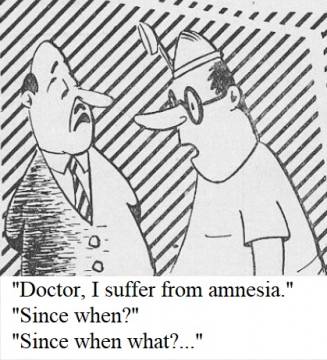 |
 |
 |
 |
|
 |
||
The main source of the information carried by this chapter is the Ferrol edition of the Santiago-based newspaper, El Correo Gallego. This journal and many others are available from the excellent digital archive, Galiciana.
Unfortunately Galiciana's archive of El Correo Gallego ends on July 31, 1963. The source of news thereafter comes primarily from Vigo-based El Pueblo Gallego, Santiago-based La Noche and from Bazan Magazine for the Year 1963.
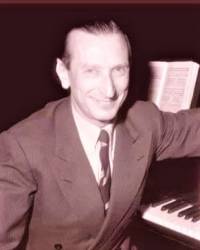
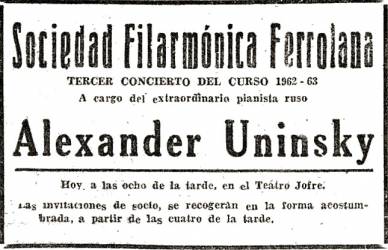
| 1. |
Manuel Pérez de Arévalo the High School's Natural Sciences teacher (see Chapter 7; November 11, 1955) was interviewed by El Correo Gallego at a cafeteria in the harbour. Arévalo was at the time the president of Town Hall's Art and Culture Commission, Ferrol's deputy mayor, a member of the Ferrolian Philharmonic, "and many other things we do not now remember," writes Jovalo the interviewer. Jovalo goes on to describe Mr. Arévalo as a renowned figure in the artistic circles of Spain, a good musician, an excellent painter, a great poet and a wonderful colloquist (see Chapter 11; March 21, 1959). The interview centers on Art, defined by Arévalo as Man's endeavour to gratify his penchant for aesthetic pleasure, "the greatest of all pleasures because its curve is the only one that is always on the rise during our short lifespan," asserts the science teacher. Despite limited spare time Arévalo managed to compose in 1962 a sonata for violin and piano, another for flute and piano and several short pieces for piano which he terms briefludes.
"In this year that ends, did you have more satisfactions than disappointments?" "I only tally the satisfactions in my life. The disappointments I foresee, they are inherent to living, so I don't consider them important." "Will this year be more fruitful than last's?" "Of course. Self-improvement is the only reason for living." "Is self-improvement easy?" "No. It requires a substantial amount of work, a lot of drive and to not be discouraged by apparent failures that come from without. Failure, the true failure, issues from within. He who goes to his defeat carries that defeat in his heart before the struggle starts." |
| 6. | The eleventh annual Epiphany Day Swim Meet organized by Regattas Nautical Club was aced by Graña, a member of the Empresa Nacional Bazán team. Second, third and fourth place went to Nautical Club swimmers. The course measured 400 meters in length. Graña clocked in at 4 m 27 s. Eleven swimmers started the race, only eight finished it. Many people watched the event. |
| 9. | Teatro Jofre was showing the 1956 French film, La Mariée Est Trop Belle," which in Spain carried the disjointed title, La Pequeña B.B. (Little B.B.). This movie had a "moral guide" rating of 3-R (on a scale of 1 to 4). This meant the movie was suitable for adults only and that it had censurable material. |
| 12. |
An enthusiastic article written by Java of El Correo Gallego looks forward to the visit of renowned pianist Alexander Uninsky (above) on Thursday the 17th.
Alexandre (sic) Uninsky. Russian pianist. He comes to El Ferrol when his fame is universal. He is a piano virtuoso. The dexterity of the fingers is beyond comprehension...His recitals arouse profound amazement...He earns first prize in 1924 at the Paris Conservatory...He wins the Chopin Award in 1932 in Poland...Uninsky has officially studied at the Kiev Conservatory; these are his first steps and his first triumphs. Triumphs with the highest credentials. This is the pianist whom Ferrolians will be lucky enough to hear...El Ferrol must don gala attire and fill the theater to capacity to hear such an admirable and admired artist. |
| 13. | In a charity drive dubbed "Operation Stogie" Ferrolians donated the record amount of 4,876 cigarettes and 303.55 Pesetas to buy tobacco for the "dear old men" in the Seniors Retirement Home, with the express aim of "gladdening the final days of these lives drawing to a close." The response of Ferrolians to the campaign demonstrated "what a large dose of charity Ferrol has for the weakest and most defenceless, like the 'dear old men' and the children." |
| 16. |
López Ramón the mayor of Ferrol inspected the construction of the city's future reservoir, Las Forcadas, and affirmed that by the summer of 1964 Ferrol will have a daily water supply of 84,000 cubic meters. Typo in the movie listings. House: Atenas. Movie: Romeo and Juliette. Moral guide rating: For persons more than 83 years old. |
| 17. |
The reservoir of the water fountain in Plaza de España had iced over when checked at 7:00 AM. The Vigo-based newspaper, El Pueblo Gallego, published a short note on Alexander Uninsky's concert at Teatro Jofre. Oddly enough the Ferrol edition of El Correo Gallego printed nothing on the matter. Apparently Uninsky played pieces of Scarlatti, Schumann, Bach and Mussorgsky, and the evening was a "great success." |
| 19. | Toxos E Froles (Gorses and Flowers) awarded the choir's gold medal to its hoariest member, José Area Corregada, at a festival in Xuvia, 4 kilometers from Ferrol. |
| 20. |
The university minstrels of A Coruña, "Spanish TV champions of 1961," performed at noon in Teatro Jofre. Five minors were arrested for breaking and entering a bookshop at 11:00 PM where they stole items valued at 1,500 Pesetas. The culprits were detained two hours later. |
| 23. |
An article by Java dwells on the figure of magician José Lorente de Castro (see the "JOSÉ LORENTE REPORTS FROM ISRAEL" section found in Chapter 10, "Bazan Magazine for the Year 1958").
Java also happened to be a primary school teacher who remembers Lorente as a "very intelligent" child skilled in Accounting and Mathematics. The columnist then summarizes Lorente's curriculum vitae, At age fourteen he qualified for an administrative assistant position in Bazan... At age 22 he earns first prize in 1949 at the Magic Congress of Barcelona... In 1955 the duo L'Orc y Juli tours Madrid, France, Portugal, Switzerland and the Middle East... King Hussein and the royal court applaud him... He hops from one country to the next and, someone says, Lorente uses a Damascus carpet for vehicle... They return home every year. They are here with us already. We hope to see them perform.Fun Corner. A professor lectures on the superiority of Man over Woman, and a female student interrupts him. "Surely you will not deny that God created Man first." "Professor, I too start doing my homework on a blotter." |
| 24. |
The same dog bit two women and a man in separate incidents. A minor stole a motorcycle; the owner found him casually sitting on it. |
| 25. | Usual projection of a movie in the High School auditorium on Sunday the 27th at 11:30 AM. |
| 26. | Three documentary films kindly ceded by the Austrian National Office of Tourism will be shown tonight at 8:15 PM in the local hall of Guardia de Franco. Their titles are, "Luminous Mountains," "Season In Carinthia" and "Summer Trip Across Austria." |
| 29. | British general cargo ship Silver Comet entered port for repairs on its voyage from the Canary Islands to England. |
| 30. | To mark the birthdate tomorrow of Concepción Arenal, after whom the High School is named, the film, La Gran Prueba (original title: Friendly Persuasion) will be shown in the school's auditorium. Starring Gary Cooper. Reel time is 7:45 PM. |
| 31. |
Due to a broken water pipe service to Ferrol halted at 1:00 PM. After intense repair work the flow of water was restored for one hour from 9:30 to 10:30 PM. Several minors caught yet again breaking and entering (a drugstore this time) will be interned in a Reformatory. |
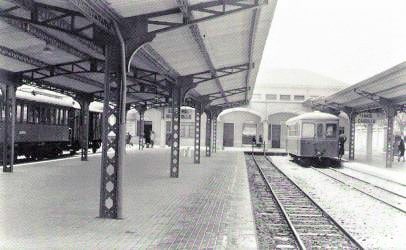
New railway station |
| 1. |
An article by Marius of El Correo Gallego blames the occurrence of serial thieving minors on the influence of foreign movies that portray rebellious youth as heroes, and on the influence of sociologists, educators and thinkers of other countries who construe the rebellion of youth as a reaction to the lack of freedom and excessive discipline at home.
The sociologists and educators of such countries have sown the seed of the most despicable type of literature and of the most stupid cinema that the seventh art has produced since the epoch of Francesca Bertini. The evil is that here—with the ambition of keeping up to date—that mawkish drivel gets translated and our movie screens project from time to time the story of the "misunderstood" juvenile delinquent living in a perfectly bourgeois and respectable home.The Philharmonic Society of Ferrol announces its next musical event: Montserrat Caballé accompanied by the pianist Pedro Vallribera will give a recital at Teatro Jofre next Thursday the 7th. Caballé has sung in Vienna, Florence, Milan, Amsterdam, Lisbon, Cologne, Hamburg, and is the first soprano of the Bremen Opera since 1959. |
| 2. |
Snow overnight. Minimum temperature: 0°C. Maximum: 2.6°C.
At midmorning on Friday (February 1) some snowflakes fell mixed with rain; not many, perhaps twenty or thirty. I took a hand out of the pocket and exposed it to the air, palm up, while I walked on Canalejas Street. Five minutes on, I gathered three snowflakes: two relatively bulky, the third one not worth much really. But I hastened to a doorway and observed them earnestly. They were very pretty. I could then apprehend the sentiments of dreamy souls even though the snowflake crop was not plentiful. Some time later it snowed shyly again. But during the overnight from Friday to Saturday the matter became frankly important and come morning the city dawned covered with the typical wintry kerchief. |
| 3. | Morning game in Bazan's court corresponding to the Second Division of the Spanish Basketball League. Final score: Bazan 64, Bosco de Vigo 44. Pardo was the star of the match. Enthusiastic fans on hand and lots of nervous excitement. |
| 10. | The minister of Public Works arrived by train at 12:00 noon to inaugurate the new railway station (above). He came accompanied by the director-general of the Spanish railways, the director-general of Hydraulic Works, the director-general of Ports and other government bureaucrats. He was greeted at the station by the mayors of Ferrol, A Coruña and twelve small municipalities, by the captain general of the maritime department, the captain general of the eighth military region, the civil governor, the bishop and other top officials. After the bishop blessed the station, the official party drove to City Hall amid the constant acclamation of the numerous public lining the route. The minister spoke a few words from the balcony to an enthusiastic crowd filling the square. Indoors a glass of Spanish wine was served. Next the group headed to a luncheon at the Grand Hotel of Tourism. Over coffee the mayor praised the minister and offered him a small present. The party drove to the new Forcadas Reservoir in the afternoon. This dam will guarantee the city's water supply finally. The minister attended Sunday Mass at 7:30 PM and went afterward to a private dinner hosted by the captain general of the maritime department. He left the city on Monday. |
| 14. |
Bachelor of Philosophy and Letters Camilo Fernández gave a lecture at 8:00 PM in the salons of Círculo Mercantil e Industrial on the topic, "Tragedy, destiny and restoration of the Jewish people." A "numerous public" was in attendance. The president of the Society introduced the speaker and Mr. Fernández then proceeded to unfold his lecture in an "easygoing and brilliant fashion." At its conclusion the dissertation garnered "a great round of applause" from the audience. Work has started in the construction of a restaurant at Copacabana Beach. Manuel Pérez de Arévalo (see January 1) wrote a lengthy article in El Correo Gallego entitled, "The voice of Montserrat Caballé at Teatro Jofre," reminiscing about the soprano's recital of February 7. He appraised Caballé's "beautiful voice" to be ideally suited for the soothing lullaby, for the nostalgic lied that evokes past loves, but also for the potent, heart-rending operatic aria. Her perfect enunciation transformed a harsh language like German into the perfect vehicle for expressing a beautiful sentiment. Caballé interpreted compositions of Mozart, Schubert, Strauss, Guridí, Rodrigo and Granados. In particular she gave an encore of Rodrigo's De Los Álamos Vengo. The concert closed with a bonus song from Madama Butterfly and another from Manon. Pedro Vallribera at the piano was the perfect gentleman, denying himself to let his professional partner shine even though he has enough talent to perform solo. Fun Corner. Scottish joke. A Scotsman spends his holidays in the countryside. One evening he is caught outdoors too late so he opts, with great sorrow, to take a taxi ride back to the inn. The cab starts off but the driver suddenly notices that the brakes are seizing up. The car whisks past the inn and the driver screams, "My brakes have failed! We are going to crash unless God helps us! I don't know what to do!" "Well, for starters," replies the Scotsman, "please stop the meter." |
| 15. |
The commandant of Ferrol's maritime province has banned the harvesting of Palourde clams, pullet carpet shells, venus clams, common cockles, variegated scallops and St. James shells between March 1 and October 31. Teatro Jofre was showing the 1961 Western comedy, The Second Time Around, which in Spain carried the disjointed title, Sola Ante El Peligro (Alone In The Face of Danger). This movie had a "moral guide" rating of 3 (on a scale of 1 to 4). This meant the movie was suitable for adults only. The Forcadas Reservoir is expected to be completed by the summer of 1964. The current pace of construction is brisk. Two shifts work day and night. A lengthy article on page 5 of El Correo Gallego, Ferrol edition, furnished many technical details about the Forcadas Reservoir project. 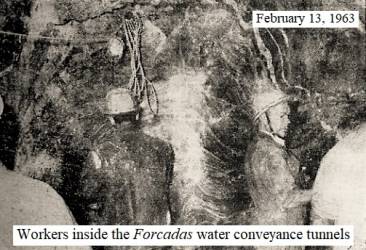
The gravity dam will be 18 meters high, 180 meters wide and its toe 15 meters thick. It will impound more than 7,000,000 cubic meters of water from the Arcadas River in the municipality of Valdoviño. The spillway channel water will be piped through underground tunnels (photograph on the left) to a treatment plant located eight kilometers away in Catabois. The treatment plant will have four storage tanks with 40,000 metric tons total capacity. A flocculation tank will add aluminum sulfate to the water to trigger the coagulation of microscopic impurities. Those coagulants plus other solid particles will next settle to the bottom of a sedimentation tank. Dirt-free liquid near the surface will go to a filtration tank where chlorination and other chemicals sterilize the water. "The water treatment plant uses the most modern technology; the filters it requires can be cleaned frequently and easily." The Forcadas project guarantees a daily supply of 350 litres per person for an overall consumer base of more than 200,000 people. Other News. Radio Ferrol will soon be broadcasting a musical scripted by the president of "Toxos E Froles" entitled, "Figueiral Figueirido," which verses on the late eighth-century legend of five brothers who rescued their sisters from Moorish kidnappers in the parish of Figueroa. |
| 16. |
Today at 8:00 PM Deputy Mayor Manuel Pérez de Arévalo will propound his own philosophical theory of Art in a conference entitled, "The temporal evolution of the arts' perspective down through the ages," at the Delegación Provincial de Información y Turismo in Corunna. This evening at 8:30 PM Bazan hosts the game between Concepción Arenal and Orense C.B. corresponding to the Second Division of the Spanish Basketball League. Meantime Bazan's team travels to Vigo this afternoon and plays Estudiantes tomorrow (score: Estudiantes 76, Bazan 41). Next Monday the 18th at 8:15 PM the High School will show four industrial films kindly ceded by the Italian Institute of Culture in Madrid. Ferrol 40 Years Ago. February 16, 1923. Ferrol's British colony will pay homage tonight to Mr. Spiers the engineer and director of the dockyard. The venue is the British School, situated near the Central Market. Many British citizens plan to attend to show their respect and appreciation to Mr. Spiers. |
| 18. | Grassroots soccer: Galicia de Mugardos 2, Canido de Ferrol 1. "The great rivalry made the match very interesting." |
| 19. | The noise made by a dawn thunderstorm awoke many people. A lightning bolt entered a house through its TV antenna, shattered window panes and charred wall tiles in the kitchen, but nobody was hurt. |
| 21. |
"Toxos E Froles" calls on Ferrolian youth to join the choir or any other chapter of its activities.
Paris of El Correo Gallego interviewed on page 4 a Ferrolian emigrant to Switzerland who happened to be in town, Pedro Arnosi Díaz. In March 1962 Díaz solicited a job in Switzerland through the auspices of the Spanish Delegación de Emigración in Corunna and two months later he went to work in a Swiss farm. Two hundred other Spanish emigrants to Switzerland boarded his train during the journey from Ferrol to Barcelona. All had a farm hand contract. The destination of Díaz and four other Spaniards was Sion. There he worked ten hours daily in a vineyard. 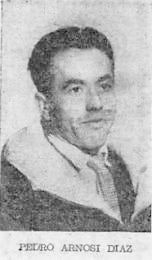
"I believe we had a bit of luck, other Spaniards work as much as sixteen hours a day, holidays included. That depends on who your boss is." "What was your salary?" "We were paid 250 Swiss francs in hand per month. The lodgings and board allowances, the accident and illness insurance, amounting to an additional 150 Swiss francs a month, were payable by the employer; the community and cantonal taxes, amounting to 16 Swiss francs, were payable by the employee." "Do you continue to work on a farm?" "No. I was able to switch over to construction work, the contracts here are six or seven months long. I went to a little town named Flanthey, about 10 kilometers from Sion. My lot improved substantially, for I am paid 750 Swiss francs per month, which enabled me to buy a scooter and a photographic camera." "Is life in Switzerland boring for a Spaniard?" "I'll speak for myself. I work from 7:00 AM to 12:00 noon and from 1:00 PM to 6:00 PM. I work Saturday mornings and once in a while afternoons. Initially life is boring. Now I attend an academy to learn French, for both Sion and Flanthey are located in the area of that language. I am literate enough to have Swiss friends who, by the way, treat me marvelously." |
| 23. |
A German training flotilla of seven warships, five corvettes and two frigates, is expected in port March 11-13. A neighbour of Plaza de España complains about the noise made by motorcycles in the early morning. Alarm clock. "You can not oversleep in El Ferrol. And what ire this provokes when it happens! We wake you up by turns in this City. First a duet of sirens every ten minutes. And if you are still sleeping, the shot of a cannon at 8:00 AM. More breaks may not be had" (Java. El Correo Gallego, page 5). |
| 28. | The common spider crab was plentiful in the bay of Ferrol this past season. Between November 25, 1962, and January 31, 1963, a fisherman and his family caught more than 1,000 specimens. The crabs' size and weight drew the attention of everyone who saw and ate them. |
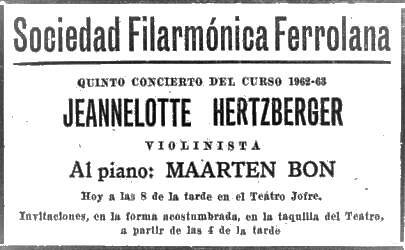
| 1. |
The Philharmonic Society of Ferrol announces its next musical event. Jeannelotte Hertzberger accompanied by pianist Maarten Bon will give a recital in Teatro Jofre next Friday the 8th. At the Seniors Retirement Home (formerly Destitute Seniors Home) a second elevator, donated by the Ministry of Gobernance, will go into service this Sunday March 3 at 1:00 PM. The bishop and local authorities will preside the inauguration. The home's first elevator was donated by Ferrol's Credit Union. |
| 2. | Street Notes. There was considerable buzz in the harbour district upon the arrival of a German vessel. "They are German," said a stander-by. "No, they are English," replied another. The truth is they were German, and when they passed through Customs it caused a certain uproar. Many curious neighbours massed about to see what was happening. In fact, nothing at all. What happened was that the Customs officers and the foreigners did not understand each other. The first ones didn't know German and the second ones Spanish. But how many curious bystanders. Even Mugardos heard the news. Note: Mugardos: a village across the bay from Ferrol (End of Note). |
| 3. |
Great expectation ahead of this afternoon's Third Division soccer game, Arsenal vs. Ferrol. Most fans predict a green-jersey win (score: Arsenal 1, Ferrol 2). Basketball: today at noon Ferrol's Concepción Arenal plays Ourense's Iris in Bazan's court (score: Concepción Arenal 52, Iris 33). |
| 5. | High School third-year student Eduardo González aced the air carbine category at the Provincial Student Shooting Championships. His tally: 15 shots, 145 points. |
| 6. | After several days of hype the movie house Capitol debuted the 1962 drama, Walk On The Wild Side, which in Spain bore the disjointed title, La Gata Negra (The Black Queen). |
| 7. |
The Chess Club informs that this Sunday March 10 at 11:00 AM former Galician champion José Alonso Leira (see July 1954) will play a simultaneous exhibition of fifteen boards at the club's locale, Café Bar Moderno. Every club member is invited to take part. More simuls are in store next month with former Spanish chess runner up Rodrigo Rodríguez as the exhibitor (photograph of the Sunday March 24 exhibition). Strong wind at night uprooted an old eucalyptus tree in the Municipal Park, toppled plywood fence panels, shattered window panes and tore off roof tiles in several houses. Town Hall convenes a photography contest for the acquisition of ten photographs destined for the Ministry of Tourism and Information in Madrid. |
| 8. |
An article written by Java of El Correo Gallego covers the Philharmonic Society's fifth concert, violinist Jeannelotte Hertzberger and pianist Maarten Bon, scheduled for tonight in Teatro Jofre at 8:00 PM. The musical duo is also a couple that married in 1959. Jeannelotte was born in Amsterdam in 1935. She formed part of Szymon Goldberg's chamber orchestra during five years. Later she studied in Paris under the direction of renowned violinist René Benedetti. In 1961 she earned the Excellence Prize at the Dutch Violinists Competition convened by the International Cultural Centre of Amsterdam, and in 1962 the Manolo Quiroga Award in the International Violin Competition summoned by the Ourense Conservatory of Music.
Tonight's concert program is: Bach: Sonata for Violin and Piano in A major. Mozart: Piano Sonata No. 6 in D major. Brahms: Scherzo from F.A.E. Sonata. César Franck: Sonata for Violin and Piano in A major. Stravinsky: Ballad and Russian Song. Tomorrow at 7:30 PM the basketball court of Bazan will host the game between Ferrolian rivals Bazán and Concepción Arenal.An eight-year-old girl was struck on her right heel by an air gun pellet. |
| 9. |
A 45-year-old man and a woman suffered serious head or knee injuries in separate incidents after falling on the pavement due to the sidewalks' disrepair; both were treated at the Emergency Clinic. Note: This is still a problem in certain parts of the city (End of Note). A 51-year-old man was found dead at 10:00 AM in his establishment, throat slit. The circumstances of his death are unknown. |
| 10. |
Yesterday's heavy rain pooled deep in a construction site opposite the house where I, my two brothers and parents dwelled. Our address was Rochel Street, number 5, 1st floor.
The depth of the rainwater pond was so remarkable that FOTO ARJO took a photograph of the spectacle (below, right) and inadvertently took a picture of the flat where we dwelled (yellow arrow). My parents' bedroom faced the street and had three hung windows clearly visible on the photograph. The flat had an attic as well; my Dad set up a makeshift drafting table there. The ground floor was occupied by a tiny shoe store. Note: My oldest brother has corrected and added to my initial description (End of Note) 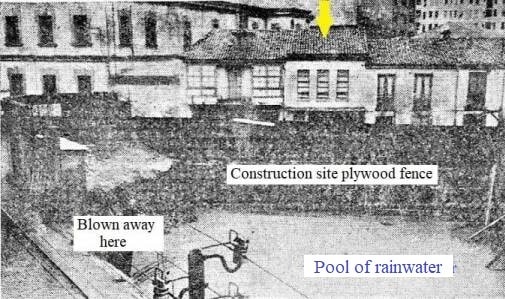
The ground floor of the house to our left in the photograph was a bar named "El Ariete" (I could be mistaken) which attracted many flies particularly during warm weather. Then they spilled over into our flat. Housefly sticky catcher tape was our response. The bar's owner was also our landlord. He and his sister lived in the house immediately to the right from the photograph's perspective; they had a big hunting dog, white, shaggy, advanced in years, named "Bren." In the next house down the street there lived a family whose patriarch had been repressed after the outbreak of the Spanish Civil War. At the top of our street loomed an old Army sappers' garrison, clearly visible, which sometimes doubled as a prison. A field of orchards spread out behind the row of houses lining the street; there were family vegetable gardens, an apple tree, a pear tree and a lemon tree. I remember a tall tree directly behind our house; its upper foliage is visible on the photograph. Out of the flooded construction site eventually emerged this building, but I was not around when that happened. |
| 12. | Fun Corner. A passerby on a deserted Chicago street is approached by a stranger. "Excuse me," says the stranger, "have you seen a policeman around here?" "No. Now that I think about it, I haven't seen one for quite a while. Is something wrong?" "Well...if you hand over your watch and wallet without any trouble everything will be all right." |
| 13. | The German flotilla that arrived from Gibraltar on Monday the 11th departed at 6:30 PM bound for Portsmouth. Many onlookers watched its parting. |
| 14. | Ferrol 40 Years Ago. March 14, 1923. The British viceconsul in the city has received an official notice that on the 24th of this month will arrive to Ferrol a Royal Navy squadron of four cruisers. Note: In fact five cruisers arrived on the 25th (End of Note). |
| 19. | To commemorate today's feast of St. Joseph, patron saint of the Seniors Retirement Home, an "extraordinary" meal will be served in the institution's dining-hall at 12:00 noon. Local authorities will be present. |
| 21. | A 27-year-old man was treated at the Emergency Clinic after receiving an axe blow when he tried to separate two men fighting. |
| 25. |
Ferrol 40 Years Ago. Sunday March 25, 1923. A Royal Navy division of five cruisers arrived at 3:30 PM. The cruisers are named Delhi, "Dusidier" (sic) "Sampson" (sic) "Drapent" (sic) and Dragon. Corrections: After doing peripheral research I suggest that the warships were most likely named Danae, Dauntless, Delhi, Dragon and Dunedin, members of the Danae or D-class light cruisers. "Sampson" was not the name of a cruiser but the surname of Sir Hubert Brand's personal secretary and paymaster, lieutenant-commander L. N. Sampson, M.V.O., O.B.E. (End of Corrections).
The commander of the division is Rear-Admiral Sir Hubert "Damp" (sic). Correction: Sir Hubert Brand, left portrait (End of Correction). The vessel captains are "Drovers" (sic) "Campbell" (sic) "Smuhct" (sic) "Ernert" (sic) and "Groven" (sic). Note: The names given are unreliable. According to the officer list provided on page 2 of issue 17338 of the New Zealander newspaper, "Star," dated May 1, 1924, the captain of H.M.S. Delhi was James M. Pipon and the captain of H.M.S. Dragon was Bernard W. M. Fairbairn (End of Note). Several fêtes are being prepared to honour the crews. The warships will depart on Wednesday March 28, 1923. |
| 27. |
Film-Club members are reminded that the movie El Puente (1959, Bernhard Wicki) will be shown in the High School auditorium at 8:00 PM this evening. Big ads in the newspaper inform that Pan Piana shops will start selling cartons of pasteurized milk on April 1. Reservations may be made. The brand is Leyma. Ferrol 40 Years Ago. March 27, 1923. The British viceconsul regaled the admiral, commanders and officers of the light cruisers in port with a luncheon at Hotel Suízo. An orchestra played the Spanish and British national anthems initially and provided musical accompaniment. During the function a British officer interpreted several English and Spanish songs at the piano. In the evening the British colony offered a party to the ships' crews in the locale of the British School. Mr. Spiers the engineer and director of Constructora Naval (which subsequently became Empresa Nacional Bazán) presided over the festivities. The water supply was shut off between 3:00 PM and 9:00 PM to enable the annual cleaning of the municipal water storage tanks. Street Notes. The municipal fire truck rushed to douse a small chimney fire in the harbour district around 7:00 PM, but the hydrant's insufficient water pressure and the lack of a fire engine made the firefighters' presence useless. "Can we imagine a fire much bigger than the flare-up of a chimney? It's better not to." |
| 28. | Nine-year-old boy was run over by a motorcycle. |
| 29. | The Philharmonic Society of Ferrol publicized tonight's sixth concert of the 1962-63 season, Prague's "Nonetto Checo," a musical group of nine professors which has offered concerts in England, Scotland, Belgium, Austria, Italy, Switzerland, Spain, Germany, Poland and the U.S.S.R. Tonight's program is Beethoven: Septet, Iša Krejcí: Divertimento, and Spohr: Grand Nonet. Venue and concert time are the customary Teatro Jofre and 8:00 PM. |
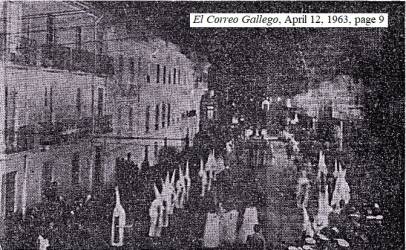
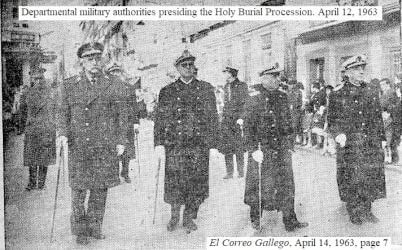
| 4. |
Ferrol's first official chess tournament opened in the salons of Casino Ferrolano (C.F. below) with the participation of two casino members, two Navy, two Círculo Mercantil (C.M. below), one Bazán and three Círculo Ferrolano de Ajedrez (C.F.A. below). Note: The ASCII 35 symbol (#) below is shorthand for "checkmate" in chess notation (End of Note).
The initial round ended as follows. Alonso (C.F.) # Pita (Navy) Segura (Bazán) # Lago (C.M.) Hermida (Navy) # Amador (C.F.) The match between Rodrigo (C.F.A.) and Mera (C.M.) was postponed. Rey Alonso (C.F.A.) # Balbino (C.F.A.) |
| 9. | An unidentified "75-year-old man" (sic) was found dead on the pavement near Teatro Jofre at 2:00 AM. Beside the corpse were found a small wallet with no I.D., a small keychain and a 9mm semiautomatic pistol. On April 12 El Correo Gallego reported that the police investigation revealed the man had on the 7th and 8th been visiting a deaf-and-dumb recruit undergoing the pre-enrolment physical exam at Navy Hospital and that around 11:00 PM on the 8th he was in a cafe-bar near Teatro Jofre where he volunteered that he had come to resolve a matter with the Navy which concerned a relative of his. On April 14 El Correo Gallego reported the dead man was a 55-year-old out-of-towner, unemployed, without fixed address. |
| 10. | Two children, three and five years old, were bitten by dogs and treated at the Emergency Clinic. |
| 11. |
Radio Ferrol will cease broadcasting from today Holy Thursday until Sunday April 14 when it will return to the airwaves. Five of Ferrol's eight movie houses followed suit. Jofre, Avenida, Renacimiento, Callao and Madrid-Paris closed their doors until Sunday. The three movie houses that remained open projected religious films. Capitol: Teresa de Jesús. Cinema: María Magdalena. Atenas: Las Rosas del Milagro. Town Hall bans downtown traffic from 10:00 AM on Holy Friday, official vehicles are exempt. |
| 13. | No newspapers on sale today. |
| 16. |
The High School announces two public conferences. On April 22 Dr. Casanova, physics professor at Santiago de Compostela University, will deliver the talk, "Inside the Atom," and on April 23 the seminar, "Biological Effects of Nuclear Radiation." Both dissertations are scheduled for 8:00 PM in the High School auditorium. Eduardo González (see March 5) finished runner up for a third consecutive year at the Spanish Junior Shooting Championship, air carbine category. His tally lagged first place by just two points. Around 1:00 PM Navy and Infantry personnel discovered the corpse of a man around 40 years old washed up on Doniños Beach. On April 18 El Correo Gallego reported the corpse was that of a 38-year-old fisherman who on the 5th had been struck and thrust overboard by the boat's winch, both legs severed. |
| 21. | Ferrol's first official chess tournament ended with an award ceremony presided by the captain general of the Maritime Department and the presidents of Casino Ferrolano and Círculo Ferrolano de Ajedrez. Champion: Former Spanish runner up Rodrigo (C.F.A.) receives the Navy Cup and a commemorative medal. Runner up: Former Galician champion Alonso (C.F.) is awarded the Casino Cup. Third place: Mera (C.M.) receives a second Casino Cup. Fourth: Rey Alonso (C.F.A.) is awarded the Bazán Cup. Fifth, sixth, seventh and eighth place went to Hermida, Pita, Segura and Amador respectively. Lago and Balbino dropped out. |
| 22. | I received the gift of a book from the High School in the Day of the Book as a reward for my high marks in the preparatory school curriculum. Another five girls and five boys were similarly rewarded. My oldest brother was also presented with a book for his high marks in the high school curriculum. Here there were fifty-two other recipients, thirteen girls and thirty-nine boys. |
| 23. | An article written by Paris of El Correo Gallego laments the great disparity in the time display of four public clocks. In the afternoon of Sunday the 21st the clock in the foyer of the new railway station showed some minutes past 11:00 AM. A double-sided illuminated clock on the pedestrian access to the railway station showed 4:07 PM on one side and 11:42 AM on the other. Paris writes, "I went to check the time displayed by the Credit Union and that clock marked 8:45 PM." Note: The Credit Union's public clock is evident on the 1965 postcard of Chapter 5, "Glimpses of the Ferrol That Was" (End of Note). |
| 25. | U.S. Ambassador "Roberto Wootward" (sic) visited the city accompanied by the American consul general in Vigo. Correction: Robert F. Woodward (End of Correction). |
| 26. |
Big advertisement on page 8 informs that Cuban-Spanish singer Antonio Machín will be in Ferrol next Tuesday the 30th in Teatro Jofre with his "Show 1963," starring Spanish songstress Antoñita Andalucía, various other artists and "the special collaboration" of Henry the twist's devil. Town Hall orders all retailers in possession of alcoholic drinks or vinegars manufactured by three Galician distillers to notify the local authorities immediately. |
| 27. | Fun Corner. Persuasive Notice. Signboard placed at an ammunitions depot: "Smoking prohibited. Violators should be prepared to exit the premises through the automatic aperture in the ceiling." |
| 28. | Growing public alarm at the rising number of fatalities across Galicia (fourteen) caused by the "drink of death" (alcoholic beverages doctored with methyl alcohol). Four Ferrolian retailers guaranteed on pages 6-7 the purity of their merchandise: José Mateo e Hijos, S.L., Bodegas Villanueva, Destilerías Rafael González Campo and Vinos Ceniza y Compañía. No victims of methyl alcohol poisoning are reported in Ferrol. |
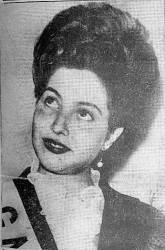
| 4. |
The P.Y.S.B.E. codder "Tornado" is expected to return today from the Banks of Newfoundland. Emma Orro will be Ferrol's representative tonight at the Miss Galicia Contest in Ourense. Kinso of El Correo Gallego interviewed her on page nine. Speculation: "Orro" is a very odd surname; it occurs in a fringe area of Galicia and in the Balearic Islands. It is non-existent in the rest of mainland Spain. According to this webpage, accessed on Wednesday March 8, 2023, only 208 Galicians living on or near the northern stretch of the Coast of Death carry it. My proposition is that "Orro" is a Spanish transliteration of the Scottish/Irish surname, "Orr," and that it originated sometime in the past with a Scottish/Irish sailor who landed or was rescued along that seashore (End of Speculation). "Were you born in Ferrol?" "Yes." "How long ago?" "Nineteen years ago." 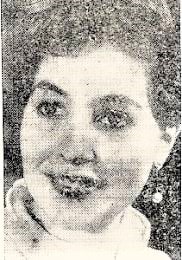
"Have you ever been in love?" "I haven't had the time yet." "What have you done until now?" "Study." "Do you like to cook?" "I love it." "Do you consider yourself Ferrol's prettiest girl?" "Not at all." "Yet they selected you." "The jury has been very gallant. Ferrol has very pretty girls." "You are no flimflam for sure. Are you heading to Orense with high hopes?" "Of course. It's only natural for youth to have high hopes." "Do you believe they will crown you 'Miss Galicia'?" "That's harder to say." "Are you afraid of the other contestants?" "They are all very pretty." "Are you spooked?" "Just a little nervous. This experience is so unusual for me." "Do your friends look at you with 'envy'?" "I don't think so." "What do men say to you?" "What men usually do." "That's not strange. Do you ponder getting married?" "Naturally." "Now that you have become the officially pretty one, do you have more suitors?" "Don't you believe it." "Some men are foolish..." "Besides studying and cooking, what other hobbies do you have?" "I read a lot; I go to the movies frequently; I like dancing..." "Do you practise any sport?" "Swimming." "Are you a soccer fan?" "No." "Would you accept a proposition to go work in the movie business or in television?" "I would have to give it a lot of thought." "Does the prospect not entice you?" "I would rather be a model." "That would not be too difficult for you" (End of Interview). Other News. The Land Use Agency of the Ministry of Housing publishes the third phase of the expropriations project for the urbanization of the Caranza outlands (page 4 of El Correo Gallego).Teatro Jofre shows the film, La Reina del Chantecler, starring Sara Montiel. "It's the hit movie that beats all records." Showtimes: 5:30 PM, 8:00 PM and 10:30 PM. This movie had a "moral guide" rating of 3-R (on a scale of 1 to 4). This meant that the movie, suitable for adults only, contained censurable material. Capitol movie house shows the film, El Día Mas Largo (The Longest Day). "Our customers proclaim the exceptional quality of this grandiose super production." Showtimes: 4:00 PM, 7:00 PM and 10:30 PM. This movie had a "moral guide" rating of 2, suitable for youth but not for children. "Kron" Circus, installed in Plaza de Sevilla, debuts today. Newspaper ad promises wild animals, clowns and a "wise elephant." |
| 5. |
The festivities programmed for the neighbourhood of Canido in honour of the Holy Cross are:
12:00 noon. The first ever official walkathon of Canido. 3:00 PM. Basketball game at Canido's city gate (photograph on the left). 5:00 PM. Pole climbing and children's games in the stone-cross square. 6:30 PM. A great party for children at the same location. 10:30 PM. Dancing party in the city gate with an "infinity" of fireworks. Java of El Correo Gallego dedicates a long article to Canido, the neighbourhood of his birth. The district has "progressed a lot." Now it has an orphanage, a kindergarden and a shelter for abandoned babies; these three centers are run by nuns. It has the Seniors Retirement Home, an institution "coddled" by Ferrolians, where "peace and relaxation reign; it is a place of rest for a life of hard work without the hope of weal"; this institution is also run by nuns. Next Java loiters by the old Canido cemetery, shut down eighteen years prior but still standing, and he writes, "A tear for the dead evaporates." "A flower on their tomb withers." "A prayer for their soul is entertained by God." Three phrases engraved on the wall of the doomed Cemetery. Your tardy agony fills us with distress. We see you in ruins.Other News. "Kron" Circus showtimes today are 4:30 PM, 7:30 PM and 10:30 PM. Tomorrow Monday two shows and good-bye. Regional Dairy Cooperative Castro advertises its pasteurized milk sold exclusively in Pan Piana shops. Daughters of Mary School pupils advertise their charity food fair. Proceeds will go "directly" to Roman Catholic missions overseas. Emma Orro, Miss Ferrol, was crowned "Miss Galicia" in Ourense despite the initial rebuff of the audience. |
| 8. | Installation of the summertime charity raffle stand has commenced on the usual spot in the downtown gardens. |
| 9. |
The city will have a Girls High School, which is not, as many believe, the one currently flanking the Boys High School but a brand new building on a separate site. Note: The Girls High School, today's Sofía Casanova High School, opened its doors in January 1967 (End of Note). Big ad on page 8 informs that Manolo Escobar will perform for one day only. Teatro Jofre, 7:45 PM and 11:00 PM. |
| 10. |
Town Hall publishes a list of vinegar manufacturers whose products were adulterated with methyl alcohol.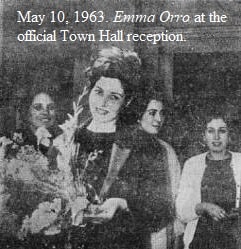
Representatives of the warehouses and makers of alcoholic drinks in Ferrol and county travelled yesterday to La Coruña for a general discussion on the loss of public confidence provoked by the spate of methyl alcohol fatalities. An official Town Hall reception was given at 1:00 PM to Emma Orro, Miss Ferrol and Miss Galicia (photograph to the right). On the 22nd she will compete for the "Miss Spain" title in Palma de Mallorca. Java on page 9 of El Correo Gallego interviewed a roving street seller of clay water jugs, lidded pots, bottles and flower vases. The merchant and his donkey had paused to take a break by Plaza de Amboage (below, right). "Your name?" "Agustín Guillén Ramos." 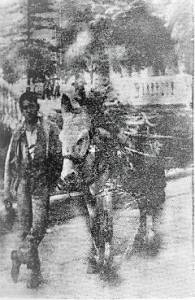
"Where are you from?" "From Salvatierra de los Barros in Badajoz (Province)." "How is business?" "I don't know what's happening, the business is faltering and getting tougher every time." "How much do the clay water jugs sell for?" "From 20 to 25 Pesetas." "Properties?" "Keeps the water fresh. It's a traditional product very much appreciated in other places. And it's aseptic." "Is it true that a small pony shot of firewater or anisette should be poured in before using?" "Those customs haven't harmed anyone to date, but the best precaution is to wash it beforehand." "Are you married?" "Yes, three months ago." "Is your wife with you?" "Not feasible, if only I could! But one has to earn dough." "Have you interrupted your honeymoon then?" "Couldn't be helped! I left in April and won't return until the last days of August." "How long do you stay in Ferrol?" "Usually between ten and twenty days." "Does the donkey have a name?" "Sevillano." "Its daily fare?" "Three kilograms of barley." "In Pesetas?" "Twenty-five." "Do you plan on having many children?" "Eighteen at least. Of course you will realize that such a question..." (End of Interview). And Java appends: I stood there looking at him, he was right answering as he did. "What questions you ask indeed, friend!," I told myself.Other News. Círculo Mercantil e Industrial is preparing a special vigil for Friday the 17th in order to commemorate the centenary of the publication of Rosalía de Castro's volume of poetry, Cantares Gallegos. The vigil will "exalt" the figure of "our most excellent poetess." Late in the afternoon a 32-year-old woman attempted suicide by throwing herself in front of a passing train on this railway bridge. The train severed her legs and she was taken in critical condition to Charity Hospital. |
| 11. |
The chorale Toxos E Froles will give a special performance tomorrow Sunday at the Seniors Retirement Home to commemorate "the 100th anniversary" (sic) of the Congregation of Sisters of Abandoned Seniors. Note: The website states that the mission of caring for abandoned seniors started in 1873 (End of Note). Tonight in the Municipal Park at 11:00 PM the first spring festival will honour "Miss Galicia 1963." A three-year-old boy was treated in the Emergency Clinic after imbibing bleach at home. |
| 12. |
Town Hall issues a warning to all property owners whose façade is left in disrepair that they will be sanctioned "severely" after a grace period of twenty working days. Fun Corner. A truck has just side-impacted a car. The policeman shows up. "Mr. Officer," says the truck driver, "the accident was unavoidable." "Why?" "The lady driving the car signaled a left turn... and she did turn left!" |
| 14. |
The president and director of I Feria de Muestras del Noroeste de España (First Exhibition of the Northwest of Spain) has invited Galician winemakers and warehouses to make a public exhibition of their alcoholic products during the 21-day fair in the month of July. Ferrol 40 Years Ago. May 14, 1923. Rainy days over the past eleven months: *1922* June=13, July=15, August=12, September=16, October=17, November=12, December=17. *1923* January=14, February=22, March=16, April=27. Total: 181 rainy days, which explains why the "grand undertaking" of assembling Ferrol's water supply has suffered so many delays: the work is halted on rainy days. |
| 15. |
Paris of El Correo Gallego notes that some vendors of wine and vinegar have taken advantage of the methyl alcohol debacle to raise the price of guaranteed goods. The Círculo Mercantil e Industrial vigil scheduled for Friday the 17th will keep to the following program: 1. "Semblances of Rosalía and emotional exegesis of her works," by José María Pérez Parallé. 2. "Plastic Impressions," by Aurora Marín and María Elena Leonardo. 3. "Rosalian Recital," by Andrés Picallo Maceiras. 4. Galician Music Interlude, by the chorale Estrelecer. 5. "Tribute of the Song," by Ramón García Rey. |
| 16. |
Olympic Mariner the last of the "Onassis" oil tankers moored in our harbour for a very long time [since 1958] will be towed away to the port of Piraeus by the newly arrived Costas Vermacos. Notes: Those "Onassis" vessels are clearly seen in the Chapter 5 photograph, "The Harbour in the Year 1958." The May 18th newspaper edition correctly altered the tugboat's name from Costas Vermacos to Vernicos Costas. The tugboat was originally named, Flying Petrel (End of Notes). The chorale Toxos E Froles will take to Radio Ferrol's airwaves tomorrow at 7:30 PM to honour Galician Letters Day. This "extraordinary" broadcast will be bilingual. It will play out from the figure of "Sar's Muse" a semblance of Galicia's literary panorama with the recital of several Rosalian poems and the chorale's rendition of some like Alborada and Negra Sombra. Note: Sar's Muse is of course Rosalía de Castro the author of "On the Banks of the River Sar" (End of Note). 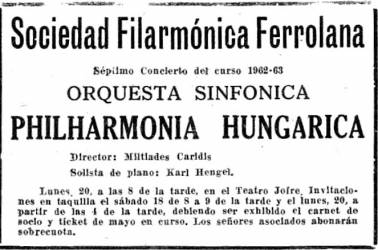
The Philharmonic Society of Ferrol closes its 1962-63 series of concerts next Monday the 20th at 8:00 PM in Teatro Jofre with Philharmonia Hungarica, Miltiades Caridis conducting and the renowned pianist Karl Engel as soloist. Philharmonia Hungarica's official program will be Béla Bartók's Hungarian Sketches, Schumann's Piano Concerto in A minor and Beethoven's Symphony No. 3, "Eroica". On page 9 Marius of El Correo Gallego interviews the director of Teatro Estudio, a troupe of High School alumni that engages in amateur theater. Last Saturday the 11th they put on Morris West's play, The Devil's Advocate, in the school's auditorium. "Satisfied with your The Devil's Advocate?" "Broadly speaking, I am satisfied with how the play came out. Personally speaking, it's a different matter." "You are not a novice in these pickles..." "No. Prior to this I directed The Living Room and aforetime I collaborated with Juan Antonio Blanco in directing The Glass Menagerie." "Give me the name of an actor or actress whom you are proudest of as a director." "I could give you many names. The truth is that everyone without exception worked stupendously. Everyone." 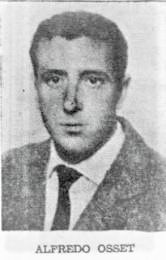
"Experienced amateurs?" "Not at all. Except for two or three everybody else stepped on a stage for the first time last Saturday." "Amazing. Did The Devil's Advocate cause you a lot of headaches?" "It's a difficult play, especially regarding its management. You probably observed the string of technical difficulties that cropped up irreparably and which we overcame despite the reduced amount of room on stage. Nevertheless the effort was worthwhile because the play is an exceptional comedy." "Tell me, Osset. Would you like to retain a large troupe without substitutes due to force majeure?" "Here in Ferrol that's almost impossible. It'd be ideal, of course. This city enjoys one advantage: willy-nilly appear always boys and girls with positive theatrical talent. In this, as in many other things, Ferrol is surprising. Anyway yes, I would like to rely on a stable troupe. It's the only way to do positive theatrical work." "Can it be done here?" "Naturally. I am sure of it." "What are the future plans of Teatro Estudio?" "To do theater. To continue doing theater for as long as we can. We try to chart a yearly work schedule. To date these things were handled somewhat helter-skelter. And we are also going to need the help of all Ferrolians in this undertaking. Especially of those who feel a firm bent for the theatrical adventure." "Will you then leave the tight space of the Institute's auditorium behind?" "Depends. If we accomplish what we pretend, why not?" "What is your next play?" "We don't know yet. I'd really like to stage Camus' Caligula, but usually we discuss beforehand the possibilities. We shall see." "Do you have confidence in the future of Teatro Estudio?" "Yes I do." |
| 17. |
Marius of El Correo Gallego explains in today's column entitled, "Día de las Letras Gallegas," (Galician Letters Day) that May 17 was designated for being the publication date in 1863 of the book of poems, Cantares Gallegos (Galician Songs).
Marius does not begrudge the almost exclusive focus of "the commemorative acts being celebrated today throughout the country's cities" on the figure of Rosalía de Castro because, he writes, she was "a great poetess whose verses have not relinquished their relevance nor will they ever do so," but future Galician Letters Day celebrations, he contends, must exalt the broader literature of the "Galician region" and not be just one more reason to remember the "extraordinary poetess alone." Galician Literature is fortunately for Galicians not Rosalía de Castro alone. In saying this we do not pretend to affirm that the birth of as outstanding a figure as the authoress of Follas Novas has not been a blessing. To deny her importance, not just in the region's literature but in Spain's or in the world's, would be ridiculous. Nevertheless Rosalía de Castro, though signifying a lot, is not everything. And there is an excessive zeal to circumscribe Galician poetry, and even what is not poetry, to the extraordinary figure of that woman. Marius goes on to reel off a list of Galicians who, he maintains, ought to be extolled in future Galician Letters dates: Mendiño, Martín Codax, Juan Rodríguez del Padrón, Benito Jerónimo Feijoo, Countess of Pardo Bazán, Manuel Curros Enríquez, Eduardo Pondal, Ramón María del Valle-Inclán, Julio Camba, Álvaro Cunqueiro, Vicente Risco, Aquilino Iglesia Alvariño. 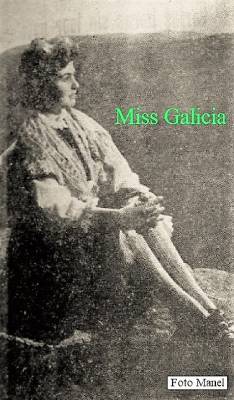
Marius ends his column thus, "With Rosalía, of course. She holds an important place in the country's literature. But she is not—fortunately, we repeat—the sole name with exclusive merits to be remembered on a date dedicated to Galician Letters." Note: Here is the list of people honoured on Galician Letters Day from 1963 to date (End of Note). El Correo Gallego carries on its back page an article written by Xan de Enfesta exclusively in the Galician language. The article entitled, "Ledicia, Memoria E Anceio," (Joy, Remembrance And Hope) informs that the Royal Galician Academy initiated the celebration of Galician Letters Day with the backing of the Ministry of Information and Tourism. The date chosen, May 17, "could not be more fitting historically and emotively," for it is the centenary of the publication of Rosalía de Castro's first book of poems, The acts of remembrance will start here in Santiago de Compostela, where her mortal remains repose in the Pantheon of Illustrious Galicians, and they will be noted especially for their emotion and significance because a large number of "generous" Galician university students will don the proceedings of this Day with sentimental and active content, a Day enthusiastically endorsed and espoused by the Faculty of Philosophy and Letters. Xan de Enfesta writes two remarkable paragraphs in memory of Ánxel Carral the great publisher of Galician literature and non-fiction written before the Spanish Civil War. Ánxel Carral was elected mayor of Santiago de Compostela in February 1936. He was executed by Spanish Nationalists that same year, A great day too, glad and sad, for the soul of Ánxel Carral who walks among us smiling and lamenting, glad because his singular and daring effort was not futile—his prodigious editorial production crams the foremost shelves of our cherished Galician bookstores—sad because doubtlessly he would long to observe with physical eyes, so sharp and down-to-earth, the progress of the Galician book in recent years; a progress that started off with his personal initiative of the Nós Printing House and which was followed some time later by Galaxia in the shape of a modern editorial business with bigger and accredited resources. Xan de Enfesta expresses the hope in the third last paragraph that the Provincial Inspections Bureau of Primary and Secondary Education will follow the example of the Ministry of Education, which introduced the study of the Galician language and literature at college level, and set a day apart for children and adolescents to familiarize themselves with Galician books at school. Thereafter it would remain for the clergy, abiding by the inspirations of the latest encyclical, Pacem In Terris, to reach the heart of their flock in their homilies for this Day by using their household language, unpretentiously and lovingly, the sweet language of Rosalía. Other News. A French destroyer is expected today at 7:00 AM to retrieve a torpedo hauled out of the sea by Spanish fishermen. The destroyer will moor at the naval base of A Graña. Note: The French vessel turned out to be the escort F-725 Victor Schoelcher; it entered port at 8:30 AM and departed with the salvaged torpedo three hours later (End of Note). |
| 18. |
El Correo Gallego carries this front page headline, "The Centenary of Cantares Gallegos Celebrated Brilliantly At The University." The accompanying article spans a significant fraction of the first two pages. It describes the official acts that accompanied Galician Letters Day in Santiago de Compostela,
The Galician Letters Day set for May 17 by the Royal Galician Language Academy had a happy and brilliant exaltation in Santiago, city so linked to the region's cultural and literary movement, city that glories in the privilege of being the custodian of the mortal remains of the redoubtable poetess, Rosalía Castro (sic), on whom focused the demonstrations of fervent love and deeply felt homage. The undergraduate students of the Department of Literature, Faculty of Philosophy and Letters, organized the events. The first one was a Mass for the soul of the poetess officiated by Ramón Taboada Vázquez in Galician at the chapel of Santo Domingo Temple where the Pantheon of Illustrious Galicians is located. After the Mass, which was followed with "singular devotion" by the congregants, a simple ceremony of depositing flowers on Rosalía's tomb took place. The second event started at 8:00 PM in the Artesonado Salon of Pazo de Fonseca. The dean and vice dean of the university, the deputy mayor, the city's military commandant, the Ministry of Information and Tourism county delegate, two professors and a member of the Galician Academy presided the literary act. After a short introduction the Academy member, "distinguished writer" Ricardo Carballo Calero, took the podium. After welcoming the authorities and the audience Mr. Calero entered upon his dissertation, "Rosalía Castro (sic) and her book, Cantares Gallegos." Mr. Calero submitted that the "Songstress of the Sar" picked the 17th of May to sign the dedication of her book to Fernán Caballero perhaps as a token of affection and gratitude to Manuel Murguía whose birthday fell on the picked date. She would thus acknowledge her debt to her husband where Cantares Gallegos is concerned. "We know that this book was printed thanks to Murguía's insistence which at length overcame the authoress' diffidence," the orator said. Ricardo Carballo Calero's dissertation continued. The structure, theme, drama and rhetoric of Cantares Gallegos imitate Trueba's "Libro de los Cantares." However what Rosalía does not borrow from Trueba is what gives her volume of poetry the rank of eminent. In Rosalía there is a social objective, an affirmation of the region, a defence of its language and an ethical thrust, absent all in Trueba's conventional and sentimental book. The notes of rugged and merry realism are the salt of Cantares Gallegos which preserve it from dissolution. Rosalía's profound psychology and the vehemence of her love for the people of her country, whom she appraises according to their reality and not in obeisance to some literaty template, craft the volume into a masterpiece of communal poetry. Ricardo Carballo Calero finished his "admirable dissertation" saying, "When Rosalía began to be evaluated in 1952 from the viewpoint of existentialism, her social vocation was displaced to the background. Today we can value her with greater justice for her extraordinary significance." The auditorium broke into a warm round of protracted applause. Continuing with the evening's central theme, "exquisite reciter" Xohana Torres (1929-2017) went up to the podium and delivered several poems from Cantares Gallegos. Her recital invested the audience in the Artesonado Salon "very deeply" and she was rewarded with prolonged applause at the conclusion of each poem read out by her melodic voice. University campus poets then ventured their own recitals dedicated to the "Songstress of the Sar." Salvador García-Bodaño (1935-2023) read his Wake of tender feelings. Carlos Casares (1941-2002) read his Words of hope for Rosalía. Arcadio López Casanova (1942-2022) read his Afternoon words for Rosalía. "These three poems...digested the love, admiration and faith in the literary and spiritual content of Rosalía Castro (sic)." The three university students garnered lengthy applause after each intervention. The dean of the university closed the act with unrestrained words of congratulation to all the participants. "The Galician Minerva," he said, "had welcomed Galicia's commotion in favour of the centenary's celebration and the university had in the same spirit obtained from higher instances the creation of a Romance Philology Department which carried implicit the study of Rosalía de Castro's language." The academic session ended amid thunderous applause. All those present at the session strode to the statue of Rosalía de Castro standing in Santiago's Horseshoe Promenade and made a simple offering of flowers. Several students read the dedicatory poems of Teixeira de Pascoaes, Luís Pimentel and Federico García Lorca. Next Arcadio López Casanova pronounced a few emotionally charged words on behalf of the session's organizers. Finally Hymn To Galicia was sung. Note: Not to confuse with Eduardo Pondal's anthem. Francisco Añón (1812-1878) wrote the letter of "Hymn To Galicia"; Galician Letters Day 1966 was dedicated to him (End of Note). El Correo Gallego carries on page 3 an article written in the Galician language by Domingo García Sabell (1908-2003). The article entitled, "Os segredos de ROSALIA," (The Secrets of Rosalía) posits five secrets ensconced in Rosalía's soul. The first secret is slyness. She is impossible to grasp. "She published her verses with apathy, without a writer's vanity, as someone mildly astracted." Rosalía is with us and yet she is absent. The second secret, according to Sabell, is a radical and ineffable solitude born of "her being possessed by the demon of creative energy," which bestowed upon her an awareness of her superiority. The third secret is anguish, melancholy. Rosalía longed to "communicate," but her remarkable poems were merely "unconnected fabric offcuts of the great tumult raging inside her soul." Over there the robust verses; here the bones and "the unfathomable mazes of passion," writes Sabell. Between them a trail no one was ever able to walk. The fourth secret is the metaphysical pull. Tenderness, outrage, nostalgia, the force of truth, the burrowing doubt. "Devoured by wolves," shouts Curros—writes Sabell—speaking truths that he himself did not suspect. Note: I have translated Curros' poem in the introductory section entitled, "Manuel Curros Enríquez and Rosalía de Castro," found here (End of Note). The fifth and final secret is a proud silence. When, on her deathbed, she orders the torching of her private correspondence and manuscripts she "exercises the lofty, elegant prerogative of a haughty, rigorous silence in sovereign fashion." That is why it behooves all of us to fall silent after reading Rosalía's verses, for silence is the obverse of the poet's human figure. In that emptiness perhaps one can grope for Rosalía who flees from us, turning her back, alone, anguished, rueful, enraged and metaphysical, her talking lips furiously shut. El Correo Gallego carries on page 4 two reports about the Galician Letters Day rites in the cities of A Coruña and Lugo. In A Coruña the plenum of the Royal Galician Academy together with Serrano Castilla the provincial delegate of the Ministry of Information and Tourism laid a laurel wreath before the grave of Manuel Murguía the husband of Rosalía de Castro. Martínez Risco (1899-1977) pronounced a brief eulogy. Next the entire party went to the home of 92-year-old Gala Murguía (1871-1964) and Mr. Castilla congratulated the only surviving daughter of Rosalía de Castro on his own behalf and the ministry's. In Lugo City the Provincial Palace hosted a literary conference in the evening. Civilian, military and religious authorities presided it. The many interventions conferred "great brilliance" to it. Mr. Castilla wrapped up the event. Other News. Cruiser Almirante Cervera departed on a mission to Malta escorted by two minelayers and two frigates. 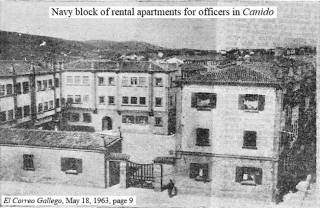
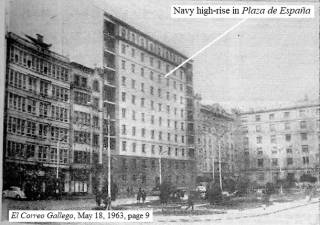
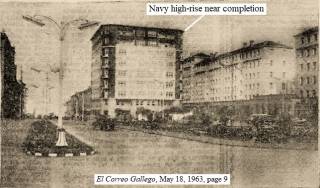
Housing for Navy officers in FerrolThe Ministry of the Navy corporation for the construction of rental housing consigned to naval officers has built 556 apartments in Ferrol City, 33 are near completion and 470 on the drafting board. The Navy buildings are a block of three-storey apartments in Canido (above, left), a high-rise in Plaza de España (above, center) and another nearing completion at the same location (above, right) with inauguration set for July of this year. |
| 19. |
Town Hall contracts Italian singer Torrebruno for the upcoming I Feria de Muestras del Noroeste de España (First Exhibition of the Northwest of Spain). Scheduled power outage in the vicinity of Plaza de España between 9:00 and 11:30 AM for repairs in the grid. |
| 21. | Soccer. In the round robin tourney of promotion to the Second Division of the Spanish Soccer League Ferrol was eliminated in a decisive game played against Abaran in Madrid. Ferrol was leading 2-1 when it had two players sent off the field, and Abaran tied the match before halftime. In the second half the referee expelled two more Ferrol players. With a four-man advantage Abaran had no trouble scoring two more goals. Final score: Abaran 4, Ferrol 2. |
| 22. | "Olympic Mariner" the Greek oil tanker (May 16) is back in Ferrol. The captain of tugboat Costas Vermacos decided to return after encountering strong winds by Sisargas Islands on the Coast of Death. |
| 24. |
Neighbour's Complaints. (1) Cars parked on the sidewalk force pedestrians to walk on the street with the concomitant peril. (2) Beating of rugs out of streetside windows between 10:00 AM and 12:00 noon. (3) Street water valves left open carelessly deprive the neighbours of running water for hours. The Esteiro neighbourhood will honour its patron saint, Our Lady of Sorrows, from Sunday June 2 to Sunday June 9 inclusive. The attractions will include minor and youth league soccer matches, foot races, urban trial motorcycle races, night music parties, a goldfinch competition, skyrocketing gunpowder shells, fireworks, street rounds of the naval infantry drum-and-cornet band and/or the Empresa Nacional Bazán drum-and-pipe band, a traditional meal offered to more than a thousand poor people on the 9th and an outdoor concert from noon to 2:00 PM the same day. |
| 26. |
There will be a special fête in the Seniors Retirement Home to commemorate the centenary of the arrival to Spain of the Congregation of Sisters of Abandoned Seniors (see May 11). The festivities will commence at 10:30 AM with a solemn Mass sung by the Bazan Polyphonic Choir under the direction of Reverend Manuel Perez Fanego the chaplain of the dockyard. The bishop and other authorities will be in attendance and "all Ferrolians" are invited to join them. The "120 dear old men" who lodge at the Home will "wear their Sunday best" and enjoy a "splendid meal" served and paid for by the High School students.
Notes: The May 28 newspaper edition gives two cases of seniors abandoned in Ferrol. (1) A very old lady is forsaken by her mature daughter who leaves home; a few days later a stranger shows up claiming her linen; the victim, alone, without anyone or anything, kept repeating, "Me teño que tirar afogar" (I have to jump into the sea and drown). "Then here, in the Seniors Retirement Home, happy." (2) An elderly lady gives shelter to some relatives in her own house, and in exchange for their taking better care of her, transfers ownership of the property to them, whereupon the said relatives kicked her out of the house onto the street; she sought shelter and found it with the sisters of the Seniors Retirement Home. The "authorities" who attended the special fête on the 26th were the captain general of the maritime department, the city's military governor, the acting mayor, the deputy mayor and the engineer-director of Empresa Nacional Bazán, among others. A group of "very beautiful girls" from the High School danced traditional Galician numbers accompanied by the bagpiper of Toxos E Froles; both received the loudest rounds of applause (End of Notes). Lost And Found. The following items await their owners in the Municipal Police Headquarters depository: a children's jersey, a bicycle, two pairs of prescription glasses, a gentleman's pair of trousers, a lady's umbrella, several keys.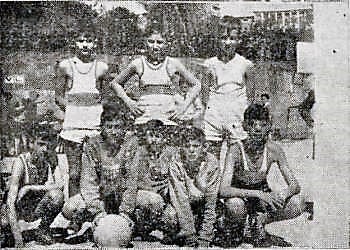
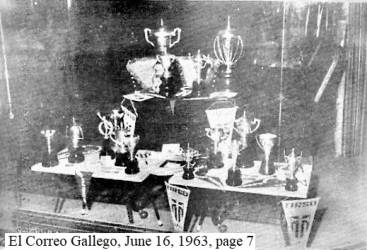
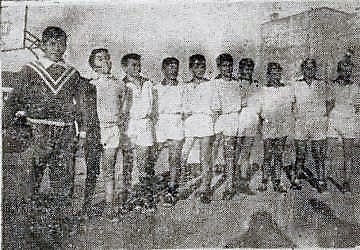
Rival school Tirso de Molina: 1963 provincial championsThe provincial championships of A Coruña were contested by eighteen schools. Ferrol's Tirso de Molina aced the competitions of table tennis, athletics, category B (14-15 years old) handball and category A (10-13 years old) handball and basketball. |
| 29. |
The High School. Students with a scholarship may pick up the third-trimester stipend today in the school's offices; the apposite list published the name of twenty-six boys and sixteen girls. Exams for new students who paid the entrance fee are slated for Saturday June 1, Monday June 3 and Tuesday June 4; the exams will consist of written, oral and map-point-to tests. The downtown gardens (Cantón de Molins) require a face-lift urgently. |
| 31. |
Cristo Rey School pupils will carry the figure of the Immaculate One in religious procession through city streets this afternoon. New train schedule. The express from/to Madrid arrives daily at 12:05 PM and departs five hours later at 5:10 PM. The so-called "Sanghay" (sic) arrives at 9:10 AM and departs almost thirteen hours later at 9:50 PM. Note: This "Shanghai Express" covered Spain's longest route, Vigo-A Coruña-Barcelona; the popular tag originated with this 1932 movie (End of Note). |
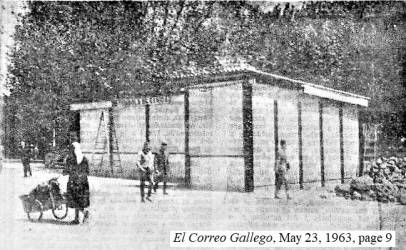
| 1. |
The summertime charity raffle stand (above) will officially open this evening at 6:00 PM following the bishop's blessing ceremony; "the authorities" will witness the act. A total of fifteen salesladies will work today's three 90-minute shifts, from 6:00 to 10:30 PM. "Leyma" brand pasteurized milk (see March 27) will be sold at the main Pan Piana shop from 6:30 AM to 10:30 PM daily and from 6:30 AM to 3:00 PM on Sundays. There are seventeen shops in the city currently, eight more are planned. Ramón Sánchez the Pan Piana C.E.O. foresees the delivery of "Leyma" milk to "cafés, cafeterias, restaurants, hotels, sanatoriums, hospitals, etc." beginning July 1. "The quality of the 'Leyma' brand," he says, "is demonstrated by the steadily rising demand in our city." |
| 2. |
Dutch tugboat "Occean" (sic) has departed taking Olympic Mariner in tow to the port of Piraeus (May 22) Note: The tugboat's name was in fact Oceaan; yes, two a's (End of Note). Codder "Santa Regina" has left for the Banks of Newfoundland. High School exams for grades 1-5 will be held June 5-8 and June 10-11. The exhibition of 32 oil paintings and 9 drawings by Ricardo Segura Torrella currently showing at the Art Salon of Town Hall has drawn many visitors and will continue until the 12th of this month; two paintings already wear the "sold" tag. Town Hall plenum approved the cession of municipal land for the construction of a Girls High School on a budget of 20,000,000 Pesetas. The land area is 10,000 square meters. The envisioned enrollment is 1,500 girls. The motion acknowledged with thanks the "enthusiastic" aid given by Mr. Victorino López González the Boys High School principal. Note: The Girls High School opened in the year 1967 (End of Note). Yesterday a 73-year-old man passed out while in the downtown gardens, he was driven to the Emergency Clinic and died there a few minutes later. |
| 4. |
Veteran Ferrolian painter Francisco Iglesias (see ARTS AND LETTERS for the year 1957) has had "great success" both in the critical reviews and in the affluence of visitors to his exhibition of fifty oil paintings in León (outside Galicia). Most paintings were sold.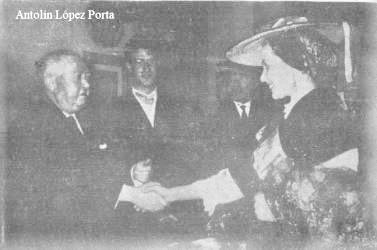
This past Sunday the 2nd the Royal Chorale "Toxos E Froles" celebrated its 49th anniversary. At 10:30 AM the society removed from their center to the cemetery to deposit flowers on the graves of the chorale's founders and of its late members. In keeping with tradition, the choir interpreted Negra Sombra to fulfill a vow and to satisfy the wish of some defunct fellows. Back in the "Toxos E Froles" locale, vice president Antolín López Porta said a few words about the commemoration and immediately received the official courtesy visit of Emma Orro, Miss Galicia 1963 (photograph on the left). She wore a traditional Galician costume and came with a Town Hall councillor, with her parents and her sister. An executive officer of the society pronounced a few words of welcome and presented her with a gift. "The act was very brief, given the special circumstances impacting the Catholic world at present." Note: Those "special circumstances" were the agony of Pope John XXIII who died the following day, June 3 (End of Note). Today at 8:00 PM the co-cathedral hosted a Holy Rosary for the soul of Pope John XXIII. "The temple was full and the faithful prayed with special fervour for the eternal rest of the distinguished defunct Pope." As soon as news of the Pope's demise reached Ferrol flags were ordered flown at half mast in official buildings and on warships. A "great number of houses" hanged mourning bows on their fronts. All school classes were cancelled and all civil servants or military officials were ordered to wear a black armband or a black necktie. |
| 5. |
Navy Command Headquarters has organized a solemn funeral today for the eternal rest of Pope John XXIII; it will be held in San Francisco Church at 12:00 noon. The authorities and committees of the Armed Forces will attend. The general public is invited. "Olympic Mariner" the Greek oil tanker (May 16) was still anchored in the Ferrolian bay. The captain of the Dutch tugboat has postponed the departure in view of the strong winds prevailing. |
| 6. |
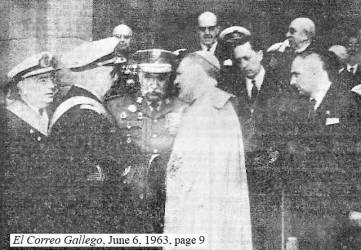 Some personalities present at yesterday's solemn funeral for the eternal rest of Pope John XXIII were: the bishop, the captain general of the maritime department, the mayor and a former mayor, the city's military governor, the magistrate-judge of the city, the rear admiral chairman of the Chiefs of Staff, the general of the Engineer Corps, the county director of the National Movement, the principal of the Boys High School, the president of the Chamber of Commerce, the dean of the diplomatic corps, the president of the port authority for public works, the engineer vice director of Empresa Nacional Bazán, the director of the Post Office, the director of the Telegraph Office, the General Police Department commissar, the director of the Bank of Spain, large numbers of military and diocesan clergy, many commanders and officers of the Navy and the Army.
Some personalities present at yesterday's solemn funeral for the eternal rest of Pope John XXIII were: the bishop, the captain general of the maritime department, the mayor and a former mayor, the city's military governor, the magistrate-judge of the city, the rear admiral chairman of the Chiefs of Staff, the general of the Engineer Corps, the county director of the National Movement, the principal of the Boys High School, the president of the Chamber of Commerce, the dean of the diplomatic corps, the president of the port authority for public works, the engineer vice director of Empresa Nacional Bazán, the director of the Post Office, the director of the Telegraph Office, the General Police Department commissar, the director of the Bank of Spain, large numbers of military and diocesan clergy, many commanders and officers of the Navy and the Army.
"The chapel orchestra performed under the baton of señor Pérez Fanego...Many faithful filled the sumptuous temple...the act turned out very solemn." |
| 7. |
Renacimiento Theatre shows the 1960 film, Tall Story, which in Spain bore the disjointed title, Me Casaré Contigo (I Shall Marry You). "Enjoy life seeing this cheerful, funny and very fresh movie." Showtimes: 5:45 PM, 8:00 PM and 11:00 PM. This movie had a "moral guide" rating of 3, suitable for adults only. On page 9 Marius of El Correo Gallego interviewed Ferrolian painter Ricardo Segura Torrella at the gallery of Town Hall where his paintings were exhibited (June 2). A digest of the interview follows. "They say that you are a difficult painter. Is it true?" "I don't know. Sometimes I paint with relative ease." "You avoid the question, I'll make it explicit. Many people assert that you don't paint for the majority of viewers. What do you say?" "I agree with those people." "Are they right?" "Yes, they are. But so am I. And the immense minority of viewers." "Then is Art not for everyone?" "For everyone who loves it sincerely." "Are you sincere?" "I try to be. I try to be it with all my strength." 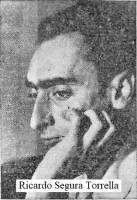
"Are you an absolutely figurative painter?" "Look, I'm a painter. Whether I am figurative or not, I suppose that nobody would take my exhibition's collection of cocks for bicycles or for young people sewing by the light of a window." "I guess not. What role does reality play in your paintings?" "Its own. It's there and I'm here, you understand? We have known each other for a long time and I appreciate it a lot. What happens is that I am the one of the two who paints. I can not act out reality. That would be an usurpation of faculties." "Then don't you think the painter must be true to life?" "Look. The painter must be true to himself. He lives in front of reality and he must build his own expressive world. If he fails to do that, he fails without remedy." "What is an ism, Segura my friend?" "That's a question for a critic, not a painter. Nevertheless, without any compromise, without definition as the goal, I would say that an ism is something like the shape and colour of a feminine attire. It exists as a property of the attire, but the attire is what matters." "You are accused of being loury. Defend yourself." "I don't wish to." "Why?" "Because it would be granting some verity to the accusation. It'd be a different matter if somebody were to accuse me of bastardizing Art, of lack of artistic honesty, of frivolity." "Would you defend yourself then?" "Perhaps. Above all I would take the accusations into consideration for they would impinge on my artistic work." "Do the critics treat you well or poorly?" "This is what happens to me. Either they treat me very well or they trash me mercilessly. There is no middle ground." "How do you view those who treat you bad?" "That they must have their reasons for doing so. An artist is subject to criticism. Furthermore I believe that Art would molder without authentic, rigorous criticism. What happens is that criticism is in multiple occasions simply subjective opinion." "Is subjective opinion useless?" "Not as opinion, but yes as criticism." "To conclude: are you satisfied with the work on exhibit here?" "With some paintings, yes. With others, not as much. Do you, as a visitor, like what you see hanging here on the walls?" "That's a question for a subjective opiner, perhaps for a critic, but not for a newspaperman..." (End of Interview). |
| 8. |
The Dutch tugboat Oceaan left port again yesterday with oil tanker Olympic Mariner in tow (June 2).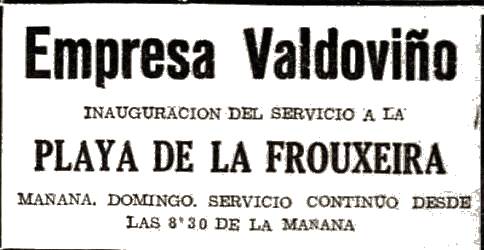 A man attempted to stab himself to death shortly after verifying the death of his 28-year-old wife. He was taken to Charity Hospital in serious condition around 4:00 AM Thursday the 6th.
A man attempted to stab himself to death shortly after verifying the death of his 28-year-old wife. He was taken to Charity Hospital in serious condition around 4:00 AM Thursday the 6th.Private bus company Empresa Valdoviño inaugurates its passenger service to Frouxeira Beach (Chapter 24). The advertisement to the right announces that buses will run from 8:30 AM tomorrow Sunday. The Third Annual Children's Pavement Painting Contest will take place tomorrow at 10:00 AM on Town Hall square. The original date, June 2, had to be dropped because of bad weather. Four pupils, two boys and two girls, are requested to pick up the first and second instalment of their scholarship between 11:00 AM and 1:00 PM today in the High School's offices. |
| 9. |
Next Thursday the 13th is National Charity Day. Ferrolians! Thanks to your generosity last year it was possible to distribute 236 coats and 60 jackets to "our poor" to cope with the cold, 127 beds, 632 mattresses and 870 blankets to afford them rest from their destitution, and 69 layette wicker baskets for the same number of innocent children born into "absolute poverty." Notes: Cáritas was and is the organizer of National Charity Day. Every year the celebration falls on the Thursday of Corpus Christi Week (End of Notes).
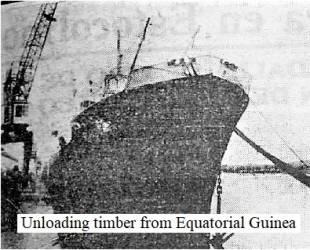
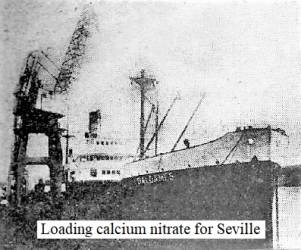
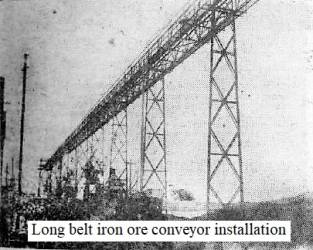
Port activity. El Correo Gallego, June 9, 1963, page 7The name of the ship unloading timber from Equatorial Guinea was Rivadeluna (above, left). The name of the ship loading fertilizer for distribution across Southern Spain was Galdames (above, centre). Renacimiento Theatre shows Ahí Va Otro Recluta (see Chapter 20, "Four Spanish Movies I Recall Watching As A Child") at 4:00 PM as a special children's matinée ahead of the main adult feature film, Tall Story (June 7). Page 7 of El Correo Gallego carries an interesting article by Java under the headline, "A bygone theater: The New England"; but the report is way too short and rests mainly on the reminiscences of Julio López Garrote interviewed below (irrelevant content excised). "Let's see, Julio. When was the New England built?" "Let's say that at the start of the century so the error will be less apparent. Or in 1895." "Where?" "Where the Post and Telegraph Office is today, beside Cantón de Molins." "Who were the owners?" Julio gives the names of four Spanish businessmen. "Do you know who decorated it?" "Angel Fernández Torres, poet and electrician. He painted an image of the Firth of Ferrol on the fire curtain and he also did some backdrops" (End of Interview). |
| 11. |
Around seventy persons felt indisposed after eating a dish prepared with canned tuna at the traditional meal offered to the poor on Sunday June 9, last day of fiestas in the Esteiro neighbourhood (see May 24). Fortunately the intoxication triggered fits of vomiting only. Many people were treated in the Emergency Clinic, including a family of six. Eduardo González Crego (March 5, April 16) broke the Category B national record at the "Absolute Provincial Championships" of A Coruña with an air carbine shooting tally of 147 out of a possible 150 points. He received a silver trophy. Second place went to a fellow High School student. Note: Category B connotes the contestants are 14-15 years old (End of Note). The summertime charity raffle stand was shut down during the last few days because of "some deficiencies" spotted on the raffle tickets sent in from Valencia (southeastern Spain). Note: The stand reopened on this day (End of Note). Town Hall seeks an electrician's report on fixing the luminous fountain in Plaza de España (see July 16, 1961). Yesterday Emma Orro, Miss Galicia 1963, joined Toxos E Froles as a member of the choir. |
| 13. | The traditional Corpus Christi procession marched through the city (see Chapter 3, "Religion In the Streets"). A unit of Artillery, two Navy battalions and two Army battalions lined the route (cf. the 1954 procession described in Chapter 2, "The Military"). |
| 17. | The water supply to the city was shut off at 3:00 PM. |
| 19. |
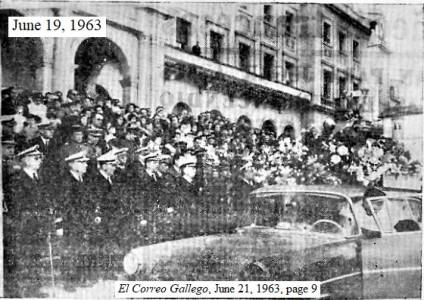
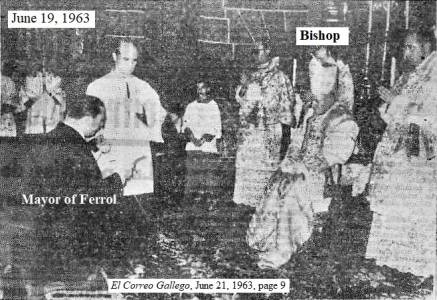
The incorrupt arm of St. Teresa comes to FerrolThe incorrupt arm of saint Teresa de Ávila will arrive to Ferrol at 7:30 PM. The "Sacred Relic" will be received with the military honours of a captain general at Plaza de Armas (Town Hall square). Authorities civilian and military plus the bishop of the diocese will welcome the relic. Subsequently a religious procession will escort it to the co-cathedral of San Julián. |
| 20. |
Special public transit service to Copacabana Beach and to the I Feria de Muestras del Noroeste de España (First Exhibition of the Northwest of Spain) will begin today. There will be twelve daily runs on the hours from Plaza de España to the Exhibition site; return trips set out on the half hours. Note: The I Feria de Muestras del Noroeste de España opened on July 10 (End of Note). Today Teatro Jofre hosts a "Charity festival" starring "outstanding local figures"; popular Radio Ferrol announcer Benito Vázquez will act as the emcee. All proceeds go to Cáritas. Two shows: 7:30 PM, 11:00 PM. Note: The festival attracted "many charitable customers" who applauded the local performers enthusiastically (End of Note). |
| 21. |
Codder Regañón left for the Banks of Newfoundland. Jovalo of El Correo Gallego laments in his column that many Ferrolians are ill-mannered even when out for a walk; he took humorously the watching of a movie "two days ago" whose reels the projectionist jumbled. Some Frenchmen on their way out of Ferrol yesterday asked if there was another route other than Carretera de Castilla. Note: Potholes galore (End of Note). Tomorrow Saturday there will be an exhibition of songbirds at 6:30 PM in Cantón de Molins (the downtown gardens). The contest is open exclusively to boys and girls. No prizes are offered, but participants will receive a bag of sweets for every bird they bring. Ferrol 40 Years Ago. June 21, 1923. The Navy commandant overseeing the ferry service has notified commuters and ferry crews that anybody employing foul language when women and children are on board will be sanctioned. |
| 22. |
Jovalo of El Correo Gallego deplores in today's column that street beggary is "picking up again." "There have appeared all of a sudden very grubby children, pesky like houseflies, who harass people at the entrance to the ice cream parlors." He also delivers the protest of "more than one Ferrolian butcher" who complains that the water supply to the municipal slaughterhouse is shut off at 11:00 AM or 12:00 noon, precisely when high pressure is needed to wash the carcasses down. Renacimiento Theatre shows the 1958 film, King Creole, starring Elvis Presley and Carolyn Jones. Showtimes: 5:45 PM, 8:00 PM and 11:00 PM. "Moral guide" rating: 3, suitable for adults. Cinema shows the 1959 Mexican film, Yo...El Aventurero, starring Antonio Aguilar. Showtimes: 4:00 PM, 6:00 PM, 8:00 PM and 11:00 PM. |
| 25. |
12-year-old boy fell from a pine tree near his home in the Caranza outskirts. He was taken to San Javier Clinic in critical condition and transferred to Charity Hospital after first aid treatment. A 64-year-old pedestrian suffered a cerebral coma and was carried to the Emergency Clinic. Another 12-year-old boy suffered first, second and third degree burns jumping over a bonfire on St. John's Eve (June 23). |
| 26. |
The following artists are under contract for next month's I Feria de Muestras del Noroeste de España (First Exhibition of the Northwest of Spain).
|
| 28. |
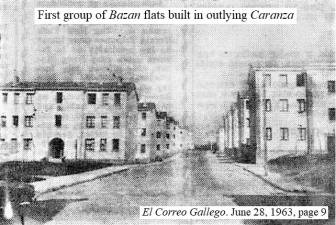
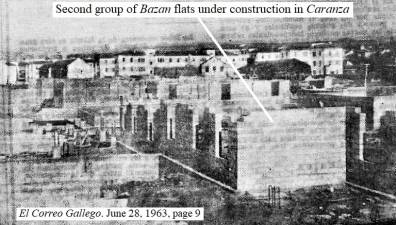
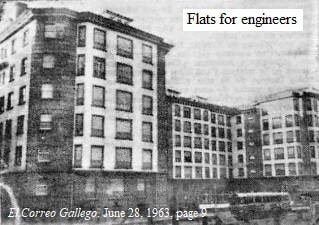
Housing for Bazan personnel in FerrolEmpresa Nacional Bazán is undertaking a big construction project of rental housing for its personnel. The first phase of the project on the Caranza brushland was completed some time ago (above, left). The second phase is currently underway (above, center). The "magnificent" building (above, right) located close to Manuel Rivera Stadium and designated for dockyard "executives" and their families has a parking lot and a children's playground. Note: Caranza flats were rented out mainly to workers and their families; higher-echelon employees such as draftsmen eventually moved into Bazan rental flats located on the south side of the railway station. The "magnificent" building alluded to above housed Bazan engineers mainly (End of Note). Java the reporter of the article reproduces a conversation with a neighbour of the first group of Caranza rental flats who asked to remain anonymous. "How many homes were built in this neighbourhood?" "In round numbers I think it's three hundred flats." "How is the interior?" "Fine. They are two and three stories high, not counting the ground floor. They lack individual gardens." "Then you do have some reservations?" "Not at all. What I mean to say is that all the massive constructions done in Ferrol are enormous blocks of houses; done probably to maximize land development. A garden-city is needed. This doesn't mean there are no green spaces. They stick to the walls and wet them more. However this is not an annoying problem because Ferrol is a humid place for most of the year." "What other pressing needs does the neighbourhood have?" "Before I forget I'll tell you that I would like to highlight the tidiness and cleanliness of this neighbourhood. We need telephone service, mail delivery, an avenue linking us to the city, a marketplace and a bigger church, the one Bazan built is too small" (End of Interview). |
| 30. |
A year ago Town Hall promised to clear the tram tracks to the harbour, but they remain there. Note: Tram service ended July 2, 1961 (End of Note). Fun Corner. "What? Are you sporting a beard now?" "No, but I have a wife, three daughters and just one bathroom." Bonus joke. "Mommy, the thermometer keeps rising and falling." "That can't be. Where did you place it?" "In the elevator." |
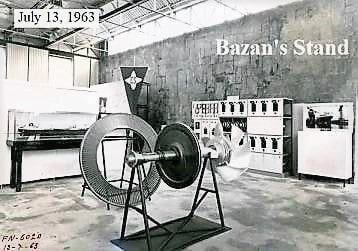
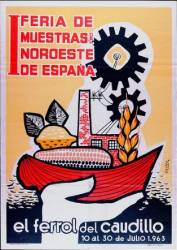
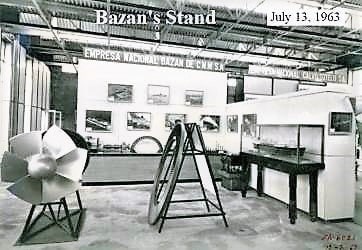
I Feria de Muestras del Noroeste de España (First Exhibition of the Northwest of Spain) |
| 2. | Twin Basque codders Bahía de Pasajes and Abra de Bilbao unloaded their cargo of Newfoundland codfish in Ferrol. |
| 4. |
Victorino López González has been reappointed principal of the High School. "His past performance is respected and admired by Ferrolian public opinion."
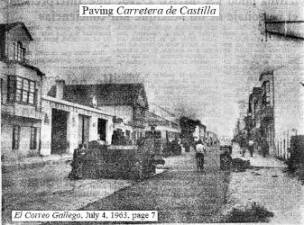
Repaving the road at long last |
| 7. |
Bazan's Polyphonic Chorale together with a military band will give a free concert on the 11th at the Exhibition grounds. Scheduled concert time is 8:30 PM.
Marius of El Correo Gallego tackles the controversial dance known as the twist in his weekly column. The topic was prompted by receipt of a neighbour's letter complaining that some youngsters danced the twist at 3:00 AM without regard for others' need to sleep. Marius sympathizes with the letter's grievance but disagrees with the writer's assertion that the twist is a "dance weapon that will destroy our youth." "The evil," replies Marius in the column, "is not the twist but the era that created it...the dance that gives both you and I a headache is a symptom...not the malady destroying certain human values...Pray with me that the twist may be a benign distemper which will give way to a lengthy and invigorating convalescence." |
| 9. | Java of El Correo Gallego analyzes the past week, Sunday to Sunday, and makes the following observations. Sunday June 30: The downtown gardens (Cantón de Molins) are inexplicably deserted, almost without artificial lighting at night, yet in the old days this was where Ferrolians used to promenade. Wednesday: "We need a full revision of the current charity school norms, all boys must be trained to be something more than busboys and all girls more than seamstresses." Thursday: The machine paving Carretera de Castilla has broken down by the soccer stadium, two workers are fixing it, neighbours say it's been like this for the last three days. Friday: Now I realize why. There is a "very significant" Public Works notice saying, "Paving termination date: August 30th." Sunday July 7: Few Bazán workers will exit the county (i.e., Ferrolterra) during the summer break, household budgets are skimpy. |
| 10. |
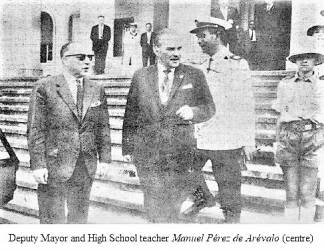
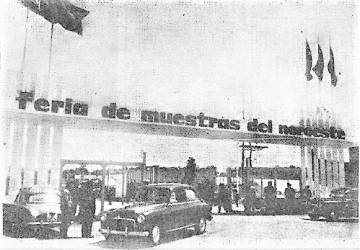
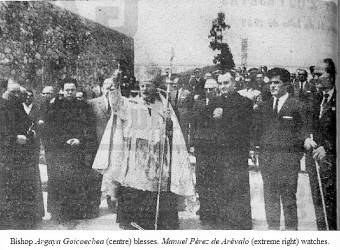
Exhibition's opening dayI Feria de Muestras del Noroeste de España (First Exhibition of the Northwest of Spain) opens. The left photograph above shows Deputy Mayor and High School teacher Manuel Pérez de Arévalo (see November 1955) welcoming the province's civil governor on the steps of Town Hall. Both headed to the railway station to greet the director general of the Trade Expansion Department of the Ministry of Industry who arrived from Madrid on the 12:00 noon express train. The party then went to the Exhibition site where the fair's director, the captain general of the maritime department, the city's military governor, the bishop and other civilian and military authorities awaited them. "The aspect of the fairgrounds was splendid under a very sunny sky and caressed by the sea breeze." Upon arrival (above, centre) and the exchange of formal greetings, the director general in charge of trade expansion together with his retinue entered the Exhibition's Events Hall. After formal speeches there by the fair's director, the deputy mayor and the visiting director general, Bishop Argaya Goicoechea blessed the fairgrounds (above, right). The visitor from Madrid and the welcoming party then proceeded to tour all the stands of the fair. "There were very good-looking young ladies in all the stands, contributing to the splendour with their beauty and their courtesy." At the conclusion of the tour the officials were invited to a "splendid" glass of Spanish wine. The group departed the Exhibition site and headed to the Municipal Park where a "splendid" banquet was served. Lengthy, lively conversation about the significance of the Exhibition relative to the problems faced by Ferrol accompanied the meal. At 4:45 PM the party left the municipal park for the railway station. There the director general of the Trade Expansion Department of the Ministry of Industry was given an affectionate send-off. Other News. The luminous fountain is back working. |
| 11. | Another mysterious dumping of what must have been a large quantity of toxic waste onto the Xuvia River provoked the death of "thousands of fish"; on Wednesday alone between 3-4 thousand kilograms of dead fish were picked up. Notes: The news appeared in the July 13th issue of El Correo Gallego. This video from the year 2022 demonstrates that the practice of dumping toxic waste onto the Xuvia River persists (End of Notes). |
| 13. |
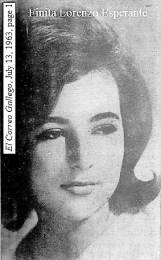 Around four thousand visitors to the Exhibition yesterday watched the joint concert by Bazan's Polyphonic Chorale and a military brass band.
Around four thousand visitors to the Exhibition yesterday watched the joint concert by Bazan's Polyphonic Chorale and a military brass band.The Exhibition's Olympic pool is now open to the public; the repair work is finished. Today at 10:30 PM the "very beautiful" Finita Lorenzo Esperante (photograph on the left) will be crowned queen of the I Feria de Muestras del Noroeste de España (First Exhibition of the Northwest of Spain). The activities scheduled for today at the Exhibition are skeet shooting competition at 4:00 PM, public dancing at 7:00 PM and the crowning of the Queen of the Fair at 10:30 PM. The registered amount of commercial transactions at the Exhibition for the first three days since it opened exceeds 8,000,000 Pesetas. |
| 14. |
Codder Huracán arrived from Newfoundland with payload for P.Y.S.B.E.'s processing plant (Chapter 4, "The Codders"). Fun Corner. An individual approaches the customer of a restaurant and blurts out in a distressed voice, "Have mercy on a poor blind man!" The customer looks at him fixedly and then exclaims, "You are as blind as I am." "I know; but I am begging for my buddy." "Where is he?" "Outside." "Tell him to come in and I'll give him something." "He can't come in. He is watching out for the police." |
| 16. | Movie house Capitol celebrates the "Second Popeye Grand Festival"; showtimes are 5:30, 8:00 and 11:00 PM. |
| 18. |
Spanish apprentices won three gold medals, six silver and eight bronze at the Twelfth International Apprenticeship Competition held in Dublin. Arsenio Sánchez López of Ferrol won the gold medal in sheet metalworking. Note: The July 21 newspaper added that Ireland had finished first with eighteen medals (End of Note).
This remarkable video, thirty minutes long, recaps the generous reception given by Ireland to all the national teams by way of facilities, transportation, sightseeing, entertainment, lodgings and gala dinners compassing the actual competition whose official name was, "The Twelfth International Trade Competition for Apprentices." The tournament's venue was Bolton Street College of Technology. The two hundred and forty apprentices from the thirteen participating countries, twelve European plus Japan, were billeted in Franciscan College Gormanston situated thirty-two kilometers from Dublin. Sunday July 7 was the official opening date of the contest. On Thursday July 11, in a ceremony held at Dublin Castle, Irish President De Valera presented the winners with their gold, silver or bronze medals. Japan was the tournament's top team with ten gold medals. Ireland was second with seven. Germany third with five. Great Britain fourth with four and Spain was fifth with three gold medals obtained in the trades of sheet metalwork (Arsenio Sanchez Lopez) mould-making and bricklaying. 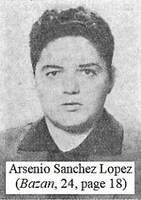
According to Bazan, 24, November 1963, Arsenio Sánchez López had already obtained a first prize in the year 1962 at Spain's Sixteenth National Tourney of Professional Training, Industrial Training and Craftsmanship. Franco himself handed it to him (photograph). On that account Bazan canvassed Lopez presumably in early 1963. The apprentice was twenty years old when the following interview took place. "Where were you born, when did you join the Factory, etc.?" "I was born in El Seijo. Note: Today O Seixo; it is located across the bay from Ferrol City (End of Note). I entered the Factory in October 1957. I spent my first two years in the Outfitters Workshop, then went over to Metal Sheetwork and presently I am enrolled in first-year Machinery Drafting." "What was your assignment at the tourney?" "My practical exercise consisted in fashioning a frame resembling a 'y' from three galvanized iron pipes." "How many apprentices did you compete against?" "Five." "What is your sincere opinion about the national tourneys of professional training?" "They are an excellent way of stimulating the formation of professionals and facilitate the exchange of viewpoints between the professionals." |
| 20. |
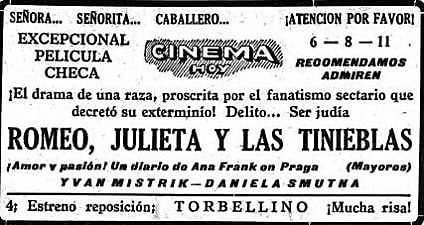
1960 Czech film at the CinemaMovie house Cinema shows the 1960 Czech film, Romeo, Julie a tma (Romeo, Julieta y las tinieblas). Robert Jeantal (see June 26) and Los Cinco Latinos are the performers today Saturday at 10:30 PM in the grounds of I Feria de Muestras del Noroeste de España. |
| 30. | I Feria de Muestras del Noroeste de España (First Exhibition of the Northwest of Spain) closes its doors officially at 6:30PM. The choir "Toxos E Froles" will be its last performers. |
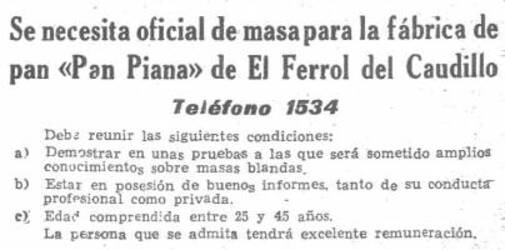
| 10. | Pan Piana advertises a dough maker position (above). Applicants must be 25-45 years old. "Excellent pay." |
| 14. | The local radio station ("Voz de Ferrol") will broadcast "especially ceded" B.B.C. tapings of an original version of "El Quijote de La Mancha." These broadcasts will start next Monday the 19th at 11:00 PM. |
| 17. | Instituto Nacional de Industria has been authorized to construct a (new) dry dock in Ferrol. The project is estimated to be finished in four years' time. The dock will measure 312 × 42 square meters, big enough to accommodate ships of up to 110,000 tonnes. The news caused great elation in the city. Note: The dry dock with slight modifications was finished in the year 1973 (End of Note). |
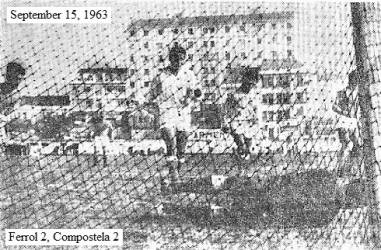
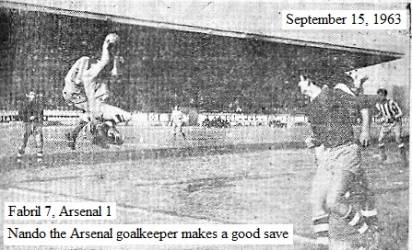
| 1. | Ferrol's Concepción Arenal Soccer Trophy: Deportivo de La Coruña 4, Sporting Vitória de Guimaraes, 0. |
| 4. | Bazan-Ferrol representatives of the 7,500 workers employed by the dockyard set forth their demands for workplace security, job security and new wage schedules during a meeting with the Minister of Labour in A Coruña. |
| 6. | The directors of the successful I Feria de Muestras del Noroeste de España (First Exhibition of the Northwest of Spain) are "constantly" receiving requests for stands in next year's fair. |
| 9. | Franco made an official visit to Ferrol amid public demonstrations of "loyalty and respect". The dictator inaugurated the new local bishopric headquarters. Following a brief concert of sacred music, the bishop and the Justice Minister spoke. The minister said that the Church and the fatherland were conjoint and that "one can not love the Church without loving Spain." The official party then went to the hermitage of Chamorro where the bishop said Mass. The dictator and his wife left the city at 8:15 PM. |
| 15. | Ferrol could only manage a 2-2 tie against Compostela at Manuel Rivera Stadium. Meanwhile Arsenal, playing away in A Coruña, was thrashed 7-1 by Fabril Deportivo. The photographs above captured two good saves, by Joaquín the goalkeeper of Compostela (left) and by Arsenal's Nando (right). |
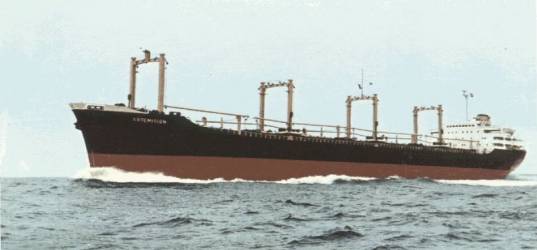
Artemisión |
| 5. | The roof of the Navy School of Mechanics caught on fire. Municipal, Bazan and Navy firefighters battled the blaze for two hours. Damage was extensive, two sleeping quarters for sailors were "totally destroyed." No one was injured. Apparently a short circuit sparked the fire. |
| 11. | Teatro Rena shows the 1961 Spanish movie, Margarita Se Llama Mi Amor. |
| 19. | Rival shipyard Astano launched the 35,000-tonne freighter "Artemisión" (above) destined for a Greek shipping company. The new ship was built in record time. It is the largest of its class in Spain and makes launch number 166 for the shipyard. |
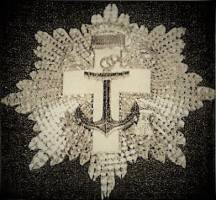
Cross of the Naval Merit |
|
November 10. The regular Third Division match, Arsenal vs. Ferrol, was advertised as and transformed into a charity contest whose proceeds were donated to the mutual fund run by Reverend Fanego the chaplain of Bazan-Ferrol. The box office revenue was "splendid," according to Bazan, 25, and the game's final score was Arsenal 1, Ferrol 5. December 9. A factory for making slippers went up in flames amid "great explosions and fireballs." Municipal and Bazan firefighters put out the blaze with great effort. The losses are estimated at 2,000,000 Pesetas. 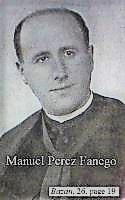
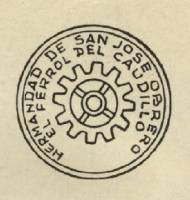
December 19. The Navy imposed the Cross of the Naval Merit (above) on Reverend Fanego (far right) on the recommendation of the previous captain general of the Maritime Department. Reverend Fanego was the founder and director of Bazan-Ferrol's Polyphonic Chorale and the manager of the Sick Workers Mutual Fund (seal on the right). December 21. The annual charity Christmas concert in benefit of the mutual fund managed by Reverend Fanego was performed at Teatro Jofre. Bazan's plucked-string orchestra, polyphonic chorale, chamber orchestra and the novel external collaboration of the band of the Northern Third Corps based in Ferrol all contributed to making the Christmas show "magnificent" and "a complete success in the artistic order," according to Bazan, 25, page 27. December 27. The Ministry of the Navy ordered the urgent put out to sea from Ferrol of a cruiser and two frigates to search for missing freighter "Castillo Montjuich" (below). The freighter left Boston with a crew of thirty-seven on December 5. It is six days late arriving; it was last heard from on December 14. A BRIEF HISTORY OF THE "CASTILLO MONTJUICH"
The ship's baptismal name was "War Vigour". Furness Shipbuilding Co. Ltd. built it at the Haverton Hill Shipyard of Northern England. SS War Vigour slid into the water on June 28, 1919, and was registered at the Port of London on March 6, 1920, with a gross registered tonnage of 6,548. The ship took on these other names successively, "Andalusier", "Wolhandel", "Bois-Soleil" and "African Mariner" (reference). The Nationalist side of the Spanish Civil War sunk the "African Mariner" on January 23, 1939, salvaged it three months later and renamed it, "Castillo Montjuich," in 1940. Bazan-Ferrol refurbished it over the years 1950-51. WHAT CONTEMPORARY NEWSPAPERS SAID
The source for the following information is the online Digital Library of Galicia. According to page 1 of El Pueblo Gallego, Friday December 27, 1963, "Castillo Montjuich" left Boston with a cargo of 9,000 tons of corn bound for the port of A Coruña. The arrival was scheduled for December 21. As the freighter departed Boston it informed other Elcano Shipping Company vessels nearby that its main telegraph station was having problems. The final transmission however reported normalcy aboard. The same source stated the next day on page 4 that the last transmission from "Castillo Montjuich" had been received on December 14 when the cargo ship was situated about 200 miles "almost due north of the Azores" and some 1,200 miles from A Coruña. The rebuilt freighter was said to be in "excellent condition" with a deadweight tonnage of 10,300 and a cruising speed of 10 knots. Its captain was José María Arriandiaga, 59 years old, with an experience of 30 years at sea. Spain had solicited and received the assistance of the American and Portuguese navies in its search for the missing vessel. 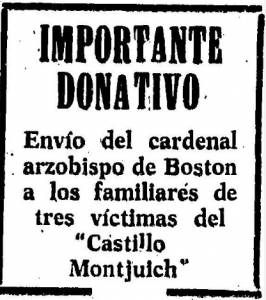
On Tuesday December 31, page 1, El Pueblo Gallego cited a spokesman for the Spanish Ministry of the Navy informing the public that the hopes of finding the cargo vessel were "almost nil." El Progreso of Wednesday January 1, 1964, related on pages 1 and 4 that "Castillo Montjuich" had left Boston on December 5 and that Roberto Berga the manager of the Elcano Shipping Company postulated at a press conference on December 31 three modes of a possible wreck: a swift sinking of the vessel by the bow, an undetected fissure swamping the cargo deck gradually through the night or a splitting of the hull. El Pueblo Gallego of August 9, 1964, page 10, fulfilled the desire of the beneficiaries of an American cash donation to make public their heartfelt gratitude to the Cardinal Archbishop of Boston "for such a generous display of Christian love and solidarity." His donation amounted to 69,000 Pesetas or $1,150 USD back then. According to this reference the sum would be equivalent to a donation of $11,700 USD today (September 2024). The beneficiaries of the Bostonian gift were residents of the province of Pontevedra related to three casualties of the "Castillo Montjuich." Out of the 37 crew twenty-seven were Galicians, four of them from Ferrol city and county (Ferrolterra). The rest were four Basques, two Asturians, two Andalusians, a Cartagenian and a Navarrese. |
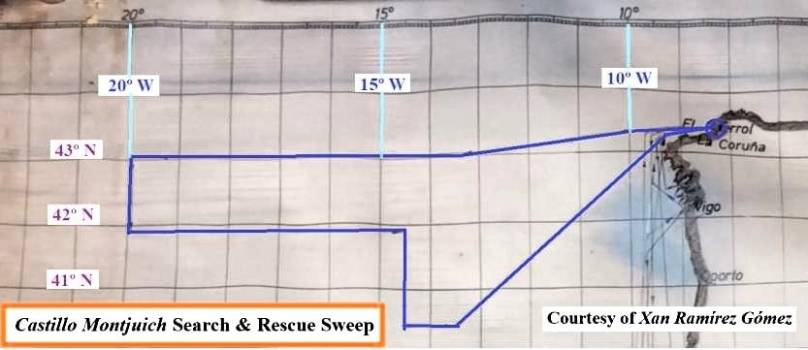
Search and rescue plan for the Castillo Montjuich. Courtesy of Xan Ramírez Gómez. The vessel's final transmission on December 14, 1963, gave these coordinates: 43° 12’ North, 34° 30’ West (source). |
Reference: J. R. Soto Rodríguez, 2008: "Castillo Montjuich: ¿Una muerte anunciada?" Revista General de Marina, 254, 6, pp. 741-754. The PDF version of this reference is available for download here.
|
Acknowledgement: Thanks are due to Mr. Xan Ramírez Gómez for e-mailing me on September 12, 2024, the sketch heading this section. Next day he sent the Revista General de Marina article. |
On Wednesday January 18, 1961, the "Castillo Montjuich" carrying 7,250 metric tons of cereals struck a block of ice near Cruger Island on the Hudson River and had to be towed to the port of Albany (El Pueblo Gallego, January 20, 1961, page 2, and El Progreso, January 21, 1961, page 3).
On Thursday February 23, 1961, "Castillo Montjuich" returned from New York and docked at the port of Vigo with a cargo of 9,000 tons of American wheat, "the biggest delivery of the current year." The highly welcomed wheat was earmarked for Galicia, Valladolid, León, Zamora and Salamanca (La Noche, February 23, 1961, page 7). The off-loading was completed on March 8.
On Wednesday October 31, 1962, "Castillo Montjuich" and the Italian ship "Gemini" collided on the Delaware River south of Philadelphia. The Italian vessel in ballast endured minor damage below its waterline; the Spanish proceeded upriver.
J. R. Soto Rodríguez mentions in his article that as "Castillo Montjuich" berthed in a Basque port in November 1963 "several cracks appeared which were fixed with the oft-resorted-to but provisional and unreliable encasements of cement" (p. 744).
On the initial leg of the tragic Spain-Boston circuit "Castillo Montjuich" sailed through a "tremendous gale" and experienced "multiple failures and seize-ups of the auxiliary engines" which left the cargo ship adrift for an unspecified length of time (p. 744).
On December 1 the "Castillo Montjuich" started loading apparently 9,093 tons of American corn in the port of Boston (p. 745).
An unspecified [Spanish?] document envisioned the loading of only 8,959 tons; the National Cargo Bureau verified 9,338 tons loaded and the longshoremen's Atlantic & Gulf Grain Stevedoring Associates notified 9,093 tons. The first document anticipated a ballast of 2,221 tons in the double bottom tanks, the National Cargo Bureau verified 2,644 tons and Atlantic & Gulf Grain Stevedoring Associates notified 2,913 tons. "Let the reader compute the disparities and draw his own conclusions," writes Rodríguez (p. 746).
Boston harbour pilots declared that the "Castillo Montjuich" could in their opinion cross the Atlantic although they would not like to be on it during foul weather (p. 746).
Loaded to one inch below the maximum waterline marking prescribed for the standard ocean water density and Winter North Atlantic conditions, "Castillo Montjuich" left Boston bound for A Coruña with "a crew looking forward to spending the Christmas holidays at home but very concerned about the wretched state of the ship." Underway "Castillo Montjuich" was requested to report its position every three days (p. 746).
On December 14 "Castillo Montjuich" gave its position as 400 miles NW of the Azores and gave the all OK on board despite a low of 724 mm [965 mbar] having formed in the zone. The next transmission was scheduled for December 17. None was forthcoming (p. 746).
The Spanish government opened an exhaustive inquiry more than 1,000 pages long into the loss of the "Castillo Montjuich." The inquiry wrapped up with official approval on January 14, 1966.
J. R. Soto Rodríguez mentions in his article that the preliminary probes of the Ferrolian Department of the Navy take up 296 pages. They contain extracts of letters sent from Boston by some crew to their families expressing serious misgivings about the return voyage (p. 750).
Three third-tier machinists petitioned to stay behind in Boston but the captain eventually persuaded them to embark (p. 750).
"Countless" breakdowns had occurred during the first leg of the circuit. The captain sent from Boston via ordinary mail to Elcano Shipping Company a list of the repairs done. The shipping company received his letter on December 9 (p. 750).
Agustín Orueta Uribarri the third-last captain of the "Castillo Montjuich," in charge from October 1960 to May 1962, informed the inquiry about the "multiple failures" registered in the entire machinery of the engine room (freshwater condenser pump, other pumps, boilers, etc.).
The Inspection Office of Houston (Texas) overseeing the loading of cereals refused to issue the cruising permit for "Castillo Montjuich" until Uribarri signed a document assuming full responsibility for the safety of his crew. The vessel had not met the minimum coefficient of stability required by the International Convention for the Safety of Life at Sea.
As a corollary Uribarri solicited from Elcano Shipping Company the repairs due, but he did not receive a reply. Back on Spanish dry land he reiterated his petition and got fired (p. 750).
Antonio Leniz Mugica the next captain declared that the stability calculations he had made aboard "Castillo Montjuich" during the sole operation of loading grain he supervised yielded too short a metacentric height [hence a restoring torque too weak] and that when a "hard to port/starboard" command was executed the ship heeled (p. 751).
Relatives of the victims presented the official inquiry with letters mailed from Boston.
An oiler wrote to his wife, "The ship has cracks; the rivets on the bottom are worn; they were covered with cement which popped out in bad weather; the bilge pumps do not function; we are screwed if something should happen. Everybody wants to abandon the ship" (p. 751).
The first officer wrote to his brother-in-law, "The ship is very much worn out; I must load it with an unconventional touch because if I overreach by just a few tons at some stage of the loading process the ship might snap in two right at dockside."
The Auditor of the Ferrolian Department of the Navy concluded: "The vessel should not have risked the return journey" and "this temerity provoked the death of 37 men and the loss of a vessel and its cargo" (p. 751).

North Atlantic weather map for 18 GMT December 14. |
A sequence of sixteen historic North Atlantic synoptic weather maps was downloaded from The Weather Outlook website.
The first map of the sequence displays the synoptic situation for 00 GMT December 14, 1963.
The next fifteen maps do the same at six-hour intervals.
The sixteenth map then corresponds to 18 GMT December 17.
The sequence of sixteen JPEG files was converted to one GIF of sixteen frames thanks to the Free Online GIF Maker website. A nominal pause of ten seconds per frame and ten loops were chosen. One loop then takes 2 minutes 40 seconds to complete, and the ten loops 26 minutes 40 seconds.
Every frame displays the hypothetical route of "Castillo Montjuich" which to a first approximation is simply the thick black line stretching across the North Atlantic Ocean from Boston (42° 36' North, 71° 5' West) to A Coruña (43° 21' North, 8° 24' West).
The hypothetical location of "Castillo Montjuich" was determined by assuming a constant cruising speed. The length of the thick black line on every working JPEG screen display was almost exactly sixteen centimeters. The journey was slated to last sixteen days (December 5-21). This felicitous coincidence made the hypothetical scaled displacement of "Castillo Montjuich" equal to one centimeter per day and to 0.25 centimeters every six hours.
A white dot on the thick black line shows the hypothetical location of "Castillo Montjuich." It was obtained by pressing a tailors measuring tape flat on every working display and measuring. Certainly a rudimentary technique prone to slight errors, but a decent approximation that lets a reader visualize what kind of weather the cargo ship encountered from 00 GMT December 14 onward.
The last transmission from "Castillo Montjuich" was probably done as usual around 18 GMT (view the corresponding weather map at the head of this section or in the fourth frame of the animation below).
Weather and the ill-fated Castillo Montjuich |
| From 00 GMT December 14, 1963, to 18 GMT December 17 |
The animation shows how "Castillo Montjuich" was impacted by one and perhaps two explosive cyclogeneses.
The first storm started off as a harmless 1005 mbar low at 18 GMT December 13 (not shown) which deepened progressively to 990 mbar (frame 01) 985 mbar (frame 02) 975 mbar (frame 03) and 970 mbar (frame 04) composing a 35-mbar drop over 24 hours, meeting the definition of "weather bomb" espoused by the UK Met Office in this video.
A conservative estimate of sustained wind speed about the storm at its peak is category 10 on the Beaufort Scale. In addition "Castillo Montjuich" had to brave a SW groundswell 9-10 meters hight for at least twenty-four hours (frames 02-06).
Between 06-12 GMT December 15 (frames 06-07) "Castillo Montjuich" would be exposed to strong northwesterly winds and two clashing wavefronts (cross-wind SW groundswell and a NW wind swell) generating a most dangerous chaotic sea.
It is unthinkable that given the ramshackle state of "Castillo Montjuich" the vessel survived the twenty-four stormy hours following its transmission about the time of frame 04 when normalcy aboard was reported. Two explanations can be offered for so odd a report. The first explanation is that over the previous six hours (frames 03-04) the ship had been hugging the eye of a deepening storm and thus felt transient winds lighter than twelve hours prior (frame 02). The second is bravado, whicht riddled Spanish and Portuguese society under Franco and Salazar respectively.
A second episode of explosive cyclogenesis uncoiled between frames 06-11 as a depression initially 995 mbar deepened to 965 mbar.
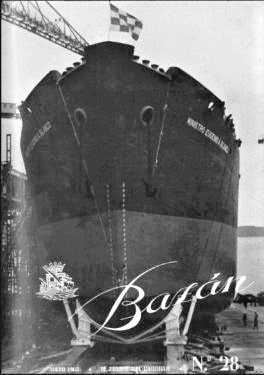
The source for the news in this chapter has already been discussed in the chapter entitled, "Bazan Magazine for the Year 1956."
The outstanding event of the year was the launch of oil tanker Ministro Eugenio A. Blanco on December 18, 1964 (cover of Bazan, 28). The oil tanker had a deadweight of 19,660 tonnes and a displacement of 26,000 tonnes. Notes: Eugenio A. Blanco (1893-1964) was an Argentinian economist and twice government minister. The keel of this construction was laid during the second half of June 1964 (End of Notes).
This launch was significant for being Bazan's first foray into foreign markets.
The presidential tribune for the launch was occupied by the vice admiral and managing director of Bazan, the vice admiral and commander-in-chief of the Fleet, a rear admiral, a Navy commander, the mayor of Ferrol, the chief executive officer of Bazan-Ferrol along with the director, the deputy director and other top officials of the Factory. In center stage stood the attaché of the Argentinian Embassy in Spain who acted in representation of the contractor, Yacimientos Petrolíferos Fiscales de la República Argentina. The bishop of Mondoñedo-Ferrol blessed the oil tanker, and the wife of the embassy's attaché was the vessel's godmother.
The immense bulk glided majestically down the slipway until it coasted into the sea, at at that instant, the sirens of the many steamboats located in the vicinity of the shipyard hailed it joyfully.The entire ceremony, although executed as a mere working routine, came up very brilliant.
(Bazan, 28, page 9)
Following the Argentinian coup d'état of June 28, 1966, the government in Buenos Aires enjoined Bazan-Ferrol to rechristen the tanker with the name of that country's oil-exploration pioneer, Ingeniero Hermitte (1871-1955). The tanker with the new name was delivered finally on April 5, 1967. Photographs of the ceremony and of the ship's interior compartments are found in this webpage.
Ingeniero Hermitte stayed in service until the year 1993 when it was decommissioned and beached at Alang (India).
The shipyard was busy during the year 1964 in the construction of Sardinero whose launch took place on November 22, 1965, and which was the biggest oil tanker built in Spain to date.
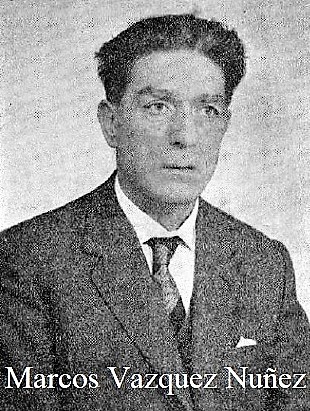
1. Marcos Vazquez Núñez was born in 1898 in Mugardos where he lived before moving across the bay to Ferrol City in 1941. He started working for the Factory in 1916 as a navy carpenter. In 1921 he decided to emigrate to New York where he stayed three years long. Then in 1924 he returned to Ferrol and to his former post at the dockyard. Note: The Ferrolian shipyard was under British management between 1910 and 1925 (End of Note).
"Please tell us something about your stay in the United States." "What is there to say? That happened so long ago! I worked very hard over there. Sometimes in the assembly line of mills. Other times in hotels as a waiter. I never ceased attending Schools to 'practise' English, whose dissimilarities with Spanish seemed unbreachable at first. I joined the Unión Benéfica Española and went to its cultural seminars, concerts, evenings of entertainment, dances, etc., socializing heavily with the entire Spanish colony."
"And what are your best memories of Bazan-Ferrol?" "There are good and bad memories. But, broadly speaking, I retain good memories. Even though I suffered several working accidents, some of which required my getting checked into the Santo Hospital de Caridad."
"Excuse me, Mr. Vazquez, but since I first saw you I am troubled by a question I wish to put to you: why does your face look so familiar? Have we seen each other before today?" "You will certainly have seen me many times before today. I am an usher of the Orchestra seating section in Teatro Jofre. It's an off-hours job for me."
"Ah, indeed! Now I remember. Do you wish to say anything else to end the interview with?" "Yes, I would. One thing above the rest: how grateful I am to the Company for having treated me so well, especially in regard to a certain illness I had, during which I got a lot of help. Similarly when I lost four teeth in a work accident. Labour law granted stainless steel tooth implants, but the Enterprise, without my having asked, decided freely and spontaneously, in view of my good record, to give me implants of gold. It's these four, do you see them?"
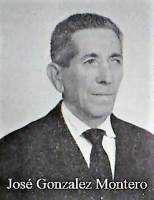
2. José A. Gonzalez Montero was born on August 30, 1898, in the Ferrolian suburb of Serantes. Montero entered the Factory for the first time as a drill operator apprentice in 1913. Subsequently he moved about the dockyard and worked at the General Stores and in the Outfitters Workshop and did an endless train of deck cadet jobs.
"What can you tell me about the work you used to do?" "That I liked it though it was grinding. Naturally when one had to work outdoors..." "What professional rank did you attain in your trade?" "Operator first class."
"Have you travelled, have you been abroad?" "No, sir. The allure of America never attracted me much. I have always dwelled here in my Serantes croft. Besides, this life half in the city, half in the countryside, enthuses me. The countryside serves as 'entertainment' when one works on his own."
"And what will you do now as a retiree?" "Whatever may be done to live many more years."
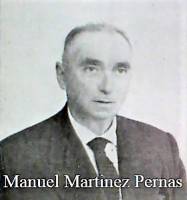
3. Manuel Martínez Pernas was born in Ferrol in 1897. He entered the Factory in March 1912 as an apprentice of the Painters Workshop. He spent the rest of his working life in this workshop except for a brief interlude working on his own outside the Factory from 1924 to 1926.
"Mr. Martinez, where did you fulfill your military service?" "Here in Ferrol, year 1919." "Have you travelled much?" "Hardly. A trip to San Sebastian (Basque Country) commissioned by the Factory, and thereafter a trip or two but invariably short."
"Which jobs in particular pleased you the most from your painters' trade?" "All of them, in general." "You are retiring with a foreman's rank, isn't it?" "True. I promoted around the year 1944, I don't remember it well."
"And what will you do now with so much free time ahead?" "I don't know yet, but I guess what everybody else does. Going for walks, having a quiet life, you know."
"Then may all your wishes come true, Mr. Martinez."
Bazan's Footnote: With this number running in the press, we learned about the sudden death of Mr. Manuel Martínez Pernas. From here we send our deepest condolences to his family and solicit from our kind readers a prayer for his soul.(Bazan, 27, page 16)
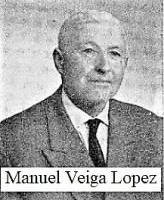
4. Manuel Veiga Lopez was born in Valdoviño on April 14, 1897. He entered the Factory in 1912 as an apprentice of the Watercrafts Workshop where he lingered a few months. Lopez got transferred in 1914 to the Painters Workshop as a varnisher, and with the same occupation to the Cabinet Making Workshop in 1923. He attained the rank of leadman in 1942 and of foreman in 1944.
"I have heard it said that you were a great sportsman in your youth, a genuine champion. How true is this?" "I was a great fan of cycling. During two years (1925-27) I took part in every cycling event of the city and even in some of the most important races organized by Santiago de Compostela. I obtained a third-place prize in the 'City of the Apostle.' In Ferrol I almost always finished first, except on my first year of competition when I made the usual beginner's mistakes. Today, at my age, I still conserve a great passion (quasi-religious) for the bicycle, thanks to which it can be said that I keep myself in good shape."
"Please describe for us the format of those cycling events or competitions." "In regard to Ferrol, the races were sometimes held on the field beside the Northern Third Garrison, at other times in the old soccer stadium of Caranza. A Tour de Catabois was also arranged with this circuit: Ferrol, Catabois, San Juan de Filgueira, Ferrol." Note: The length of this circuit is roughly ten kilometers (End of Note).
"Do those competitions mean anything to you today?" "I have to try really hard to hold back the tears from my eyes."
"And what is your comment regarding your workmates' farewell homage on this your retirement day?" "That it impressed and moved me a lot. Most of all it surprised me because I had already warned (and I thought had convinced) my workmates not to stage anything for me at all. Well, it didn't happen. They had their way, something which I appreciate infinitely now that it's over, and I know it is something that I will never forget. But let the record show that I didn't deserve such a thing."
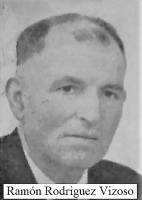
5. Ramón Rodriguez Vizoso was born in Narón on December 28, 1901. He entered the Factory on January 12, 1917, as an apprentice riveter earning 1 Peseta/day. Note: According to Table 3 of this report by the Bank of Spain, Vizoso's starting salary was then the equivalent of 22 cents US per day (End of Note). Riveting was done with swung hammers until the modern pneumatic tool was introduced to the Ferrolian dockyard between 1926 and 1928.
Vizoso stayed a riveter until age 55 when he suffered a work accident that fractured his left collarbone and right arm.
"What specific job do you keep the fondest memory of?" "The most important for me was the one that granted me the high honour of pressing the first rivets in the ceremony of laying the keels of Furor, Ariete and Meteoro, helping out the daughter of His Excellency the Head of State who had come that day—October 18, 1944—as godmother for the launch of Tambre and Guadalete." Note: Furor, Ariete and Meteoro were fast frigates launched all three on Sepember 4, 1951. Tambre and Guadalete were minesweepers (End of Note). "Another fond memory of my working life hearkens back to 1928 when the Englishman Mr. Rovers congratulated and accorded me a special distinction for hard work, good conduct, attendance and punctuality."
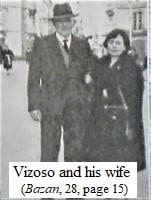
"Is there some interesting anecdote from all these years?" "On a certain occasion while riveting Furor's propeller blades to the propeller shaft I suffered a rude accident that smashed three of my fingers. But since they paid a lot for each rivet I said nothing to anybody, and despite having my fingernails and fingers smashed, I bandaged them with a smeared cotton rag we use at work and carried on in this fashion four more days; then I reported to sick bay. And I had no infection at all.
"On another occasion I fell from a deck to the engines chamber beneath, as a result of which, one of my hands snapped and inverted. So I shouted to a workmate, 'Stop, don't lob more rivets my way, I think I got a shifted hand!' Because of this notorious accident I was on sick leave one month."
"What is the moniker you earlier said you are known among your workmates by?" "By 'Stout' (lit. 'broad-chested'); the English already gave my father the same name. I inherited it. It never bothered me, quite the contrary."
"Do you retire contented?" "Yes from a certain perspective, not for nothing have I hammered away forty-eight years. But from another it kind of makes me sad."
"To end the interview, please say off the cuff whatever you wish to." "To bid again good-bye to my supervisors and workmates, to embrace them warmly and to wish them all much good fortune, happiness and long life."
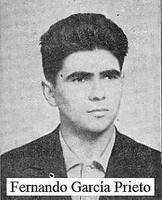
Fernando Garcia Prieto was born in the municipality of Neda in 1938. He entered the Factory in 1953 and at the time of this interview held the rank of official first class in Deck Outfitters. Prieto had contested a national deftness meet for workers (Madrid, July 14-15) and had won first prize in the category of metalworking milling.
On July 18, 1964, he received the award from the hands of General Franco (photograph).
"What impression did you get receiving the badge from the hands of the Leader?" "It was for me one of the most satisfying events in my professional life, an act I will never forget."
"How did they treat you in Madrid?" "Superbly, we received all kinds of favours from the officials, and the Minister of Labour feted us at the conclusion with a meal."
"What possibilities of success do you envision your workmates to have in future meets?" "The possibilities are always there because in El Ferrol and specifically in the Factory there are very good operators who can achieve success at these competitions."
"What is your opinion regarding the ability of other workers compared with Bazan's?" "From what I could see at this contest there are very good operators in Spain, and Bazan's can be counted among them."
"What are your personal goals inside the Factory?" "Same as everyone's, to progress as much as possible."
Manuel Soto Romalde, social-and-labour legal adviser, wrote another short article entitled, "Wars and Peoples' Progress," in Bazan, 25, pages 22-23.
A previous essay of his may be found in Chapter 14, "Bazan Magazine for the Year 1962."
In the interim Romalde published a short essay entitled, "The satisfaction of having a car," (Bazan, 24, November 1963, pages 16-17) where he forecast that although owning a car was still a luxury for the Spanish worker it would cease to be so in the near future due to the same economic dynamics that had made having a radio no longer a luxury. Likewise he foresaw that the television set, "today the exclusive domain of the affluent, will soon enough join the array of goods affordable to any worker." He was proven right on both counts.
In the present article Romalde argues for an universal system of Social Security through a recollection of the Atlantic Charter (1941), the International Labour Organization's Declaration of Philadelphia (1944), Marx's concept of the reserve army of labour and the social postulates of Lord Beveridge (1879-1963). To divert the censure of "hierarchies," Romalde softens the hard socialist tint of the article with superficial rote references to Pope Pius XII, Church teaching and the Fascist Fuero del Trabajo (1938).
My translation of the article follows.
All the wars and revolutions which Humanity seems condemned to experience are always deplorable for the innumerable material or human losses that they usually come saddled with, but leaving this sombre aspect aside, and without seeking to justify in any manner the use of violence as a means of achieving the general welfare everyone longs for, it is curious to observe in how many instances, particularly of the recent past, such conflagrations have spurred the manufacture or perfection of matériel immediately relevant to the war effort but which afterward became of great value in peacetime applications. Similarly these conflagrations drilled new ideas into the minds of government heads even as the conflict raged on. These new ideas induced the rulers to start a series of radical transformations in the way of thinking or living of their peoples which contributed decisively to the peoples' own progress.Indeed if we turn back to the end of the eighteenth century we see how a series of events had to take place in France to precipitate the demise of the reign of absolutism and to establish the ideological tenets of philosophical stripe contained in the Declaration of the Rights of Man and of the Citizen which enjoyed immense influence. The articles of the Declaration, dealt with as irrefutable, have buttressed many political undertakings realized much later to the point where some articles have inspired certain documents of our day such as the Atlantic Charter or the Declaration of Philadelphia and even inspired political actions like the protection of workers through the plans and systems of modern Social Security.
Already in the famous Atlantic Charter—so called for having been signed on August 14, 1941, by U.S. President Roosevelt and U.K. Prime Minister Churchill aboard battleship Repulse "somewhere" out in the Atlantic Ocean—are explicitly stated, even in the dawn of that terrible war, the tenets to bear in mind for the economic and social ordering of the world.
Under the umbrella of these principles and with the aim of elaborating the social objectives to pursue following the restoration of peace in a world inspired by that Charter, there convened in 1944, still in an environment of full-out war, a series of meetings in Philadelphia which jelled in the Declaration that bears the name of that North American city.
This new document affirms that a fundamental objective which countries must aspire to in the realm of social policy is the fight against destitution. The document defines destitution as a circumstance of physical and spiritual need affecting a large portion of the toiling masses through no fault of their own but originating in the economic and social disarray partly caused by the war's economic disruption and unheard-of destruction. The document adds that a lasting peace will only be established if it is based on social justice covering all human beings irrespective of race, religious creed or gender, and that a practical consequence of this is the provision to everyone of an equal opportunity for having a job.
Next the Declaration of Philadelphia recites some tangible social policy proposals under the banner of "full employment" or "total employment." In one of his Christmas addresses Pope Pius XII pronounced this tenet to be the guarantor of a lasting peace, demanding wholesale cooperation among the various constituents that make up the world of labour to prevent the existence of a large mass of the unemployed (which Marx dubbed, "the reserve army of labour").
However it was the renowned Lord Beveridge, who passed away a very few years ago, the one who divulged these ideas of "total employment" most.
This illustrious personage contributed decisively to rousing the awareness of this question's importance when he affirmed that forced unemployment is not a problem that affects private industry exclusively but rather has a national character because its main cause is the reduction in a nation's total expenditures. That is why there was no forced unemployment during the last world war in the embattled countries but instead job openings galore as the State's demand for goods and services grew, with the consequent increase in the national expenditures. In peacetime, however, those expenditures are curtailed and therefore the number of the unemployed rises. But the State—Lord Beveridge keeps saying—has to do battle even in full peacetime for such lofty ideals as health care, education, social security, housing, etc., which are the cornerstone of its inhabitants' well-being, and such a struggle demands likewise the participation of a large portion of its citizens.
The tenets contained in the Declaration of Philadelphia were received with great satisfaction and in the opinion of many North American Catholics concurred with the guidelines of the Church. In this regard it is here fitting to underline that the Declaration's categorical affirmation that labour is not a commodity was enunciated earlier in our Fuero del Trabajo (Norms of Labour) the Carta Magna of Spanish workers which on the date of its proclamation, year 1938, established, also in the thick of war, a series of dogmatic principles whose posterior elaboration gave rise to the abundant labour legislation in use today in our Fatherland and which will climax very soon in the announced implementation of the new project on Social Security that is being talked about so much.
Manuel SOTO ROMALDE
Social-and-Labour Legal Adviser(Bazan, 25, pages 22-23)

Manuel Soto Romalde wrote another revealing article entitled, "Let Us Help Our Retirees," in Bazan, 26, March 1964, pages 20-21. The ornamental frieze, shown above, that heads the article's two pages and this section was drawn by Francisco Iglesias (see ARTS AND LETTERS for the year 1957).
My translation of Romalde's article follows.
Whereas retirement means for some a sort of liberation from the annoyances inherent to every job, it imports for others a certain feeling of nostalgia at having to leave the Enterprise after having spent so many years in it. In either case they all depart with fatigue reflected on their face, etched with the unerasable impression of the years' relentless passage, and with an enormous desire to rest, to try and find at last the peace and tranquility they are so much in need of.But, alas, this longed-for leisure is impaired in not a few instances for the simple reason that workers in the hour of retirement ponder already the scantiness of their pensions, giving rise to the natural comments.
It would then seem humane that along with retirement these men were allotted sufficiently generous instalments which would let them lead their new life with a certain margin of ease, for otherwise they would be forced to circumvent current legislation about the incompatibility that logically should exist between having retirement income and doing a job on the side.
Even acknowledging that retirement income rose in the space of a few years from nothing to what is offered to us today it must be concurred that there is still a long road to cover in this aspect.
Let us therefore make some comments regarding this important issue whose intention is only to try and find solutions tending to allay as much as possible the situation of those who have collaborated with all diligence in the undertakings of the Enterprise to the benefit of it and of the common welfare. Having profited every one of us from their toil it is our duty to show them our appreciation by trying to help them in this last period of their life.
Retirement may now be solicited at age 60, but what is alloted to males then is so small—40% of their final base salary—that everyone opts to keep working until age 65 when the allotment is 72%. Some even continue working without suspecting that by prolonging their activity, with the pendant of an even higher allotment ahead, what they do is shorten their real life until comes a day when, believing they can still reach their goal, they founder for having reached first the other unavoidable finish: death.
On the other hand women are allotted at age 60 what men do not yet get at age 64. It is past age 65 when pension benefits equate for both genders.
If a struggle coursed the world to procure equal wages for men and women who perform equal tasks it would be right, in our opinion, to award them equal benefits for equal circumstances at their hour of retirement, taking into account moreover that, generally speaking, though some opine the contrary, women usually live longer than men, and since the question is not to deprive the feminine personnel of the indubitable advantage it presently enjoys concerning retirement benefits, would it not be of the greatest interest to extend those to men also, thus eschewing what seems to us an unjustifiable discrimination currently in effect?
Retirement entails not only the end of active service but also of other "ends" which annul the substantial earnings derived from incentives, overtime, rewards, spot bonuses, etc., that normally boosted a worker's income. Thus it merits pondering increasing the retirement benefits in some fashion. Although it is indeed true that by the age of retirement family-related expenses have decreased, it is no less true that those diminished expenses are in many instances amply compensated by expenses related to diseases and discomforts that become too conspicuous in this phase of their life.
Retirement benefits issue from two different agencies, the Instituto Nacional de Previsión Social (National Institute of Social Providence) and La Mutualidad (Mutual Funds). The first institution pays the old-age subsidy and the second the actual retirement pension. A pension is released in tandem with retirement. A subsidy lags even if the beneficiaries have followed the permanent recommendation of the Factory's Office of Social Legislation to have the pertinent documents ready well ahead of time.
May not the processing and approval of applications be cleared faster in order that these men could count on receiving their subsidy already in the first month of retirement? Let it be borne in mind that a delay is extremely onerous for the retiree whose budget was already not very flourishing during his active service.
It is my understanding that the retiring personnel of certain Institutions receives important remunerations in one go according to their respective rank and with absolute independence of the emoluments dispensed in their new status. Could not a new formula be investigated that would let our retirees enjoy likewise a special gratuity, albeit of lesser amount perhaps? This assistance would be charged to a previously established fund and constitute a show of gratitude for past services.
These special gratuities could be made proportional to the number of years spent at the Enterprise, as a way of acknowledging a worker's seniority and of dispelling the sour aftertaste caused by the fact that a man who has worked 50 years non-stop here—and there are plenty of those—gets the same pension as one who spent 10 years only. Discarding age, La Mutualidad merely requires passing the waiting period and having a minimum of 10 years employment anywhere in the country.
And what can be said about the wholly inadequate pensions of the oldest retirees? Any succor afforded them would be a genuine act of charity and avert their compulsory reliance on relatives and even friends to subsist decorously.
Even considering that the Enterprise can not rush forthwith to succor the retirees financially due to its own economic difficulties, easily grasped, and that La Mutualidad, as long as no future directive modifies what is on offer today, will have to keep following the current statutes that guide it and similar Institutions in the subject of subsidies we must admit that any cooperation from this time forward which both should choose to stage could yield satisfactory results in the matter of easing the forlorn and dire economic situation which we know many of these oldest workers find themselves in after so many years of loyal services.
We hope that the new Law of Social Security Bases will introduce substantial changes in the current pension system. For example it envisions fusing today's two pensions—old-age: fixed amount—retirement: proportional to the base salary—into a single one that combines base salary and number of contributing years. Nonetheless until the principles that inspire the new Law are put into practice we can not assert that the workers' standard of living has improved. Note: The official philosophical dissertation known as the Law of Social Security Bases was published on December 28, 1963, but its text was not approved until April 21, 1966 (End of Note).
Furthermore, regardless of how generous the new Law turns out to be, there will always be a broad field left vacant for enterprises to enhance the emoluments unilaterally, directly or, as its articles propound, through Labour Foundations, Syndical Works, Providential Mutual Funds or Insurance entities of all kinds. In addition the Law informs that Labour Foundations constituted to that end will benefit from the same fiscal treatment and tax exemptions accorded charity or charitable-education foundations.
And all this precisely in benefit of those who have given their all and who are now asking only for a little bit of understanding and affection at a time in their lives when they are so much in need of our special protection because, as the saying goes, old folks are children twice.
Manuel SOTO ROMALDE
Social-and-Labour Legal Adviser(Bazan, 25, pages 22-23)
Follow-Up: Manuel Soto Romalde wrote a follow-up article entitled, "The New Law of Social Security Bases," in Bazan, 27, July 1964, pages 12-15.
Romalde states that the new Social Security system will incorporate the self-employed, the members of cooperatives and temporary workers and accept all income brackets. The State will handle Workers' Compensation Insurance with assistance from La Mutualidad. Accident prevention will be a top priority. "Spain has a million accidents yearly." A disabled worker will be rehabilitated and readapted to a new job if possible. Sickness Insurance coverage will banish the current 39 weeks and turn indefinite. The State will make every effort to supply injured workers with protheses, if needed, and indefinitely with medicines for a nominal price or gratis.
Romalde esteemed that the New Law of Social Security Bases was a "giant step" in the question of Social Security.
The Spanish Social Security website contains a synopsis of the institution's history which appraises the Law of Social Security Bases as follows,
The Law of Social Security Bases that appears in 1963 had for main objective the implementation of an unified and integrated model of social protection based on a financial bedrock of disbursement, public administration and participation of the State in the funding. Despite this statement of principles, many of which were stamped in the General Law of Social Security of 1966, whose entry into force was January 1, 1967, there persisted in fact antiquated deduction schemes dissociated from workers' real salary, the absence of periodical revisions and a lag in true unification due to the survival of many overlapping administrations.The Law of Funding and Enhancement of Social Protection of 1972 attempted to correct the existing financial problems, but it worsened them by increasing the scope of the protection without establishing the sources of the requisite funding.
https://www.seg-social.es/wps/portal/wss/internet/Conocenos/HistoriaSeguridadSocial
(viewed October 31, 2022)
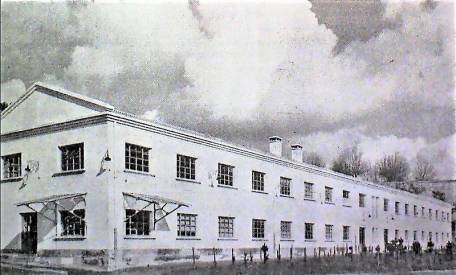
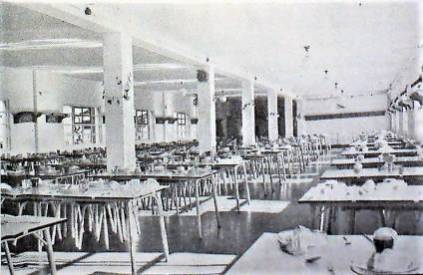
The Mess Hall of Bazan-Ferrol had two wings: the one named Arsenal served workers from the military side of the shipyard, the other named Astillero served the civilian side. Arsenal had 4 lunchrooms with 60 tables each, Astillero 4 with 30 tables each. Arsenal customers were attended by six waiters per lunchroom, Astillero's by three. Service in both wings was "most quick and diligent."
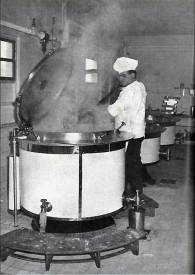
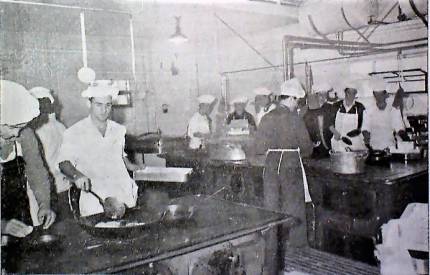
Arsenal`s kitchen had 4 huge pressure-regulated stock pots (above left) 3 bespoke ranges of four double ovens (above right) two industrial electric fryers and one expansive food-warming table. Astillero's kitchen had 2 stock pots, 2 ranges of three double ovens, an industrial fryer and a warming table.
Sixteen men worked in Arsenal`s kitchen and half that number in Astillero's.
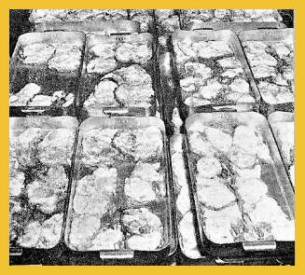
The day's menu was a two-course meal with a glass of wine and a hoagie roll included. The menu differed from day to day. Its price tag was 7 Pesetas. Note: At this time my weekly allowance was 5 Pesetas (End of Note).
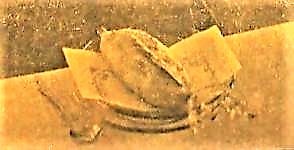
Every day the Mess Hall consumed 2,000 hoagie rolls and 400 litres or 106 gallons of wine.
If a day's menu called for eggs (probably to fry Spanish omelettes) around 3,900 eggs were used.
Customers could order extra drinks. A litre of wine (35 oz.) cost 5 Pesetas. A small bottle of beer (11 oz.) cost 3 Pesetas. A one-litre bottle of mineral water cost 5 Pesetas.
Every day around a hundred small bottles of beer were sold.
Every month the Mess Hall consumed 16 tonnes of potatoes and 1,100 litres or 290 gallons of cooking oil.
According to the article in Bazan, 25, January 1964, close to two thousand "producers" benefited daily from eating their midday meal at the Mess Hall.
Juan Manuel Castro was a frequent literary contributor of poems and stories to Bazan magazine (numbers 2, 3, 5, 8, 12, 13, 14, 15, 16-17, 18, 19, 20, 21, 26, 27). The poem below, translated from the Spanish language, comes from page 34 of Bazan, 27, July 1964.
|
Who is this dame knocking at my door,
Who now is this other one knocking,
And who is knocking now with wailing voice,
Your debt is plain to see. You may cheat HUNGER |
My Interpretation of The Three Creditors. "The Three Creditors" is a depressing poem, yet it reflects deliberately? inadvertently? the crude post-Civil-War reality of Ferrolterra (see "The Day of Ferrol City and County" in Chapter 14, "Bazan Magazine for the Year 1962"). There was widespread MISERY and there was widespread HUNGER, but society's well-off were spared both tribulations although their debt was plain to see (4.1). Eventually DEATH would also knock at their door who had "cheated" MISERY and HUNGER (4:1-3). She brought with her a magistrate's warrant (4:5-6). Let the reader pick who that magistrate might be.
Not every poem written by Juan Manuel Castro was so depressing.
He published the following "sketch of a poem" on page 37 of Bazan, 26, March 1964. Its title, "Romería Gallega," alludes to the traditional festive picnic on the feast day of a city's or town's or hamlet's patron saint.
Glossary for Romería Gallega.
Square tambourine (2.1). A square or rectangular board held between the arms and tapped with both hands (min. 2:55-2:57, 3:26-3:30 and 3:34-3:38 of this video).
Galician cookie-rings (4.2). Televisión de Galicia.
The gunpowder shells (5.1). Example.
Ribeiro wine (8.3). A renowned red wine of Galicia celebrated in many folk songs (example).
|
Sunbeams filter through the foliage
Audible are the sounds of the square tambourine,
The trail ascends like a serpent
A small forecourt, a fountain,
The gunpowder shells rise ripping or rather
The youngsters scramble about,
The Mass is said with a full orchestra,
There are flashes in the eyes,
A row—a wrangle—
The return home. Moonlight.
Youngsters go joining hands |
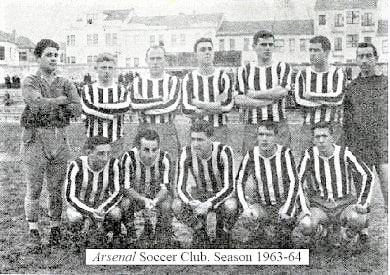
Numbers 26 and 27 of Bazan Magazine dedicated a total of five pages to the players, coach and exploits of Arsenal Soccer Club. The club had a "meritorious" season finishing fifth after Compostela, Fabril, Ferrol and Lugo.
Luis Porta the author of both articles praised the strategy of Bazan-Ferrol to draw nearly every one of its players from the Ferrolian quarry, i.e., from Factory workers, from the professional Ferrol Soccer Club, from local modest clubs like Galicia de Mugardos or Galicia de Caranza. With that roster Arsenal was a "feared visitor" in every away game.
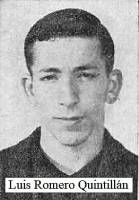
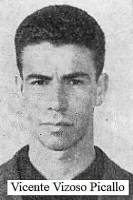
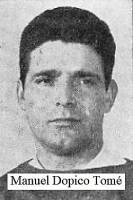
The Bazan, 26, article highlighted three Factory workers who were also Arsenal players.
1. Manuel Dopico Tomé was 24 years old. Arsenal's substitute goalkeeper, "one of the best" in the Third Division. He was a coppersmith.
2. Vicente Vizoso Picallo was 19 years old. Right winger. He was a fourth-year apprentice at the Foundry.
3. Luis Romero Quintillán was 19 years old. Midfielder with "a good shot on net." He was a fourth-year apprentice of the Fine Sheet Metal Workshop.

The Bazan, 27, interview of the team's starting goalkeeper begins thus, "No one can deny that one of the most popular figures in the Ferrolian soccer scene these last few years is Fernando Fernández, 'Nando,' Arsenal's goalkeeper and the most veteran of all the active players."
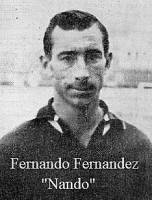
"I started to play as a 9 or 10-year-old boy. Shortly after entering the Factory as an apprentice I signed with Portuarios in the 1942-43 season." Note: Portuarios was a federated team from the old fishermen's quarter of the city (End of Note).
"How many years have you been with Bazan's team?" "Seventeen years; I signed with Arsenal in the 1947-48 season." Note: This was Arsenal's debut too (End of Note).
"What trophies did the team win with you in the lineup?" "Twice head of our Third Division Group and once National Enterprises Champion, a tourney organized by Educación y Descanso, a title we revalidated this year but I went as the back-up goalie."
"Do you think you still have some years left in the sport?" "Frankly yes. At least two."
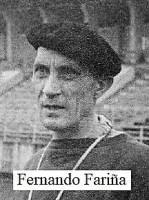
"Of all the goalkeepers who played alongside you, whom would you point up?" "Dopico." Note: Arsenal's second goalkeeper, leftmost photograph in the row-of-three above (End of Note).
A second article in Bazan, 27, congratulates coach Fernando Fariña Barros on the occasion of his having been awarded the Plaque of the Sporting Merit by the "top hierarchies" of Spanish sport. He received his award from the hands of the President of the National School of Coaches.
The motive for this distinction was Fariña's unmatched national record of permanence coaching the same team, "something exceptional in Spanish soccer."
Fariña had been coaching Arsenal seventeen years straight, right from the team's inception.
The third sports article of Bazan, 27, praised the policy followed by Bazan-Ferrol in the hiring of Arsenal's players and predicted that the team would in the upcoming 1964-65 season equal or better its 1963-64 performance. Unfortunately the bold prediction failed utterly. Porta's article in Bazan, 29, October 1965, reports that Arsenal had because of the loss of important players through injury or conscription finished the 1964-65 season in fourteenth place, resulting in its demotion from the Third Division.
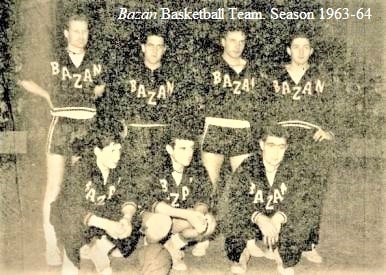
The 1963-64 season disappointed Bazan's basketball fans who envisioned a revalidation of the title of Galician champions and saw instead the opportunity dwindle as the team kept losing some away matches in incomprehensible fashion. In the end Bazan lost by just four points a crucial game away, "which they deserved to win," against the reigning Galician champions, Manuel Álvarez of Vigo City. This was their final match of the season.
Bazan has tumbled from being an outstanding team without peer in Galicia to being just another one that defends well at home but which finds it very difficult to score points away. A dearth of players? A lack of zeal in those it has? Did the turn over flop? Is there not enough training?
Many are the reasons and there is a bit of all. The fact is that while all Galician teams have improved—referring to the top teams, of course—Bazan has plummeted and the gallery that yesteryear filled the Gymnasium abandons it now.
(Luis Porta. "Ferrolian Basketball." Bazan, 26, pages 34-35)
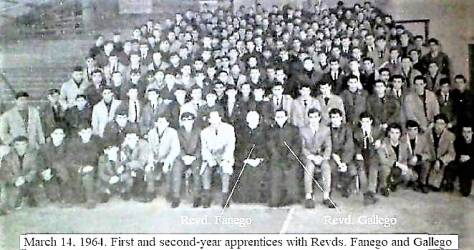
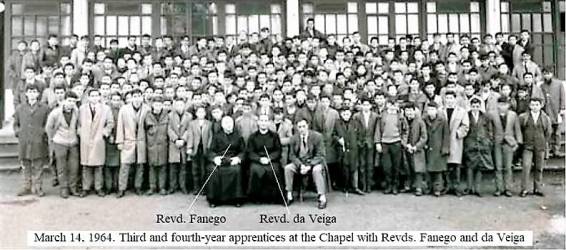
According to the article entitled, "Social-Religious Activities," of Bazan, 27, pages 22-25, the "accustomed" conferences were split in two groups. First and second-year apprentices were lectured in the Study Room under the direction of Reverend Lázaro Dominguez Gallego. Third and fourth-year apprentices were assembled at the Chapel of the Factory's Christian Schools where they heard the "most timely and learned explanations of Reverend Father José Pita da Veiga the zealous Ferrolian missionary of the Claretian Order."
As is traditional all our apprentices have left once more a deep impress of their manly religiosity and exemplary discipline by way of a magnificent behaviour and unmistakable displays of pure piety, worthy of the highest praise. We must also highlight the signal interest in and concern for the religious problems, demonstrated by the weighty and interesting exchanges between the participants and their respective Directors following the various sessions.Our compliments and congratulations for the happy success achieved in these typical Easter Conferences for the Apprentices.
(Kronik Melos. "Social-Religious Activities." Bazan, 27, pages 22-23)
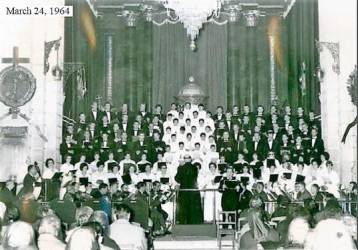
On Holy Tuesday March 24 Bazan's Polyphonic Chorale and Orchestra gave their classic Holy Week concert at San Francisco Church (photograph to the left).
The first half of the concert covered Perosi's La passione di Cristo secondo S. Marco.
The second half replayed Théodore Dubois' Les Sept Paroles du Christ (see RELIGION, Bazan Magazine for the Year 1962).
The article lauded the impressive performances of three veteran soloists, Varela, Lorente and Orozco (see ARTS AND LETTERS, Bazan Magazine for the Year 1960). The report also commended the soprano Mrs. de Llano and the treble-child Jaime Carneiro.
The concert was attended by the captain general of the Maritime Department and by the top civilian and military figures of the city who at its conclusion expressed their warmest congratulations to Reverend Fanego.
On March 27 the Polyphonic Chorale returned to San Francisco Church to take part in the customary Holy Friday service patronized by the Spanish Navy. The repertoire was also the customary one (see the religious calendar entry for Holy Friday April 20, 1962, in RELIGION, Bazan Magazine for the Year 1962).
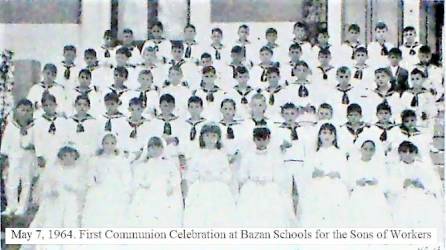
On May 7, 1964, Bazan-Ferrol hosted the day of the First Communion of fifty-one pupils from the Schools For the Sons of Workers (photograph to the right). This was the twentieth consecutive year that Bazan-Ferrol had staged the ceremony. The eight girls in the foreground of the photograph above were the sister(s) of some of the boys. Although girls were barred from the Schools For the Sons of Workers they partook of this ceremony and of First Communion with their brothers.
The Schools For the Sons of Workers were run by the La Salle Brotherhood and were in fact a conglomerate of small buildings that bore the official name, "Saint Joseph the Worker School." The citizens of Ferrol however knew it by the moniker, "Workers School," because Saint Joseph the Worker School was the inheritor of that other one started in 1916.
Saint Joseph the Worker School was launched on January 20, 1942, at the request of and sponsored by Bazan-Ferrol with the mission of educating 398 sons of its "producers." The School was located inside the walled perimeter of the shipyard. It had eight classrooms and taught four academic grades. The programme stressed four different areas of a child's education: (i) the intellect, (ii) religion, (iii) phys ed with competitive sports, (iv) music and the arts.
The 1976-77 school year represents a milestone in the School's history. A new site, facing the sea and the Astano shipyard, is inaugurated in the new Caranza suburb. From then on the school has a new name, "La Salle" ... The building is just one storey tall in keeping with the pedagogical guidelines of the epoch, the "personalized education," broad hallways and full of light...The school also becomes independent of Bazan-Ferrol. Now it is open to everyone, not just to the sons of Bazan producers as happened before. Furthermore gender segregation is done away with, the boys and the girls learn together.
(Nuestra historia. Colexio La Salle Ferrol)
The date of the First Communion celebration was always set to coincide with the religious Feast of the Lord's Ascension to Heaven which in the year 1964 fell on Thursday May 7.
The bishop of the Ferrol-Mondoñedo diocese officiated the morning Mass and the School's anthem was sung at its conclusion.
The MP3 clip was extracted from a Youtube video of the full concert given on Friday October 21, 2016, at Teatro Jofre to commemorate the Centenary (1916-2016) of the Ferrolian Workers School. The stars of the concert were the Polyphonic Chorale, child of Bazan's Polyphonic Chorale, the music band of the Northern Third Corps, baritone Gabriel Alonso Díaz, bagpipers Bruno Tembrás Freire and Xaime Villamor Andrade and the tenor Francisco Regueiro Rodríguez (1940-2019) alumnus of the Schools For the Sons of Workers (1950-54) and a former producer of Bazan-Ferrol (1954-63).
The last act of the 1964 First Communion event was the traditional breakfast in the Gymnasium followed by the distribution of souvenir diplomas and sachets of chocolates, compliments of Bazan-Ferrol. This photograph taken in 1946 shows the children seated in a room that may have been the school's cafeteria. This other photograph taken in 1950 shows them outdoors on the school grounds. The habit of setting the complimentary breakfast in the Gymnasium must have come a few years afterward.
Our warmest congratulations to these most charming "little sailors" in the happy Day of their First Communion, to their parents and relatives and to the La Salle Brothers community. And on everybody's behalf the deepest gratitude to Enterprise Management for their keen interest and for the loan of their facilities.
(Kronik Melos. "Social-Religious Activities." Bazan, 27, page 25)
The class-conscious conditioning of First Communion uniforms is worth noticing. All the boys in the leading photograph wore the "little sailor" uniform alluded to above. It would take a brave soul to spurn the rule. On the other hand it was not uncommon for upper-class boys to wear commandante uniforms similar to this one, a point already made in RELIGION, Bazan Magazine for the Year 1960.
But wait! One boy in the preceding photograph of May 7, 1964, is not wearing a "little sailor" uniform! A rebel from the Schools For the Sons of Workers or his family could not afford the expense?
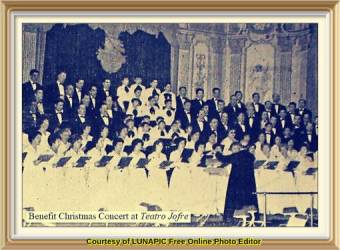
The picture on the left is an edit of the December 22, 1960, photograph found in ARTS AND LETTERS, Bazan Magazine for the Year 1960. The tool employed was the LUNAPIC Free Online Photo Editor.
On Wednesday December 23, 1964, the Polyphonic Chorale staged their usual Christmas concert at Teatro Jofre. According to the article by Kronik Melos on page 23 of Bazan Magazine, 28, May 1965, Bazan's four musical associations took part: the plucked-string orchestra, the chorale, the chamber orchestra and the band. And as usual the fundraiser was a "great success."
Another source of revenue for the Sick Workers Mutual Fund run by Reverend Fanego was the box office receipts of the regular season match between Arsenal and Ferrol played on Sunday December 20. The box office receipts were donated to the Fund. The amount collected hit an all-time record of 101,750 Pesetas. Note: On January 4, 1965, 101,750 Pesetas were equivalent to USD 1,695.83 (End of Note). "Many spectators bought tickets with the sole intention of helping their afflicted workmates," states Kronik Melos who also lauds the regular Christmas donations sent by two former Bazan workers living in Amsterdam, Mario Gonzalez and Pepe Díaz. The game's final score was Arsenal 0, Ferrol 1.
Bazan, 25, page 40, carries the following information about Spanish emigration during the year 1962 which, according to official figures, amounted to 65,326 Spaniards. Around 15% were seasonal farmhands who spent four or five months away each year.
The article remarks that traditional Spanish emigration toward Latin America had veered "in recent years" toward Europe. The main destination by far was Germany, followed by France, Holland, Belgium and Switzerland.
As a percentage of its working-age population, the Spanish province with the biggest exodus was Ourense (23%) followed by Melilla (12%) Almería (11%) and Zamora (7%).
Most emigrants send money back to Spain periodically, and this is good evidence that they remain intimately attached to their fatherland. Consequently it is logical to assume that these expatriates will after a few years return to Spain with their savings and, above all, with their work experience, prepared to participate in an economy that can engage them.
The identity of María Dolores Pérez Linos (D.P.L.) is discussed at length in the "MARÍA DOLORES PEREZ LINOS (D.P.L.) REPORTS FROM ISRAEL" section of Chapter 14, "Bazan Magazine for the Year 1962."
1. In a section entitled, "Woman's Pages," of Bazan, 23, April 1963, pages 28-29, under the heading, "Let Us Talk About Cooking," D.P.L. rates Israeli cuisine as "very bad," and adduces a similar verdict published months earlier by the correspondent of a Madrid-based magazine who declared that "whereas Tel-Aviv's restaurants might remind a customer that it is necessary to eat to be alive, Haifa's were a positive invitation to fast." D.P.L. adds that a substantial number of Haifa's restaurants was vegetarian. She compiles a long list of kosher restrictions on food. These bans mirror "the norms that regulate Israeli official and private life, which seen under a Spanish light, are incredibly harsh." However the rules did not prevail everywhere, for she confides, "at a Magyar home I have tasted an exquisite dish that combined the double heterodoxy of pork and dairy cream." Her husband was Hungarian so she formed part of the Hungarian colony. D.P.L. divides Israeli cuisine in two camps: European and Oriental. She adverts to Bulgaria and Greece which though European in fact belong to the Oriental culinary camp. Europeans cook with margarine ("butter is too expensive"). The Orientals use cooking oil. Europeans are meat-eaters, the Orientals prefer legumes. Europeans base their pastries on sugar, the Orientals on honey. Europeans spice their meals, the Orientals go for garlic. "At a Czech, Polish, German or Hungarian home they will offer you chocolate cake or apple pie, at a Turkish or Egyptian home you will make the acquaintance of sesame." D.P.L. concludes her two-page article with the observation that what Israeli and Spanish kitchens have in common is the use of retail instant soup.
2. In a similar section of Bazan, 24, November 1963, pages 38-39, under the heading, "Countryside And Countrywomen," D.P.L. expresses her admiration for the daily heroism of Israeli life. She depicts a kibbutz as "that blend of tractor and machine-gun which is the solid skeleton that supports Israel's body." A kibbutz's literature is the harvest, its tradition those who died, in whose memory woodlands are planted. "Whoever arrives here," she writes, "renders a tribute of admiration to what has been accomplished on this unwelcoming, dry and charred land strewn with stones." The first pioneers established themselves in Rishon-Le-Zion (The First Zion) "about 80 years ago" [from 1964] and that marked the start of "an 80-year war against dust, sand, the wind of the desert, the bedouins, the British, the Syrians, the Egyptians, the snakes and the scorpions." D.P.L. invites her readers to imagine countrywomen imbued with a non-religious yet "formidably mystical" vocation, who make an implicit vow of poverty and obedience, whose raiments are white blouses, shorts for work and a cotton skirt for Saturdays, holidays and for that "once in a while" when a movie is shown at the kibbutz.
Two or three hours before [we Spanish women] start our day they [the women of the kibbutz] are picking fruit or cooking or sowing wheat...and in many parts of the countryside wearing a revolver that guarantees they won't be taken alive in case of a raid, who will never have a nickel in their pocket or know what make-up is; and they feed almost exclusively on tea, vegetables and margarine...and this after 9 or 10 hours of work under so merciless a sun that five years of this way of life will take the toll of fifteen years in their organism. They realize that their lot is the toughest in the difficult living conditions of Israel, but the psychology of the "kibbutznik" is composed of generosity and pride in equal measure. Kibbutz members—men and women alike—are pleased with the material progress of the cities, be it Haifa's Metro or the nightclubs of Tel-Aviv, despite knowing that they can not enjoy the pleasures those cities offer and which their toil sustains.
D.P.L. closes the short article relating the experience of an old Russian woman who at age sixteen migrated to Israel with a group of boys and girls eager to build the "Jewish fatherland." They moved to the hostile desert, dwelled in tents for years, hauled water on the back of asses until their borings hit groundwater. Nomads plundered them, a harvest or two was set ablaze. At last they spied the first sprouts on the ground. Only half the trees planted survived, but these grew and provided shade,
And the magnificent old woman who told me this wrapped up her story—so similar to so many other stories in this country—with these words, beautiful as a Psalm: "And for the first time after so many years we heard a bird sing."
3. 1964 was a prolific year for D.P.L. the "Bazan reporter" married and living in Israel.
Bazan Magazine published three numbers, 25-27, and D.P.L. contributed four articles. Two were published by Bazan, 25, January 1964, pages 36-39. The four pages were motivated by the historic visit of Pope Paul VI to the Holy Land. His stay spanned January 4-6, 1964.
The Spanish NO-DO newsreel magazine, NO-DO Revista Cinematográfica Imágenes, covered the salient features of the papal journey in eleven long minutes.
Abridged Voice-Over Translation: 0:00-2:32 Paul VI departs at dawn [Saturday January 4]. No Pope had left Rome in the past 151 years, the last one to do so was Pius VII. The successor of Peter says good-bye to the Italian land from Fiumicino Airport. Jerusalem the Holy City is now split by the war between two peoples, Jordan and Israel. 2:33-3:45 King Hussein comes to welcome the Holy Father at the Amman airport. The arrival is announced with a twenty-one gun salute. His Holiness descends from the airplane on this cold and windy day yet in an environs warmed by affection and emotion. Jordan's monarch receives the head of the Pontifical State cordially while doves flutter roundabout. The first stage of His Holiness' visit to Palestine is the River Jordan on the way to Jerusalem. Sentries on the hilltops remind us that the country is at war with Israel. 3:46-3:48 King Hussein escorts His Holiness from a helicopter. 3:49-4:35 The Pontiff approaches the site of Christ's baptism on the Jordan River. 4:36-5:40 Thousands of people waiting for the Holy Father gather before the Damascus Gate. The Holy City welcomes the Supreme Pontiff in an avalanche of enthusiasm. 5:41-6:11 The Pope celebrates Mass at the Church of the Holy Sepulchre. 6:12-6:33 The Roman Pontiff goes to the Garden of Olives escorted by torches. 6:34-7:20 The entourage enters the State of Israel [Sunday January 5]. Zalman Shazar the elderly head of the State of Israel together with the Prime Minister and other top dignitaries delivers a speech of welcome in Hebrew and offers His Holiness a present. The journey over the territory of Galilee begins, the Pope now heads to Nazareth. 7:21-7:53 His Holiness visits the Church of the Annunciation. Outside Israeli soldiers watch the frontier from the ramparts. 7:54-8:24 Paul VI arrives to Mount Tabor, scene of the Lord's transfiguration. Again the Holy Father kneels down in prayer. His Holiness contemplates from the height the landscape of Galilee, the Sea of Tiberias and the lands of Caphernaum. [garbled] the president of Israel bids farewell to "the most eminent guest who has come" to his State. 8:25-9:10 Athenagoras I the Ecumenical Patriarch of Constantinople and the Holy Father meet. The embrace of Pontiff and Patriarch seals this solemn and historical encounter. 9:11-9:39 Bethlehem the small City of the Bread in Jordanian territory welcomes the Supreme Pontiff. 9:40-10:07 King Hussein sends Paul VI off at the Amman airport [Monday January 6]. 10:08-10:55 President Antonio Segni the president of the Italian Republic together with the Defence Minister welcome His Holiness at Ciampino Airport. The twenty-kilometer journey between the airport and Christendom's Square took two hours and fifteen minutes.
4. The following D.P.L. report comes from pages 36-37 of Bazan, 25. It is translated in full.
This December [1963] marks the sixth birthday of the MAGAZINE and the fourth of my modest but resolute collaboration.
A forewarner betrayeth not; on one of my initial pages I already said that my writing pen was certainly not Concepción Arenal's; one writes what one sees, relates it using her own style, and that's how we make do.
I recall I made my debut narrating the accurate and true impressions of an excursion to Finisterre, which I embarked upon in one of those irrepressible moments when I must "take to the woods" and discover new faces and cities; an ancestral wanderlust whose provenance I ignore—and could care less about—but which remains vibrant even though youth is but a dried flower among memory's leaves. Ah, if I could travel every highway still!
Which does not lead to Rome this time but rather brings Rome to Palestine. The Pope's visit will already have taken place when my particular telling of it will be on its way to the MAGAZINE for printing. I do not know whether I will be able to resist the temptation of stamping on the envelope the label, "Exclusive Bazán Correspondent," or "On Special Assignment To The Pontifical Pilgrimage." But presently, exactly one week before the visit, I must, and though I wished to I could not forgo talking to you about the wait, about the preliminaries of the most extraordinary event in Christendom after many centuries.
It is not necessary to state that the whole world is delighted, or to say that the preparations underway here are phenomenal, spurred on by a natural desire to be more pro-Papacy than the Jordanians who, one presumes, are exerting themselves putting up scaffolds, planing, setting up arches and spotlights. Note: D.P.L. here toys with the Spanish saw, mas papistas que el Papa, lit., "more pro-Papacy than the Pope," in a syntax so convoluted that its literal translation would confuse the reader needlessly (End of Note).
The song of bulldozers reflects a general feeling of profound satisfaction. "This year Noel has been celebrated under the sign of Paul VI's visit," state the newspapers. And of course nowadays that also means under the sign of the "flashlight," for the invasion of the boys of the press has begun establishing its bridgeheads and there will be "no room at the inn" during those two nights of lying in wait at strategic locations for the Vicar of Christ...Just as there was no room on Bethlehem's Night upon the birth of Christ himself.
Do you not perceive that even symbolically everything dovetails admirably? Even the weather is genuine Christmas weather; it is not inconceivable that the snow should come to give the landscape of Bethlehem and Jerusalem its perfect nuance, for the hard, dry cold is much more intense than usual, the thermometer dips to 0°C at night. And in a phrase that unfortunately isn't mine we can say that this brilliant moon, heading to full phase, "sounds against the earth like a cataract of silver." Let us hope that it continues to do so, that if the moonlight delivers its silver the sun delivers its gold, that the fearful torrential rains do not make an appearance and that the Pope watches the sweet Galilean countryside in all its glorious beauty, the green plain of Jezreel, the lush banks of Tiberias, and the radiant blue Lake, one of the most beautiful sights this country has to offer...The Lake where Peter received the call and which today awaits Peter's successor who comes to pray in the country of Jesus inhabited by the race of Jesus.
There is something of the greatest import that I now wish to talk to you about. Seeing this visit, as I do, from the Jewish perspective, so to speak, its perceived importance is definite: Israel, not just the government and the official platform but the man on the street, expects not one Pontiff with this visit but two. Evidently Paul VI is expected, whose curriculum as a cardinal and whose first steps in the Papacy have accorded him the prestige he deserves, but John XXIII, invisible yet enormously present, is the one who accompanies him. Note: Pope John XXIII died on June 3, 1963 (End of Note).
Nothing, not words or official mourning, can convey an approximate idea of what role John XXIII played in the change of attitude of the Israelite people (and of other religions, and of the "iron curtain"...) toward Rome, toward Catholicism. No comment or editorial on the approaching visit of the Pontiff fails to reminisce about "the wept-for, vanished Pope," "the unforgettable predecessor of Paul VI," "the good Pope John." I tell you that the word, "wept-for," is not a figure of speech: I tell you that people who never had any relationship with the Church, even from afar, have shed tears for John XXIII. Lo, he said turning to the Jews, "I am your brother," and centuries of enmity, Inquisition, mistrust, hostility, vanished in an instant. Why? Because he spoke with complete sincerity, complete kindness, because never since St. Francis of Assisi perhaps was there another heart bereft of a single drop of gall and full of charity toward every created being. Here it was said of him upon his death, "a true priest at the service of men his brothers," "a Righteous one in the talmudic sense of the word," which is equivalent to our definition of sainthood, "all his exceptional qualities: intelligence, good sense, diplomatic skill, ingenuity, were at the exclusive service of Goodness."
Do you recall that when John XXIII rose to the Pontificate he said that he wanted to be "a man among men"? No doubt he was, in the sense that Jesus was a child among Nazareth's children or later the young rabbi, delicate and frail, who preached under the overwhelming columns of Caphernaum's synagogue.
John XXIII was a man who reassuringly demonstrated through the opening of channels of peace and friendship toward everyone that even in our days of atomic power and terrors dialogue and kindness are a means of understanding each other, nay, the exclusive means of understanding each other.
He was a man who gathered round his death-bed everybody united in the shared grief of Muslims, Buddhists, Communists, Protestants and the sheep of the Catholic Shepherd. An Israeli newspaper said a short time ago, referring to the Pope's visit, "After the immense prestige, truly universal, which John XXIII enfolded the Pontificate with, how out of place would now sound Stalin's famous query about how many divisions the Pope had," and it's true, now he could be answered, "Oh, he has many fifth-columns!" Among them those that in the land of Israel, on the earth once dust on Christ's sandals, ready themselves to receive respectfully, enthusiastically, conscious of being in the spotlight of Christendom that day, "he who comes full of goodwill, he who comes in the name of the Lord."
D. P. L.
5. The following D.P.L. report comes from pages 38-39 of Bazan, 25. It is translated in full.
|
... and I will go ahead of you into Galilee.
(Matthew 26:32) |
Please forgive me if this report is brief, jittery and disorderly. The emotion persists. I have seen the Pope, I must relate it to you and I am only able to say, "Domine, non sum dignus." Note: "Lord, I am not worthy" (End of Note).
Sleepless Nazareth, cold of temperature, ablaze with enthusiasm, effervescent with crowds, exuberant with arches, flags and Christmas trees, was starting to warm its alleys with the first rays of the sun when we arrived on the glorious morning of January 5. The small town of Joseph and Mary brimmed over with green boughs of white and yellow—Vatican's colours—portraits of the Pontiff, welcoming posters and date palm leaves. Although three to four hours still lay ahead before the Pope's arrival crowds thronged the streets and the balconies as if nobody wanted to miss even a minute of the historic day. Habiliments of all the religious orders, Arab keffiyehs and tarbushes, Druze, Israeli soldiers, rabbinical and Orthodox beards mingled with the blue jeans invariably worn by Israeli youth and by others not so young. Every five meters loudspeakers of Kol Israel the National Radio reeled off the previous day's news about the Pontifical journey in Jordan, and although it broadcast successively in Hebrew, Arabic, French, English and Italian, this paled in comparison to all the world's languages heard on the street, "Parthians, Medes, Elamites and the inhabitants of Cilicia and Mesopotamia"... Note: D.P.L. alludes to Acts 2:9-11 (End of Note).
The great ecumenical occasion entered its second day brought by the happy wind that clapped among the leaves of the trees of Galilee.
Suddenly a clamor worth all the silences. The radio announced the precise moment when the automobile carrying Paul VI crossed into the land of Israel, and moments later, the precise second when he stepped upon it at Meggido the city of Solomon. The President of the State awaited the Pope there; he would see him off at the City of David in the evening. Short addresses in French. The Roman Pontiff closed his with the beautiful Hebrew word "shalom" (peace). The bread and salt of Israelite hospitality were offered the Pope and he used the language of the people receiving him to reciprocate the peace blessing.
It is said by those who were physically close to His Holiness that when his black automobile with the pontifical ensign approached Nazareth Paul VI interrupted his conversation with Cardinal Tisserant, sitting beside him, and became absorbed in contemplation of the fields where once played and worked the Child whose destiny nobody suspected then ("Isn't this the carpenter's son?"). Note: D.P.L. quotes Matthew 13:55 (End of Note).
How identical, how evocative must have seemed to him the ancient village of small boxlike houses leaning on the mount, the prickly pear cactuses growing among the stones, here and there olive trees, carob trees and the "faith's arrow, hope's dart" silhouette of the cypresses beneath this sky so pure! Yet however profound the papal meditation may have been, he was doubtlessly yanked out of it by the thunder of a single acclamation voiced in thirty languages. Amid hoorays and applause, Shalom and Salaam, the children's waving of small flags, a profusion of peoples, races, religions and generations carried Christ's Representative up on their shoulders, metaphorically speaking, to the Basilica of the Annunciation, in whose Grotto, on the very spot where "the Angel of the Lord announced to Mary," Paul VI was going to celebrate one the most intense Masses of his life. Note: D.P.L. alludes to Luke 1:26-38 (End of Note).
Nazareth's official reception took place there. The Pope was greeted by the Israel's Minister of Education, the diplomatic corps headed by the Soviet ambassador, Nazareth's City Hall, bishops, a delegation from the Rabbinate and the superiors of religious orders. Paul VI went down to the Grotto to say Holy Mass, televised so that we could all attend, you and us, you beyond lands and seas and we on the broad esplanade of the Basilica. The Supreme Pontiff reappeared outdoors to impart his Blessing at the conclusion of the Holy Sacrifice, preceded by a brief oration once more in French and the singing of Christus Vincit.
A short, fleeting pause to rest while the friars offered him a refreshment (which His Holiness would be very much in need of) and then the exit, once more like the arrival. Escorted by a few Israeli police motorcycle officers, with the respect and enthusiasm of the people, the white figure left Nazareth by way of the street that henceforth bears his name, departed very slow, deliberately, smiling, greeting and blessing the multitude cheering him. If yesterday the Lord's Vicar had walked the Mysteries of Pain, Gethsemane, the Via Dolorosa, the Holy Sepulchre, today he followed his Lord's paths in life. Departing the house of the Sacred Family he travelled over the barren land of Canaan toward Caphernaum of the proud synagogue where the young Nazarene rabbi once preached. Kfar-Nahum, which means in Hebrew, "Place of Consolation," and it was of many miracles, was so loved by Jesus that He styled it, "his town." Caphernaum beholds itself in the waters of the Genezaret on whose shores today's inhabitants, the fishermen of the Lake, welcomed the Pontiff with their arms full of yellow and white flowers.
Afterward came the Mount of Beatitudes, the field of the multiplication of loaves and fishes, the River Jordan, and at last Mount Tabor whose faraway summit appeared this morning veiled by a radiant, ragged, translucent fog which resembled a heavenly fire. Then followed the renewed homage of Israel: Hebrew children, in many places with their schoolmasters at the head, and the inhabitants of all these jolly and hardworking hamlets, the French workers, the African students... I do not weary of repeating: the constant presence and memory of John XXIII embodied all this, of whom it could also be said that he went ahead of the Pope to Galilee. Note: D.P.L. alludes to Matthew 26:32 (End of Note).
And at the end of the road Jerusalem once more.
Jerusalem which in the memorable date "opened its arms to welcome the Prophets and decorated its stones to honour those sent to her," and where Cardinal Tisserant in the name of Paul VI visited the grotto of the martyrs, a place of worship erected in memory of Hitler's victims, to pronounce a prayer there and to kindle six lights, one for each million of the dead.
Jerusalem, sacred to three religions, the cradle of peace and the site of so many wars, was today a symbol of happy contradiction: it made church bells tumble in honour of the Pope, it lit Stars of David and it offered the lilies of Judea from this ever-flowered country to the Pope.
The Pontiff had entered Israel in the morning by way of the field of Armageddon where, according to St. John, the final battle of the ages will take place. At the point of entrance he invoked the name of the prophets and of the patriarchs, "the people of Abraham, Isaac and Jacob." The people of Revelation bade him farewell at Jerusalem with the same enthusiasm as we in Nazareth bade the Shepherd of Rome farewell when he continued on his pilgrim's itinerary traversing the gentle Galilean fields toward Lake Tiberias which, decked in its own natural beauty, awaited the return of Peter impatiently.
D. P. L.
6. The following D.P.L. report comes from pages 32-33 of Bazan, 26, March 1964. It is translated in full.
Some months ago a workmate wrote me asking me to satisfy his curiosity regarding the motive or basis for the religious ban among Jews to mingle meat and milk in the same meal. I am forced to answer that "I only know that I know nothing," as I-do-not-recall-who said and many others repeated after him. Note: Attributed to Socrates (End of Note).
We should have asked some richly bearded and poorly dressed rabbi, but lacking friends on that side of the road, we had to contact an acquaintance who during his green years studied in a yeshiva—a religious school—of Poland. Apparently there is no sanitary motive or expressed reason other than it is a tradition derived from the Bible verse, "Do not cook a young goat in its mother's milk," etc. Note: Exodus 23:19 (End of Note).
Presumably all the precepts of the Talmud and of the Torah made a lot of sense from a hygienic perspective when they were dictated in the days of the Revelation, but they are not meaningful today. There is not even unanimity about how many hours must elapse between consuming one and the other victual. Everybody agrees that two hours must pass between consuming dairy products and eating meat, but as to the reverse, from meat to milk, the sepharadim prescribe as many as six hours whereas the askhenazim observe four. I lament my inability to say more. Should I obtain additional information I will reply privately or from this same platform. And now to another matter.
Let us cite Richard the Lionheart, Godfrey and the "other Baldouin," not this one of today, as three illustrious visitors before I too journeyed to Saint John of Acre—not with a conqueror's bent but a tourist's—not by sea but overland—not against the Crescent Moon but under its streamer, mumbling to myself now and then, "If John of Austria were to lift his head!" "Saint James the Apostle, forgive me...times have changed." Times have changed? At Saint John of Acre there is room for doubt. It is so ancient, so timeless its stones, that one hardly remembers that Napoleon too set foot here. His cannons yawn on the citadel's height, watching over a shore they no longer protect and a sea they no longer threaten.
And what a sea! Viewed from the battlements that one day Saladin's soldiers defended, the sea sheds its current frivolous image of "Côté" and millionaires and in our ears ring the clashes of axes and swords from the many boardings which this beautiful blueness witnessed, and we recall that before a route for cruises it was a Cross' trail. André Maurois dubs the Mediterranean an "immense graveyard of Empires."
The giant fortress suffered several fates, naturally all tragic. Blood on blood and death on death. Finally it became a prison during the recent British Mandate for Palestine; fourteen Jewish soldiers were hanged inside, the last guests of dungeons which during eight centuries saw a constant come-and-go of prisoners. This section of the fortress is now a museum. Its modern annexes house today the psychiatric asylum, another tragic destiny! Such fury of power and oppression, such madness of conquest and idealism, slew and perished between these walls that we deem the sinister building to never have been anything but!
We return summarily to the merciless sun outdoors before hurrying toward the shade of the old village, the Arab city. Here we are where we wished to be. Recesses, neighbourhood enclaves, preserve the ancient names, "Templars," "Hospitallers," "Teutonic Order"... Nothing more requires the imagination predisposed to the strident, cruel, knighthood reminiscences of Acre; but lo, there is no need to fantasize for nearly everything is unchanged. Everything is as it once was, even the rubbish of the twelfth century subsists beneath the overlying layers as one would expect in an Oriental setting, picnic watermelon rinds morph into geological strata. Curiously the new houses look older than the remainder. They were built out of ephemeral need, born to succumb amid so much perpetual stone.
Everything is perfect: the rampart walls that once closed Acre off, the giant gates, the heavy chains, the coats-of-arms, the inscriptions, the covered alleys, the magnificent arches that saw passing the magnificent coats of mail with the Cross or that resounded with Turkish drums or the hooves of horses caparisoned with fleurs-de-lis or leopards of Plantagenet... A city to visit just because of the tug of its name. There is perhaps none other in Israel that so rewards our curiosity with purest gold of unforgettable impressions.
Three showpieces overlook the Muslim neighbourhood: the Great Mosque, the Museum and the Bazaar.
The Mosque is imposing. It has a delicious water fountain of postcard quality, looking like a scene from Todo Es Posible En Granada, moored to its external wall, a blue kiosk girdling with a gilded grille four or five drinking fountains flowing continuously. Next the inevitable flight of steps up to a courtyard of garden fountains and palm trees, arcades and blue tiles, designed to convey a sensation of cooler temperature, a field which Islamic civilization masters, and I do not say this with pejorative intent. The interior of the Mosque is pretty and full of colour on its glass panes and friezes. They did not request us to take our shoes off, which I must confess disappointed me because, being a naive tourist, the blunders of "local colour" annoy me a lot.
The Museum is extremely interesting. It is located inside an ancient Arab palace under Western-style organization and management. Roman ceramics and sculptures—de rigueur in this country—weapons from the era of the Crusades, garments, furniture, horse or camel saddles, and above all, Druze, Bedouin or Kurdish jewellery. Although this is all very good, the Bazaar!...
Akko's Bazar, whose ornament and major business was once Christian female slaves, sells today, like Naples, like Haifa, handbags from Madeira, Cyprus "souvenirs", as ugly as demons, the familiar Japanese camel hair fabric and—horror of horrors!—sells, yes, the beautiful Arabic amphoras, the long neck vases, but...made of plastic.
Storytellers' markets of spices and tapestries, pray tell: where is the talking bird, the singing tree, the gilded water? Aye, the same centuries that overtake and mar men embellish the stones. And in the midst of this easy and far from disagreeable disorder of the Orient, in front of coffee bars replete with male customers exclusively, pass by for every woman wearing velvet gown and white kerchief—here most Muslim women do not veil the face—pass by, I say—twenty or thirty feminine silohuettes with "bouffant" hairstyles and nylon blouses, awaiting the time of the movie show to go and be entranced by Elvis Presley...
An extremely old beggar, oblivious to the sunlight, oblivious to the houseflies, seated under a poster of the irksome singing lad, turns his blind eyes to the passersby, imploring alms: Gihsm' Illah Alr'aham Alr'ahim, "In the Name of God, the Merciful, the Compassionate."
Wrapping up...one must return to the world of "steel and lead, cement, the screw and the wired music." The wish to return to Saint John of Acre abides. Upon arriving back home we took a shower. The running water washed the dust of centuries off our bodies.
D. P. L.
7. The following D.P.L. report comes from pages 40-41 of Bazan, 27, July 1964. It is translated in full.
First is Samaria, whose people have been stamped with an indelible seal of kindness because of the man who sheltered someone wounded on the road that descends from Jerusalem to Jericho and because of the woman who gave drinking water to a Galilean who in turn offered her other waters that quench thirst eternally. Note: Luke 10:25-37 and John 4:1-42 respectively (End of Note).
Next after Tel-Aviv (called Joppa in ancient times, the port of Jonah the prophet) comes the Sharon plain, renowned for its roses, but now a sea of poppies under the splendid January sun. Clusters of veiled Bedouin women and girls saddled with gold and grime tend goat herds.
The railroad track bisects. To the right it marches onward across the plain, toward the Negev and the desert, Solomon's mines and the Red Sea. Today I am taking the track heading left. The parting of the ways annoys because one would like to go both where we are heading and where we are not.
The Bedouins and the gypsies are held in similar disrepute, but I find the lifestyle of both appealing, especially the gypsies: few constraints and long miscellaneous journeys, always wandering to and fro, and...well...away with these digressions! otherwise we shall never reach Jerusalem, like the protagonist of Lord Dunsany's tale who never reached Carcassonne.
The train transporting us starts ascending the mountains of Judea. Massively sized barren stone, cliffs, a river that carrier posies of snow amid the froth because it is very cold despite the sunlight and because it is necessary to climb a great height to reach the Holy City.
One "goes up" to Jerusalem and it is this sense of climbing that steeps the existence and the survival of Israel, and without this awareness one understands nothing at all. The Hebrew term for the waves of immigration is aliyah which means "ascent." One doesn't "come" to Israel, one "ascends." And by God, on this trail I ascend with illustrious company! This way came the Virgin on a visit to St. Elizabeth who inhabited these mounts; this way came the Sacred Family bringing twelve-year-old Jesus to the Temple for his Bar Mitzvah (religious coming of age); this way came Jesus with his disciples time and again until the final journey that preceded the true and definitive Ascent.
Every vista is an invitation to evoke interspersed with others like the awesome terrain or the anecdote: we are so close to the border that at a certain point the train crosses it outright and passes a Jordanian town whose children, in the midst of this fine mess that is the Middle East, yell greetings to the passengers as kids all over the world do. The passengers shrug off the display knowing the two countries are practically at war though officially in an armistice.
Thus proceeds the trip, and suddenly one more curve and the first tower stabs the heart almost before it does the eyes. "If I forget thee, o Jerusalem, may my flesh become the repast of wild birds; may no grass grow over my bones..." (Chant of the Wailing Wall).
But who could forget Jerusalem?
This city without which neither Rome nor Mecca would exist—this city of two nations severed by a frontier which is like a river without ford or bridge—this city that prays for the rest of the world and which the rest of the world prays for—this city burdened with its triple sanctity is like those prisoners of the Middle Ages sentenced to perish of thirst by having their hands shackled to within a few centimeters of the water jar. Each half stretches its arms anxiously toward the other. Rambling through its streets one arrives at places apparently distant in a prospect of the whole. Others close at hand turn out to be barred by barbed wire or by a border guard.
The city weighs down on the soul like no other and one can not miss that we are in a precint like no other, where every visit takes on the character of a pilgrimage. More than the end of a journey it is an end; not for naught has it been for centuries the finish line of warriors and pious people, and yet this city, overrun so many times by the edge of the sword, has seen all swords shattered. Those who came with the sound of war were unable to retain it for very long (because a century more, a century less, hardly counts in these ancient lands whose peoples were making history long before the prehistory of everyone else). Neither the Crusaders nor the Turks nor the British. Jerusalem the conqueror that makes every conquest ephemeral!
My visit to this city "besieged by mountains" and today by rolls of barbed wire seems to me, even now, unbelievable!
We went with the intention of seeing what can not be visited, the entire Old City, from the top of any one tower of this city of temples.
I doubt there is so prodigious a collage anywhere else. The domes of the Holy Sepulchre and of the Mosque of Omar, the mournful-green stain of Gethsemane, behind which lies the valley of the tombs, of Josaphat, where we shall all gather at the sound of the angelical trumpet in the last day. In the foreground the Tower of David, delicate, svelte, with the miniaturist charm of profiles in the Oriental radiance. All of it closed off by the wall that this same king built and on which Jesus wept predicting the destruction of the Temple and on which open (opened!) the gates with beautiful names: Damascus, Jaffa, long ago the passway of caravans and cortèges; through which Jesus entered on Palm Day and which today are one-way gates useful for closing off only. Behind them lies the Old City, forbidden to us. In front of them the New City, which we will discuss in detail. Between both, Mount Zion, which we will discuss in even greater detail because the graves it houses rank among the most visited pilgrimage sites in the world.
We stand on a summit. We close this article enveloped by its pure air. This dry, thin, transparent air of the mountains of Judea which fuses the earthly Jerusalem with the heavenly one to the point of making us feel simultaneously alive and revivified, flesh and bones "still" yet "already" resurrected before dying.
Jerusalem where one does not arrive but "returns to."
D. P. L.
8. The second paragraph of "Jerusalem (I)" suggests that "Jerusalem (II)" was written in January 1964.
Why did Bazan Magazine delay publication of "Jerusalem (II)" by more than a year? It is my contention that the Spanish government did not view D.P.L. favourably for having moved to Israel and for manifesting a pro-Israel bias. It is well to remember that Spain did not establish diplomatic relations with Israel until Januay 17, 1986. Franco died in 1975. His government prided itself on the "traditional bonds of friendship" between Spain and the Arab world. Official visits by Arab heads of state were frequent. Three are outlined below.
a. On September 23, 1960, Gamal Abdel Nasser made a brief stopover at Madrid's international airport. According to the Catalan newspaper, La Vanguardia (September 24, page 5), the Egyptian president arrived to Barajas Airport at 8:05 AM aboard a chartered "Comet IV" jet of the United Arab Airlines. Between 8:30 and 9:00 AM the Egyptian and Spanish delegations had breakfast at the Transit Lounge. Afterward Franco and Nasser chatted privately for 1 hour 40 minutes. "The send-off was even warmer than the welcome," Franco and Nasser embraced twice. Franco wished the Egyptian president a good flight and auspicious success in his mission, then remarked aside to Dr. El-Aza the Jordanian ambassador, "Please tell him that here abides a friend."
The following clip recorded the event. The full newsreel, nine minutes long, was first shown on Monday October 3, 1960.
Voice-Over Translated: In a stopover at Madrid on his way to New York, Gamal Abdel Nasser the president of the United Arab Republic stands beside Generalissimo Franco the head of the Spanish State. They review the company that renders him honours and salute the flag. In a compartment of Barajas Airport a breakfast is offered to President Nasser and to the ministers who accompany him. Also present are the Spanish ministers of Foreign Affairs and Aviation beside other authorities. Afterward the two heads of state move to an adjacent room where they hold a conference during one and a half hours. This proceeds in the terms of frank and sincere friendship which characterize the relationship between the United Arab Republic and Spain. President Nasser heads to the plane accompanied by the Generalissimo. Both statesmen bid each other farewell with a cordial embrace, expressing their best wishes for Spain and for the Arab world. Gamal Abdel Nasser says good-bye before boarding the Comet that flew him to North America to attend the U.N. General Assembly.
b. On April 13, 1964, King Hussein of Jordan made a brief stopover at the joint U.S.-Spanish Torrejón de Ardoz Air Force Base. According to the Catalan newspaper, La Vanguardia (April 14, page 5), the Jordanian king arrived to the base at 12:53 PM aboard U.S. President Johnson's "Boeing 707," number 86972. General Franco and King Hussein, accompanied by American, Spanish and Jordanian authorities, enjoyed a luncheon at the Officers Club. The menu consisted of consommé, bass and chicken with sherry, cake, fruit juice, ice cream and coffee. The luncheon finished at 2:30 PM. Afterward Franco and Hussein conversed for more than twenty minutes. "The Leader sent his royal guest off with the same show of affection he had welcomed him with." The airplane carrying King Hussein departed at 3:05 PM.
This second clip recorded Hussein's visit. The full newsreel, nine minutes long, was first shown on Monday April 20, 1964.
Voice-Over Translated: Coming from Amman, the aircraft that carries King Hussein of Jordan arrives to the joint Spanish-American air base of Torrejón de Ardoz. His Excellency the head of the Spanish State welcomes the monarch at the foot of the boarding ramp. Mutual presentations of the two retinues over, both heads of state turn toward the podium erected for the reception ceremony. A company of the First Air Force Region parades past. A representation of the U.S. Air Force permanently stationed at the airfield also stands in formation. Next King Hussein and the Generalissimo head to the Officers Club. After the luncheon that Franco offered the Jordanian monarch the two have a cordial chat in the presence of the vicepresident and of the minister of foreign affairs on the Spanish side and of the royal highnesses brother and uncle of the king on the Jordanian side. The talks over, His Majesty bids farewell to the Spanish head of state and returns to the jet that will take him to the United States. King Hussein of Jordan makes the trip aboard the personal plane of President Johnson.
c. On October 19, 1967, King Hussein of Jordan began a semi-official holiday in Spain that lasted four days. This was his first visit since April 13, 1964. According to the Catalan newspaper, La Vanguardia, the king arrived via Argel at 11:20 AM. General Franco greeted him on the tarmac; both hugged and Hussein kissed the general on both cheeks as Arabs do. Some three hundred Jordanian students packed the airport terraces shouting, "Palestine is ours," "To do battle is the only way," and "Long live Spanish-Arab friendship." The two heads of state, Franco and Hussein, acknowledged the students with a wave of the hand. "Both seemed extremely pleased" (October 20, page 5). On October 23 the Jordanian king gave a news conference at 2:30 PM in the music salon of Moncloa Palace. He expressed his gratitude to the Spanish people for "the moral support they have given us the Arabs at critical moments." To questions from journalists he stated that it was up to the U.N. to resolve the Arab-Israeli conflict and that resorting to military force was an "extreme, ill-advised formula." He was seen off at the airport by the Spanish vicepresident. Hussein left Spain on a regular Iberia Airlines flight bound for Paris (October 24, page 5).
The clip shows Hussein's arrival on October 19 followed immediately by his departure on October 23. The full newsreel, ten minutes long, premiered on Monday October 30, 1967.
Voice-Over Translated: His Excellency the head of state Generalissimo Franco arrives at Barajas to receive King Hussein of Jordan. The public on the terraces greets him affectionately. The Jordanian Airlines Caravelle lands piloted by Hussein himself. The Leader awaits at the foot of the staircase and receives the Jordanian monarch cordially. Franco and Hussein review troops of the Central Air Force Region with ensign, gala uniform and band rendering honours. Next the Generalissimo presents Hussein to the government ministers. Both heads of state set out to Zarzuela Palace, residence of the Jordanian monarch during his stay in Madrid. Note: NO-DO mistook the palace (End of Note). Later King Hussein arrives to Pardo Palace for an audience with His Excellency. Franco and Hussein have a cordial interview in the company of Mr. Castiella the Minister of Foreign Affairs, the Jordanian ambassador in Madrid and the Spanish one in Amman. His sojourn over, King Hussein of Jordan was complimented by the government at the transoceanic Barajas Airport; members of the diplomatic corps and other personalities also came to see him away. The king of Jordan heads to the airplane accompanied by Admiral Carrero Blanco the vicepresident of the government. Hussein bids him farewell, thus wrapping up his visit to Spain.
9. "Jerusalem (II)" was written in January 1964 and published in Bazan, 28, May 1965, pages 32-33.
D.P.L. begins Jerusalem (II) with a description of the tomb of King David.
It's the city of David and we stand in front of his tomb. The ashes of Torah scrolls found in the ruins of synagogues torched on Hitler's orders surround David's memorial. Ashes from Berlin's synagogue scorched in 1933 on "Crystal Night," which marked the start of the latest and greatest persecution, to synagogues of the Warsaw ghetto ignited in battle. Fruitful ashes these if we consider where they are and the nation that arose out of them. The tomb of King David is the loftiest praying spot of the Jewish people since the Western Wall on the other side is presently inaccessible.(Bazan, 28, May 1965, p. 32)
She ends Jerusalem (II) with an unexpected disclosure,
These are my final weeks in Israel. Today the landscape is severe, bald the mountains, bare the stones, but there will be plentiful yellow and white flowers covering this land everywhere in two months' time, following this winter's torrential rains. The marvel that is Israel's "postcard" will blossom: the red hibiscus set against a divinely blue backdrop.In two months' time I will no longer be here. I won't be here? Well...let's say I won't have the soil of Palestine beneath my feet, "but if I forget thee, o Jerusalem..."
Even so a prayer, a request before leaving the city thrice Holy, "Lord, grant that I shall return," return to the East—to travel anew the trail where sunlight strikes the eyes—return to this Jerusalem where pious Jews come to die and the Gods and the Prophets come to ascend to Heaven.
(Ibid., p. 33)
10. D.P.L. wrote the next article entitled, "A Bright Orchard Where The Lemon Tree Ripens," in July 1965 (at long last she posted a date of writing!). Her report was published in Bazan, 29, October 1965, pages 32-33. In D.P.L.'s own words it is the final report of her series about Palestine.
D.P.L. focuses on the famous Persian Gardens of Haifa, sets forth the core of the Bahá'í faith and describes a visit she made in November to the garden surrounding the grave of Abbas Effendi, which lies "halfway between Nahariya and Saint John of Acre."
We visited this wonderful garden of sleepers on a perfect autumn afternoon. Yet autumn does not really exist in Israel! hardly the flight of one leaf, more peregrine than fallen, to let us say like Juan Ramón: "the entire autumn, arisen, in that one petal of yours." Anyway a November afternoon.We sat down on the marble steps that descend from the main tomb to hear the silence: the sky was lucid and sunless, the air sweet and windless, the minaret of Acre's mosque showed in the distance. Never would I have believed that such peace could exist, such profound, relaxing and restful peace. A Budhist would call it a propitious moment for illumination.
Then a child screams, a dog barks, a car passes, and the glass shatters, the garden floods. But at least for a moment we would have said to Time, "Halt presently. O Temps, suspend ton vol..." It doesn't because it is always hurrying, but that does not matter too much for it has already bestowed the gift on us.
(Bazan, 29, October 1965, p. 33)
D.P.L. extols Israel forthrightly at the end of the article.
Bread and poverty are shared, there is no cruelty toward men, animals, flowers or toward any of God's creatures. Everyone "feels like somebody so long as there are others about." Misfortune finds friendship and laughter springs from personal happiness, not from someone else's pain.If I had to describe Israel in a minimum of words I would style it, "the country of kindness." No one is wealthy; no one dies of hunger; a more fortunate one shares with a less in solidarity.
The style of the workday resembles America's but the night belongs once more to the East, and when the terrible blinding sun disappears from the sky, the pioneer sits down to rest beneath an immense field of stars or beneath the large warm moon. Stars and moon appear without an interval of twilight, and serenity settles upon the small recess of land stretching from the mountains of Judea to the sweet garden of drowsiness that lies between Nahariya and Saint John of Acre.
Cypresses, jasmines, lemon trees, "you come along with me, my heart carries you." I think I have spoken about the hibiscus on another time. I know there are none here [N.T. was D.P.L. back in Ferrol then?] but when a red flower stands out against a blue firmament, at that instant, hovering over the flower like a butterfly rides the nostalgia forever.
(Ibid.)
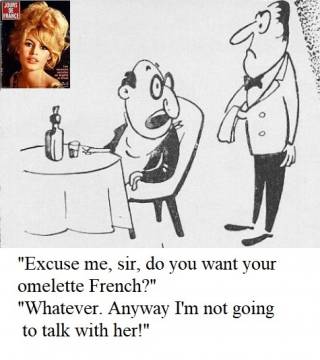 |
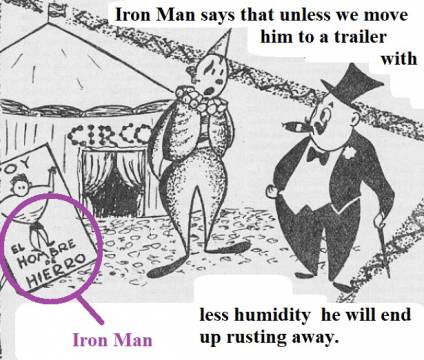 |
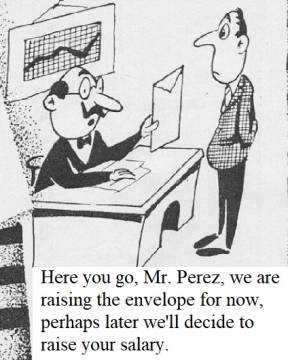 |
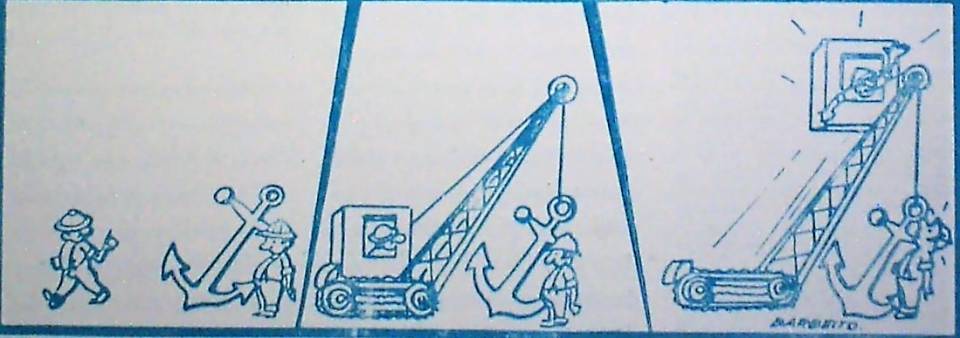
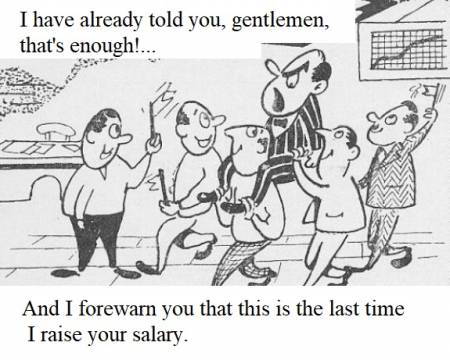 |
 |
1967: Bobby Gimby's quintessential song celebrating Canada's 100th year of confederation.
Galiciana's newspaper archive is not a good source of local news for the year 1965 because its digital files, where Ferrol is concerned, are either sparse (eg. no Ferrol-based newspaper) or spoiled (unreadable).
However a fair-enough picture of what Ferrol was like between 1954 and 1964 has already been given. Every reader should of course bear in mind that there was no freedom of expression. Press censorship was enforced strictly and any dissent or veiled criticism had to be couched in terms acceptable to the dictatorship; consequently a mindful reader must read between the lines and extrapolate any "bad news" that did get published.
Even the government admitted that Spain was an underdeveloped country. For a long time the official excuse was that the widespread poverty and hushed hunger were the fault of the "Reds"; the "Reds" had drained the Central Bank of its gold reserves during the Spanish Civil War and sent the bullion to the Soviet Union in exchange for armaments. This was a tacit admission that Spain would not be able to pull itself up by its own bootstraps and that salvation had to come from abroad. Eventually it did. Spain's membership in the European Union, the influx of expatriots' money and American aid, to a lesser extent, finally yanked Spain out of the medieval mud pit it wallowed in for many years following the end of the Spanish Civil War.
In addition the official excuse that widespread poverty and hunger were the fault of the "Reds" begged the question: why had Spain been equally backward when the Central Bank's gold reserves had lain intact and the "Reds" had not yet come to power? For in late July 1913 a capitalist Russian journal, Promyshlennost i Torgovlya (Industry and Trade), deplored that Tsarist Russia's index of economic development rubbed elbows with Spain's,
Our industrial and commercial satraps declare that "it is at first glance paradoxical" for Russia to be among the great and advanced powers as far as her output of iron, oil and a number of other items is concerned, while her level of per capita consumption (i.e., the total amount of important items produced per head of the population) "makes her the neighbour of Spain," one of the most backward countries.(V.I. Lenin: "How can per capita consumption in Russia be increased?" in Works, 19, pp. 292-294. First published August 3, 1913)
The year 1965 was for Spain similar to the previous two. The general standard of living continued rising slowly. The government devalued the currency periodically, so the wiser households took to buying goods like home appliances on credit.
September 1965 was traumatic for me, a sinkhole you never again want to parachute down into. The changeover to British culture, the England which Spanish textbooks taught us to always remember as La Pérfida Albión (Perfidious Albion), the changeover to an unfamiliar language and to a novel school system was particularly deleterious. Hardly off the boat I was arbitrarily put three years back academically. In the batting of an eye I became a twelve-year-old grade-fiver and no one seemed to care either at home or in the school except for my Grade 5 homeroom teacher who provided additional assistance with the English language and encouraged me. He did this after school hours many afternoons on unpaid time. Furthermore he catapulted me into the sixth grade halfway through the 1965-66 Canadian school year. Now I lagged two years behind the pack. Thank you very much, Mr. Ciuffo, wherever you are!
A Jewish schoolboy, seeing my utter loneliness and alienation in the schoolyard during every recess, generously introduced me to his pal, Mark, and we three played soccer regularly using a tennis ball. Jerry Lotterman, that was his name, even invited me to his house. I went. Subsequently I asked Mom if I could reciprocate. She turned me down. Why, you may ask? Perhaps a sense of her inferior social standing in Canada, and fierce Spanish pride. Perhaps the vestige of a lifelong exposure to Roman Catholic anti-Jewish diatribe, printed and verbal.
Surely it is no secret that Spain had and still has a very strong social undercurrent of antisemitism, the bequest of centuries, which surfaces, like a Loch Ness monster, when you least expect it.
A year later it would emerge inside me under the incitement of a fellow Portuguese-Canadian schoolboy, and I turned on my benefactor! But this should not surprise anyone familiar with the morality of Imperial Rome, an empire lauded to the skies on the pages of my primary school textbooks, an empire whose criminal culture steeped the colonies it once possessed. Weren't the Indians who welcomed Christopher Columbus later slaughtered by the admiral's fellow countrymen?
Thankfully Canadian education served to vaccinate me against the injected virulent strain of Spanish/Portuguese antisemitism.
What made the changeover from Spain to Canada particularly onerous and rankling was the absence of a convincing explanation as to why we were emigrating. "I did not leave Spain for political reasons," Dad told me emphatically more than once. An economic motive perhaps? Nope, he entered Bazan-Ferrol as an apprentice and trained to become a draftsman. This was a secure lifetime job in a key state enterprise.
As we landed in Canada and subsequently travelled to Toronto on one of the special immigrant passenger trains that regularly covered the Halifax-Montreal-Toronto route, Dad turned into an unemployed forty-year-old man on a desperate quest to find a job. An initial string of jobs proved too tough for him and he had to quit them all. The family was heading toward bankruptcy—a dizzying prospect—and the home environment frazzled.
Unexpectedly a "small miracle," a chance meeting, pulled our family back from the brink of the abyss. Sometime later another "small miracle" lifted me out of the sinkhole. Seven to eight years after deboarding the train at Toronto's Union Station Dad bought a semi-detached house on credit and drove to a permanent job in a brand new car. Meantime I and my two brothers attended the University of Toronto.
All that harrowing adventure lay distant and unknowable in the summer of 1965. As the month of September loomed irredeemably nearer and nearer, I kept hoping and praying that Dad's migration project would somehow derail, refusing to accept that we were going away for good. Even after boarding the white railbus set to leave Ferrol I clung to the slim hope that the train's engine would malfunction and not start. For two or three anxious minutes this seemed possible, for the scheduled hour of departure had passed and the train not budged. Some individuals were engaging the station master in busy conversation on the platform. Then, to my horror, the station master raised his red baton and blew the whistle; the railbus engine ceased idling, the carriage lurched forward, the wheels clicked, and my heart sank.
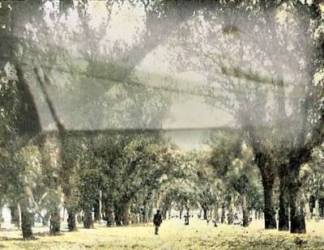
| 5. | Departed Ferrol in the early afternoon by railbus on the first leg of a 30-hour-long trip to Barcelona on the Mediterranean coast. |
| 7. | In Barcelona boarded SS Leonardo Da Vinci with destination the port of Halifax (Canada). |
| 14. | Arrival to the port of Halifax, Nova Scotia. |
To close this chapter I pose my takes on two relevant subjects, Franco's Spain and emigration. These are ad-lib opinions, not the fruit of academic research but the froth of childhood recollections plus the banes and boons of emigration. The reader should keep this Galician refrain in mind, Cada quen fala da feira según lle foi nela ("Everyone assesses a country fair by how well he fared in it").
Franco's Spain. The casual reader may well ask why this webpage glorifies Franco's Spain in several crannies. There is a hyperlink to a musical salute to Generalissimo Francisco Franco right away in the Introduction, a second hyperlink to Cara Al Sol the anthem of Falange Española in the news item for November 20, 1955, hyperlinks to several pieces of the Youth Front songbook, and even a hyperlink to Falange's adaptation of the German National-Socialist Party anthem, "Horst Wessel Lied," in the news item for November 20, 1954.
Dear reader, these songs voiced the regime's ideology and every literate student had to memorize minimum the lyrics of Cara Al Sol.
Falange's adaptation of "Horst Wessel Lied" proclaims unequivocally, forthwith, the synergy amongst Falange, Franco's regime and Hitler's Germany. This affinity was conveniently forgotten by everybody after Hitler's defeat. The once-compulsory Roman/Nationalist salute was set aside, but Spain's absurd timezone, a legacy of that synergy, remains entrenched to this day (September 29, 2023).
The common thread running through most Fascist songs is the warrior's bravado, the virile defiance of death, the exaltation of Spain to almost the level of a national deity on whose sacred altar the common soldier must shed his blood in a redemptive holocaust if the swings of geopolitics should require it. The songs do not hold out the promise of a redistribution of Spain's landholdings or of the dominant classes' amassed wealth, the elimination of widespread illiteracy, the curtailing of hunger, destitution and homelessness, the abolition of exploitation in mines, factories or tilling fields. The songs do not recognize Spain's diversity nor accept its various languages. In one sentence, the songs shun social content.
At least the lyrics of The Internationale, the archenemy's anthem, promise relief to the poor, to the exploited and to the oppressed—it is a rousing hymn to social justice—it puts forth social content—but those other songs promise nothing. They are flamboyant warrior chants which the Roman legionnaires of two millennia ago could assimilate after trading "Spain" for "Rome" or for the god Mars.
In consonance with the lyrics of the warrior songs one pillar of Franco's Spain was the military ethos and discipline. The lower your rank the harsher the discipline and the probability of enduring verbal or physical abuse. The higher your rank the more numerous the perks, greater the respect and the disposition to overlook peccadilloes. A small girl was stripped naked in the closet room of my primary school by the head teacher. I overheard a couple mentioning this incident, hush-hush, to my parents on a Ferrolian street. My parents did not react, nor did anyone else; the little girl's trauma went unpunished; evidently she hailed from a family belonging to a dispensable social class. That is one example of the military ethos and discipline exercised by Franco's regime that I recall. The children of the upper class perceived their privileged status and some took advantage of it. In another incident two well-heeled children, crouching behind a hedge, badgered a guard of the Municipal Park with insults. I was with them, "thanks" to Mom's deference to theirs. I was petrified because my Dad's draftsman rank would not shield me from a good thrashing if all three of us were nabbed. We scampered out of the park. Twenty or thirty minutes later, on the bank of a road under construction near the old Canido cemetery (see May 5, 1963), the two rascals picked up the gravel and started pelting me with it. Luckily they missed. I returned home by a long roundabout way. I mentioned the incident, but my parents shrugged it off. Had one of my retaliatory throws hit and hurt one or the other aggressor, I probably would have received a good thrashing at home. That is a second example of what the military ethos and discipline of Franco's regime meant. Fie on Franco's Spain!
Another well-known pillar of Franco's Spain was the Roman Catholic Church. This webpage does not hide it. Note: Pope Pius XII vested General Franco Knight of the Supreme Order of Christ in 1954 (End of Note).
The third pillar was American backing (see, for example, "Shipyard News" of Chapter 12, "Bazan Magazine for the Year 1960"). Note: U.S. President Eisenhower hobnobbed with General Franco in 1959 (End of Note).
Emigration. Between the second half of the nineteenth century and the first half of the next, normal Galician emigration flowed westward to South America primarily.
After the nineteen fifties the main stream began to veer north toward West Germany and Switzerland primarily. Northward remains the most logical direction of "emigration" today, i.e., to the wealthier fellow members of the European Union. South America poses a serious security risk and North America teems with illegal migrants and legal immigrants.
The best way to emigrate to anywhere in the world is always with a guaranteed contract or firm job offer under your belt. Upon arrival you will be warmly welcomed because the host country considers you a boon, not a burden.
The best time to emigrate on an adventurous whim is when you are young and single. If you are over twenty-five years old, think it over. From a prospective employer's perspective you are already getting "old"; the host country almost certainly has many young people with qualifications similar to yours. If you are married, think it over twice; it is not uncommon for a spouse to resent your move. If you are married with children, do not go without a good job contract and good housing in waiting; even then your children will probably resent the shunting of their education and the loss of their friends.
If you decide to tread on my Dad's footsteps and emigrate to Canada you can vet your expectations online. You can watch Youtube videos posted by previous immigrants (example). You can browse the federal and provincial government websites for pertinent information. You can browse job banks, here is one. If you master Canada's two official languages, English and French, you will have a definite edge in your quest for employment. Likewise if you have a skilled trade in high demand. Before you step on the boarding stairs you can keep up to date with Canadian news via mainstream or alternative media like Viva Frei or Jordan B. Peterson. And you can also keep abreast of the current weather across Canada.
Emigration Ballads |
| Translation from Galician to English of 4 Classic Emigration Ballads |

The first ever performance of Maese Villarejo in Ferrol took place on Tuesday August 23, 1955. Villarejo's puppet show was a highlight of the summer holidays for many children. The main characters that I remember were Gorgorito (Squeaky Voice) La Bruja Curuja (unofficial name of the witch) and Rosalinda (Gorgorito's girlfriend). The book explains that Gorgorito is a "7-year-old boy" lone-ranger type and that Rosalinda was first a brunette. The Rosalinda I recall was blonde.
With the back cloth depicting a gloomy forest, there was Gorgorito facing the audience and asking perplexed, "What's the matter, what are you saying?" "SPIDER!!!" (a huge black one was dropping haltingly upper right). Gorgorito, cudgel slung over his shoulder, looks behind him, but the spider has (been) pulled back up out of sight. "Don't be afraid," Gorgorito tells the children, "there are no spiders here." "SPIDER!!!" (descending gingerly again). A darting glance backwards, spider is gone. Gorgorito turns to his small friends again, "Even if there were spiders I have the cudgel with me." "AAAAAAAAHHHHHHHH!!!" (the spider has plumped down on Gorgorito).
The real name of Maese Villarejo was Juan Antonio Díaz Gómez de la Serna (b. 1922, d. 1986). Born in Madrid, the outbreak of the Spanish Civil War found him in San Sebastián, city that fell to the Nationalists within two months. He started doing puppetry in the campsites of Frente de Juventudes (Youth Front) where he created a character named Flecha Juanín which later became Gorgorito. The puppet show became profitable in the nineteen fifties. From October to April he and his wife worked the theaters of Madrid, their repertoire included puppets for adults. From April to October they took the children's show on the road. They spent three months of 1956 doing a television show in the South American country of Colombia and in 1971 they contributed to the Spanish movie, "Varietés."
Here is how Maese Villarejo defined Gorgorito,
I believe that he is my alter ego. He is the character I always dreamt with, a bit Tarzan and a bit Quixote. When I was a child I wanted to be like Tarzan, that's why I gave Gorgorito his parabá, parabá, parabá call which is in reality a parody of the ululating yell of the king of the apes. Like Don Quixote, Gorgorito is something of a knight errant. He roams about, always attempting to right wrongs, aiding the weak and defending justice.
As my parents and I passed by the back of the puppet stage well ahead of showtime one afternoon, a tall, slim man with a cigarette in his mouth exited the small cabin. A park hand loitering about asked the man, "So, is everything ready?" The other replied skilfully, nodding back toward the cabin, "Naw, they're still in there getting everything done." And I quit thinking that I had just seen the man behind the curtain, Maese Villarejo himself.
|
Té, chocolate y café (Coro: Té, té, té)
En luchas y batallas con brujas y ladrones
Té, chocolate y café (Coro: Té, té, té)
El cuento se ha acabado, los buenos han vencido,
Té, chocolate y café (Coro: Té, té, té) |
Tea, chocolate and coffee (Chorus: Tea! Tea! Tea!)
In fights and battles with witches and scoundrels
Tea, chocolate and coffee (Chorus: Tea! Tea! Tea!)
The story has ended, the good ones have won,
Tea, chocolate and coffee (Chorus: Tea! Tea! Tea!) |
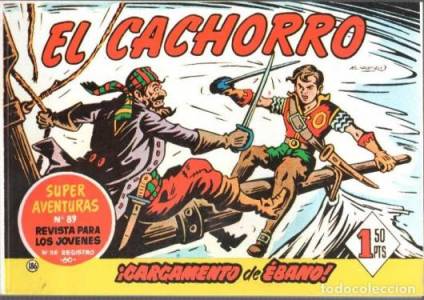
The superhero comics of my childhood fictionalized several epochs of Spain's history. The comics reflected the nostalgia of a decadent empire conscious that its "glorious past of conquest" would never repeat, conscious that its military training and equipment had become obsolete and that the tide of national liberation movements achieving independence for the colonies of stronger European powers forebode the end of its very last colonies located on the African continent.
The most popular superhero was El Capitán Trueno (Captain Thunder). Vikings and Moors were his foes. The numbers I read fictionalized the 800-year-long struggle between Christians and Muslims on the Iberian Peninsula. The swashbuckler was accompanied by a burly man named Goliath and by a teenager named "Crispín." Hostilities alternated with apparent truces and temporary alliances: in one number Captain Thunder sojourned at a Moorish palace.
The second most popular superhero was El Jabato (The Shoat). The comic imagined the epoch when Spain was a Roman colony. The only print that I remember had the superhero marooned on a craggy island strewn with human skeletons and infested with giant crabs.
My favourite superhero was the last one of the lot: El Cachorro (The Cub). The numbers I read fantasized clashes between English corsairs and Spaniards on the Caribbean Sea. The Cub and his crew scoured the Spanish Main boarding and blowing up every pirate ship they encountered. This comic was my pick when I was a child because the reading material of primary schoolchildren portrayed England in a very bad light as a long-standing enemy of Spain. The byword "pérfida Albión" (double-crossing Albion) circulated widely in the society at large while an undertow of bitterness suffused primers and history books whenever they broached episodes of war between the two countries. The Spanish Armada was not defeated by the superior skill of English sailors—the books and the adults asserted—but by Atlantic gales. Sir Francis Drake was not a bona fide admiral—they jeered—but a vulgar brigand. Every buccaneer was a craven agent of double-crossing Albion sent to plunder Spanish convoys of gold and silver, but timorous of direct confrontation with men o' war. The sanctioned version of history also maintained that Protestant England was with the assistance of a renegade Spanish friar responsible for a widely publicized, infamous libel of Catholic Spain which the authorities and textbooks dubbed "La Leyenda Negra" (The Black Legend). The Black Legend described the Spanish conquest of America as a barbarous undertaking, virtually amounting to genocide of the aboriginal peoples, and it tabbed the domestic workings of the Holy Inquisition as an exercise in exceptional cruelty. Authority figures and textbooks remonstrated that the Black Legend was a fabrication and a dastardly exaggeration, fruit of English envy of the Spanish Empire. According to the same sources the blame for Nelson's victory at Trafalgar lay with the French admiral in charge of the joint French-Spanish fleet. The glory of Trafalgar lay with the Spanish commander who laid aside his misgivings, adhered to strict military discipline and assumed the unsound battle formation imposed by the Frenchman. Schoolchildren learned that the illegal British occupation of the Rock of Gibraltar was an open wound in Spain's soul and a flagrant violation of the Treaty of Utrecht. Note: The dispute over the Rock prompted the closure of the border fence in the final years of General Franco. The argument brandished by his government for the return of the Rock to Spanish sovereignty has been upheld by every democratic government since (End of Note). I distinctly remember and quote the following pious caveat placed by the authors of a high-school textbook ahead of their list of rankling grievances against England: "Far removed from us is the intention of arousing in our readers sentiments of hatred toward any country or peoples." Notwithstanding which they and everyone else most certainly did. I exulted to see Spain's arch-enemy trumped and trounced at sea by the hand of El Cachorro every two weeks with British regularity. Note: Albion's riposte arrived late September 1965 (End of Note).
Another action comic dealt with the Second World War. The losing Germans were treated with respect and sympathy.
Other popular comics were a compilation of cartoon strips set in a contemporary environment. Comic TBO was the archetype, first published in 1916. The backdrop to many vignettes mirrorred the social reality of the day. For example the following reliable notions about Spain can be inferred from this 1961 TBO edition: (1) there was a wide gap of income between the well off and the poor, (2) thumbing a ride was in vogue, (3) common agricultural implements were primitive, (4) water main shutoffs were frequent, (5) most roads were too narrow and traffic sparse, (6) several generations of the same family lived together under one roof and (7) many houses had cockroaches.
Curiously the same TBO issue carries an equivocal "Jewish joke" although very few Jews lived in Spain in 1961,
Jewish Story (Year 1961)
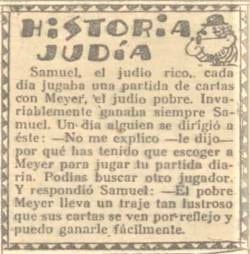
de Todo un Poco. TBO, 246, p. 12
Translation: Everyday Samuel the wealthy Jew played cards with Meyer the poor Jew. Without exception Samuel always won. One day somebody approached him, "I don't understand why you have picked Meyer to play cards with daily," he said, "you could look for another player." Samuel replied, "Poor Meyer wears such a lustrous suit that his cards reflect off it and I can beat him easily."
The "Jewish joke" feature continued at least until the year 1962, whence comes this second story,
A Nice Profit (Year 1962)
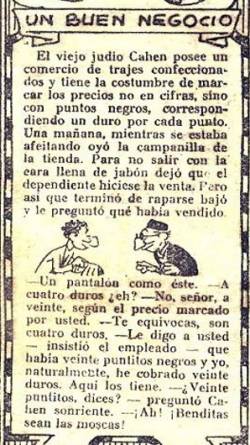
de Todo un Poco. TBO, 278, p. 14
Translation: Cahen [sic] the old Jew owns a shop of tailored suits and he has the habit of tagging prices with black dots instead of numbers, one dot standing for 5 Pesetas. One morning, as he was shaving, he heard the shop's doorbell ring. So as not to show his face full of lather, he let the clerk do the sale. But as soon as he finished shaving he went downstairs and asked the clerk what he had sold."A pair of trousers like these ones."
"For 20 Pesetas, eh?"
"No, sir, for 100 Pesetas in line with the price marked by you."
"You made a mistake. It's 20 Pesetas."
"I tell you, sir, that there were twenty small dots," insisted the clerk, "and so naturally I charged 100 Pesetas. Here they are."
"Twenty small dots, you say?"—asked Cahen smiling—"Ah! Blessed be the houseflies!"
Below, the protagonist of the vignette "La Medalla del Trabajo" (The Medal of Labour) belonging to the TBO issue of February 12, 1965, was called "Cristobalito" (Little Christopher) but most adult readers would have seen in him a caricature of General Franco (cf. the closing paragraph of the Introduction).
"Cristobalito"... or General Franco?
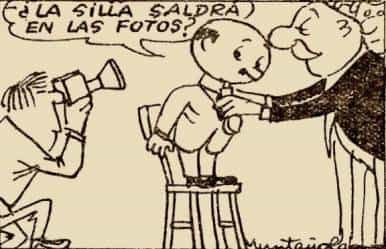
La Medalla del Trabajo. TBO, 381, p. 8.
Bubble: Will the chair show on the photographs?

The above collage assembles six images from the "Cine" section of Bazan, 14, 15, 16-17, the three numbers of the year 1960.
When I was a child Ferrol had seven movie houses. In my earliest recollection of a movie scene there is an Indian crouching toward a Seventh Cavalry soldier sheltering behind a wagon and firing at a band of circling Indians, the soldier unaware of the threat behind him. The Indian raises his tomahawk and an anguished small voice screams in the hushed house, "¡Mátalo!" (Kill him!). I remember the audience laughed, which perplexed me given the gravity of the situation, but I was mollified by watching the blue soldier with the yellow kerchief turn around in the nick of time and shoot the Indian dead. At that early age I also could not understand where the movie house kept all the horses, wagons and trains for the next showing.
Below is a sample of four days with the movies that were playing in Ferrol. The source is that day's newspaper. The first day is from 1954, the second is from 1955, the third from 1959 and the fourth from 1961. A seasonal variance among the four days was introduced deliberately.
The first field of every row below is the name of the movie house (in italics). The second field is the title of the film as it appeared on the ad. The third field (where available) names the leading actors and actresses as they appeared on the ad. The next field cites the film's country of origin, its year of release and its original title if the film is foreign. The last field provides a hyperlink to a clip of the movie where available. In some cases there is a closing comment taken from the newspaper.
A newspaper editorial of March 24, 1954, complained about the compulsory rest period of 10 minutes halfway through a movie.
The owners of Madrid-Paris movie house made unusually heavy advertising of the movie Lili (U.S.A. 1953) ahead of its premiere on Friday June 25, 1954.
On August 1, 1954, a Western Electric engineer came to install CinemaScope projection equipment in the Capitol movie house. Nine days later a trial run was made with the private showing of "The Tales of Hoffmann" (Britain, 1951). The reaction of the invited guests was enthusiastic. The equipment installed cost about half a million Pesetas or $3,366 year 1954, equivalent to $29,600 year 2016. The apparatus could also project VistaVision, Perspective and 3-D films. Its purchase made the city the seventh in Spain to flaunt this technology. The first CinemaScope movie shown in Ferrol was The Robe (U.S.A. 1953) on Thursday October 7.
On October 5, 1961, Callao movie house installed Western Electric's Cinemascope projection equipment. Three days later the first movie shown with the new projector was Duelo en el Atlántico (U.S.A. 1957, The Enemy Below).
On December 7, 1961, a new movie house was inaugurated in Ferrol. Cine Atenas was located in the vicinity of the municipal stadium. The newspaper described it as "magnificent...of colossal proportions...its lower viewing floor contains more than five hundred seats." The first movie shown was Constantino El Grande (Italy 1961).
Joselito was born in 1943. Age-wise he could be considered a child star until 1956 at most. However, as with many other Spanish children, his growth was stunted and his small stature made him look childlike longer.
Marisol was born in 1948.

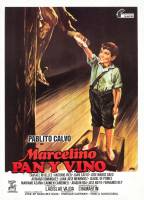
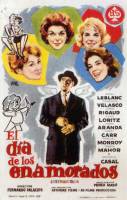
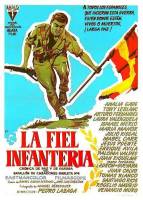
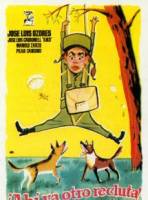
The majority of the movies shown in Ferrol was foreign. The random sample of movie listings for 1954, 1955, 1959 and 1961 shows that a mere ¼ had Spain as the country of origin.

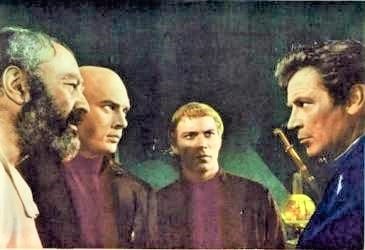
The landing at the back door of the co-cathedral had a fount of "holy water" and on the adjoining wall there hung a bulletin board with the list of movies showing in the city, a brief description of each and an advisory rating. The lowest advisory number 1 meant that the movie was harmless and could be watched by everybody. Movies meant for adult audiences were tagged with the number 3 (e.g. some necking). The next rating was 3-R which indicated that the movie had serious, morally objectionable features (e.g. some necking plus a bikini or two). It was the summer of 1965, shortly before my departure. Balancing on the fount's pedestal, I scanned the bulletin board and my eyes bugged out when I spied the number 4. That was the sternest advisory, rarely seen. It meant that the movie was "gravely dangerous" to the spiritual well-being of the moviegoer. I took mental note of the title and read the eponymous book years later.
The censured movie was American from the year 1958. Here is the movie's official trailer.
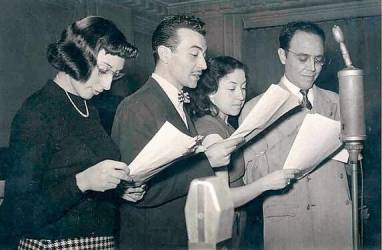
The above photograph of a cadre of Radio Madrid actors comes from the website, "El Desván de Rafael Castillejo," (Rafael Castillejo's Attic) which is an excellent source of Spanish memorabilia from the same historical period as my webpage's and beyond. Radio theater, comedy like Maginet Pelacañas (Radio Sounds Library 16.9) or children's stories like Garbancito (Radio Sounds Library 12.3) were the entertainment venue of most homes.
Some popular children's songs were:
However my two favourite songs were "Camino Verde" (Green Trail) and "Navidad" (Christmas).
Camino Verde (Green Trail)
I remember singing "Camino Verde" to visiting friends of my parents when I was quite small. The song was written by Basque composer Carmelo Larrea.
|
Hoy he vuelto a pasar por aquel camino verde
Por el camino verde, camino verde, que va a la ermita,
Hoy he vuelto a pasar por aquel camino verde
Por el camino verde, camino verde, que va a la ermita, Camino, camino verde. |
Today I have trodden again that green path through the valley
By the green green path that goes to the hermitage
Today I have trodden again that green path,
By the green green path that goes to the hermitage Trail—green trail. |
Navidad (Christmas)
The origin of this song is obscure. Basque composer Carmelo Larrea wrote many songs for Cuban singer Antonio Machín. Although Machín is usually credited with being the author of this carol, its melancholy tone, similar to Camino Verde's, suggests that Larrea had some say in the lyrics. Still others dispute their authorship. The song has a decidedly un-Spanish feel, even its first word, "Campanitas," suggests sleigh bells rather than church bells, the traditional Spanish motif. Both Machín and Larrea were familiar with American carols, having lived in the United States for some time.
|
Campanitas que vais repicando, Te celebran las almas que saben amar: Oh, qué triste es andar en la vida Por senda perdida lejos del hogar Sin oír una voz cariñosa Que diga amorosa—Llegó Navidad— |
Sleigh bells that pass jingling, jingling, Observe the souls that know how to love: O how sad it's wandering through life On misguided path far away from home Without hearing a tender voice Fondly say, "Christmas has arrived!" |
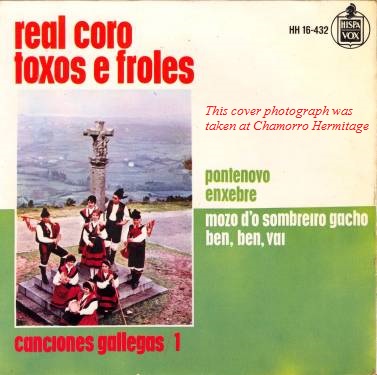
According to the article written by José E. Lage Pedreira on page 8 of El Correo Gallego, 17 May 1963, Ferrol edition, the idea of creating the choir was discussed and approved at a big get-together that took place in the locale of the Airiños D'A Miña Terra Association toward the middle of December 1914. Emilio Bidegain Lázaro who chaired the meeting moved the creation of a folk chorale "similar to Pontevedra's Aires d'a Terra" and proposed the name, Toxos E Froles (Gorses And Flowers) for it. The declared aim was to preserve and exalt Galician folklore. His motion carried unanimously and the chorale's rehearsals began in earnest at the same temporary location on January 2, 1915. Note: Aires d'a Terra's first gramophone record, dated 1904, is part of the soundtrack for this 1929 documentary (End of Note).
The first public performance of Toxos E Froles took place in Teatro Jofre on May 29, 1915. The public's response was enthusiastic and the occasion ended with the encore, Dous Amores.
As a result of their active labour of promotion the choir's fond ambitions were realized and in a short period of time across Galicia there was seen, with natural satisfaction, the birth of similar associations. These did with great effort, with overflowing enthusiasm and with a pure love for the land, such a feat of cultural promotion that in a few years, it may be said, no popular music was embraced but ours.
Toxos E Froles sang at the homages paid to Antonio Rey Soto, Fernando Álvarez de Sotomayor, Sofía Casanova, Perfecto Feijóo, at the fundraisers for impressive monuments in honour of Manuel Curros Enríquez, the Ferrolian soldiers fallen in Africa, Concepción Arenal, Rosalía de Castro, and at many other "charity or patriotic" festivals. The venue for the indoor performances of Toxos E Froles in Ferrol was either Teatro Jofre or Teatro New England across the street. The "New England" was eventually demolished to make way for the Post and Telegraph Office.
Toxos E Froles sang before the king and queen of Spain in July 1922; the monarchs were so impressed that they designated the choir royal status.
Four modern performances of Toxos E Froles follow.

The choir has of course performed the following three Galician classics. All three are poems set to music.
| 1. |
|
This poem published in 1880 was written by Rosalía de Castro.
|
Cando penso que te fuches,
Cando maxino que es ida,
Si cantan, es ti que cantas,
En todo estás e ti es todo, |
When I think that you have parted,
When I fancy that you are gone,
If there is singing it's you who sings,
Everywhere you are in everything, |
| 2. |
|
The official Galician anthem covers the first four stanzas of the poem "Os Pinos" written in 1895 by Eduardo Pondal.
|
¿Que din os rumorosos
—Do teu verdor cinguido
Os bos e xenerosos
Os tempos son chegados |
What do the rumorous ones
"Girded by your greenery
"The good and generous ones
"The time of the ages |
| 3. |
|
This poem published in 1869 was written by Manuel Curros Enríquez.
|
Unha noite na eira do trigo,
I a coitada entre queixas decía:
Os seus ecos de malencolía
Lonxe dela, de pé sobre a popa
I ó mirar as xentís anduriñas
Mais as aves i o buque fuxían
Noites craras de aromas e lúa,
Dun amor celestial, verdadeiro, |
Once upon a night in the wheat fields
And the poor girl said between plaints,
Her echoes of melancholy
Far away from her, standing at the stern
And upon watching the gentle swallows
But the birds and the vessel sped onward
Clear nights of fragrances and moonlight,
Away from a heavenly, genuine love |
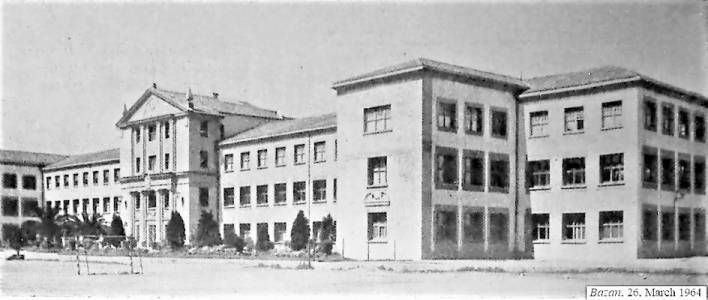
The above photograph comes from page 16 of Bazan, 26, March 1964.
When I was a child the official name of the high school was "Instituto Nacional de Enseñanza Media de El Ferrol del Caudillo." The principal taught Language and Literature, his wife taught Physics and Chemistry. Girls and boys were segregated.
The school offered two years of preparatory school followed by six years of high school and a final year of preparation for university studies elsewhere. The classes of "preparatory" were given in two classrooms located in the east wing of the building. Initially I was assigned to the crowded, south-facing homeroom of teacher Mr. Saturnino Hermida López. Of stern demeanour, he always wore black. A former pupil remembers him,
He tutored me for a few years after [preparatory] and I went to see him several times, e.g. when I lived in Santiago [de Compostela] and he, retired already, ran the library of the Boys Institute...Eventually I found out that he took Law [in his youth], challenged the professor's demonstration of the existence of God—he told me this himself, I remember his very words—and was expelled from university, so he had to etch out a living in the middle of the [Spanish Civil] war. Short and slim, of striking eyes, father of three daughters...Beloved and venerated, I said to two Ferrolian mayors that he deserved to have at least one street named after. He taught many generations of Ferrolians and today his figure fades away without the homage that he without doubt deserves.
I was transferred very quickly to the north-facing classroom of teacher Mr. Antonio Pardo Lozano, some said he was a Falangist. Usually pleasant, he read to us short animal stories that I looked forward to hearing.
After preparatory the student enrolled in six years of high school proper which were followed by an optional year of preparation for university. The high school curriculum was hard and classroom discipline tough from the start, the students were forbidden to ask questions. Another Falangist taught a course called "Forging of the National Spirit." I expected an enthusiastic delivery on the history and political platform of fascist Falange Española, but he seemed bored or disenchanted and even told us one morning, "Go play soccer far from the high school, but don't let the principal see you leave." We naturally obliged.
The principal's name was Victorino López González.
Bazan, 26, March 1964, pages 16-18, states that he was a professor of Literature, the founder of the Alumni Association and the organizer of seminars given by such intellectuals as Aranguren, Álvaro d'Ors, Dámaso Alonso, Lafuente Ferrari, Gerardo Diego, París Amador, Torrente Ballester and Muñoz Alonso. He was also the patron of amateur theater and cinema at the High School.
Bazan's article next praises the principal for the creation of a night school to enable "producers with the will and vocation to study" to obtain the official Basic High School Diploma upon passing all trimester and final exams.
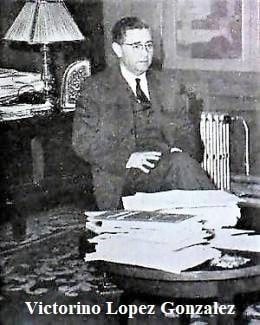
"Mr. Victorino, what is the fundamental goal of the night school?" "To give the working class access to the Elementary High School Diploma. The legal prerequisites for registering are: age fourteen or older, a working contract or justifying the inability to attend daytime classes."
"Outstanding differences—if any—between this new model and the conventional or daytime one?" "The total exclusion of Latin and a greater stress on Drawing."
"Did these courses start long ago?" "In the year 1956 some twenty pupils signed up provisionally, but when the time for formal registration came, only two followed through. Since the requirement for legal validity was the registration of at least fifteen pupils, everything fell apart. Finally in the school year 1960-61 seventeen registered formally, several of whom are now enrolled in the fourth-year program. After 1960-61 the second, third and fourth-year programs were gradually implemented. Presently the night school offers a four-year programme and has approximately one hundred pupils."
"What is the nighttime schedule?" "The classes last three quarters of an hour each. They run from 6:45 to 7:30 PM, from 7:30 to 8:15 PM, from 8:15 to 9:00 PM and from 9:00 to 9:45 PM."
"A final question, Mr. Victorino. We have heard that some night-school pupils have received scholarships. Is this true?" "Yes. Last school year 1962-63 twelve scholarships worth 3,600 Pesetas each were awarded. And this year, eighteen of the twenty allocated to the whole province." Note: The Bazan reporter adds, "What Mr. Victorino does not tell us is that these scholarships were created thanks to his diligent personal inquiries" (End of Note).
Regular students paid a registration fee in September. Some students had the fee waived if their family could not afford it. The newspaper cites ten such waivers on September 23, 1955. Occasionally a few scholarships were offered by various institutions including the school itself, e.g. five scholarships worth 1,000 Pesetas each were made available to applicants on January 22, 1954.
Final exams were held in the second half of June. For example on Saturday June 26, 1954, these were the subjects and the times. 9:00 AM: Modern Languages. 4:00 PM: Physics and Mathematics for students majoring in Science, the students could bring a table of logarithms. 4:00 PM: Latin and Greek for students majoring in Letters, students were allowed to bring a dictionary.
Students who failed in June could take the exam(s) over in September, before the start of the school year. This was the schedule for fourth and sixth-year repeats in the year 1955. Tuesday September 7, 9:30 AM: French and English. 10:45 AM: Mathematics. 12:00 noon: Latin and Greek. 1:15 PM: Forging of the National Spirit. 3:30 PM: Drawing (sixth year) or Physics and Chemistry. 4:45 PM: Spanish. 6:00 PM: Sciences. 9:30 PM: Religion. The oral exams continued on the Wednesday.
The school boasted an auditorium where movies were shown on weekends. I do not remember the title but I remember the plot of a heart-breaking French-Canadian film probably set in the nineteenth century. A large family emigrates to Canada, presumably from France. The beginnings are happy enough, but the man of the house falls ill during the winter and dies, leaving his widow behind to take care of the children in mounting hardship. In due course she too falls ill and dies. In the melancholy closing scene the oldest daughter takes the siblings out of the log house which the parents had been renting and leads them along a snowy trail into the woods, a late afternoon sun shining behind them. I left the auditorium chilled to the bone. What a horrible country to live in, I thought. An early scene aroused my weather-watcher calling: the father peeks out of a window into the night and right after he closes the flimsy curtain a flash of lightning floods the scene, thunder rumbles and a copious fall of snow begins.
I completed two years of high school with top honours then my parents decided to emigrate to Canada in September 1965.
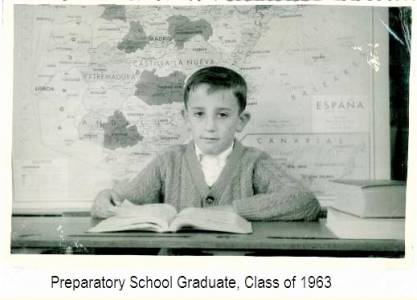
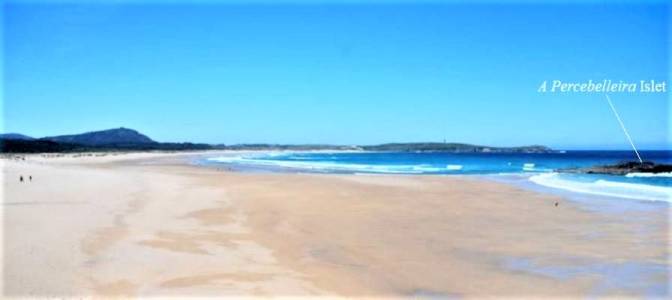
When I was a child the highlight of my summer holidays was the beach and lagoon of A Frouxeira in the municipality of Valdoviño located seventeen kilometers away from the city.
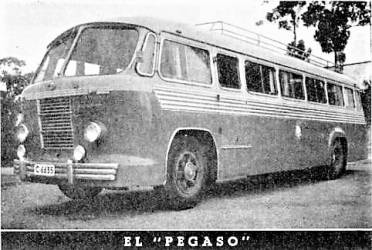
We travelled on the Bazan bus that everyone called, "El Pegaso" (photograph on the right). The service, "already a tradition" in the summer of 1955, ran from early July to the middle of August, the few warm days of a normal Ferrolian summer. Every "producer" and his family had a right to use the free service a set number of times. Without a valid pass, however, no one could board the bus. A boarding pass specified the date and time of boarding both ways. These passes were transferable, so a "producer" could make use of a friend's pass if this one ceded his pass on a specific date. Plaza de España was the last boarding opportunity in the city.
According to Bazan, 7, "El Pegaso" made around 200 two-way trips during the summer for a total mileage of 7,000 kilometers. Around ten thousand "producers" and their families boarded the bus to Valdoviño. There were two other beaches along the way, namely Meirás and Porto, in whose vicinity passengers could get off and be picked up again later that same day.
My parents opted to go on weekdays to avoid the crowds. The morning may have dawned cloudy and damp over the city but the summer sun invariably shone bright over the beach. Fun and games with other children—eating in the camping tent that we set up near the dunes, or without the tent, in the clearing of a resin-fragrant pine stand guarded by walls of gorse taller than I—playing soccer with the adults on the sand or on a rustic playing field just behind the beach—exploring the dunes strewn with sea hollies—exploring the solitary lagoon and catching glimpses of its birds and animals (ospreys, Eurasian coots, skylarks, common reed buntings, adders) or plodding in safari to the far end of the beach—I could never get enough of A Frouxeira.
One day we took the last bus home, but it would not start. I had pleasant visions of spending the night on the beach but alas! a replacement bus showed up after an hour or so and carried us away. Another time in one of my reconnaissance missions I happened upon a teenage couple lying among the reeds. The boy told me to be very careful because they had just seen an adder wind past. I left in a hurry, but was not completely fooled: why hadn't they bolted?
On our final trip to Valdoviño I was twelve years old and the sun did not break through as it customarily did. The whole day was cloudy and drizzly, as miserable as I was.
The newspaper of July 12, 1955, described the drive and the place thus,
The road to the place is very bad, but the drive is admirable as it crosses a forest of pine, alders, eucalyptus and chestnut trees that exude a pungent aroma. The panoramic views of the valley bound by the parishes of Lago and Castro are really stunning. There are many brooks along the way and diverse hues of greenery and wheat fields.The beach has a permanent sea breeze and a majestic lagoon. From the road it looks like a very broad stretch of sand dazzling in the sun; the sea is very blue. The islet known as A Percebelleira is at times overrun by towering waves, accessible others. Clung to its rocky mass are thousands of shellfish of diverse species.
As many of us as have paid a visit will cherish a grateful memory.

This collage shows eight very popular singers of the epoch in the Spanish-speaking world. The Table below specifies their nationality, their years of birth and death and the location (a.b) of their songs in the Radio Sounds Library: a (1-28) pinpoints a listening block and b (1-10) a row.
| Name | Nationality | Year Born | Year Died | Songs | |
|---|---|---|---|---|---|
| Carlos Gardel | Argentinian | Disputed | 1935 | 2.1, 4.10, 18.2, 27.3 | |
| Sarita Montiel | Spanish | 1928 | 2013 | 1.6, 15.2, 26.7, 27.5 | |
| Antonio Molina | Spanish | 1928 | 1992 | 1.10, 5.1, 6.9, 24.7 | |
| Conchita Piquer | Spanish | 1906 | 1990 | 1.3, 24.8 | |
| Jorge Negrete | Mexican | 1911 | 1953 | 1.9, 2.3, 2.6, 3.1, 4.1, 9.7, 11.1, 12.10, 17.10 |
|
| Lilián de Celis | Spanish | 1935 | — | 2.5, 4.3, 4.4, 6.1, 16.10, 23.3, 28.8 |
|
| Jorge Sepúlveda | Spanish | 1917 | 1983 | 5.5, 17.5, 18.3, 18.10, 19.3, 19.4, 21.5, 23.6, 25.10 |
|
| Gloria Lasso | French | 1922 | 2005 | 3.7, 4.7, 5.6, 7.3, 16.5, 16.6, 19.2, 19.5, 20.2, 28.4 |
Most songs in the twenty-eight instalments offered below are the genuine article sung by the original artists. Notable instrumental versions were added which were recorded in the nineteen seventies or later. For example the rendition of "Adiós Pampa Mìa" by the Orquesta Imperial del Tango (instalment 2) or the execution on the accordion by Françoise Massanes of "Yo Te Diré" the theme song of the classic Spanish movie, "Los Últimos de Filipinas" (instalment 27). They are followed by the original song always. In addition there are twelve genuine instrumentals, "Carrascosa," "Cerezo Rosa," "Chi Ri Bi Ri Bí," "Danke Schöen," "El Pájaro Campana," "The Bridge Over The River Kwai" march, "La Boda De Luis Alonso," "La Machicha," "Mambo nº 8," "Paquito El Chocolatero," "Perfidia" and "Tequila". Nine clips are not songs. For example one recorded the voice of Communist Dolores Ibarrúri ("La Pasionaria") speaking over pirate "Pyrennees Radio" in 1962 (instalment 3). Another takes up the misadventures of "Garbancito" (The Little Chick Pea) a funny children's story broadcast in the nineteen fifties (instalment 12). Popular comedian Miguel Gila used absurd humour to make the audience laugh (instalment 18). Another clip abridges the Generalissimo's New Year's Message for 1958 (instalment 22).
Nearly every line in the twenty-eight instalments below is made up of two fields separated by a hyphen. The first field is the name of the song followed sometimes by its year of composition in brackets. The second field is the name of the performer(s) often followed either by the year of the recording in brackets or by the year of its first showing in the list of the top 20 records sold in Spain between the years 1940 and 1965 as compiled by Clasificación Nacional Del Disco. For instance, the year of composition of the tango "A Media Luz" (instalment 1) is 1925 (source: Spanish Wikipedia) and Sarita Montiel performed it in 1960. Lilian de Celis recorded "Batallón De Modistillas" (instalment 4) which ranked tenth in the Spanish hit parade of 1956. Exceptionally a line may carry two dates. "Catapúm Catapera" (instalment 6) also known as "El Polichinela" was recorded by Lilian de Celis in 1956, it had been composed in 1908.
A few songs date back to the nineteenth century. "Fonseca" (instalment 12) is said to hail from the year 1870 and from the environs of the University of Santiago de Compostela. The popular Mexican birthday song, "Las Mañanitas" (instalment 15) is said to have originated with the Jews of Spain before their expulsion in 1492. The opening line reads, "These are the morning songs that King David used to sing to the pretty girls, today we sing them to you." These venerable songs were quite popular when I was a child.
The exercise of finding the year of a song's debut or the year of a performance turned out to be more laborious than I expected. The exercise was made more difficult when a song owned several titles in cyberspace. Two examples follow. "Aparte De Esto" (instalment 3) is also tabbed "Es Una Lata El Trabajar" or "La Vida Pasa Felizmente". "Alma Llanera" is also given the erroneous title "Hermano Del Sol" (instalment 12).
The only date I discovered in cyberspace for the debut of "Aparte De Esto" (instalment 3) is 1969 when the song purportedly became a summer hit in Spain. However I believe I heard it played much earlier. The reason for the discrepancy could be that Argentinian singer-songwriter Luis Aguilé recorded several albums in his native land before moving to Spain in the nineteen sixties. The song I believe I heard as a child must have been an Argentinian recording. Certainly the tune bespeaks the nineteen fifties more than it does the year 1969.
At least one Spanish webpage holds that "Cuando Salí De Cuba" (instalment 7) was written by Luis Aguilé to lament a broken romance with a Cuban girlfriend following his visit to the Caribbean island. The lyrics, however, refute this assertion and point to the Cuban émigré community of Miami as the source and suggest a composition date prior to the Bay of Pigs invasion (1961).
"Raskayú" (instalment 22) and "Se Va El Caimán" (instalment 23) were appropriated by opponents of the Franco regime as equivocal references to the dictator. The first song was a comical danse macabre with the refrain, "Raskayú [meaningless name] when you are dead, what will you do? You'll be no more than a corpse." The second was a farcical song from Cuba about a man turned alligator. Its refrain is "The alligator is going away to Barranquilla [placename]."
The instrumental clip of "Siboney" (instalment 24) played by the orchestra "Gran Orquesta Románticos De Cuba" actually blends two songs, "Siboney" and "Desesperadamente." A good guess for the date of this recording would be the year 1960.
The twenty-eighth instalment is a collection of "clips left behind on the cutting-room floor." The audio in the "11 Minutes of Radio Commercial Jingles" clip sold listeners on a jewellery shop of Madrid, soap, four types of insecticide (including the infamous D.D.T.) a chain of fabric retail stores, custard pie, bleach and champagne. The brands of soap and champagne are still around. Three clips carry Spanish lyrics for the movie themes of "The Bridge Over The River Kwai", "The Longest Day" and "Exodus". The sixth clip was a popular Cuban song entitled "La Rana" (The Frog): "A frog was sitting under the water—when it started to sing—along came a housefly and made it shut up..." The housefly was followed by a spider, mouse, cat, dog, man and his mother-in-law. The punch line is, "When the mother-in-law started to sing, not even the devil made her shut up." The last clip is a news report dated December 21, 1959, on the arrival at 4:20 PM (local time) of U.S. President Eisenhower to the joint American-Spanish military air base of Torrejón de Ardoz near Madrid. Eisenhower sealed a treaty of friendship between the United States and General Franco and put an end to Spain's international isolation. The clip recorded this fragment of Franco's speech,
This base of Torrejón built with the formidable help of the United States, and housing in close comradeship the Spanish and North American air wings, is a symbol of our friendship and is erected under the motto which doubtless is very dear to you, "Peace In Our Profession."
Freeware program "MP3Gain version 1.2.4" written by Glen Sawyer was used to try and preserve an uniform volume of sound throughout. The track gain was set at 93.0 ± 0.7 db. The result was more or less satisfactory. It was deemed necessary to alter the gain of several tracks.
Windows Media Player opens and plays every instalment without problem. Clicking on the LISTEN hyperlink at the Ferrolian cybercafé I visit gives the choice of listening to or downloading an instalment file. Right-clicking on the LISTEN hyperlink on my laptop at home (O.S. Windows 10 Home Version 1511) also lets me download the instalment files. Hopefully you, the reader, have similar ways of downloading these twenty-seven audio files (MP3) should you wish to.
| 1. LISTEN |
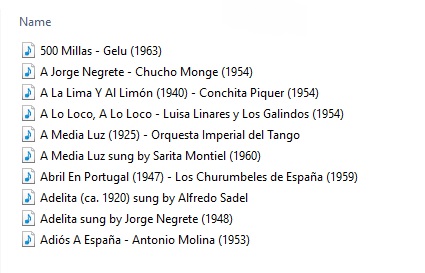
|
| 2. LISTEN |
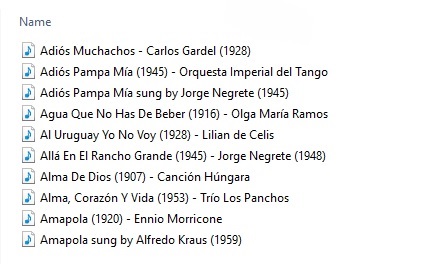
|
| 3. LISTEN |
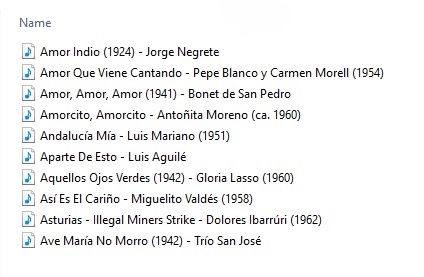
|
| 4. LISTEN |
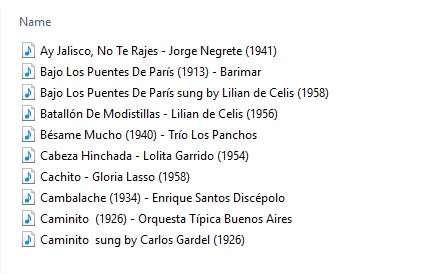
|
| 5. LISTEN |
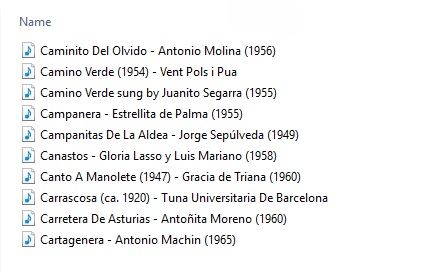
|
| 6. LISTEN |
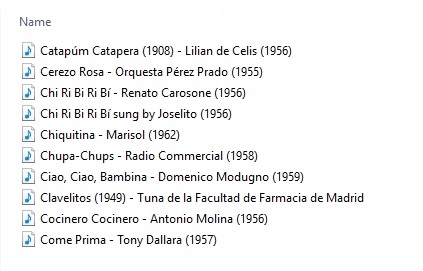
|
| 7. LISTEN |
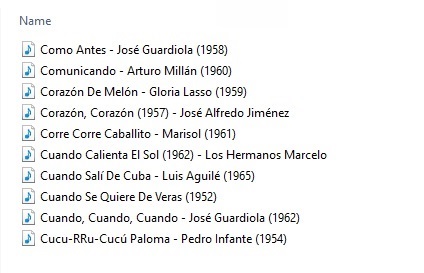
|
| 8. LISTEN |
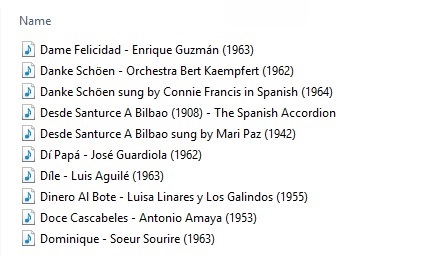
|
| 9. LISTEN |
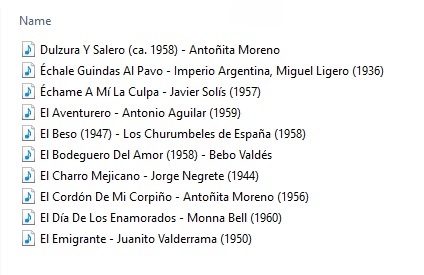
|
| 10. LISTEN |
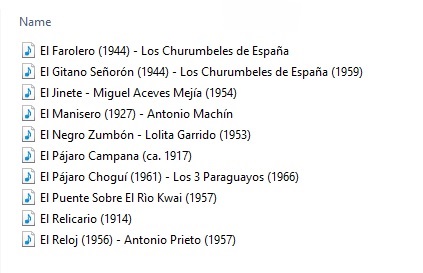
|
| 11. LISTEN |
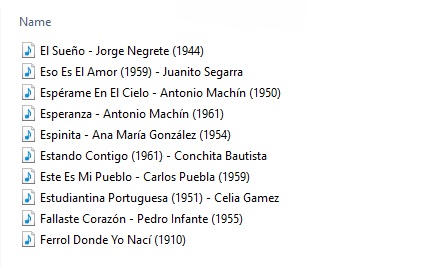
|
| 12. LISTEN |
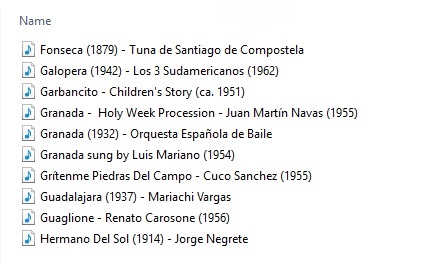
|
| 13. LISTEN |
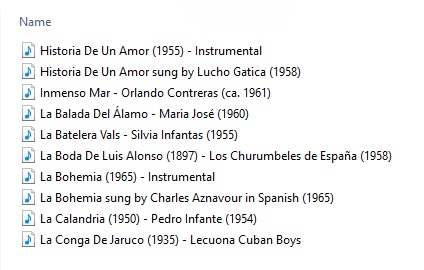
|
| 14. LISTEN |
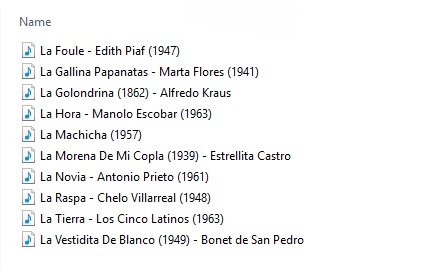
|
| 15. LISTEN |
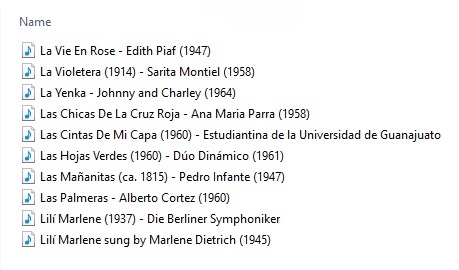
|
| 16. LISTEN |
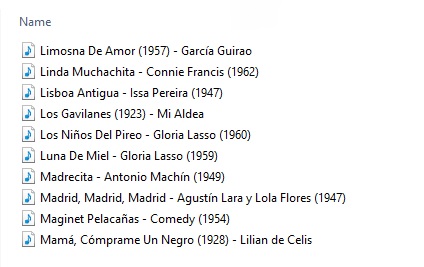
|
| 17. LISTEN |
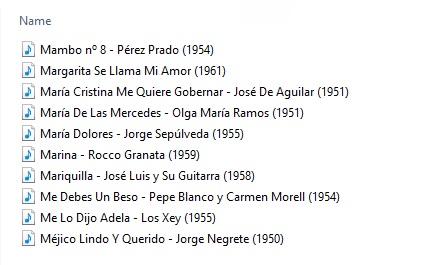
|
| 18. LISTEN |
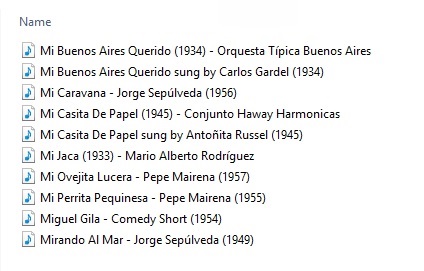
|
| 19. LISTEN |
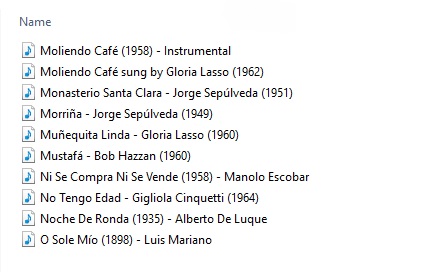
|
| 20. LISTEN |
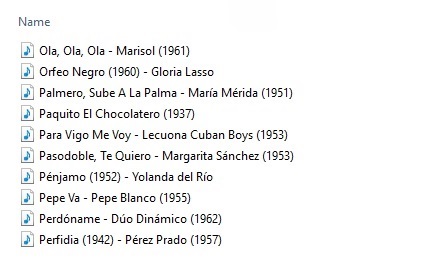
|
| 21. LISTEN |
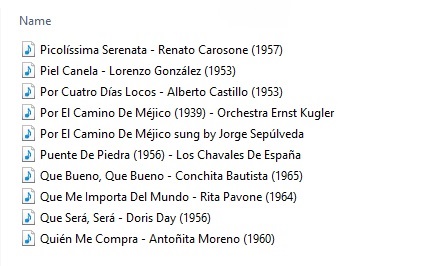
|
| 22. LISTEN |
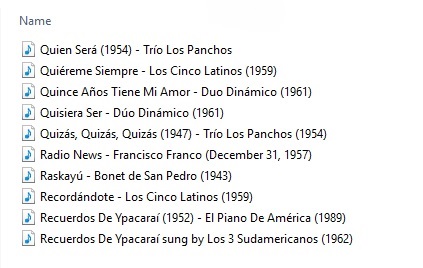
|
| 23. LISTEN |
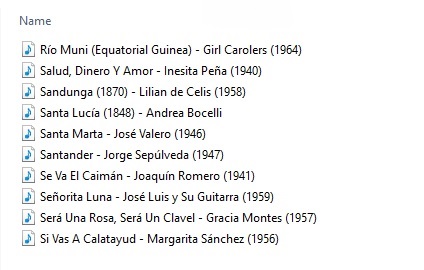
|
| 24. LISTEN |
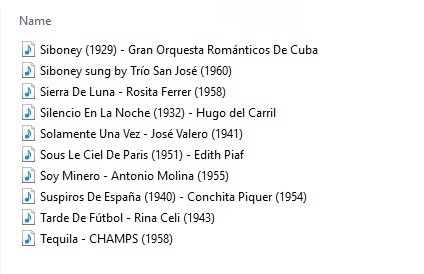
|
| 25. LISTEN |
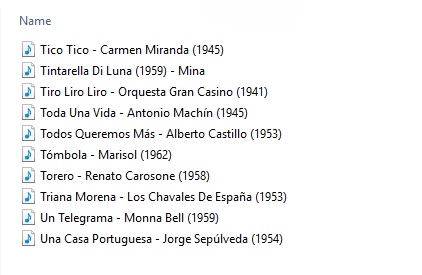
|
| 26. LISTEN |
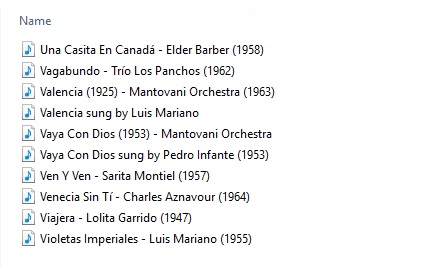
|
| 27. LISTEN |
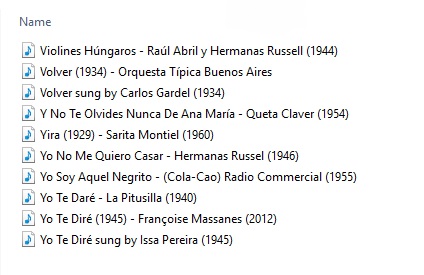
|
| 28. LISTEN |
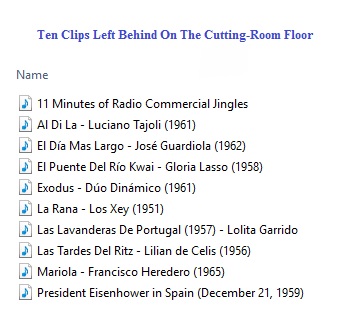
|
| Ferrol's New England Theater (1906-1914) |
| Lenore: That Rare And Radiant Maiden |
Rosalía de Castro |
| Translation from Galician to English of CANTARES GALLEGOS (1863) |
| Translation from Galician to English of 11 poems by Rosalia de Castro |
| Archived translations from Galician to English of poems by Rosalia de Castro |
| Translation from Spanish to English of the poem "¡Volved!" by Rosalía de Castro |
Eduardo Pondal |
| Translation from Galician to English of 11 poems by Eduardo Pondal |
| Translation from Galician to English of 4 Classic Emigration Ballads |
| 11 Songs of the Spanish Civil War (1936-39) |
| Los Canadienses (Batallón Mackenzie-Papineau) |
| Zionism & Galiciana |
| Collected Works of V. I. Lenin & Galiciana |
| Collected Works of J. V. Stalin & Galiciana |
| Who Wrote the Five Books of Moses? |
|
The Four Horsemen of the Apocalypse |
The Revised Book of Isaiah |
| Criticism of the Book of Revelation |
The Revised Book of Revelation |
| The Gold-Headed Statue of Daniel 2:31-44 |
| New York City Is "Babylon The Great" |
| The Soviet Union Almost Was the Red Beast of Revelation |
| The Mark of the Beast and the Number 666 |
| Diary of a Marked Man |
| Criticism of the Gospel of Matthew |
| The Fourth Trumpet |
| Chronology of the Bible |